Outside Suburbia Family
Luxury | Wellness | Art | Experiential Family Travel & Lifestyle


Amazing Andalucia: A 7 day Itinerary to see the Best of Southern Spain
Posted on February 25, 2018 October 25, 2021 Author Priya 12 Comments
Flamenco dancers, horse carriages, bright bougainvilleas, tapas, and elaborate Moorish castles are what is in store when you visit Southern Spain. Here is our 7 day Andalusia Itinerary to see the best of Southern Spain. While westerners spell Andalusia with a ‘s’, Spaniards spell it as Andalucía ! Andalucía called Al-Andalus (Arabic for “land of the west”) was a Moorish empire for 781 years, from 711 to 1492.
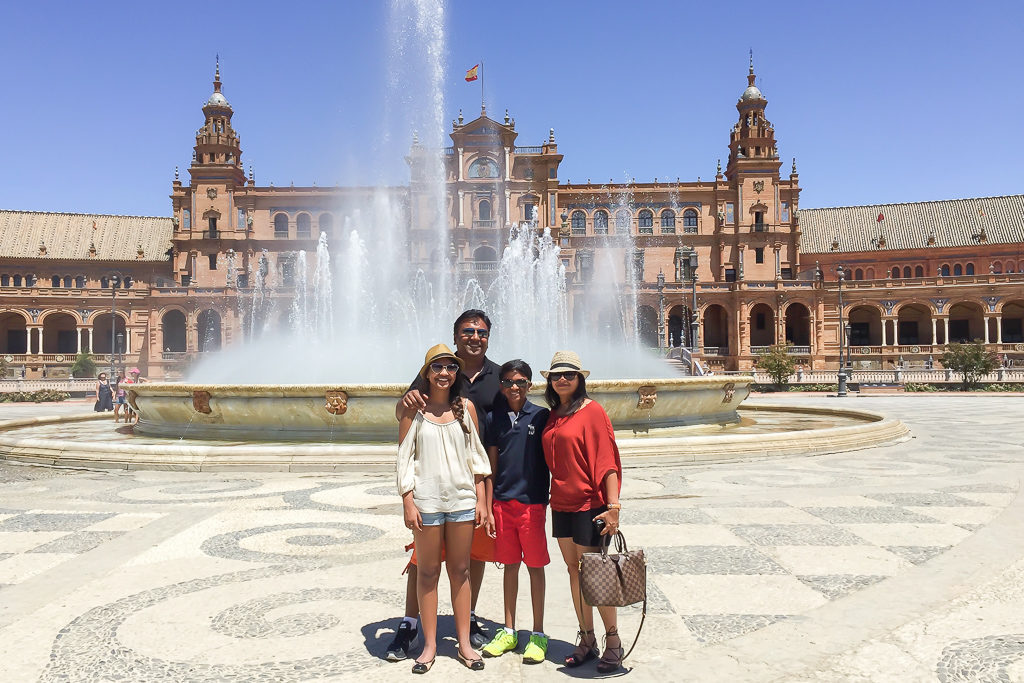
Spain is one of the best countries in Europe ! We wanted to visit as much as possible of the romantic region of Spain that lies south of the Iberian peninsula. We landed in Madrid and took another flight to Seville , after a few days of tasting every plate of tapa and drinking quite a bit of sherry we made our way to Granada and the Alhambra palace driving through the Sierra Nevada.
We stopped at a few charming White villages that dot the region – Grazalema was our favorite. From Granada, we flew to Barcelona visited Monsterrat and spent a few days exploring Catalunya and the sun-kissed Costa Brava region in the Spanish Riviera before returning home.
WHAT IS IN THIS POST
7 Day Andalucia, Southern Spain Itinerary
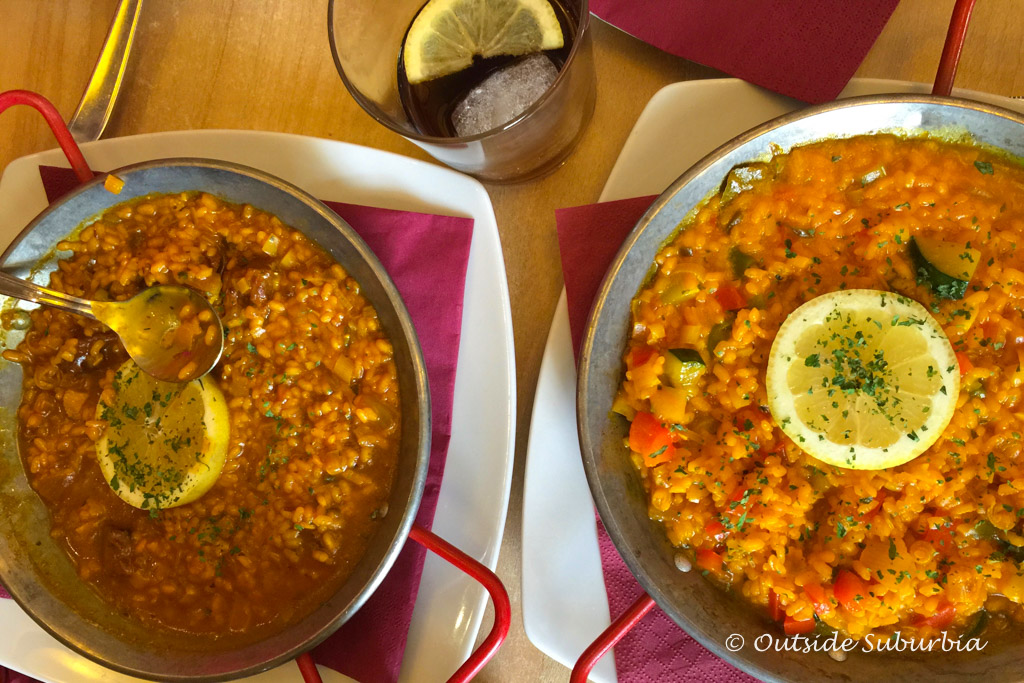
7 day Southern Spain Itinerary
- Seville 4 days
- Cordoba day trip from Seville
- Drive through the White villages with stops at a few and at Ronda
- Granada 3 days
- Barcelona 4 days with day trips to Montserrat, Girona, Pals and a visit to the Spanish Riviera
Charmed by Seville
Sevilla lived up to all its hype. We were charmed right when the taxi entered the old part of town, the narrow colorful picturesque orange tree-lined streets, the Moorish Palace, the beautiful Cathedral and the horse carriages at every corner made us fall in love with the little town in southern Spain.
See a short visual story of our day in Seville
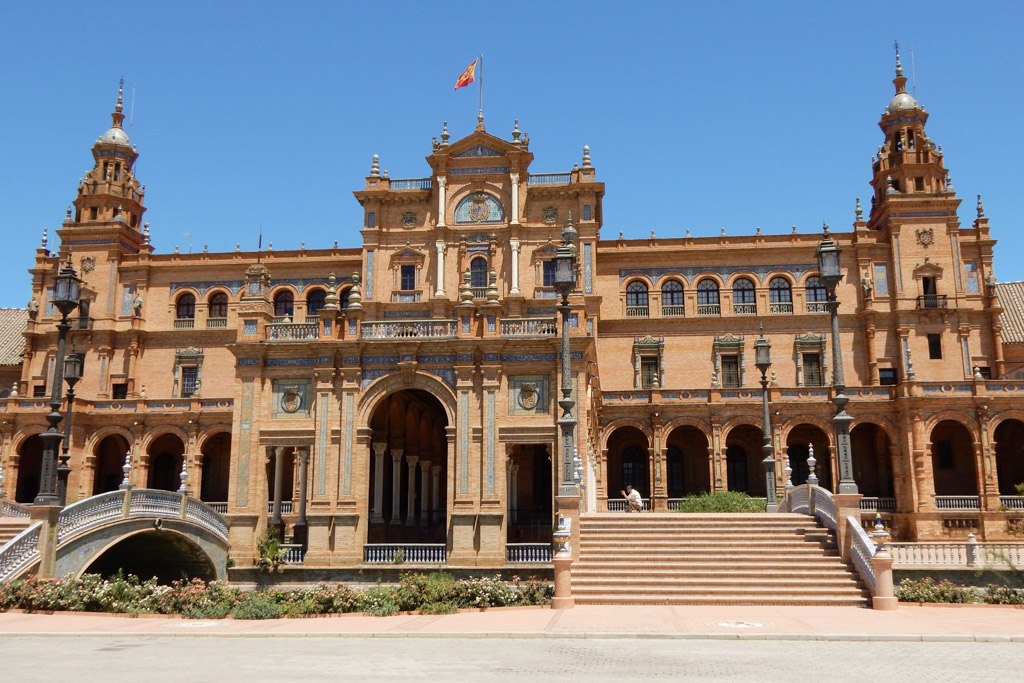
We spend 4 days in Seville exploring the alleyways, trying different tapas and catching flamenco shows. The first day we just wandered around and took a tram over to Plaza España around the golden hour.
The next day we started early to visit the Real Alcazar de Seville to avoid the crowds. This Mudejar palace was built by Pedro I on the site of Seville’s former Moorish Alcazar and the architecture and the gardens are grand.
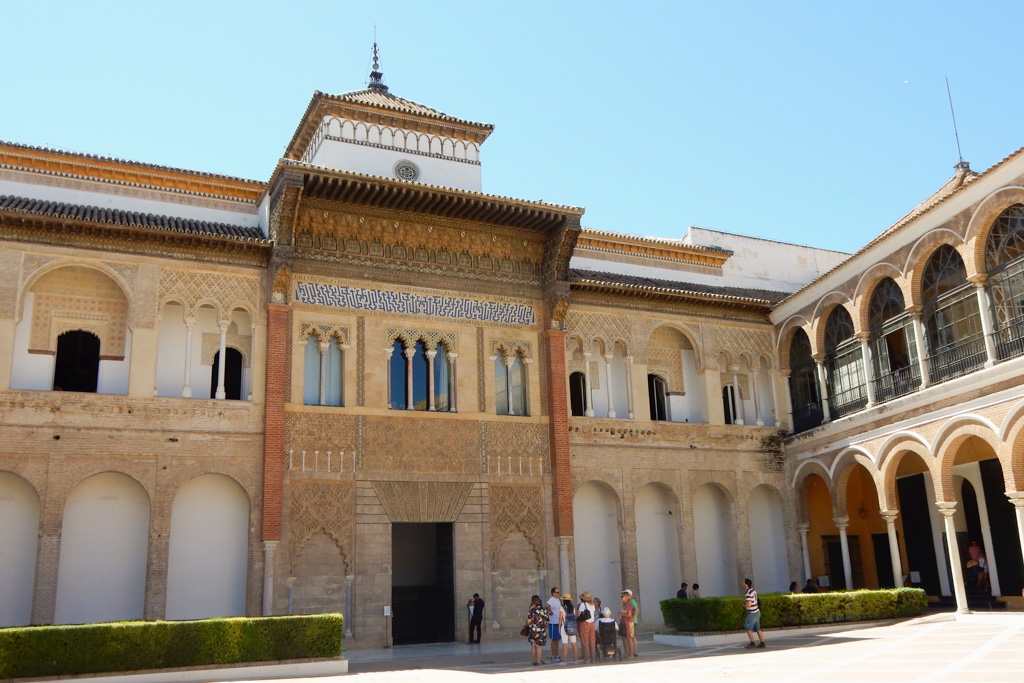
We then crossed the square to explore Seville’s cathedral , where the great navigator Columbus’s tomb is located. Make sure to climb the Giralda or belltower. It’s 40 flights up but ascends via a smooth ramp, so there aren’t stairs to climb.
I loved stopping every so often to get a view of the city below. Nearby EME Hotel has the best rooftop bar in Seville with a grand view of the Cathedral and serves up some refreshing cocktails.
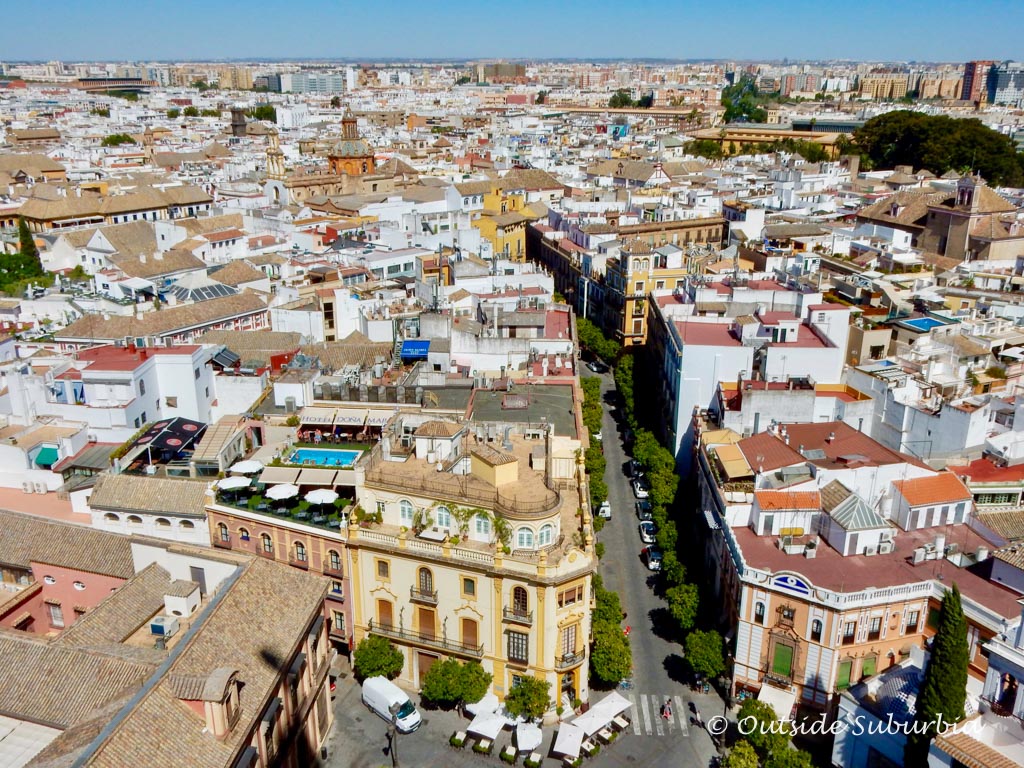
Inside the Cathedral door of Seville’s massive cathedral stands a monument to Christopher Columbus . His tomb is held aloft by four allegorical figures representing the four kingdoms of Spain during Columbus’ life, Castille, Aragon, Navara, and Leon.
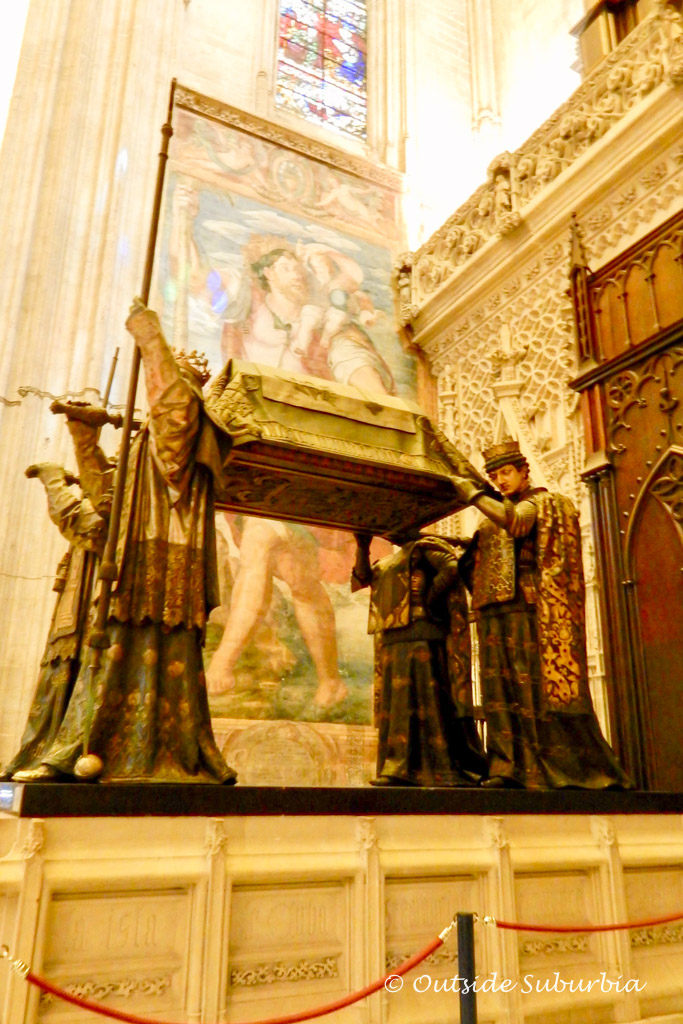
While we didn’t see any matadors or bullfights in Seville, we did catch a couple of flamenco shows – Casa del Flamenco was absolutely gorgeous, set in an Andalusian patio in the charming Santa Cruz neighborhood. It is famous for not using microphones or amplifiers just natural acoustics and powerful musicians and the most authentic heel kicking dancers.
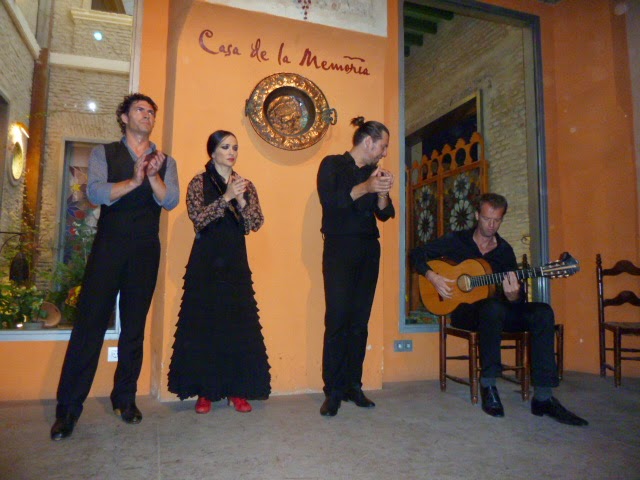
Another venue we loved was Casa de la Memoria . It was a small but authentic nightly show with a great mix of all of the flamenco’s important elements of dance, song, and guitar. Go early to admire the tiles and artworks in their pretty patio and also to get the best seats in the house and of course get your tickets in advance.
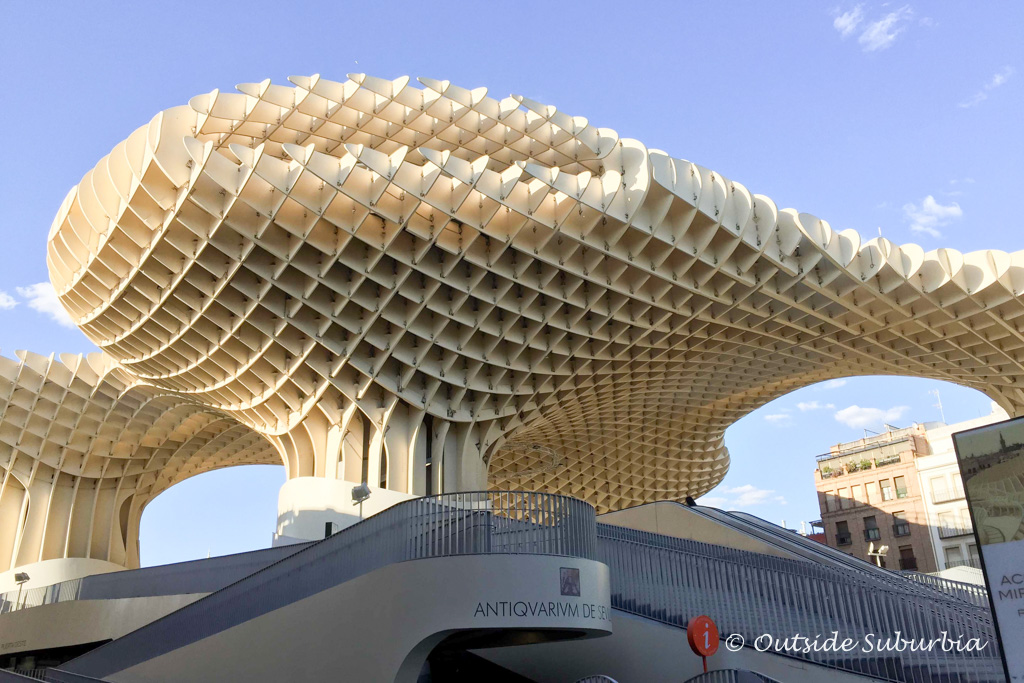
After a flamenco show stop to catch a sunset view from the top of the wooden mushroom Parasol . In the Old Quarter of Sevilla amidst historic and beautiful buildings, a gigantic, modern interpretation of wooden mushrooms doesn’t quite seem to fit but offers the (Second) best rooftop view. The basement floor houses a museum of ancient Roman and Moorish artifacts. Stop at Seville’s Museo de Bellas Artes to see the Spanish art.
Barrio de Santa Cruz was once a Jewish quarter and now is the place to go to get to know the real Seville. A labyrinth of alleyways, white-washed housing, restaurants and boutiques, this area is definitely the highlight of the city. Perfect for lunch, dinner, or a late-night chocolate con churro.
Where we Stayed in Seville: Petit Palace at Santa Cruz was centrally located and had a wonderful breakfast. Hotel EME is another great option, we were there for drinks and dinner one night and really loved the staff and the ambiance of the place.
Candy cane arches of Cordoba
We hopped on a train to visit the Candy cane double arches of Mesquita in Cordoba as a day trip. The Mesquita also called the Grand Mosque or Cathedral of Cordoba is quite unique.
Although originally built as a Mosque, the center of this magnificent building was converted to a Cathedral after the Christians conquered Spain.
After walking through the forest of pillars made from different colored granite, marble, and alabaster supporting dozens of horseshoe arches, that looks like candy canes stop for some Paella. The tiny streets around the Mesquita are filled with shops and restaurants.
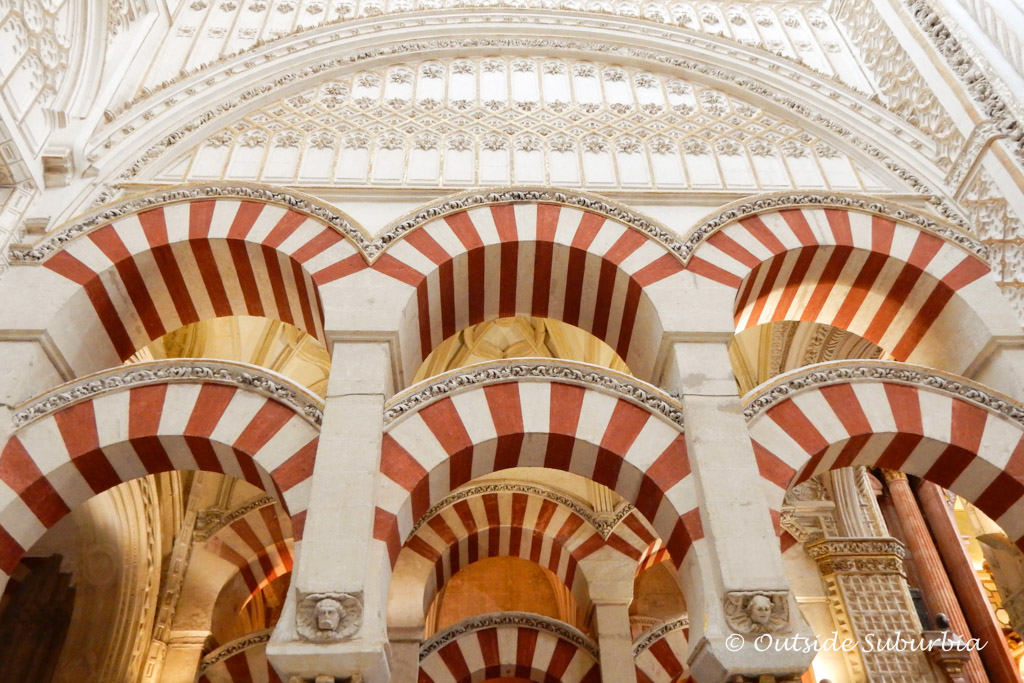
Lunch at the Las Piconeras was one of the best we had in Andalucía – we had the best Paella, fried eggplant with honey, olives, and salmorejo – which is like gazpacho but richer and smoother. Next walk through the narrow Flower street, lined with blue pots brimming with foliage and a nice view of the bell tower of the Mesquita.
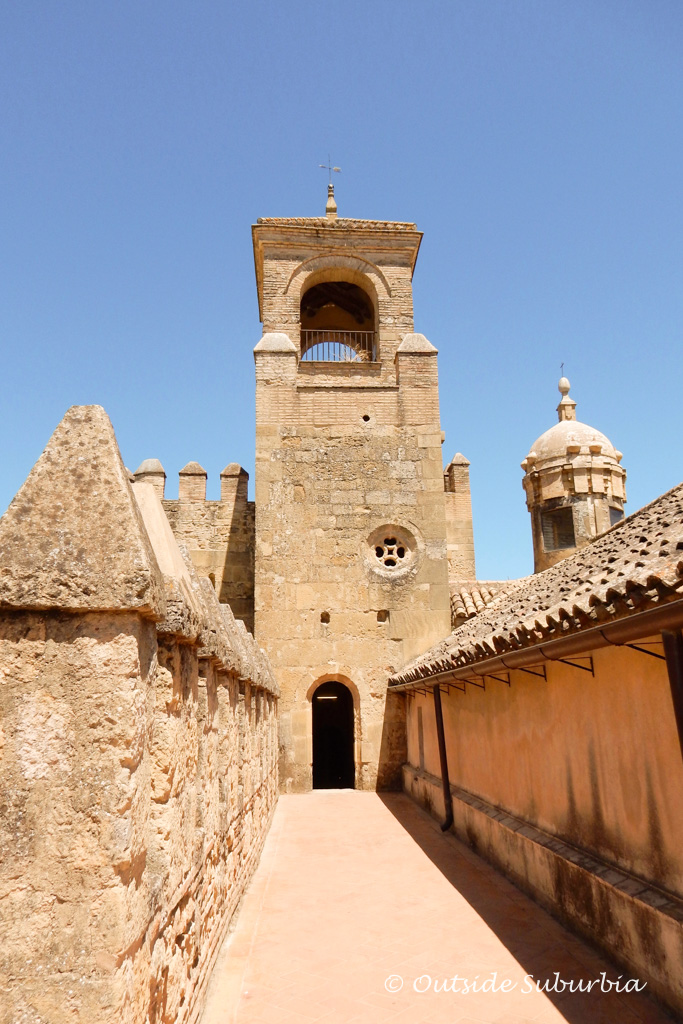
History buffs will want to go see the Alcázar de los Reyes Cristianos (Spanish for “Alcázar of the Christian Monarchs”) – Isabella and her husband Ferdinand used the Alcázar for one of the first permanent tribunals of the Spanish Inquisition and as a headquarters for their campaign against the Nasrid dynasty in Granada which was the last of the Moorish kingdom in the Iberian Peninsula.
The monarchs are said to have met Christopher Columbus in the Alcázar as he prepared to take his first voyage to the Americas. The Alcázar also later served as a garrison for Napoleon Bonaparte’s troops in 1800. Walk on the Roman bridge built over the Guadalquivir river, this river runs through the entire length of Spain; before catching the train back to Seville.
Road trip through Pueblos Blancos
Between the Atlantic in the west and the Mediterranean in the east, lies some of the prettiest hidden towns of Spain . If you are visiting Andalucia, you cannot miss a trip to “ pueblos blancos ”, also known as white villages.
We stopped at the tourism office in Seville right behind the Cathedral to get some maps. We had a GPS in the car but always good to have a good old fashioned map in hand, the tourism office gave us one marked “ Route of the Pueblos Blancos or White Villages ” we took this route to Granada where we spent the next 3 days. I highly recommend adding this to your Andalucia itinerary!
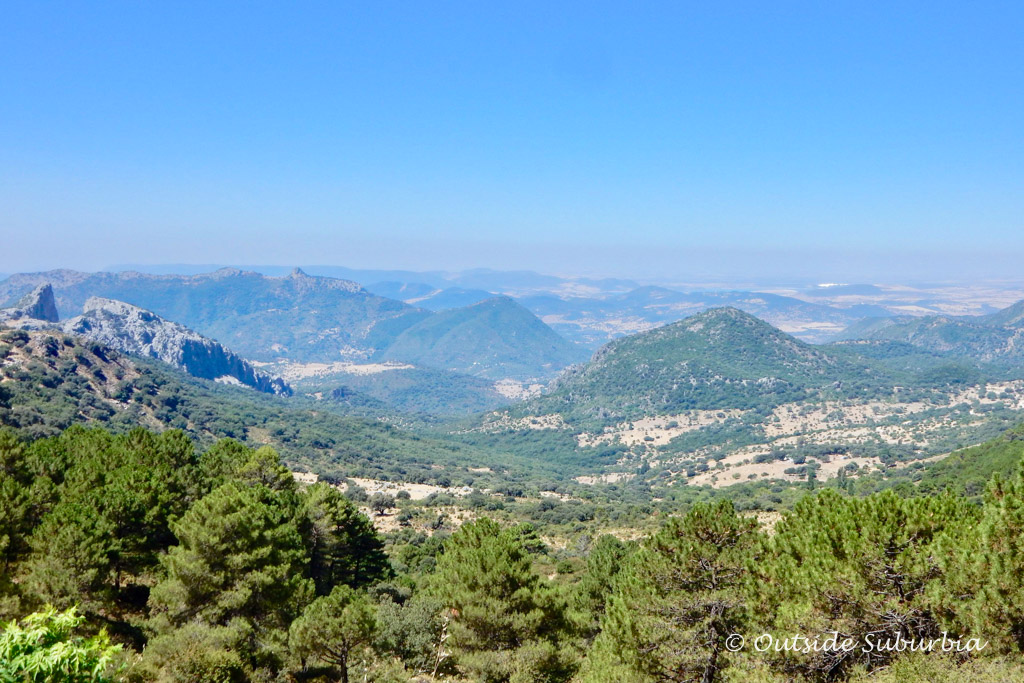
The “ route of the white villages ” is a tourist route that spreads from the region of la Sierra , the region of Janda , in the province of Cadiz and the Serrania de Ronda , in the province of Málaga.
The official route goes through these villages and towns: Alcalá del Valle, Algar, Algodonales, Arcos de la Frontera, Benaocaz, Bornos, El Bosque, El Gastor , Espera, Grazalema, Olvera, Prado del Rey, Puerto Serrano, Setenil de las Bodegas, Torre Alháquime, Ubrique, Vejer de la Frontera, Villaluenga del Rosario, Villamartín, Zahara de la Sierra .
These white villages, with whitewashed walls, red-tiled roofs, cobblestone streets, and ornate churches atop cliffs are rich in history. They date back to the Romans and Moors, offer spectacular flora & fauna, historical walking routes, and are havens for bird watchers & wildlife lovers.
The drive from Sevilla to Granada is about 155 miles or 250 kilometers. We drove to Arcos de la Frontera from Sevilla and from there stayed on A-372 till we got to Grazalema and then to Ronda. These hilltop towns warrant a day or two of exploring but if you are short on time like us, a stop for lunch or coffee still gives you enough time for a short visit. It was a long day but we made in time to catch the sunset in Granada.
Lunch stop at Grazalema
After getting lost in the labyrinth alleys of Arcos de la Frontera, our first white village stops we drove to Grazalema , a natural park with splendid flora and fauna that varies from Spanish fir, cork trees, maple woods to deer and Iberian wild goats. It’s known for its great hiking routes and outdoor activity options.
Driving into the town, we saw quite a few bicyclists and hikers. Grazalema Natural Park has a trail of white villages going through it, many of which belong to the Natural Park.
The postcard-pretty hill town of Grazalema, was quaint will cafes, a little church and a square where you can watch locals playing cards and conversing. We walked around the whitewashed streets for a couple of hours after lunch before driving on to Ronda.
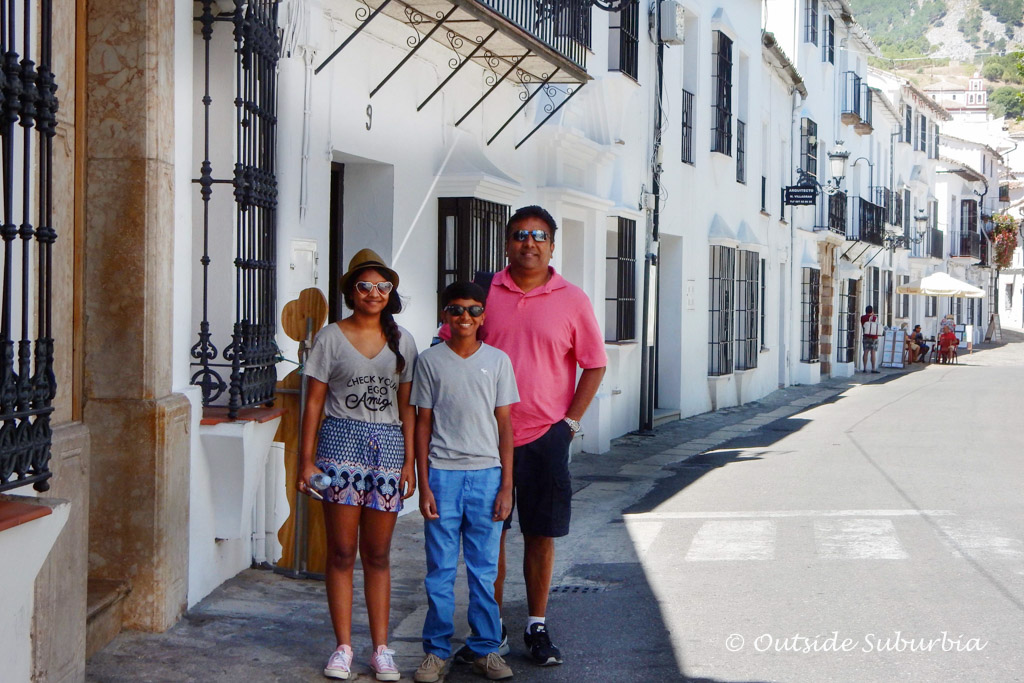
A coffee stop in Ronda on our Andalusia itinerary
The city of Ronda, Spain is perched high atop the two cliff faces of El Tajo canyon. The Guadalevín River, which courses through the city, has carved a deep canyon dividing it. The walls of the canyon are sheer drops to the river over 100 meters below and the white stone buildings are built to the very edge of the chasm.
Connecting the two parts of the city are three bridges, the Roman Bridge also called Puente Viejo , the Arab Bridge called Puente San Miguel , and the New Bridge Puente Nuevo . Pictured below is the not so new, New Bridge that was built in 1793.
In addition to its impressive bridges, Ronda is home to Spain’s oldest bullfighting ring. If you have more time, you can spend a leisurely day or two in Ronda . Ronda deserves a place on your Andalucia, Southern Spain itinerary.
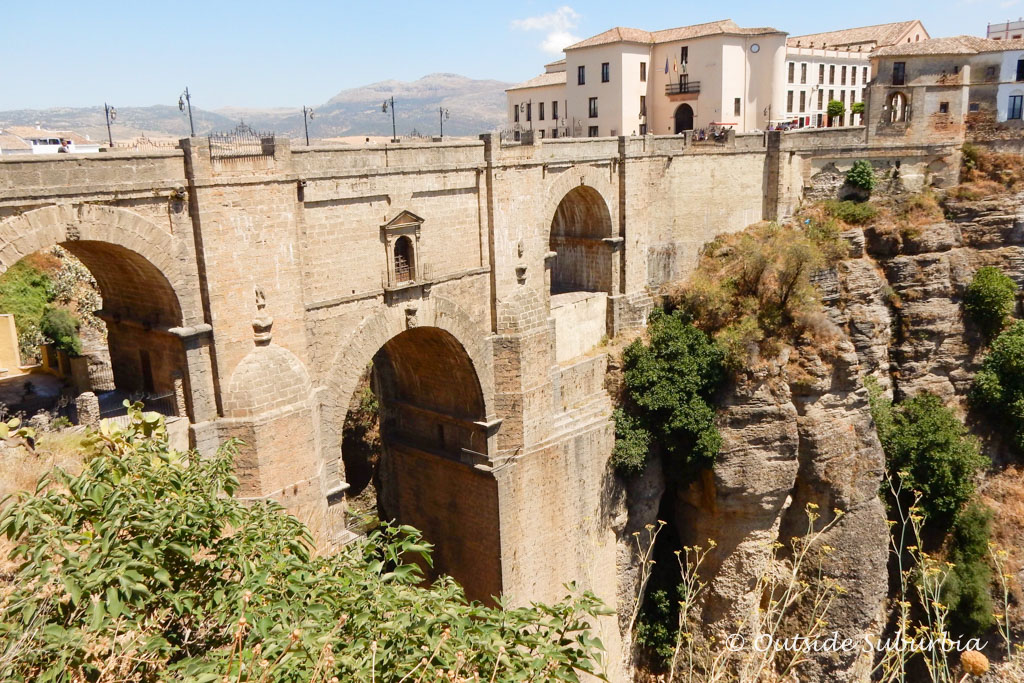
Alhambra, the Grand finale in Granada
The highlight of any trip to Granada is a visit to the Alhambra and the view from Albayzín , the old Moorish quarter is my favorite. Located on a hill across from the Alhambra, it has stunning views across to the palace. The area has a Moroccan feel to it and there are plenty of restaurants in the area that you can indulge in.
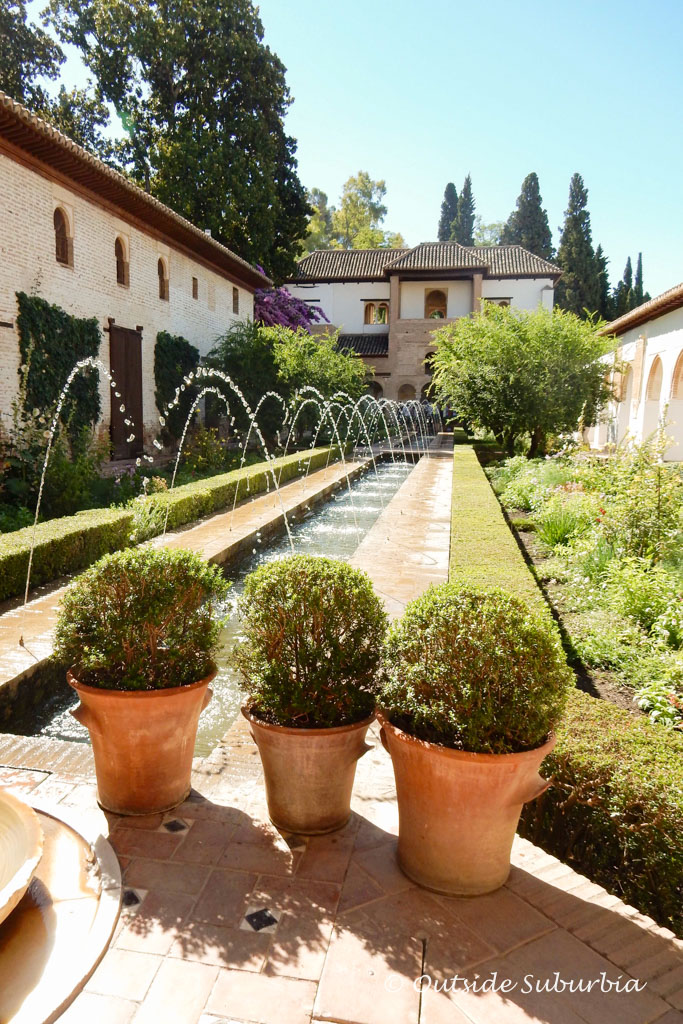
At the San Nicolás terrace , you can catch some Gypsy music, especially during sunset. We made to the terrace viewpoint just in time for the magnificent sunset view, the red sandstone seemed to glow when the setting suns ray hit. It is virtually impossible to see the Moorish masterpiece, Alhambra without advance reservations. It is definitely better to get a tour booked than trying to visit on your own.
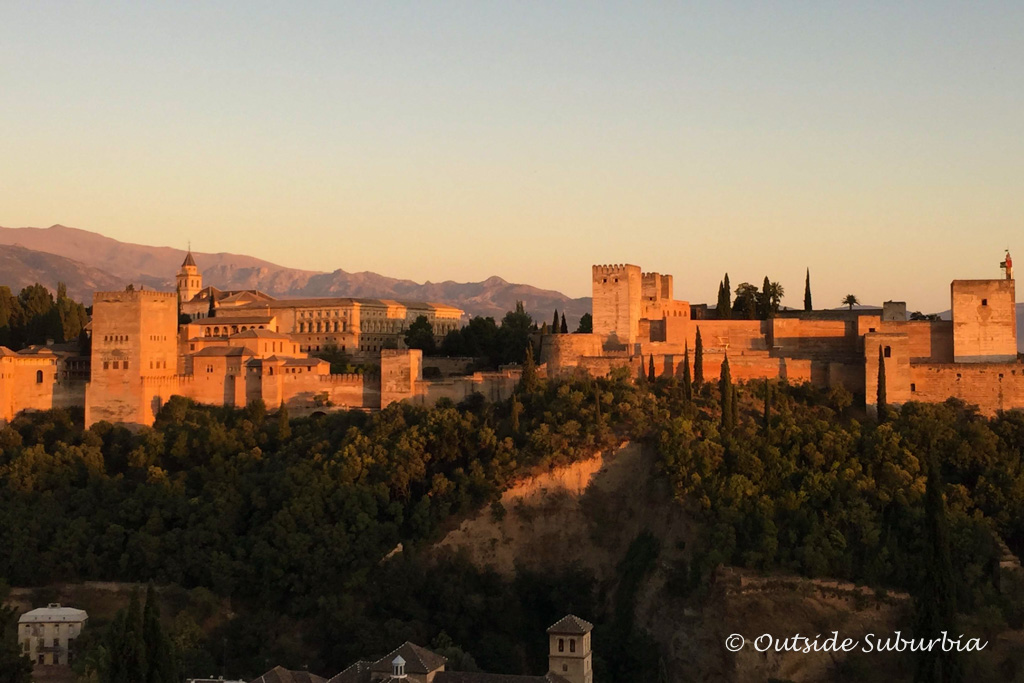
Where we Stayed in Granada: We stayed at a two bedroom suite in Granada , not counting the driving day, we had two days here. I wish we had more!
Júzcar, the White village that turned blue
If you are a fan of the Smurfs cartoon show, you might want to add Júzcar to your Andalucia, Southern Spain itinerary. Only 25 km from Ronda, it is the only Smurf village in the world. It is said that Sony Pictures executives asked this Andalusian village if they could paint the town blue as a publicity stunt for promoting Smurfs.
The residents of Júzcar, loved having the tourists visit their town and voted to keep the city blue when Sony offered to restore the town back to its iconic pueblo blanco after the promotion. If you have a couple of extra days you can add the coastal area of Malaga and Cádiz to your itinerary.
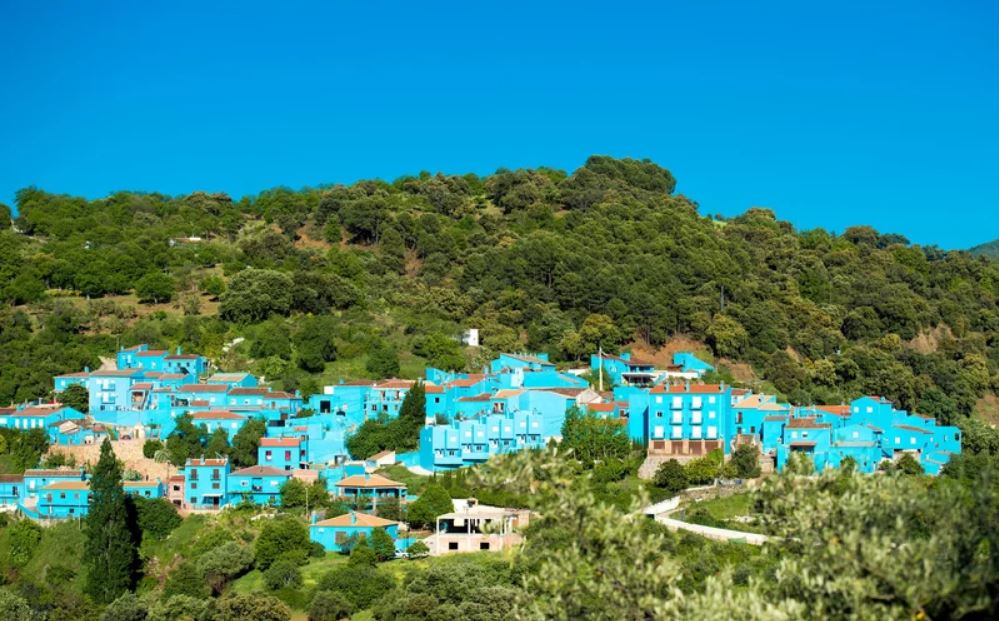
Best time to visit Andalusia / Southern Spain
Wondering when is the best time to visit Andalusia, Southern Spain? The spring and fall months of April, May, June, September, October and November are the best time to visit southern Spain . Spain is said to be at it’s most beautiful in October-November and March-May. If you are visiting during April don’t miss the festivities of Feria de Abril (Seville April Fair).
We were there during our summer break in early July, while it was hot in Andalucía and Barcelona, just plan to take an afternoon siesta and drink lots of sherry 😉 or water when out and about. The streets were crowded but lively and we had no issues getting to museums and other sites that we had planned on visiting, as always a little planning always helps.
I hope you find our 7 day Andalucia Itinerary useful when planning your trip to Andalucia. If you are considering living abroad in Spain, here is some helpful information about the cost of living in Spain.
You might also like our Family-Friendly Guide to Copenhagen , Edinburgh , Milan , Lisbon , Vienna , Bergamo , Barcelona , Venice , and Verona
You might also like: why you must visit malaga now road trip through the white villages of andalucia a day in cordoba spanish dishes, drinks and desserts you must try when visiting spain.
PIN IT FOR LATER
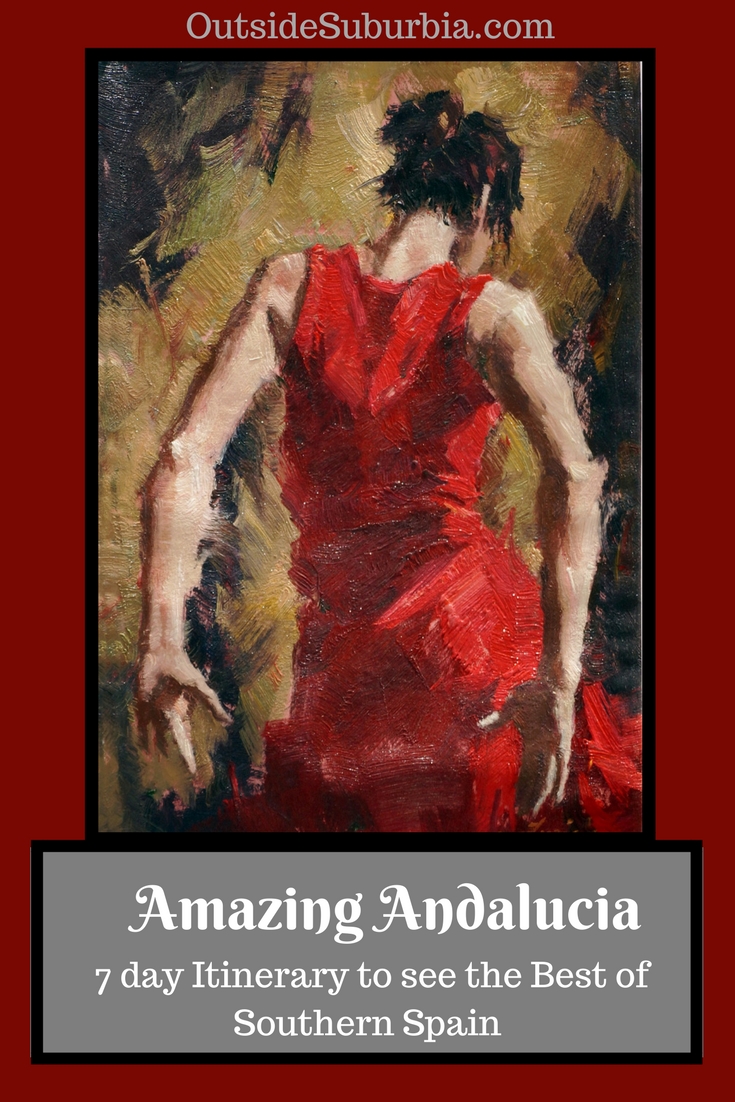
Note: This post may contain affiliate links, partnership or sponsored content. If you purchase an item via one of these links, we may receive a small commission at no extra charge to you. But as always images and opinions are our own. For more information on our affiliates and privacy policy at Outside Suburbia see here .
CONNECT WITH US
12 thoughts on “Amazing Andalucia: A 7 day Itinerary to see the Best of Southern Spain”
Going there in 2 weeks. This is super helpful.
I’m glad you found it helpful. Hope you have an amazing time in Spain.
We have stayed in Cordoba a couple of years ago. The old city is interesting place, and the cuisine is amazing, especially gazpacho.
Cordoba was a lovely place to visit. We had some of the best gazpacho and paella there.
Thanks Victor. Cordoba was a lovely place to visit. We had some of the best gazpacho and paella there.
This is just the kind of itinerary we look for when we’re traveling — lots of things to do and see, plenty of historic and beautiful sites, and a large variety of experiences. The only place I’ve been to in Spain is Madrid, and I’d love to go back and see more!
Thanks Tami! Glad you found the itinerary useful and get to plan a trip back to Spain soon.
This sounds like a fabulous itinerary – thankyou for sharing! We recently took in Barcelona on a whirlwind RTW trip, and fell in love, so I would love to get back and explore more of Spain. I’ve heard that Andulucia is fabulous for a road trip, so that’s the goal. So glad to hear that Seville lives up to its hype – I would love to catch a flamenco show here as you did. And then driving through the route of the white towns, and visiting Juzcar too – what a cool itinerary, thanks!
Thanks Megan, hope you get to plan the trip back to Spain soon.
I’ve been to Spain so many times but never to Seville, will have to get there some day soon it looks like such a grand and colourful city. With lots of fantastic photo opportunities. Funnily enough, the other day I was looking at places to relocate to and Seville came up as a great city for expats.
Seville has so much character and history that sometimes might be overshadowed by Madrid and Barcelona. Thanks for reminding me how many great places to explore and things to do in the area! I would definitely book the tickets for a Flamenco Dance show, because this is after all, it is the birthplace of the performance. @knycx.journeying
We were able to see Seville but missed that wooden mushroom and those white villages around. But we got to see Mijas near Malaga. Glad we got to the finale, the Alhambra in Granada! Spain is really beautiful and we missed half of what you saw!
Leave a Reply Cancel reply
Your email address will not be published. Required fields are marked *
Want to make your trips memorable?
Join our newsletter and get the inside scoop on cool destinations, earth-friendly hotels, luxury stays, easy adventures, and authentic travel inspiration!
Email address:

The Perfect Andalucia Road Trip: Itinerary, Map & Tips
This post may contain affiliate links, from which we earn an income. Click here to read our affiliate policy.
South of Spain Road Trip Guide
Andalucia epitomizes southern Spain; vibrant, colorful, and passionate . This ultimate Andalucia road trip itinerary will take you to the major cities and best places to visit, bringing this gorgeous part of Spain alive.
Andalucia is Spain’s most southerly region, heavy with Moorish influence, which is evident in the wonderful food and architecture, beautiful and romantic cities, the passion of flamenco, and its iconic Pueblo Blancos set amidst stunning landscapes that you won’t want to leave.
We have spent years visiting and traveling in Andalucia, and in this road trip planner, we share travel tips, the best route between towns and cities, things to do and see along the way, side trips, and hotel recommendations to help you plan your perfect road trip through Andalucia.
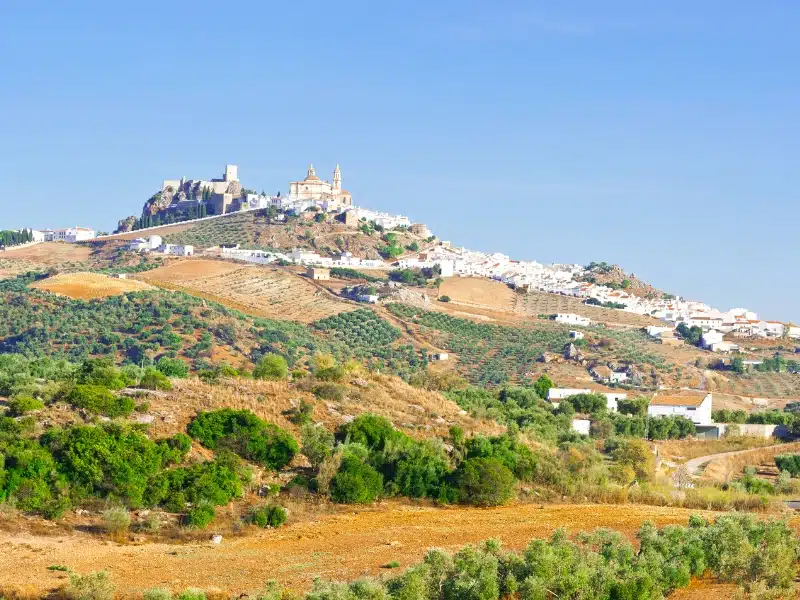
Is this your first time visiting Spain? Get all the information you need in our Spain Travel Guide , including what to pack, the best time of year to go, getting there, and practical tips to help you have the best trip!
Where is Andalucia?
Sometimes called Andalusia (the Anglicised name), Andalucia is the southernmost autonomous community in peninsular Spain. Arguably Spain’s most famous region, Andalucia stretches from the border with Portugal in the west to the border with Murcia in the east, and nearly 300km / 186 miles north into Spain’s mountainous interior.
Andalucia has coasts on both the wild Atlantic, and gentler Mediterranean Sea and enjoys five costas ; Costa del Sol; Costa de la Luz (Huelva and Cadiz); Costa Tropical, and Costa de Almería, and each has its own distinct character.
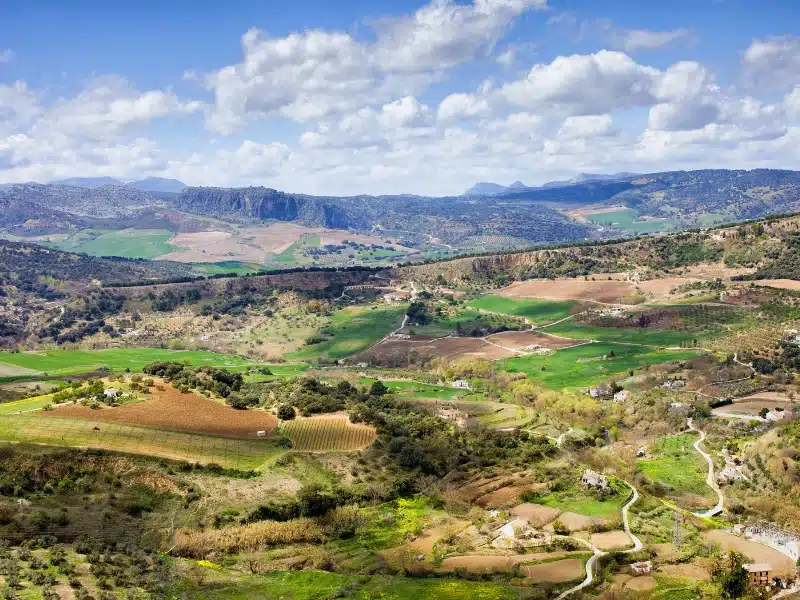
Getting to Andalucia
Whether you’re taking a road trip to Andalucia in a car, motorcycle, or campervan, self-driving is absolutely the best way to road trip southern Spain.
You can stop whenever you want, try new activities, visit places you see along the route, and have the freedom to change plans at the last minute.
Fly into Málaga-Costa del Sol Airport, the perfect place to start your roadtrip in southern Spain. With direct flights from America, Europe, and the UK, we recommend booking through Skyscanner for live deals and the best prices.
Are you planning to rent a car in Andalucia? As one of the largest car hire aggregator companies in the world, we recommend Rentalcars.com because they have massive purchasing power which enables them to secure the best car rental prices, which benefits you when you’re planning an Andalusian road trip.
For a real adventure, hire a motorhome or campervan in Spain. We recommend Motorhome Republic , an aggregate booking site who pull together all the best deals from a number of rental agencies, to offer you a wide choice of options alongside an excellent English speaking expert motorhome Concierge Team.
Andalucía Road Trip Map & Itinerary
- Get the Travel Guides
- Lonely Planet Andalucia
- Rough Guide to Andalucia
- DK Eyewitness Top 10 Andalucía and the Costa del Sol
- Andalusia Road Trip Itinerary
Malaga – Marbella – Ronda – Cadiz – Jerez de la Frontera – Seville – Carmona – Ecija – Antequera – Cordoba – Granada – Nerja – Malaga
- Distance: 1041km
- Duration: 10-14 days
- Drive Time: 14 hours
How to use this map – Use your fingers (or computer mouse) to zoom in and out. Click or touch the icons to get more info about a place, and click the arrow in the box top left to open the index. To add to your own Google Maps account, click the star next to the title of the map.
Make sure you have travel insurance you can trust when visiting Spain . We recommend True Traveller for their 5-star TrustPilot reviews, variety of cover options, best activities cover as standard, great prices, and excellent service.
Southern Spain Road Trip Itinerary
The first stop on this 10-14 day road trip is Malaga. Pick up your rental car or campervan at Malaga Airport and within an hour you’ll be at your hotel or on the road.
Malaga has lots to do with a lively city centre busy with bars, restaurants, cafes, and people. Don’t be put off by the high-rise buildings and billboards, look beyond and you will find a charming and historic city famous for its warm welcome.
In regal Malaga’s old town, you’ll find La Alcazaba, an ancient fortress dating back to the 700s, as well as the cathedral and several pretty churches. Another must-see is the Mercado de Atarazana , one of the best fresh food markets in Andalucia. Make your way to El Bar de los Pueblos, opposite the market to the left as you face the main entrance, for fantastic and authentic tapas.
Malaga comes to life on the seafront and is a popular place for Malaguenos to go for a stroll after siesta time, which is a fiercely protected custom in the south of Spain. Come to the seafront after 5pm and you’ll find whole families out, enjoying the sunshine and stopping for a beer and tapa along the paseo , even during the Spanish winter .
If you’re feeling energetic after all the eating, then head into the lush hills of the Montes de Malaga to the 10th century Castillo de Gibralfaro , for a great view of the city, port, and coastline. From the Alcazaba, it’s a 30 minute uphill walk – if that’s a bit too energetic, the Malaga hop-on hop-off bus also visits the Castillo .
Malaga is also the perfect base for a day trip to the stunning Caminito del Rey, the once-hidden Gorge of Gaitanes, which is deep in the hinterland. It’s a 50km trip to El Chorro, where the route takes you along suspended walkways through an impossibly narrow gorge – expect fantastic views, fascinating rock formations, and lots of other people!
We highly recommend this Caminito del Rey guided tour from Malaga , where a bus will take you to the start of the hike, and you will learn the real story behind the construction of this great work of engineering from your guide.
If you don’t have much time, here is where you switch up the itinerary and take a Malaga to Seville road trip! From Seville head to Cordoba and then Granada, for a perfect Andalucia itinerary in 7 days.
Our Tip: For real Malaga, head to the Pedregalejo district where you will find freshly caught grilled seafood being served from chiringuitos on the beach.
- Where to Stay in Malaga
Upmarket: Vincci Selección Posada del Patio – Booking.com | Agoda
Mid-Range: Molina Lario – Booking.com | Agoda
Budget: Debambú Atarazanas – Booking.com | Agoda
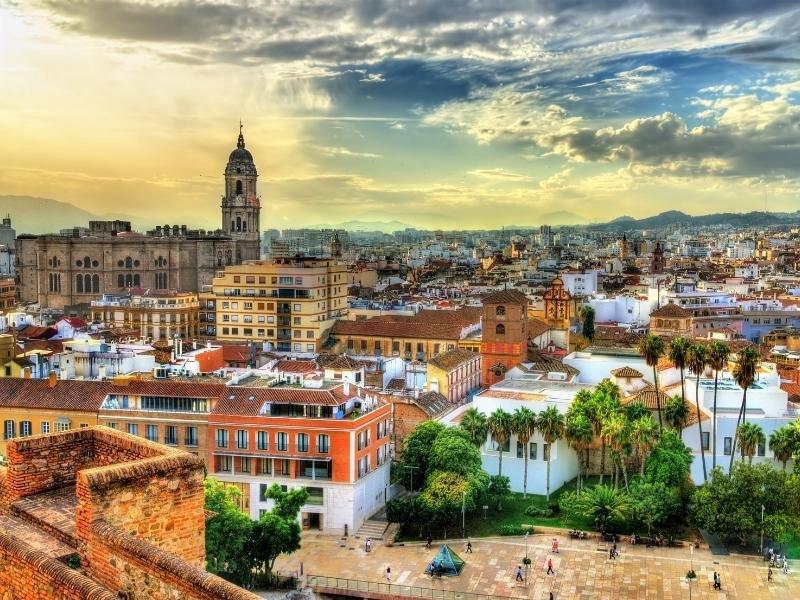
Don’t forget your road trip essentials! Our free road trip checklists help you remember everything, including road trip snacks , podcasts , and road trip songs for the journey!
2. Marbella
In Marbella, spend a day soaking up the sun on one of the three immaculately kept beaches and enjoying the people-watching. The days of big celebrities here are long gone, but there is still a touch of glitz and glamour to enjoy.
Visit the charming old town and head for Plaza de los Naranjos at the center of the casco antiguo and enjoy a coffee whilst watching the world go by, or head to the artisan boutiques and upmarket shops which surround the pretty square.
Or, if you like things organized for you, enjoy this highly-rated guided walk of Marbella’s historic centre where you get to try traditional tapas, local wine, and olive oils as you go.
If you have a few extra days, add to your Costa del Sol road trip by staying on the coast road and enjoying the pretty towns and beaches, until you reach Estepona. From here you can head north and explore Andalucia off the beaten track, through the stunning Natural Park Los Reales de Sierra Bermeja, to reach Ronda.
Our Tip: For lunch, find Taberna Casa Curro Marbella for freshly homemade tapas and fruity Spanish wine.
- Where to Stay in Marbella
Upmarket: Nobu Hotel Marbella – Booking.com | Agoda
Mid-Range: Amare Beach Hotel – Booking.com | Agoda
Budget: Ona Alanda Club Marbella – Booking.com | Agoda
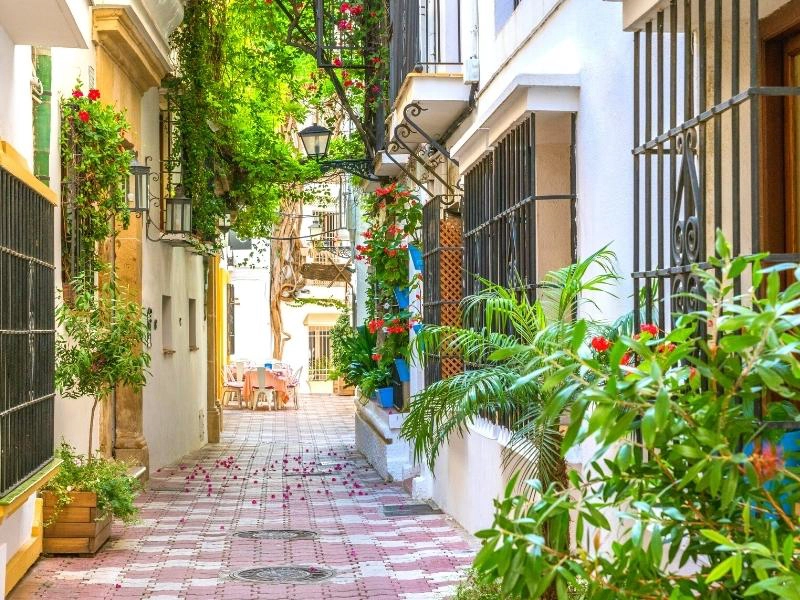
Want to plan your own road tri p? Get our step-by-step road trip planning guide to help you organize the perfect trip or check out our favorite road trips in Europe for inspiration!
The drive from Marbella to Ronda is stunning, one of the best during this road trip in Andalucia. Situated between the natural parks of the Sierra de Grazalema and the Sierra de las Nieves, Ronda sits in a bowl surrounded by dramatic mountains.
As you head to Ronda, take a detour to the blue village of Júzcar , in the Valle del Genal. The village was a pueblo blanco until 2011 when it was asked to paint itself blue to promote The Smurfs movie!
Ronda is divided by the huge 120m deep river gorge of El Tajo, which is spanned by the stunning arched bridge of Puente Nuevo. The bridge is best seen from the beautiful La Casa del Rey Moro , where you’ll find lush and fragrant gardens and a spectacular view. For a more exciting view, tackle the vertical walls of the Tajo del Ronda using the via Ferrata route with a guide !
Bull-fighting is a divisive sport but a passion of the Spanish people, and the Plaza de Toros bullring in Ronda is architecturally spectacular. It’s interesting to learn the history of the corrida, in the well-laid-out and informative museum.
Understanding the love and admiration Spaniards have for the matadors’ courage and showmanship is key to understanding their love of bullfighting.
From Ronda, you are perfectly situated to take day trips to the iconic Pueblos Blancos or White Towns in the surrounding mountains, where you’ll find some of the best and most beautiful of the small villages.
Just north of Ronda are two such white villages: Zahara de la Sierra and Setenil de las Bodegas. Both are worth visiting, and the latter is known for its whitewashed houses built into the surrounding cliffs and that famous image, the one with the huge rock covering half the narrow street and its houses.
Our Tip: For a spectacularly scenic drive from Ronda, set your sat nav for Zahara de la Sierra and then pick up the twisting CA-9104 road to the tiny village of Grazalema, which climbs to the Puerto de Las Palomas (Pass of the Pigeons), at 1180m it’s a spectacular drive and worth the fuel to get there!
From Grazalema, pick up the A-372 across the Sierra de Grazalema Natural Park to Arcos de la Frontera, and from there the A-382 and E5 to Cadiz.
- Where to Stay in Ronda
Upmarket: Molino Del Santo – Booking.com | Agoda
Mid-Range: Catalonia Ronda – Booking.com | Agoda
Budget: Hotel Sierra Hidalga – Booking.com | Agoda
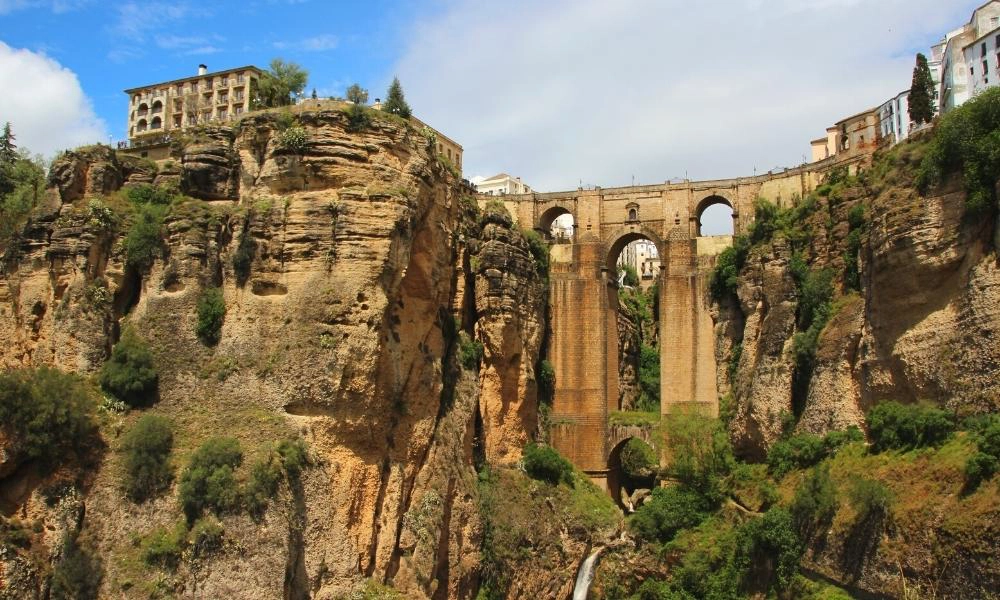
Looking for the best SIM card deals in Europe for your trip? Check out our guide to the best data SIMs in Europe and get the best deal for your trip to Spain.
The famous faded splendor of the sea city of Cadiz is caused by the effect the sea air has on its architecture, leading to the facades of buildings crumbling and bleaching.
This imbues Cadiz with a sombreness that contradicts the true character of the city. In fact, Cadiz is known for its party vibe, especially during carnival, one of the naughtiest in Spain!
Almost completely surrounded by the waters of the Atlantic Ocean, Cadiz is a fabulous city for simply wandering and soaking up the ambiance. Narrow buildings with painted facades, twisting back streets, pretty flower-filled squares, and a few fabulous churches await you.
Take a guided tour of medieval Cadiz , and see all the city’s landmarks, including the Neoclassical and Baroque cathedral and its museum, the Roman theater in the area known as the Pópulo, and structures dating back as far as the Phoenician era.
End the day by watching a perfect sunset from Playa de la Caleta, situated right in the old town.
Head out for food and you’ll find it’s all about fish! Whether you fancy picking your fish and having it cooked for you at Mercado Central de Abastos, or you’re looking for a plate of fabulous fresh tapas for dinner with a fino sherry or locally caught seafood, you’ll find it in Cadiz.
- Where to Stay in Cadiz
Upmarket: Hotel Monte Puertatierra – Booking.com | Agoda
Mid-Range: Hotel Casa de las Cuatro Torres – Booking.com | Agoda
Budget: Casual con Duende – Booking.com | Agoda
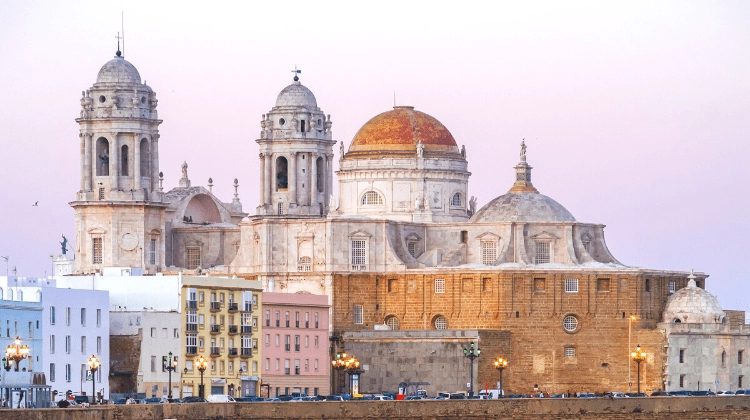
Costa de la Luz Side Trip
If you have extra time, Cadiz is a wonderful halfway base for a few days. Explore more or take a day trip to the aptly named Costa de la Luz, which extends south to Tarifa, the most southern point of mainland Europe, and north to the port city of Huelva.
Off the beaten path to the south are beautiful beaches dotted with chiringuitos serving locally caught fish, pretty white villages like Vejer de la Frontera, quietly unassuming yet packed with history and architectural gems, and the fabulous Cape Trafalgar, the site of the 1805 naval Battle of Trafalgar, in which the British Royal Navy commanded by Admiral Horatio Nelson decisively defeated Napoleon’s combined Spanish and French fleet.
Head north for Christopher Columbus history in La Rábida, where you can see life-sized replicas of the ships he sailed across the Atlantic for the New World (and they are tiny ) and the Monasterio de Santa María de la Rábida, where the explorer stayed as he was preparing for the trip.
RELATED POST: Tarifa Guide: Best Things to Do + Top Visitor Tips
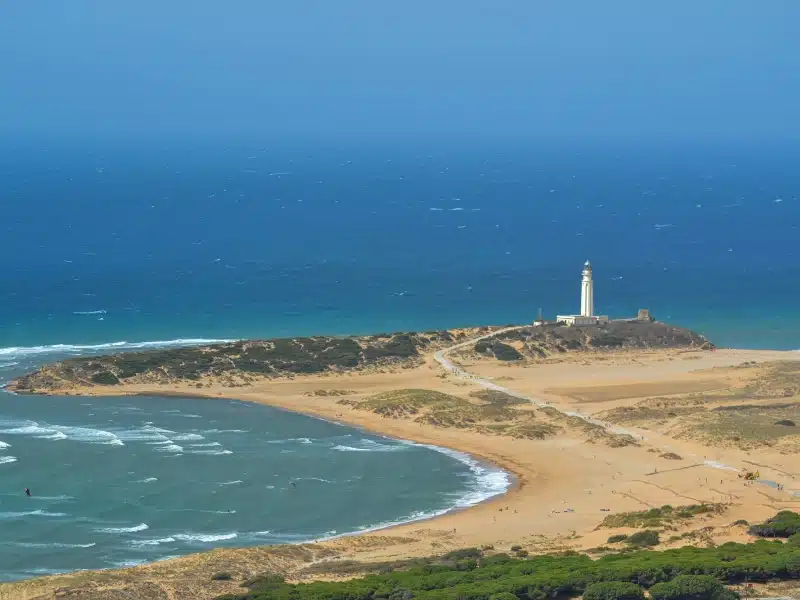
Spain Travel Ideas
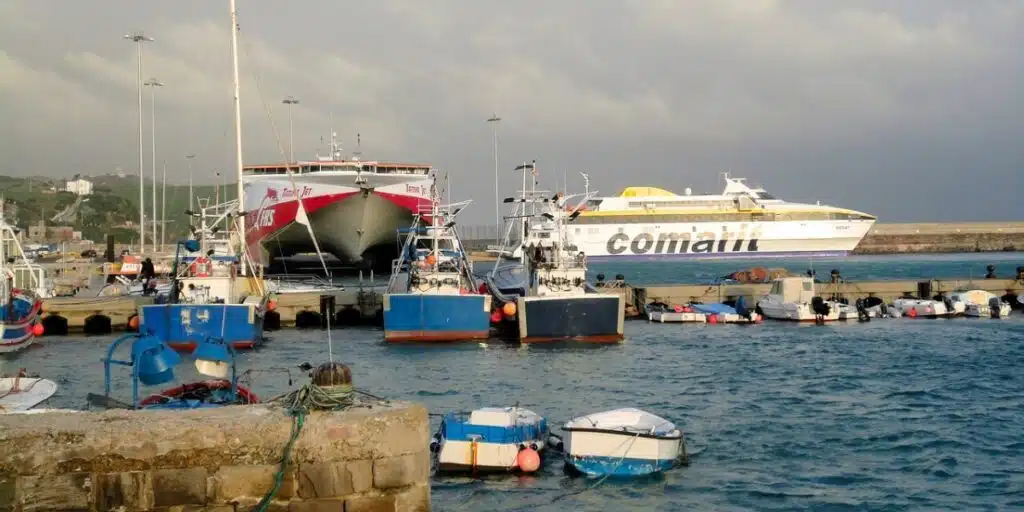
Ferry from Spain to Morocco: Best Options & Top Tips
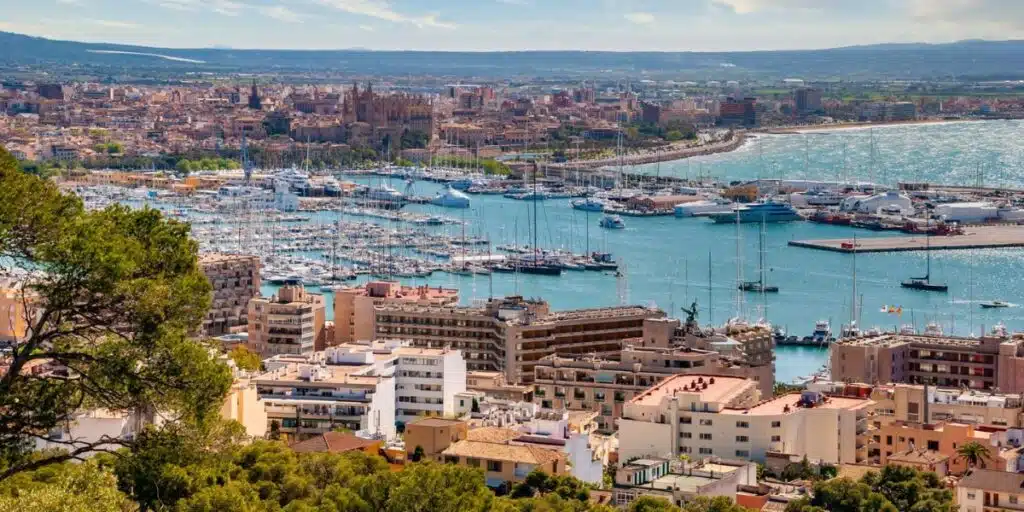
Palma de Mallorca: The Best 2 Day Itinerary

Discover the Magic: 32 of the Best Christmas Markets in Europe
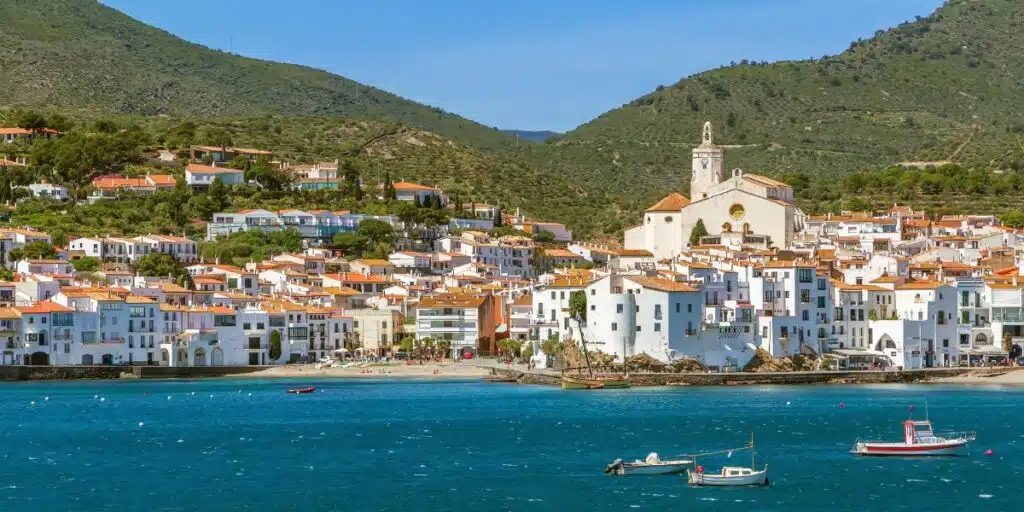
Fall in Love with Spain: 20 of Our Favorite Things to See & Do
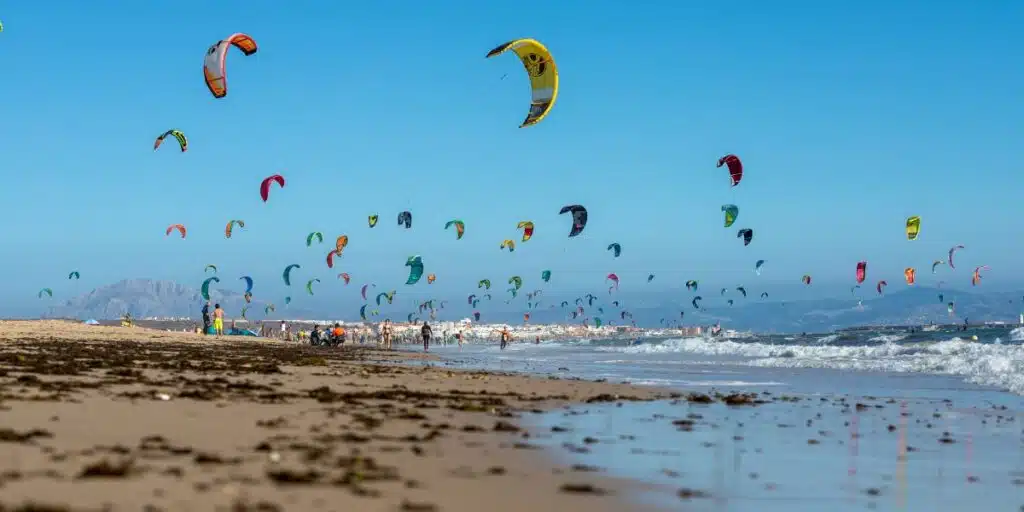
Tarifa Guide: Best Things to Do + Top Visitor Tips
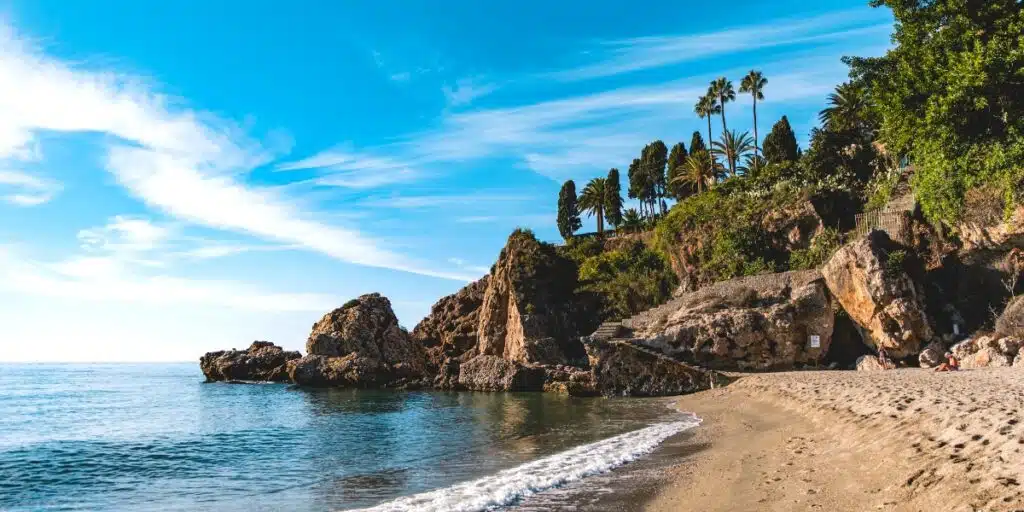
Wintering in Spain: Best Winter Destinations in Spain
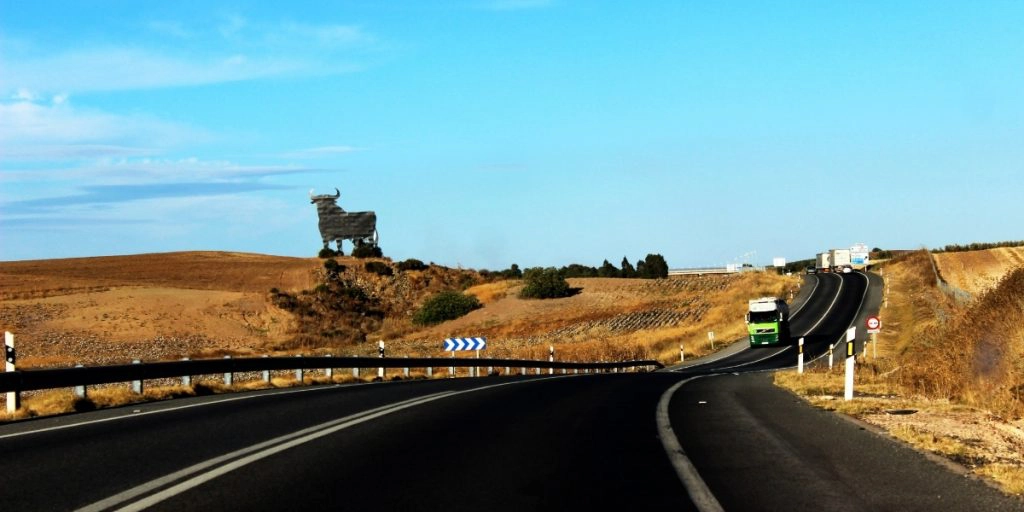
Driving to Spain from UK: Best Routes & Driving Tips
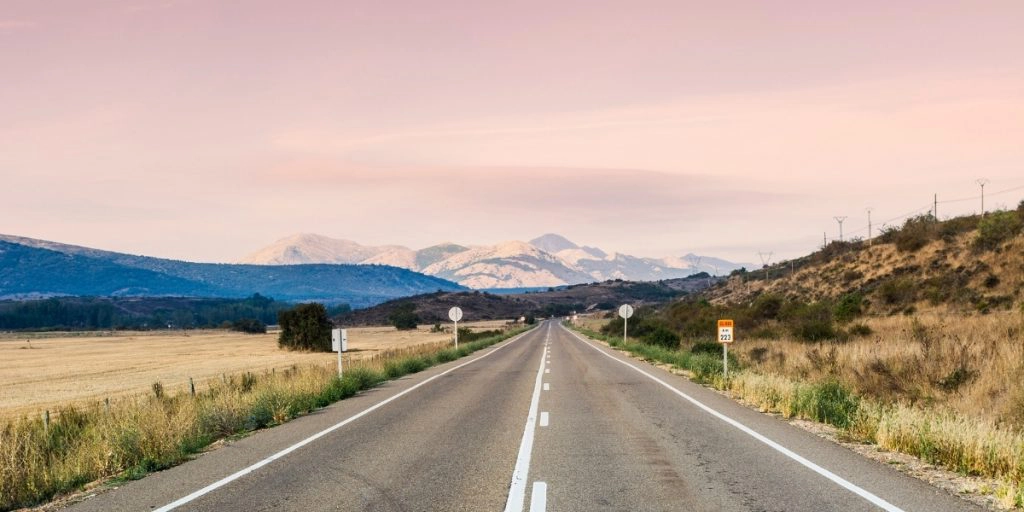
Spain Road Trip: 8 Amazing Routes for an Epic Trip
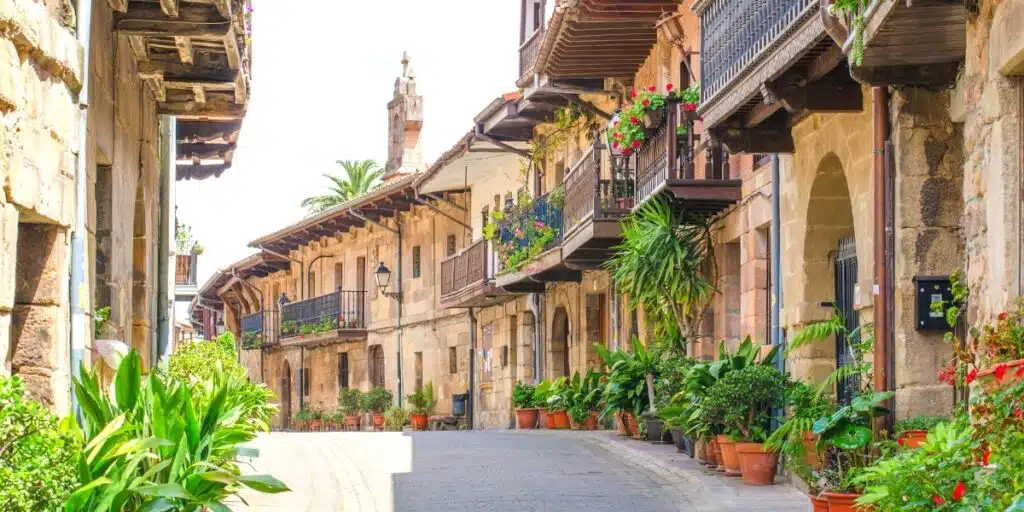
North Spain Road Trip: Itinerary, Route & Tips
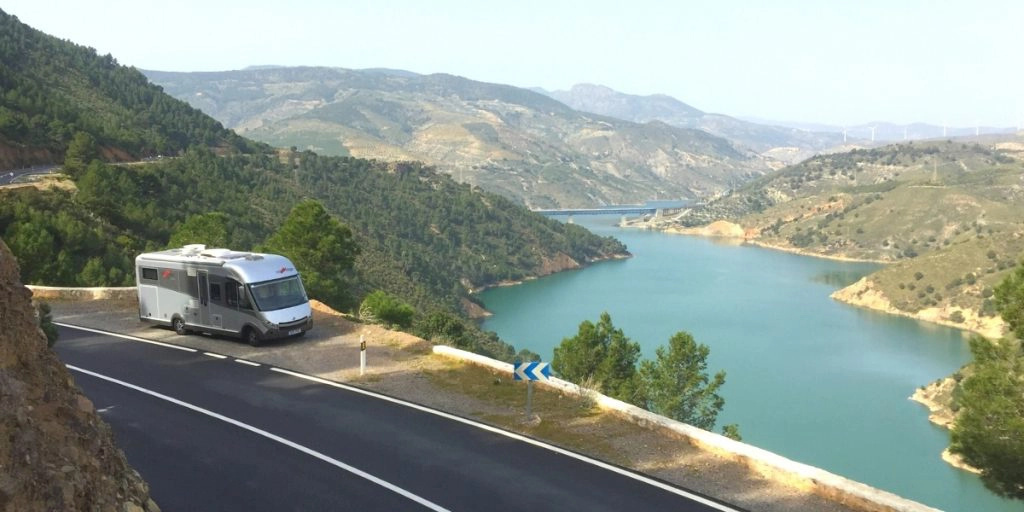
Motorhoming in Spain: Your Complete Guide for 2024
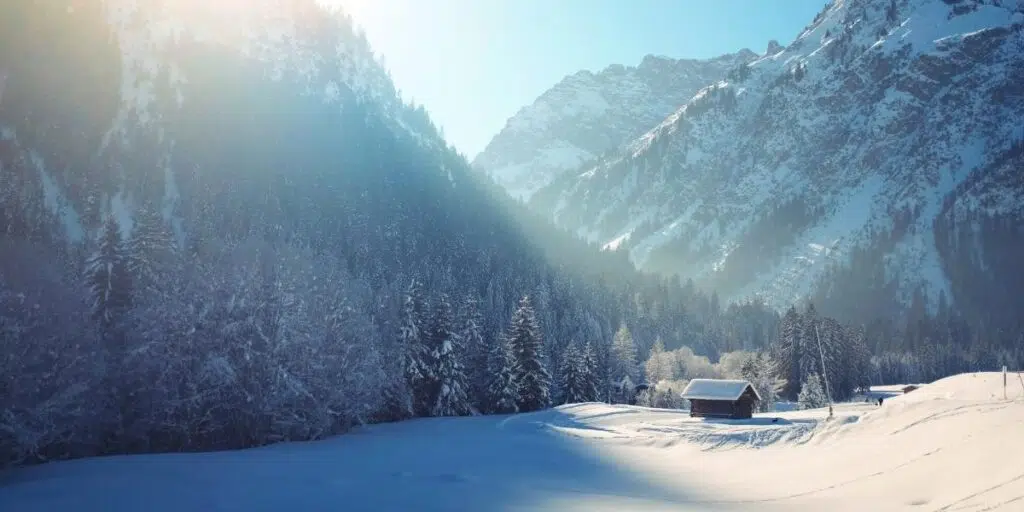
Winter Destinations Europe: 23 Amazing Wintry Places

Where is Hot in January in Europe? Top 36 Warmest Places
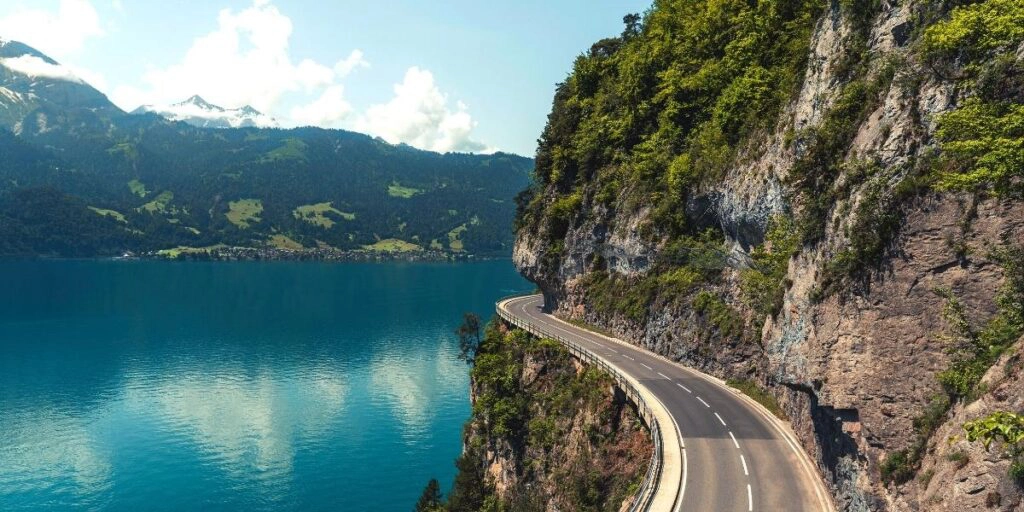
Europe Road Trip – 24 Incredible Routes
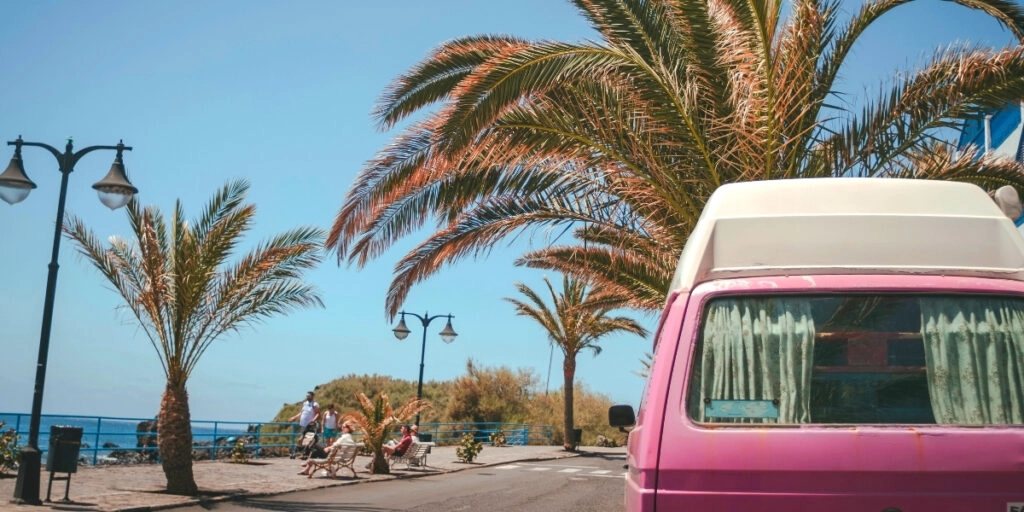
Motorhome Aires in Spain – All You Need to Know
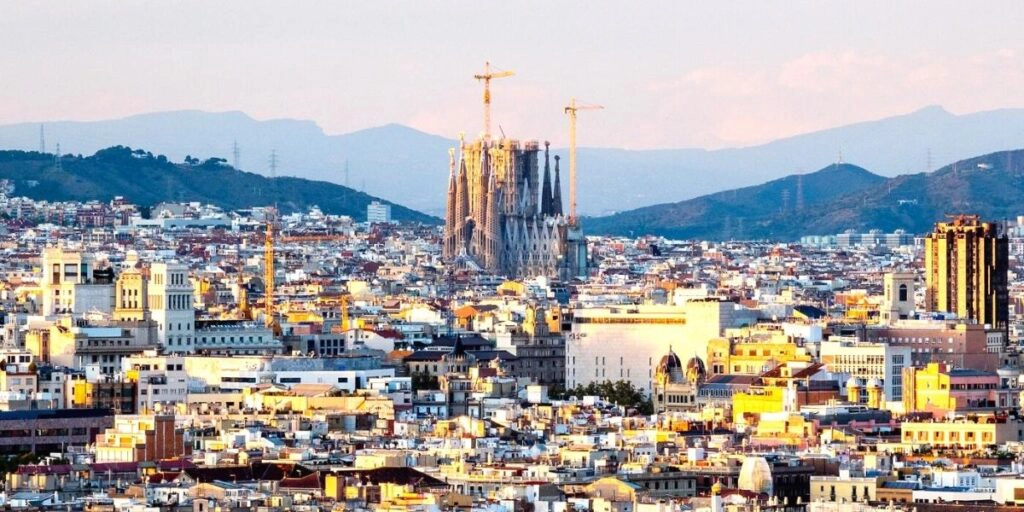
One Day in Barcelona – Itinerary, Map, Tips & Guide
5. jerez de la frontera.
Jerez de la Frontera has been the home of sherry since the 14th century. The particular local soil, climate, and grape variety combine to create this complex and often delicious fortified wine which can only be produced in the so-called ‘sherry triangle’, which holds the Denominacion de Origin of Jerez y Sanlúcar de Barrameda.
The nearby towns of Sanlúcar de Barrameda and El Puerto de Santa María are the other points of the triangle, which is bordered by the Atlantic Ocean, the majestic Guadalquivir River, and the beautiful Cádiz Sierra mountains.
All sherry is made from three green grapes only: Palomino, Moscatel, and Pedro Ximenez. The wine is aged and blended using a system called solera y criadera , a process for aging liquids by fractional blending so that the finished product is a mixture of ages. There are some sherry bodegas with soleras dating back hundreds of years, so with every sip you’re drinking a little bit of history.
You cannot go to Jerez without visiting a bodega and taking a tour with a tasting session at the end to understand how this often misunderstood drink is created. Be prepared though – there are seven types of sherry ranging from the very dry Fino to the sticky sweet Pedro Ximenez, my favorite!
As well as sherry, Jerez is also famous for its flamenco tradition. Flamenco literally means ‘hell-raising’ and when you watch this steamy and seductive dance you’ll understand why!
Considered an art form in Spain, you’ll find flamenco clubs aplenty in the narrow streets of the Barrio de Santiago quarter, but it’s probably easier to book a live flamenco show in advance – instead of getting lost in the narrow twisting alleys looking for a bodega , you’ll have the best seats in town!
- Where to Stay in Jerez de la Frontera
Upmarket: Hotel Bodega Tio Pepe – Booking.com | Agoda
Mid-Range: Villa Jerez – Booking.com | Agoda
Budget: Suites Alfonso X – Booking.com | Agoda
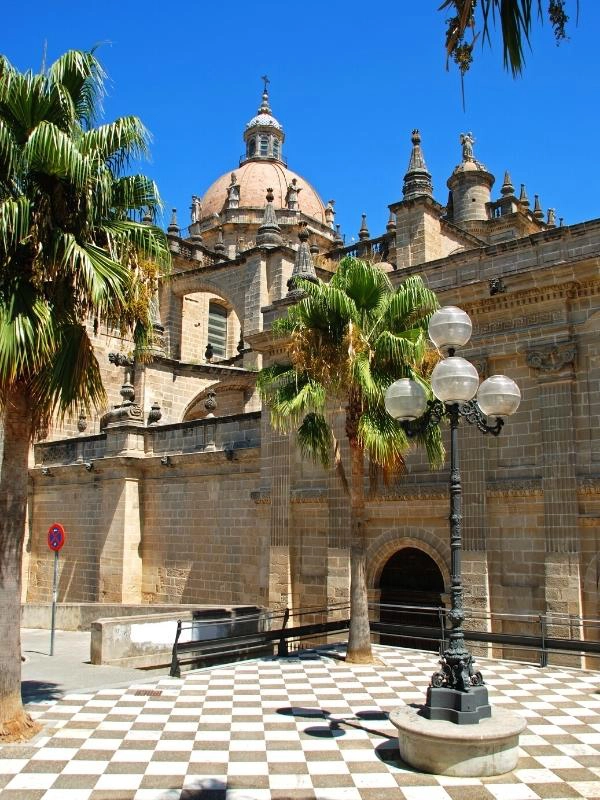
Are you looking for more Spanish road trips? Get the best itineraries to see northern Spain and the cities of Barcelona, Valencia & Madrid in our guide to the best road trips in Spain .
The Andalus capital of Seville is a gloriously beautiful city and is just as you expect it to be. Hot, passionate, loud, and colorful, this city is unashamedly flamboyant. And it just happens to be our favorite place in Spain.
In the old town, you’ll find three of Seville’s best attractions; Seville Cathedral in all its Gothic splendor, the imposing Giralda Tower, and the stunning Alcazar. It’s highly recommended to visit all three for a real taste of Seville’s fascinating history .
The UNESCO Seville Cathedral or Santa Maria de la Sede , occupies the original site of the great Aljama mosque, built in the late 12th century. The only remaining parts are the Patio de Naranjas, the Puerta del Perdon, and the Giralda Belltower which was formerly the minaret.
The largest Gothic cathedral in the world, as well as the world’s third largest church, the spectacular Seville Cathedral, is home to the tomb of Christopher Columbus, who set sail for the New World from Huelva, a city and province of Andalucia that abuts Portugal.
Havana, Cuba, and Santo Domingo in the Dominican Republic all claim to hold the remains of Cristobal Colon, as he is known in Spain but recent DNA tests proved beyond doubt that this tomb is the final resting place of the great explorer, who died in poverty in Valladolid in 1506.
The Royal Alcazar of Seville is a stunning historic royal palace formerly the site of the Islamic-era citadel of the city, was first constructed in the 10th century and then developed into a larger palace complex by the Abbadid and Almohad dynasties. After the Castilian conquest of the city in 1248, the Alcazar was rebuilt and replaced by new richly decorated Mudéjar-style palaces built by Pedro I during the 1360s.
Just south of here in the Parque de María Luisa is the lively Plaza de España which was built in 1928 for the Ibero-American Exposition of 1929.
With half a mile of tiled fountains and pavilions lushly planted with palms, orange trees, Mediterranean pines, and stylized flower beds, Plaza de Espana is a great place to wander and people-watch, as you take a boat out on the small lake, catch some live flamenco and Spanish guitar, or admire the beautifully tiled alcoves, each representing a different province of Spain.
Right next to the old town, you’ll find the narrow alleys of the Barrio Santa Cruz, the heart of Seville’s lively tapas culture offering some of the best plates in Andalucia.
Sevillanos eat their tapas standing at the bar with a small beer or sherry but why not take a seat and watch the world go by to make the most of the atmosphere on the streets? Go slowly though, you could easily spend a small fortune on plate after plate of delicious tapas!
In the busy shopping streets of the Centro quarter to the north, you’ll find the contemporary Metropol Parasol, a huge wooden structure that is reported to be the largest in the world. This gorgeous wooden structure is shaped like a fluid parasol and shades much of the square in which it stands.
At the top of the viewing platform, you can admire its form and design whilst enjoying fantastic rooftop views of the Seville city center.
For more travel tips and information check out this one day in Seville itinerary or book an e-bike tour of Seville with a local guide , it’s a great way to see the city!
Our Tip: There are over 40,000 orange trees lining the streets of Seville, and the frangrance of azahar (orange blossom fills the air in spring. If you visit in winter you’ll see the fruit dropping to the pavements, free for people to pick up. But don’t try eating one, these are sour Seville oranges used to make bitter marmalade and they taste pretty disgusting!
- Where to Stay in Seville
Upmarket: Hotel Casa Del Poeta – Booking.com | Agoda
Mid-Range: Hotel Rey Alfonso X – Booking.com | Agoda
Budget: Zenit Sevilla – Booking.com | Agoda
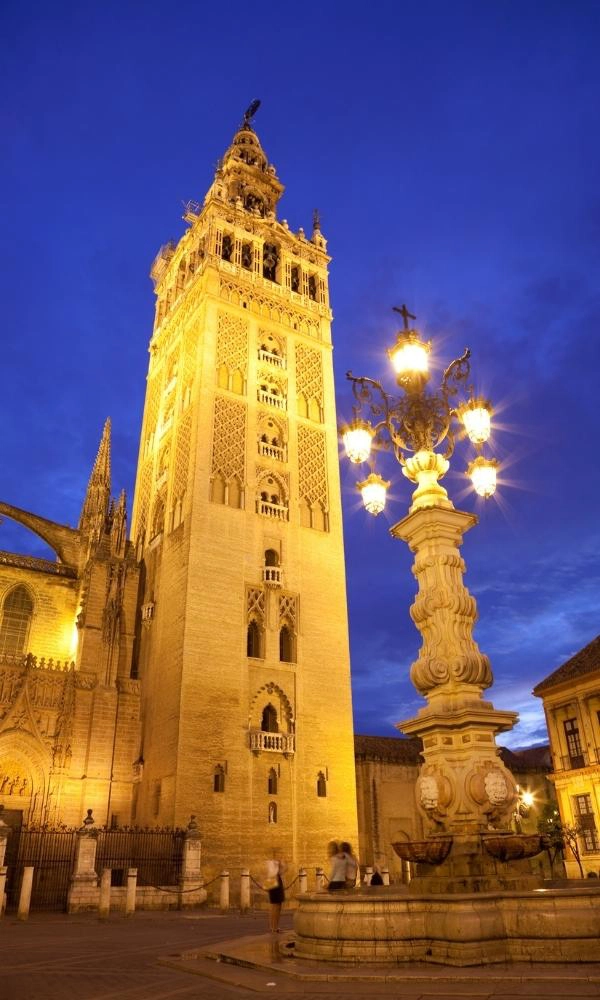
From Seville, head towards your next stop of Carmona, nestled in the hills and olive groves between Seville and Cordoba, and one of the oldest towns in Europe.
The main attraction is the Roman ruins a short drive west of Carmona. These ancient ruins comprise of a 1st century amphitheater and Roman burial ground, the Necropolis Romana. The Necropolis was discovered and excavated in the 19th century and holds several tombs and family mausoleums from the 1st Century BCE to 2 CE. There is also a small museum on site.
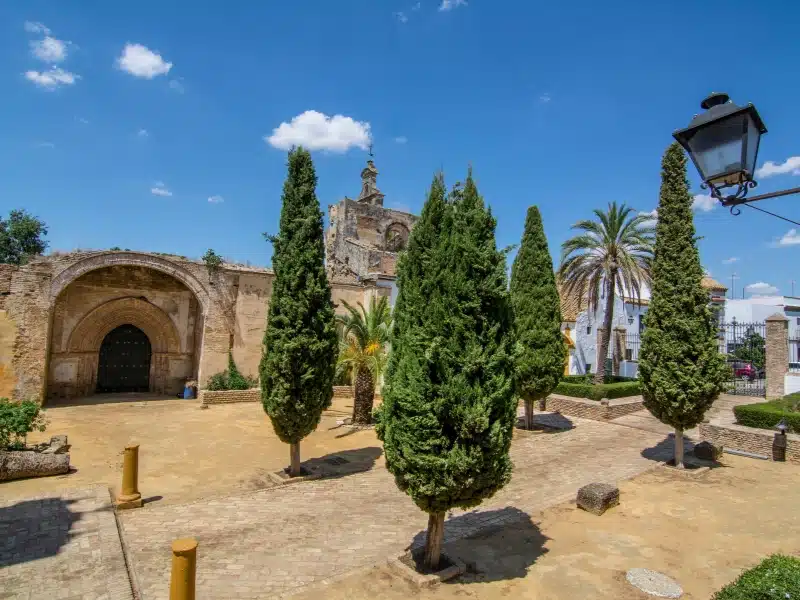
About 30 minutes after leaving Carmona, stop at the small town of Ecija. This was a Roman city that later became Visigoth and Moorish, before being reconquered by the Castilian king Ferdinand III in 1240, when it became Christian.
Ecija has plenty of monuments of interest such as the Palaces of Benameji, Peñaflor, Valdehermoso, Palma, and Santaella, seven convents dating from the 16th to 18th century, and six churches!
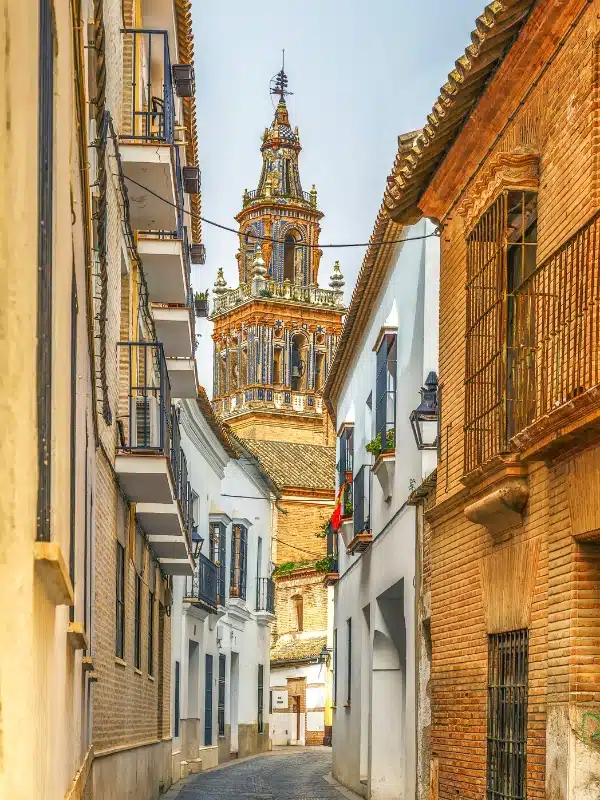
Rich in history and Moorish architecture, Cordoba is an intimate and atmospheric city, most famous for the ancient Mezquita (mosque-cathedral).
La Mezquita is a remarkable building, the result of a mosque built well over a thousand years ago and added to numerous times before being consecrated as a Catholic cathedral in 1248 by the conquistadors who freed Spain from the rule of the Moors in the same year.
The result is an eclectic mix of Moorish and Renaissance architecture that blends to create a cathedral unlike any other in the world and is the one place you must visit in Cordoba.
Take a Mezquita guided tour with skip-the-line tickets to fully appreciate the history of this incredible building, and if you can, book a slot to climb the bell tower at sunset, the views are really spectacular.
The gardens of the Alcazar provide contrast and relief from the, at times, overwhelming Mezquita. With sparkling water, tall palms, and cypress trees, this is a perfect spot to stop for an hour or so before taking a stroll across the beautiful Roman Bridge, thought to be built in the 1st or 2nd century, for a fabulous view of the old town.
Meander through the Jewish quarter where you’ll find narrow lanes and pretty squares. Many of the whitewashed houses are covered in blooms from window boxes filled with colorful trailing geraniums in summer, providing the perfect images of this gorgeous city.
Our Tip: Don’t go out for dinner until at least 9pm, or you’ll be eating in an empty restaurant with no ambiance at all! Make sure to try a Fitifiti after dinner. A mix of sweet dessert wine like sherry or local montilla mixed with white wine, this is a popular digestif in Cordoba.
- Where to Stay in Cordoba
Upmarket: Las Casas de la Juderia – Booking.com | Agoda
Mid-Range: Balcón de Córdoba – Booking.com | Agoda
Budget: La Boutique Puerta Osario – Booking.com | Agoda
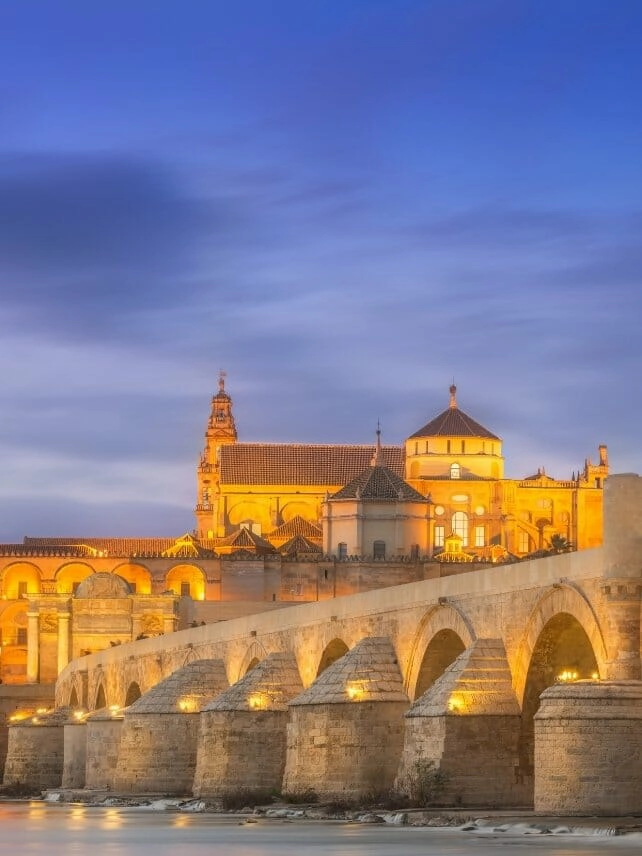
Jaén Side Trip
Well off the beaten path and a 90 minute long drive from Cordoba, Jaén hosts a cultural heritage and diverse architectural legacy that reflects the coexistence over centuries of three major cultures: Christian, Jewish, and Moorish.
Jaén’s historic Jewish quarter is a tapestry of pretty squares, remarkable historical churches built on top of old mosques, palaces, and Arabian baths, scattered with bars and restaurants. The Cathedral is an architectural jewel of the Spanish Renaissance and the Castillo de Santa Catalina , which overlooks the city and can be seen from anywhere, is another architectural gem that offers extraordinary views of the city and the surrounding areas.
Jaén is perhaps best known as the world capital of olive oil. As the largest producer of this precious liquid gold, the city’s traditional cuisine is always prepared with extra virgin olive oil, and Jaén-style Mediterranean cuisine can be enjoyed in the restaurants, taverns, and tapas bars of the city.
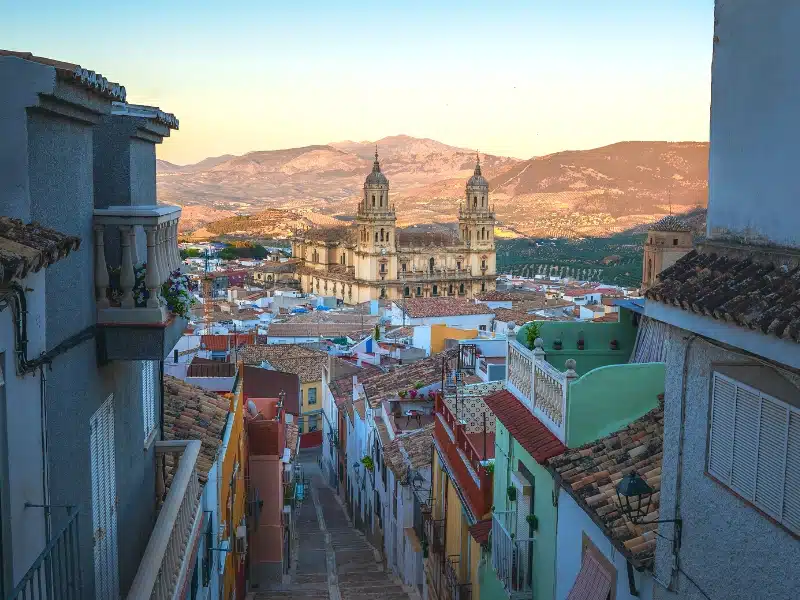
10. Antequera
As you head to Granada, stop in Antequera, deep in the heart of Andalusia, home to over fifty monuments and archaeological sites of extraordinary importance.
The Antequera Dolmens have been declared a UNESCO World Heritage Site in recognition of their fine quality and exceptional state of conservation. A fascinating example of megalithic construction, the Menga Dolmen is six thousand years old and is an enormous passage tomb formed by huge slabs of rock that lead to the burial chamber. The Viera Dolmens and El Romeral complete the prehistoric ensemble.
When you visit the Dolmens you can look northeast to the limestone crag of Peña de los Enamorados or Lover’s Rock that resembles a prone fave. Legend has it that two star-crossed lovers ran away together and were chased by Moorish soldiers to the top of the rock, where, rather than renounce their love or be captured, they chose to hurl themselves over the edge holding hands.
Our Tip: Time your visit for 21st June, the summer solstice, when the sun rises over the peak of the Lover’s Rock, and shines directly into the Menga dolmen.
- Where to Stay in Antequera
Upmarket: Convento la Magdalena Hotel, Torcal de Antequera Natural Park – Booking.com | Agoda
Mid-Range: Parador de Antequera- Booking.com | Agoda
Budget: Los Dólmenes – Booking.com | Agoda
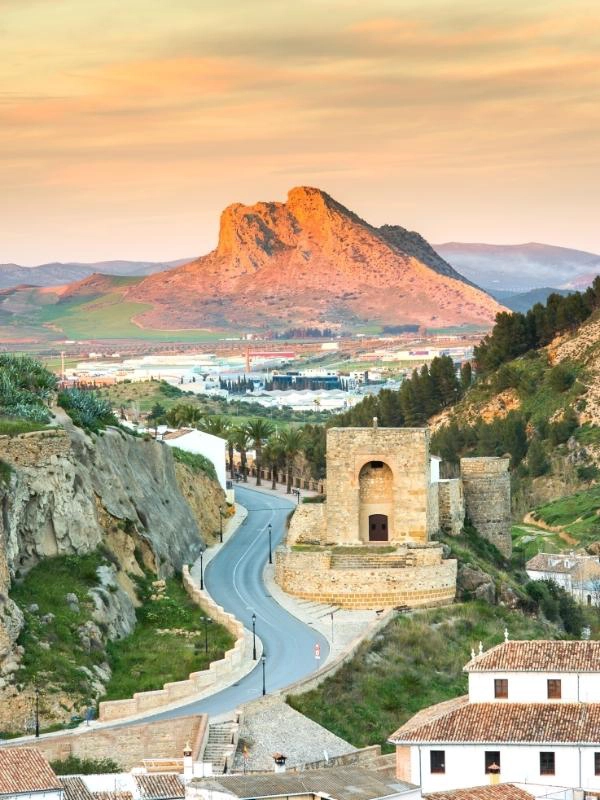
11. Granada
In the spectacular Sierra Nevada mountains, Granada is all about the Alhambra Palace, and is one of Spain’s most romantic cities . This spectacular Moorish palace sits high on a hill overlooking the surrounding countryside and is the jewel in Andalucia’s crown as well as being one of the most beautiful places in Spain .
The Alhambra is simply breathtaking in its beauty, with typical Moorish symmetry and beautifully proportioned rooms full of intricate detail and tile work. The Nasrid Palaces of opulent Moorish-style courtyards, reception halls & royal quarters, and the shaded and leafy gardens with running water, secret paths, and beautiful planting to excite the senses, are both must-sees.
Book your Alhambra tickets and guided tour well in advance (unless you’re visiting Granada in winter when everywhere will be a little quieter) as the Alhambra Palace is one of the most popular attractions in the whole of Spain.
Alternatively, get a Granada Card which allows you to book Alhambra tickets in advance and also covers public transport and other important monuments in the city.
One of the best things to do in Granada itself is to visit the medieval Albaicin, a UNESCO World Heritage Site. Wander the tangle of streets and alleys, enjoying the gift shops and boutiques.
Head for the Plaza de San Miguel Bajo, a charming tree-lined square before climbing uphill beyond the city walls to the church of San Cristobal for a fantastic view of the Alhambra.
- Where to Stay in Granada
Upmarket: Hospes Palacio de los Patos – Booking.com | Agoda
Mid-Range: Hotel Santa Isabel La Real- Booking.com | Agoda
Budget: BiBo Suites San Agustín – Booking.com | Agoda
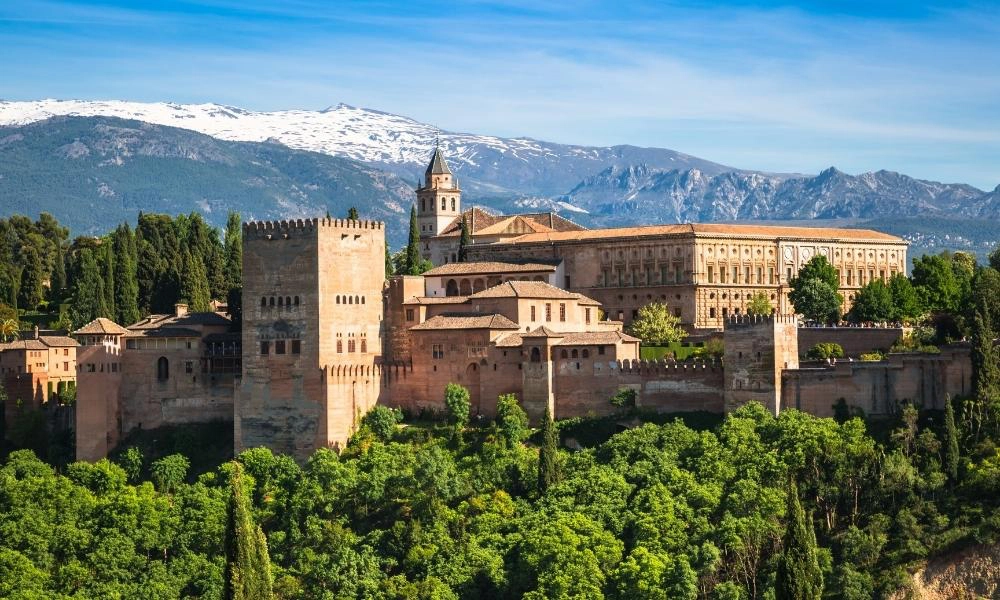
If you’re making this a 14 day southern Spain itinerary, then you should have enough time to spend a few days at the beach at the end of your tour of Andalucia.
Make a detour from your Andalucia travel itinerary and take the gorgeous coastal route from Granada to Malaga along the Costa Tropical. Stop at Nerja and Torre del Mar for some of the best beaches in the region and a perfect end to your Andalucia holiday.
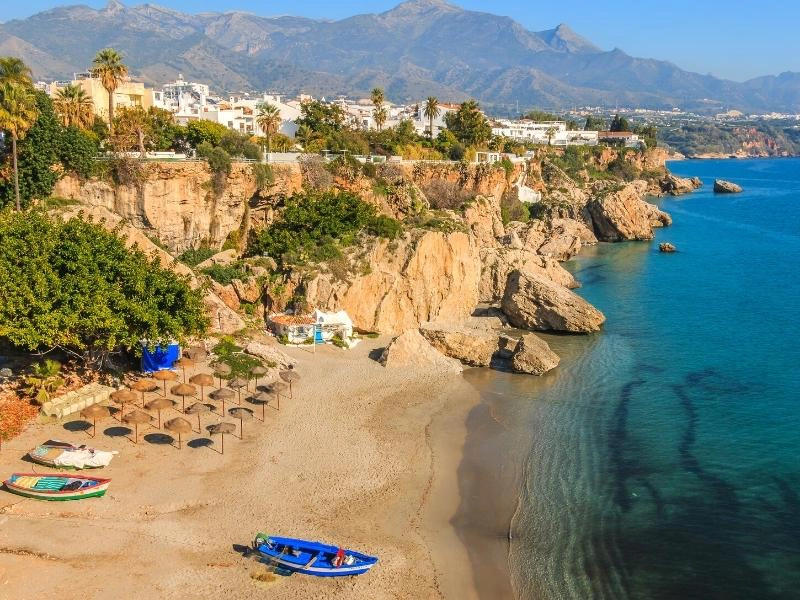
Spanish Road Trip Resources
Here are the websites and services we personally use and recommend for traveling in Spain.
- Search for affordable flights to Spain with Skyscanner
- Search for availability and book hotels and accommodation in Spain with Booking.com
- Find and book the best campsites in Spain with Eurocampings
- Book the cheapest and most reliable hire cars in Spain with Rentalcars.com
- Find and hire your perfect motorhome or campervan with Motorhome Republic
- Get highly rated, reliable, and trustworthy travel insurance with True Traveller
- Check if you need a visa and arrange your documents with Visagov
Andalucia Road Trip FAQs
How many days do you need for andalucia.
A 7 day itinerary for southern Spain will allow you to get a taste of a few of the historical cities and spend a few days at the beach.
For a real flavor of the landscape, history, and yes, food, you need to spend at least 10 days in Andalucia. With a few extra days, you can also see some of Andalucia’s hidden gems and secret spots that fewer people visit, giving you a true taste of authentic Andalucia.
What is the best month to visit Andalucia?
Andalucia is best visited outside of the summer months . In June, July, and August the temperatures are fierce and can be really uncomfortable – not the best time for a southern Spain itinerary!
Andalucia is one of the warmest places in mainland Europe in winter , although it won’t be quite warm enough for sea swimming. Evenings will be cooler and you’ll need to pack layers if you’re planning on visiting in winter. There may be snow in the Sierra Nevada mountain range.
The shoulder seasons of spring and fall are both fantastic times to road trip Andalucia. Roads will be quieter, accommodation and flights cheaper, and you’ll still get all the atmosphere and culture of Andalucia, but with fewer people!
Spring , from March onwards, is gorgeous with temperatures warming up and wildflowers appearing everywhere – the perfect time for a Spanish road trip!
If your plan is to hit the beach, May to July is the best time to visit, when you’ll avoid the summer heat and traffic, but still have beautiful warm weather.
Fall , from September through to November is also a perfect time for an Andalucia roadtrip in Europe’s best winter sun , with the warmth from summer lingering into autumn, but with quieter roads and cities.
Is driving in Andalucia easy?
Car travel in Spain is easy, with a good network of autovias (A) and autopistas (AP). The latter were toll roads until 2020 when many (but not all) became toll-free.
Car rental, fuel, and parking are some of the cheapest in Europe making Spain a really cost-effective place to take a road trip.
Touring Spain by car in rural and mountainous areas can take longer than you think although the standard of non-motorway roads in rural areas is generally good. Allow time to get off the beaten track and experience the real Spain as you tour this fabulous country.
Whether you’re driving your own vehicle to Spain or you’re in a rental car, follow our driving in Spain tips;
- You must have at least three months remaining on your passport (issued in the past ten years) at your intended date of departure from Spain.
- You must have at least 3rd party insurance for your vehicle.
- Citizens of non-EU third countries may require an IDP, you can check here .
- You must carry two warning triangles for the front and rear. These warning triangles are now being phased out and from 1st July 2021, a new law requires that a V16 flashing emergency light is used, although both means of advising other traffic will be legal until the end of 2024.
- You must also carry a reflective jacket (for the driver and all passengers) a spare wheel and the tools to change a wheel or a tire repair kit.
- If you wear glasses you must also carry a spare pair in the vehicle.
- UK cars will need headlight beam converters to be fitted (unless they adjust automatically).
- The use of winter tires in Spain is regional. Look out for traffic signs indicating that winter tires or snow chains are compulsory where you are.
- Anything with a screen (television, video, DVD, etc.) that could distract you when driving should be positioned where you can’t see it. This doesn’t apply to a sat nav but you must not touch or program your sat nav unless parked in a safe place.
- Using radar detection equipment is prohibited under Spanish law and new regulations from January 2021 mean that it will also be illegal to be in possession of such equipment .
- On roads with single carriageways, the speed limit established may not be exceeded by more than 20km/h when overtaking.
RELATED POST: Driving in Europe – Everything You Need to Know
Are you looking for more road trip inspiration? Check out these top posts…
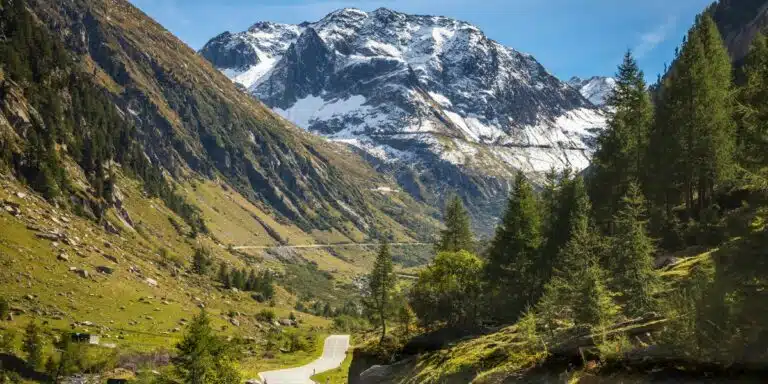
Grand Tour of Switzerland: The Best Road Trip in Europe?
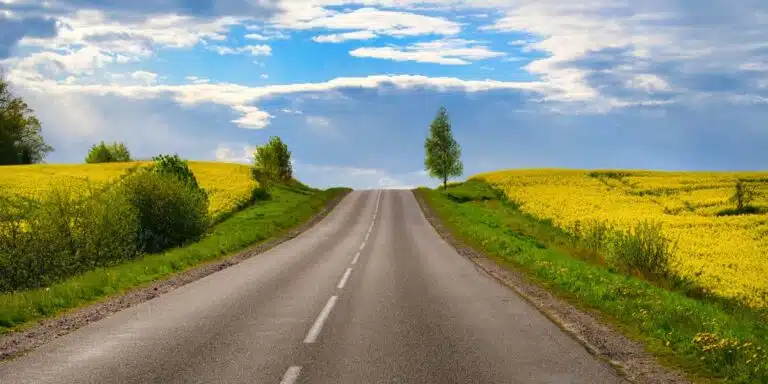
Road Trips from London: The 6 Best Routes to Explore
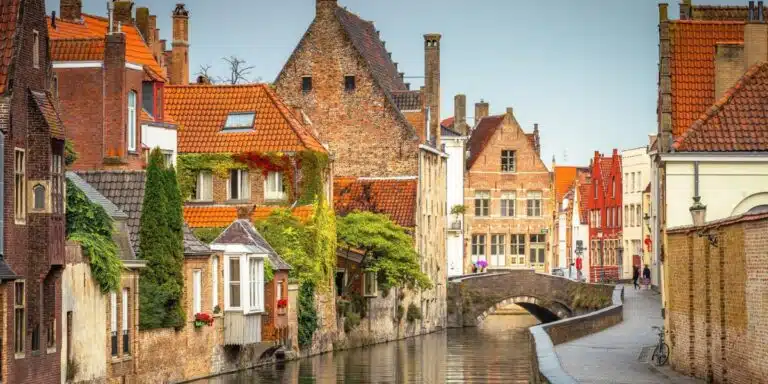
Road Trip Belgium: Fall In Love With Europe’s Hidden Gem
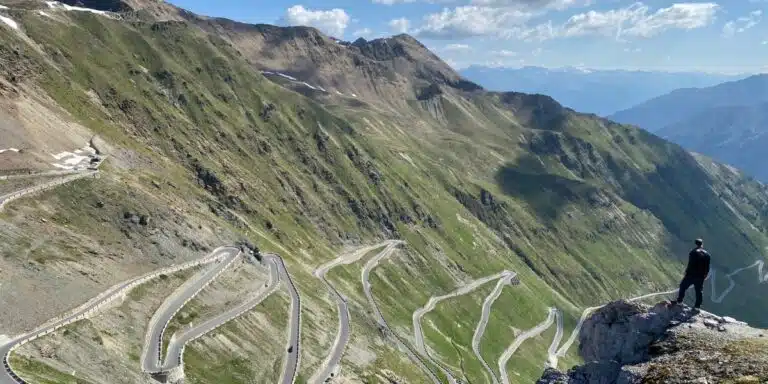
Stelvio Pass: The Best Mountain Road in Italy?
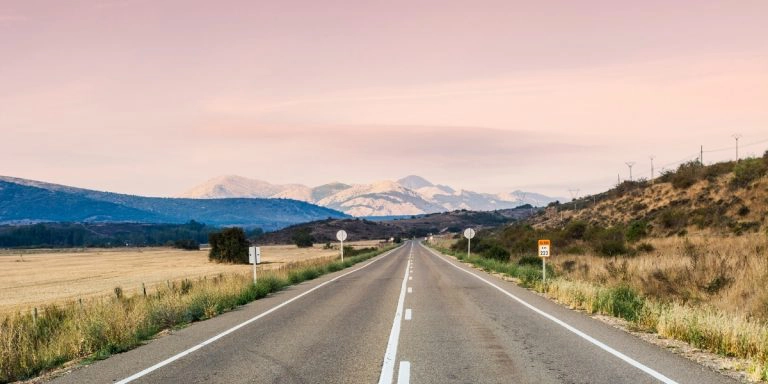
Croatia Road Trips: Five Incredible Routes
Love it pin it.
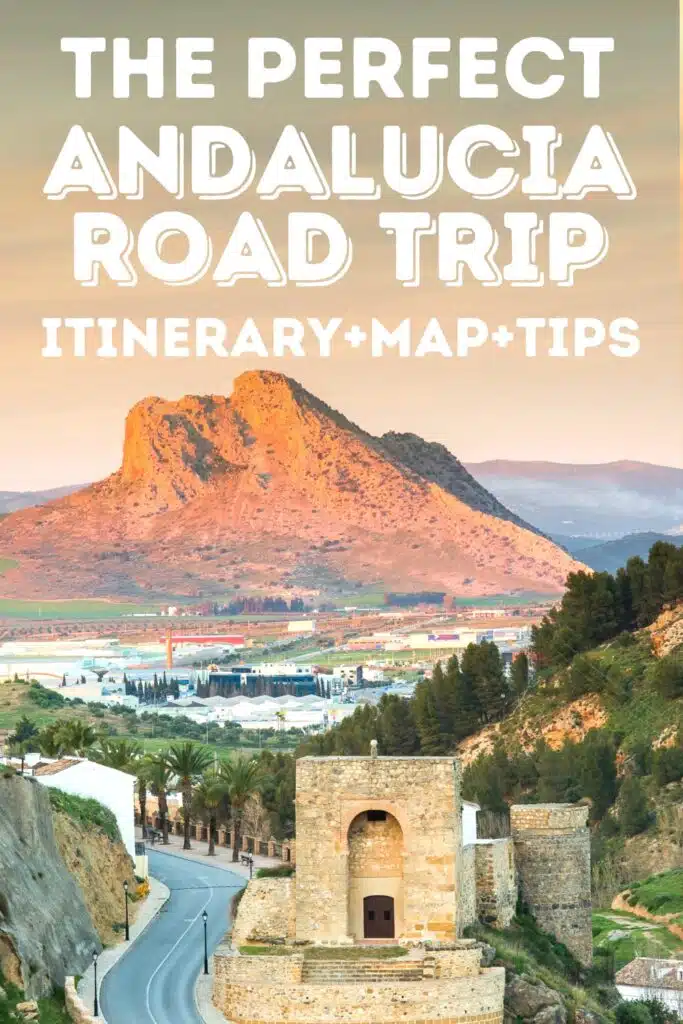
About The Author
Izzy Nicholls
Leave a comment.
Your email address will not be published. Required fields are marked *

03-9281 2175 / 03-9281 0399 / 03-9283 1588 / 03-9283 6160 / 03-9283 6011 / 03-9283 5160 / 03-9283 5095 / 03-9284 7380 / 03-9284 7030 / 03-9284 7029 / 03-9284 7034 / 03-9285 4530 / 03-9285 7813 / 03-9285 7851 / 03-9285 7893 / 03-9285 7972 / 03-9200 2195 / 03-9200 2197 / 03-9200 2198 / 03-9200 2204 / 03-9200 2205 / 03-9200 2206 / 03-9200 1205 / 03-9200 2194
03-9283 6010

CHARLIES WANDERINGS
THE TRAVEL BLOG FOR HIKING LOVERS AND EFFICIENT TRAVEL ITINERARIES

Spain · April 21, 2024
The Best 7 Day Andalusia Travel Itinerary
If you’re looking for the ultimate travel itinerary for your holiday in Andalusia in Spain, then you’ve come to the right place! This incredible region in the southern part of Spain is perfect for a self-drive holiday and I am 100% sure you’ll have the best time exploring these drop dead gorgeous places.
Andalusia is home to some of the most diverse landscapes in Europe and a region rich in culture and history. It is the largest autonomous community in Spain and is famed for its vibrant traditions, including flamenco music and dance, bullfighting, and spectacular festivals.
Andalusia has a profound historical legacy , having been influenced by various cultures over the millennia, including Phoenicians, Romans, Visigoths, Moors, and Christians. This mix has left a lasting imprint on the architecture and urban planning, with notable examples like the Alhambra in Granada , the Mezquita in Córdoba , and the Seville Cathedral and Alcázar.
This 7 day Andalusia itinerary is perfect for the efficient traveler who loves to visit as many places as possible during their holiday !

How to get to Andalusia
Getting to Andalusia, located in the southern part of Spain, is straightforward, thanks to its well-developed transport infrastructure. Here are the main ways to reach this vibrant region:
- International and Domestic Flights – Andalusia is served by several airports, with the main hubs being Seville Airport (SVQ), Málaga-Costa del Sol Airport (AGP), and Federico García Lorca Granada-Jaén Airport (GRX). Málaga is the busiest, offering numerous international and domestic flights, making it a convenient entry point for travelers coming from both within Spain and abroad.
💡 TIP – We chose the international airport in Malaga as point of entry since often these flight tickets are cheaper compared to flying to Sevilla.

How to get around Andalusia
- High-Speed Rail – Spain’s high-speed train network, AVE (Alta Velocidad Española), connects Madrid to major Andalusian cities like Seville, Málaga, and Córdoba with fast and efficient service.
- Regional Trains – For those traveling from other regions of Spain, regular trains provide good connectivity to various parts of Andalusia.
- Major Highways – Andalusia is well-connected by a network of major highways. The A-4 motorway runs from Madrid through Córdoba to Seville, while the A-7 and E-15 connect along the Mediterranean coast through Málaga and onward to Algeciras.
- Scenic Routes – Driving to Andalusia offers the flexibility to explore the region’s diverse landscapes and picturesque “white villages.”
🚘 I always use SunnyCars when booking a rental car cause their company policy makes me feel the most at ease.

The Best 7 Day Andalusia Itinerary

Day 1 – Arrival
Like I said before we chose to fly into the international airport of Malaga and made the decision to skip Sevilla for now and keep it for a future city trip.
We arrived in Malaga late in the evening, so after picking up our rental car we headed straight to our hotel Hotel La Bobadilla in Villanueave de Tapia.
When mapping out our itinerary I decided to stick to maximum two different places to stay. Since we were traveling with our 7 month old baby I didn’t want to unpack and pack every 2 days.
So for the first half of the trip we stayed at Hotel La Bobadilla in Villanueave de Tapia. In my opinion the perfect base to visit Cordoba , Granada and the surrounding pueblos blancos .

Day 2 – Cordoba
The city of Cordoba is a historic gem in the heart of Andalusia, where ancient streets whisper secrets of Roman and Moorish pasts. As you wander through the city, prepare to be dazzled by the star attraction: the Mezquita , a colossal mosque-turned-cathedral that boasts a forest of columns and arches in candy-cane hues.

Don’t miss the chance to lose yourself in the charming patios of Córdoba, flower-adorned sanctuaries that burst into a kaleidoscope of colors during the famous Patio Festival. Stroll next to the river and admire the Roman bridge from Cordoba.
📖 READ MORE – 9 Very Best Things To Do In Cordoba, Spain

And make sure not to forget visiting Alcázar de los Reyes Cristianos ! This majestic fortress-palace, once the residence of Christian Kings, is a testament to the city’s historical significance, with its imposing walls, regal towers, and exquisite Moorish-inspired gardens.
🅿️ PARKING – If you’re visiting Cordoba by car you can park at Parking la Mezquita de Córdoba or at Parking Centro Histórico.

💡 TIP – Only 30 minutes driving from Cordoba, you’ll find one of the most epic castle in entire Spain! Castillo Almodovar del Rio, also known as Highgarden in Game Of Thrones !

Day 3 – Iznajar & Antequera
Both Iznajar and Antequera are some of the most beautiful white villages in Andalusia and must-sees on your Andalusia travel itinerary. Both villages are close to Villanueva de Tapia and only 30 minutes driving from Hotel La Bobadilla .
I recommend starting with Iznajar since it’s on the smaller side. The highlights here are centered around the Patio De Las Comedias where you’ll find over 700 beautifully decorated flower pots hanging from the white washed walls.

Antequera is a picturesque town that serves as a living museum, where every street and building tells a story. The crown jewel of Antequera is its UNESCO World Heritage-listed Dolmens—megalithic burial sites that are among the largest and most complex in Europe.
Beyond the ancient stones, the town’s skyline is dominated by the imposing Alcazaba of Antequera, a Moorish fortress that offers sweeping views of the surrounding countryside. Nearby, the Renaissance-style Collegiate Church rises majestically, showcasing Antequera’s religious and architectural grandeur.
🅿️ PARKING – Park your car at Carpark Antequera Centro S. L.

Day 4 – Granada
The city of Granada is nestled at the foot of the Sierra Nevada mountains and a treasure trove of historical gems and vibrant Andalusian culture. Start your adventure by stepping back in time at the Alhambra , a stunning palace and fortress complex that epitomizes Moorish art and architecture.

Wander through the aromatic streets of the Albaicín , the old Moorish quarter, with its white-washed houses and hidden courtyards. Make sure not to miss the Mirador de San Nicolás for the best views over Alhambra and the Sierra Nevada Mountains!
📖 READ MORE – 9 Very Best Things To Do In Granada, Spain

Other important landmarks not to miss are the Granada Cathedral and Royal Chapel, Plaza Nueva, El Bañuelo and Palacio Dar al-Horra.
💡 TIP – If you’re visiting Alhambra as part of a day trip like we did I recommend visiting the palace in the early morning so you have the rest of the day to explore the centre of Granada . Plus you can also leave your car at the Alhambra parking lot and simply walk down to the city center.

When driving back to Hotel La Bobadilla you should make a stop at Montefrio to watch the sunset. This stunning white village in Andalusia is home to one of the most beautiful viewpoints in the region and can be easily accessed as well! Simply drive to Mirador del Paseo and you’re there.

Day 5 – Colomares Castle
Today we’ll drive from Villanueva de Tapia to Estepona, our second hotel location in our Andalusia travel itinerary. For this area I chose to stay at the wonderful Kempinski Le Bahia , an amazing 5⭐️ luxury resort that is ideally located.

But before checking in you’ll drive by the spectacular Colomares Castle near Malaga. This isn’t your typical medieval fortress; it’s a fantastical tribute to Christopher Columbus and the discovery of America , complete with fairytale turrets, intricate mosaics, and hidden nooks that spark the imagination.
Nestled in the sun-drenched hills of Benalmádena , Colomares Castle is like a page from a storybook, inviting you to explore its unique blend of architectural styles that celebrate Spain’s rich heritage.
📖 READ MORE – Colomares Castle, Spain – All you need to know when visiting

DAY 6 – Ronda , Setenil de las Bodegas, Olvera & Juzcar
Today involves a lot of driving but this way you can check off some of the most beautiful white villages in Andalusia in a single day.
Ronda is without a doubt one of the most iconic villages in entire Andalusia thanks to the Puente Nuevo bridge , elegantly perched above the dramatic El Tajo gorge. After a 50 minute drive from Estepona you’ll arrive in the historic city center.

If you’re wandering through Ronda, make sure not to miss the Jardines de Cuenca, the Arco de Felipe V, Iglesia de Santa María la Mayor and La Ciudad District.
📖 READ MORE – 10 Very Best Things To Do In Ronda, Spain .
🅿️ IN RONDA – Park your car at Parking La Merced . If you’re visiting Ronda on a day trip make sure to arrive on time otherwise all of the public parkings will be full. We arrived in Ronda on a regular weekday around 9.30am and had no problem finding a parking spot. But by the time we left around 1pm all of them were full.

Only 20 minutes driving from Ronda, you’ll find another peculiar pueblo blanco in Andalusia – Setenil de las Bodegas.
This town is known for its distinctive architecture where houses are built directly into the rock overhangs above the Rio Trejo. Setenil offers a striking contrast with its homes seamlessly integrated into the natural rock formations, creating a dramatic and picturesque landscape.
The most visually striking part of Setenil can be found along the streets Calle Cuevas del Sol and Calle Cuevas de la Sombra , where the buildings are either bathed in sunlight or shaded, respectively.

The next town is also only 15 minutes driving. You’ll drive through the stunning Andalusian countryside and soon you’ll already see the church and castle of Olvera looming in the distance.
Make sure to pay a visit to Castillo de Olvera and to the Museo La Frontera y los Castillos . For €3 you get access to both attractions. You can buy your ticket at the visitor centre which is located next to the Iglesia de Nuestra Señora de la Encarnación .

The last stop of the day is one of the most unique places in Andalusia and a really special place in this Andalusia travel itinerary.
Juzcar used to be another white washed village, but not anymore. The inhabitants of Juzcar actually painted all of their houses bright blue as part of a marketing stunt for “The Smurfs” movie in 2011.
Part of the deal was that their houses would be restored in their original state but they saw such an influx of tourism that they decided to simply leave them blue. And not just that, since then they’ve added a ton of colorful murals.
💡 TIP – Follow the Cartoon Trail to find all of the murals – The map is located at the beginning of town.

Day 7 – Departure
Today it’s time for check out! Depending on the time of your flight you can relax a little longer at your hotel before you make your way to the international airport of Malaga.
The car rental return process went very smooth and I’ld say you need to be at the airport 2 hours before your flight leaves.
I hope this Andalusia travel itinerary gives you the inspiration you need to explore this incredible region yourself, and not just lay on the beach in Marbella.

The best time to visit Andalusia
The best time to visit Andalusia largely depends on what you’re looking to experience, but generally, the spring (April to June) and fall (September to November) months are ideal. During these times, the weather is pleasant, with mild temperatures perfect for exploring cities, enjoying the beaches, and participating in outdoor activities without the intense heat of the summer.
Spring brings vibrant festivals like Feria de Abril in Seville and blooming landscapes, while fall offers the grape harvest and beautiful autumn colors, especially in the northern regions.

All rights reserved © Charlies Wanderings. Republishing this article and/or any of its contents (text, photography, etc.), in whole or in part, is strictly prohibited.

Charlotte Lint is the founder, main photographer and writer of Charlies Wanderings . She has traveled all over the world and is based in Belgium where she also owns her very own dental practice. She is an expert on writing insightful hiking guides and creating unique and efficient travel itineraries . Every month she helps over 134.000 people discover the most beautiful places in the world through her detailed travel guides.
You’ll Also Love

Leave a Reply
You must be logged in to post a comment.
DESTINATIONS
TRAVEL ITINERARIES
TRAVEL WITH KIDS
Charlies Wanderings is a travel blog for unique travel itineraries and hiking guides with colorful photos and insightful travel info.
COPYRIGHT ©2024 CHARLIES WANDERINGS
Copyright © 2024 CHARLIES WANDERINGS Theme by 17th Avenue
Copyright © 2024 · Charlotte on Genesis Framework · WordPress · Log in
- United Kingdom
- Curated Stays
- Wine Travel
- About Isabelle
- Work with Us
The Perfect Andalucia Itinerary for 7, 10, or 14 Days
- Isabelle Hoyne
- May 20, 2024
** Disclosure: some of the links on this site are affiliate links and should you make a purchase through these, I may receive a small commission at no extra cost to you. Thank you for your support!**
Pulling together the perfect southern Spain itinerary can be testing – I remember feeling overwhelmed when first sitting down to plan my trip to Andalucia – and you might be feeling this way too. This is a long one, but stick with me and by the end, you’ll know how to craft the perfect Andalucia itinerary!
I close my eyes and I am back there – flashes of orange blossoms, dusty, white towns that teeter on the precipice of yawning gorges, the solitary echo of footsteps on ochre-hued streets at siesta time.
I taste the salty tang of Manchego cheese as it hits my tongue and squint my eyes in the bleached light of the midday sun, as I am once again immersed in the kaleidoscope of experiences that make up a road trip in Andalucia .
Andalucia is famous for its shoreline – along its fringes are the beaches of the Costa del Sol, firm-favourite of many a package holiday fan.
Its gateway is the port city of Malaga, but to step inside the interior of this region is to discover its beating, cultural heart and the very best of Southern Spain.
Our route first took us from the coast to the sweeping arches of the Puente Nuevo at Ronda, and on then to cosmopolitan Seville , capital city of Andalusia.
From here we journeyed our way further through southern Spain to gawp at La Mezquita in Cordoba before finishing at the foot of the Sierra Nevada mountains, racking up our step count at Granada’s Alhambra .
Since initially writing this Andalucia itinerary guide, I’ve spent a number of months living in the marvellous metropolis that is Seville. I’ve fallen even further under Andalusia’s charms and hope to help you do the same through this comprehensive guide.
I understand that time constraints may be different for all readers of this post, and so below, I have outlined a variety of proposed itineraries depending on number of days you have available.
Further on in the post, I lay out my recommendations for each destination mentioned. Happy planning!
Essential links for booking your Andalucia trip
Search for and book flights via Skyscanner Book your car rental via Rentalcars Make sure to book in advance: ☆ Make sure to book tickets to the Alhambra well in advance, that include entry to the Nasrid Palaces as visitor numbers are limited daily. To get the most from your visit, book a small group guided tour or alternatively, a private tour . ☆ The Seville Super Combi Pass offers a discounted bundle price for access to the Alcazar, Cathedral & Giralda Some memorable experiences in Andalucia ☆ Arabian Baths Experience at Granada’s Hammam Al Ándalus ☆ VIP early-access Alcazar of Seville tour (** editor’s choice **) ☆ Tastes, Tapas & Traditions of Seville Food Tour (great for foodies – I took this tour & loved it!) ☆ 4-WD Sierra Nevada Safari Tour (Granada) ☆ White Villages from Ronda – Wine & Tapas by E-Bike Recommended hotels : Hotel Catalonia Reina Victoria (Ronda hotel with spectacular views) // Soho Boutique Hotel (luxe for less, Seville) // Villa Oniria (boutique beauty I stayed in, Granada) // H10 Palacio Colomera (reasonably priced Cordoba luxury hotel with pool) Best Andalucia vacation rentals : take a look at the most popular apartments & houses
Table of Contents Hide
Why history, culture and gastronomy lovers should visit andalucia, when should i go to andalucia, what is the best way to get around andalucia, how many days do i need in andalucia, andalucia itinerary 7 days, andalucia itinerary 10 days, andalucia itinerary 2 weeks, andalucia by train itinerary, ronda & the white villages, related reading for granada & andalucia, like this post pin for later.
Andalusia’s history is a long one.
For millennia these lands have attracted a diverse range of people. From early, pre-Christian metalworkers to the Phoenicians, the Romans to the Moors, Andalusia finally found itself in the hands of the Catholic monarchs, Ferdinand and Isabella, when it then became the nucleus of Spanish trade with the New World in the 16th century.
Responsible also for the Reconquista , they made it their business to either convert to Christianity or expel from Spain its Muslim and Jewish occupants.
Each ruling dynasty left its mark on the region. Possibly the most unique and lasting legacy is that of the Moors – in fact, flamenco, one of Andalusia’s most distinct cultural outputs, finds its origins in Arabic roots.
Arabic influence on Andalusian architecture is also extremely distinct in this region, presenting a magical hybrid of Moorish and Spanish qualities (called ‘ Mudejar ’) that won’t be seen anywhere else in the world.
The perfect destination for those looking to immerse themselves in local culture, be wowed by architectural diversity and uniqueness and spend a good deal of time in tapas bars swilling local wine, an Andalucia road trip needs to make its way onto every traveller’s southern Spain itinerary .
Planning your Andalucia road trip
Before embarking on our Andalusia road trip , it took a little bit of head scratching and quite a bit of research in order to answer all questions and decide on a route and itinerary for the trip.
Where should I base myself in Andalucia and how much time did I need? Is it safe to self drive in Spain? Is it possible to get around Andalucia by train? You will likely have the same questions, so let me answer these for you below!
As with a lot of destinations, the shoulder months of April/May and September/October make for a great time to visit Andalucia, with average daily temperatures of anywhere between 20-30 degrees celsius (68-86 Fahrenheit).
I’ve visited Seville during May/June and temperatures sat at around 27/28 degrees celsius each day.
I would highly recommend that you avoid visiting at the peak of summer, particularly July and August, as the temperatures in places such as Seville can soar to a blistering 40 degrees celsius (104 fahrenheit) or more.
Bear in mind that the temperatures will vary from place to place – Seville, for example, will be milder than Ronda and Granada.
I spent a week in Andalucia across the New Year period and found it to be an excellent time to visit.
Conditions ranged from ‘short-sleeve weather’ in Seville, to ‘wear a coat weather’ in Granada, but there was sunshine everywhere we went and minimal rain (especially compared to home- Ireland! ) which makes Andalucia a very attractive winter sun destination in Europe.
I looked into buses, trains and hiring a car in Andalucia as a means of completing our southern Spain itinerary. We opted in the end to hire a car. My reasons for this:
Getting around Andalucia by train
Train routes in Andalucia are good, with fast AVE trains linking Malaga, Seville and Cordoba.
They don’t, however, work out very well when trying to incorporate Ronda and any of the White Villages into your itinerary and you have a little less flexibility if you want to venture off the beaten path outside of Andalucia’s larger urban centres.
Price wise too, when I looked at the cost of train tickets for two travellers and compared to hiring a car, there was little in the difference. Weighing it up, it was worth the flexibility of having a car at our disposal for our particular itinerary.
If it makes sense for your itinerary, though, train is still a solid option and you can check times and book tickets here .
Getting around Andalucia by bus
Travelling around Andalucia by bus is also an option, but not one I opted for. Like the train, you’re tied to bus schedules and bus station drop off/pick up routes.
Personally, too, I just prefer to travel by car (or train), but if you would prefer to travel by bus then you can search for and book your tickets here.
Hiring a car for an Andalusia road trip
If you have decided that hiring a car is a good move for you too, then wonderful – let your Southern Spain road trip begin!
I suggest hiring something that’s not too much on the large side and that is comfortable enough for the longer stretches but small enough to navigate the often minimal spaces of narrow, cobbled city centre streets and car parks.
I always use rentalcars.com when hiring a car abroad. I like them for the following reasons:
- You can compare all car rental companies in a given destination. They also have superior filtering options too, so you really can drill down to what you’re looking for – even to the deposit amount and payment type.
- All the info you need for your relevant booking can subsequently be found in their convenient app – no print outs necessary.
- You can often amend/cancel your booking with no additional charges.
Driving in Andalucia during your itinerary for southern Spain- what you need to know
If you’ve ascertained that renting a car is the best way for you to get around Andalucia for your southern Spain itinerary, what else do you need to know?
Road conditions in Andalucia : the conditions of the roads in Andalucia are very good. Much of the road between main cities is motorway and when not, single lanes are wide and easy to navigate.
Driving distances and time : one thing I loved about our itinerary for Southern Spain was that there was never too much driving between locations.
As a rough guide, here is a summary of the time we spent transferring between cities (departing from and arriving to city centre locations in each):
- Malaga Airport to Ronda: 1 hr 15 mins
- Ronda to Seville: 1 hr 45 mins
- Seville to Cordoba: 1 hr 40 mins
- Cordoba to Granada: 2 hrs 15 mins
- Granada to Malaga Airport: 1 hr 25 mins
Provided that you leave at a sensible time and aim to arrive at your next stop in the same vein (i.e. not during the middle of rush hour traffic), the times provided by Google Maps between destinations are accurate and can be relied upon.
Parking is often not included in hotel rates, and is usually available at a nearby secure, underground car park.
Rather than source your own car parking (which might end up being far from your accommodation on the outskirts of town), I’d recommend taking the hit on this for peace of mind while driving a rental car in an unknown city.
It usually costs around €25-30 per day.
Is driving in Andalucia easy?
Driving in Andalucia really doesn’t pose too many problems. The roads we encountered were all high quality and we ran into no logistical issues when using Google Maps – once we followed the route provided we ended up where we needed to be.
Cities will be busy – Seville is a little tricky, as you first need to navigate larger intersections as you make your way towards the centre and then narrow streets once you go further in. Granada was much the same, although on a lesser scale.
We got caught out driving into the centre of Cordoba – there is a local access only zone that is controlled by electronic bollards so if your accommodation is in the old centre, arrange entry into the area in advance with your accommodation.
All in all though, a fairly straightforward driving experience as things go.
How long is a piece of string?! The charms of this region are plentiful and far reaching. To really cover a good chunk of the region of Andalucia as opposed to a city or two, then you need at least one week in Andalucia for it to be worth your while.
You want to allow for at least 2-3 days per stop (with a couple of exceptions requiring less time), so keep that in mind when crafting your Andalusia itinerary .
Personally, I spent a week in Andalucia and would have loved to extend my time there by another few days if I could.
I’ve included my 7 day Andalucia itinerary below, along with how I recommend organising your time should you have 10 days to spend in Andalucia. I’ve also included a 14 day Southern Spain itinerary as well.
- Ronda (2 nights)
- Seville (2 nights)
- Cordoba (1 night)
- Granada (2 nights)
A 7 day Andalucia itinerary allows you to get a real flavour of the region.
You will find yourself on the road at least every second day or so of the trip, but as I’ve mentioned above, journey times between destinations in Andalucia aren’t too long, so this won’t be too arduous.
If you use the itinerary above in the given order (assuming most will be flying into/out of Malaga airport – so this is your starting point), you will be able to fit in many highlights of the region.
Each of the cities above are key points of interest in Andalusia and they are all also unique to each other, allowing you to uncover much of Andalucia in 7 days .
- Ronda & the White Villages (3 nights)
- Seville (3 nights)
- Malaga (1 night)
10 days in Andalucia will allow you to take some more time to explore the region a little more slowly. Rather than add in additional destinations, I’ve instead expanded on the 7 day itinerary to allow you a better immersion in those places I feel warrant more time.
I’ve given an additional day in Ronda so you can explore the unique White Villages in the area.
Seville too gets an extra night – I’ve stayed in Seville for a week before and didn’t run out of things to do, so the 10 day Andalucia itinerary above allows a little more time to uncover the delights of my favourite Spanish city.
Finally, I’ve ended this 10 day Andalucia itinerary in Malaga.
Instead of making your way straight to the airport, take a day to explore Malaga as a variation for this itinerary for southern Spain – perhaps visit an art gallery, admire the orange trees in Plaza de los Naranjos, or take a well earned dip in the Mediterranean Sea!
- Granada (3 nights)
- Nerja (3 nights)
Your two week Andalucia itinerary builds on the 10 day route. Key changes include an additional night in Granada to allow for a day to visit the Sierra Nevada mountains (for skiing in winter or beautiful hikes in summer) and 3 nights in Nerja to slow down, grab a sun lounger and relax on the beach.
Yes, while having 14 days in Andalucia potentially means that you can cram in more destinations and stops, I know from experience that trying to cram in more does not usually result in a superior trip – the opposite.
In fact – so slow down, immerse yourself in each of your stops and don’t come back from your trip more exhausted than when you left for it!
Trust me, Andalucia is a region that needs to be explored slowly, as much of this journey is about the experience in itself.
While it wouldn’t be my recommended way to do it, as I prefer the flexibility of having a car, I understand that this might not be practical for everyone. It is definitely possible to undertake the above itineraries by train, with a little tweaking.
Book your train tickets in advance here , especially if you are travelling during peak times.
You will be able to complete the loop of Malaga-Seville-Cordoba-Granada-Nerja-Malaga by train – the only thing you would miss out on would be overnighting in Ronda.
I really, really, would recommend visiting Ronda if you can (it’s very different to all of the cities), so there is a way to circumnavigate this conundrum by allocating your night in Ronda as an additional night in Seville and undertaking a guided day trip to Ronda and the White Villages from Seville.
Building your Southern Spain itinerary – places to visit
So now that we’ve covered off where you should go, what is there to see in each of these places?
In this next section, I’m going to touch on some recommendations for each of the destinations that I mentioned on the 7, 10 and 14 day Andalucia itineraries above.
I’m not going to provide you with one of those “on day 1, go to this place at 9am, followed by the next place at 11.15am” style itineraries – this is a holiday, not a military operation and Andalusia is a place that encourages you to relax!
I think it’s far more enjoyable to have a ‘menu’ of things to do in a place to have at your fingertips, depending on how you feel at the time. Decide on a couple of ‘must-sees’ in advance, book your tickets, and then fit the rest in around those booked activities.
While known for being the birthplace of modern day bullfighting, Ronda is even more iconic due to its unique situation, perched atop what seems to be the almost bottomless El Tajo gorge, across which the giant arches of the Puente Nuevo stretch, joining the old Moorish town with the ‘new’ town.
What to see & do in Ronda
Ronda is such a picturesque and inspiring location that merely walking around it was nearly enough to keep me going! However, below are some highlights and ideas of things to see and do in Ronda.
Get acquainted with Ronda
If you’d like to get your bearings and understand the history of the place, which is very interesting, then take a walking tour on your first day. For a history lesson that’s a little more quirky, drop into the Bandit Museum , Spain’s only museum that is dedicated to bandits and highwaymen.
Visit the Municipal Museum that is housed in Ronda’s Mondragón Palace , with moorish courtyards, stunning gardens and awe-inspiring views.
Located in the old Arabic quarter of San Miguel, pop in to visit the Arabic Baths , which were built in the 13th century and are the best preserved in Spain.
Take in the views & the famous El Tajo Gorge
Examine the star of the show in Ronda, the Puente Nuevo from all angles and at different times of the day to really get a deep sense of appreciation for the feat of engineering that it is.
Hike down the gorge from the Plaza Maria Auxiliadora in town to view the Puente Nuevo from below – just don’t think about the fact that you have to walk back up it afterwards!
Make sure to take some air too at Ronda’s Alameda de Tajo , an elegant outdoor square that leads out towards sweeping views of the El Tajo gorge.
We went for an early morning run along here, and it definitely knocked the cobwebs off!
Get familiar with the surrounding countryside
Visit some more of the famous White Villages , or Pueblos Blancos. Suggestions include Zahara de la Sierra, Setenil de las Bodegas and Grazalema.
Alternatively, you foodies out there might enjoy this alternative White Villages experience – where you take to the countryside on e-bikes and sample wine and cheese as you go!
If you’re a bit of an adrenaline junkie, want to take in the beautiful scenery and don’t mind getting a bit dirty, then the dramatic surroundings of the El Tajo gorge are the perfect location to do a gorge buggy tour .
Ronda bull ring
While a controversial topic and not a sport that I personally support, Ronda is famous for its bullfighting, making the Plaza dos Toros (or bullring) one of its most popular attractions.
Where to stay in Ronda
Hotel catalonia reina victoria.
Upon pulling back the curtains and throwing open the doors of our balcony, I knew that I had chosen the right spot to stay in Ronda!
Offering absolutely insane views from the balconies of its rooms, the Hotel Catalonia Reina Victoria is a Victorian style hotel that has undergone modern refurbishment.
Complete with indoor and outdoor swimming pools, a spa and those exceptional views to boot, you really can’t go wrong with this one.
Catalonia Ronda
I agonised between this hotel and Catalonia Reina Victoria. The Catalonia Ronda is located right in the heart of town, just across from the bull ring (Hotel Catalonia Reina Victoria is 500m walk from the centre).
Boasting a rooftop pool with views into the bull ring and on towards El Tajo gorge, this is one for those who want to be slap bang in the middle of the action and are looking for a hotel in Ronda town centre.
Ah, Sevilla. This delightful, stylish, historical city is hands down my favourite in Spain and needs to find itself on every Spain travel plan. Whether it’s cultural sights, architecture, cuisine or shopping (or a healthy dose of all four) that you seek, this city really has got it all.
I’ve written all about what to do in Seville in my Seville guide , but here’s a synopsis.
RELATED READING | The Best Airbnb Seville Spain [2024] – 22 Luxury Airbnb in Seville
What to see & do in Seville
EDITOR’S NOTE | TakeWalks , our small-group cultural tour company of choice, have recently launched a range of tours in Seville.
These include an excellent food tour that I’ve taken, and a Seville in a Day Tour with VIP Alcazar Access . I’d highly recommend that you check them out.
Alcázar of Seville
First things first, get yourself to my favourite landmark in Seville, the Alcázar of Seville . Still in use as the King of Spain’s Seville residence, this amazing palace boasts incredible Mudejar architecture and extensive gardens. It was also featured as Dorne in Game of Thrones.
It’s super popular and also sells out early in the day, so book your skip the line tickets here . Once you see the queue that forms as the day progresses, you’ll be happy you’ve bought yours in advance, trust me!
There’s also quite a lot to take in at the Alcazar, so if you’d love to know more about it and haven’t done your reading in advance, then consider taking this small group tour, which has received over 500 5 star reviews from past guests.
If you’re looking for something really special, then consider the TakeWalks VIP early-access tour .
Seville Cathedral & Giralda
Beside the Alcazar, you will find the incredible Seville Cathedral, (which is the 3rd largest church in the whole world !), along with its iconic Giralda, which towers beautifully above the rooftops of Seville.
Again, queues get crazy long, so book a skip the line ticket in advance. When you’re done exploring the cathedral, make sure to climb La Giralda , which is the cathedral’s bell tower, for beautiful views over the city.
TOP TIP | If you plan on visiting both Seville Cathedral and the Royal Alcazar, it can work out better for you to purchase a Seville Super Combi Pass . This includes skip-the-line entrance to both these attractions, plus a hop-on/hop-off bus around Seville.
You can also download audio guides for both the Cathedral and the Alcazar. Alternatively, you can book a guided tour that incorporates both the Alcazar and the Cathedral. With them located so closely together, it makes sense to visit them on the same day.
I’ve rounded up the best Seville Cathedral tours in this post – check it out!
Rooftop cocktails
All that touring is thirsty work! For those seeking a more glam viewpoint of Seville Cathedral and La Giralda, head to the rooftop bar of the EME Cathedral Hotel for cocktails. I’d highly recommend visiting at sunset.
Plaza de España & Maria Luisa Park
Another emblematic location in Seville is the expansive, fountain and tile filled Plaza de España . Try go early in the morning if you can to have more of the space to yourself, as it fills up quite quickly throughout the day.
Make sure to visit and take a stroll in the adjoining Maria Luisa Park during your time in Seville.
Explore the neighbourhoods
You could while away hours wandering the cobbled streets of Sevilla, but when you are in town, do make sure to wander through the Santa Cruz , the old Jewish quarter in the historic area around the Cathedral.
Cross the river, too, and explore some of the craft workshops of the Triana area.
Seville is the home of flamenco dancing, so it is a fitting location in which to attend a flamenco show.
This Flamenco show features 15 of Seville’s best flamenco dancers at Seville’s famous Tablao El Arenal, with a choice of three packages – show with drink, show with tapas, or show with dinner. Alternatively, you could consider TakeWalks Tapas Crawl & Flamenco experience .
Metropol Parasol
Finally, Seville is home to the very modern Metropol Parasol installation – evening time makes a great time to view this as the sun sets over Seville. If you visit early in the day, make sure to head underneath to the interior – where you’ll find an authentic food market in full swing.
Where to stay in Seville
Casa romana hotel boutique.
I had a hard time trying to find somewhere that was reasonably priced over the New Year period in Seville, that would also pass muster and my rather picky hotel standards.
Luckily, I happened upon this charming, 4 star boutique hotel after oodles of hours spent searching.
Rooms are set around a delightful outdoor courtyard (like a Roman villa) that features a lovely, trickling water feature. There is also a rooftop terrace with a hot tub.
The street it is located on is quiet, and its position in the Old Town meant we were 15 minutes away from everything.
Hotel Alfonso XIII
If you want to splash out on a spectacular luxury hotel in Seville, then look no further than the emblematic Hotel Alfonso XIII.
Situated right beside Seville’s Royal Alcazar, the architecture and design of the hotel borrows heavily from its Mudejar-themed neighbour.
Comes with everything that you would expect a hotel of this ilk to offer.
Soho Boutique Villa
Those looking for something a little bit more affordable, but nonetheless luxe, will find that Soho Boutique Villa ticks all their boxes.
This stylish, 3 star boutique hotel features trendy rooms, an outdoor swimming pool and is located too in the old town area of Seville.
Click here to discover a curated list of Seville holiday apartments
We arrived in Cordoba just as the sun was setting, casting a soft golden haze on the walls of the city as we made our approach from the river. Cordoba is special. For many years preceding the Reconquista, Jews, Muslims and Christains lived peacefully side-by-side.
An important Roman city too, Cordoba is a melting pot of all these cultures. Famous also for its patios, this is a rather gorgeous and extremely atmospheric city that should not be left off any Andalucia travel itinerary.
What to see & do in Cordoba
Visit the Mosque-Cathedral
Cordoba’s Mosque-Cathedral, or ‘ La Mezquita ’ should be the first port of call when visiting Cordoba. This incredibly unique structure of a cathedral housed within a mosque is famous for its red and white arches.
If you’d like to learn more about the fascinating history of this astounding structure, this guided tour is extremely well reviewed.
Discover the Jewish Quarter
One area of Cordoba that you need to get lost in is the Jewish quarter, or La Judería. It forms the Old Town of Cordoba and is where you will find most of the city’s main sites.
A quick stop, but well worth popping into is the Cordoba Synagogue , which is the only existing synagogue in Andalucia.
The Jewish Quarter is extremely interesting, so if you’d like to learn more, then it might be worth considering a combined Mosque-Cathedral and Jewish Quarter walking tour. This one is extremely well reviewed, and finishes with a tapa and a drink.
Alcázar de los Reyes Cristianos
Another must-see in Cordoba is the Alcázar de los Reyes Cristianos . Having served as the residence of the Catholic kings, inside it features tranquil, Moorish patios and gardens. Climb the ramparts for views across Cordoba city.
You can book a skip the line ticket and guided tour here . You will also be able to see into the Royal Stables of Cordoba from the ramparts of the Alcazar. This is where the famous breed of Andalusian horses was created. You can visit the stables and also attend a show.
Sample local dishes
Make sure to try Salmorejo , which is the local speciality of cold tomato soup made with bread, garlic, olive oil and vinegar and then topped with egg and ham. It might sound a little weird, but a friend of mine who lived in Cordoba encouraged me to try it and I can confirm that it is delicious!
Get acquainted with downtown Cordoba & its patios
Make sure to stop off and see some of Cordoba’s Patios! These colourful, flower-filled courtyards are dotted around the city.
Take a stroll through the Plaza de la Corredera . Nearby, you will also be able to observe, towering over the street, the columns of the Roman Temple of Cordoba .
Finally, cross the Guadalquivir River via the Roman Bridge for magnificent views back towards the old town of Seville. This bridge has been standing since before the birth of Christ!
Where to stay in Cordoba
Eurostars conquistador.
This 4 star hotel in Cordoba is where I stayed during my visit and it was absolutely perfect for one night.
Located on the opposite side of the street from the Mezquita, I could see the Mezquita’s beautiful Arabic arches illuminated at all times of the day right from my bed, which was really quite special.
At its centre is a beautiful courtyard, which was a lovely spot to grab a drink in.
Hospes Palacio del Bailio
If you are staying a little longer in Cordoba, or are looking for a luxury hotel in Cordoba, then I would opt for Hospes Palacio del Bailio.
This 5 star hotel with swimming pool is located in a 16th century former palace, with interiors that incorporate a stylish blend of both old and new. It is located in the old town and is only 1 km away from the Mezquita.
H10 Palacio Colomera
This snazzy Cordoba 4 star hotel features an outdoor plunge pool, perfect for those hotter days.
Located in the newer part of town close to the Roman Temple, it is still only 1km away from the Mezquita and the old historic area of Cordoba.
Granada sits at the foot of the magnificent Sierra Nevada mountain range and is home to the Alhambra, Spain’s most popular tourist attraction.
As the former capital of Moorish Andalucia, Granada’s Alhambra really is something that needs to be seen to be believed and its presence alone in Granada justifies a visit to the city.
Related reading for Granada |
- How to Spend One Day in Granada
- 2 Days in Granada: Itinerary & Tips
- Visiting the Alhambra from Seville (as a day trip)
- How many days in Granada do you need?
- Visiting the Alhambra: Complete Guide
Where to stay in Granada
What to see & do in granada.
Visit the extraordinary Alhambra
This enormous, hill-top fortress is a complex of palaces, gardens and patios – the highlight for me being the Nasrid Palaces.
There is a daily limit on ticket sales, so where you can, I advise booking your tickets months (or at the very least, weeks) in advance if you plan on going at a popular time. Make sure that you book a ticket that includes the Nasrid Palaces , as these are the first to go.
The Alhambra complex is sprawling and its history comprehensive and interesting, so it is a spot where it’s well worth getting a guide.
This small group tour is extremely well reviewed, or if you’re like me and dawdle a lot to take photos and look at things in detail, perhaps opt for a ticket with audio guide instead, so you can move at your own pace.
TOP TIP | If you forget to book your Alhambra tickets, or book your trip a little closer to the date, then it’s highly likely that Alhambra tickets that include the Nasrid Palaces will be sold our.
Scour any tours that have availability for yours dates and know that if all else fails, you have one last ditch attempt.
Each night at midnight, the official Alhambra website re-releases those tickets that have been returned for the following day (or the same day, technically, if it’s after midnight).
Act really fast the second the clock strikes midnight and you may hopefully be able to secure tickets (I did once, but only by the skin of my teeth!).
Discover Granada’s churches
Visit Granada’s Cathedral and Royal Chapel . The final resting place of King Ferdinand and Queen Isabella, I underestimated how interesting I would find the Royal Chapel and it was my favourite attraction in Granada after the Alhambra.
If you want to learn more about this powerful couple and their place of rest, you can book a guided tour . If baroque is your thing, then get yourself to the Basilica of San Juan de Dios .
This incredible 18th century church is swathed in gold features and frescos, and is the most important baroque church in Spain.
Make sure to spend some time exploring the Aladdin’s cave of shops and stalls in the Albaicín district, which is Granada’s former Arabic neighbourhood. Another worthwhile thing to do in Granada is to watch the sunset from one of the mirador.
The most popular one for this is the San Nicolas Mirador , which offers spectacular views of the Alhambra.
For a memorable experience that combines both, this 5* sunset walking tour takes you through both the Albaicín and Sacromonte districts to the San Nicolas Mirador, regaling interesting facts and stories about Granada along the way.
Go shopping
Granada has an absolutely wonderful range of high street fashion stores and make up shops, with multiple Zara stores – it’s safe to say I squished in an adequate amount of retail therapy when I was there!
Head to Calle Reyes Católicos where you will find the majority of these. There are also two El Corte Inglés in Granada.
Immerse yourself in the tradition of flamenco in Granada
The area of Sacromonte is famous for its flamenco dancing, the venues for which are often set in caves. This show takes place in a cave-restaurant, in one of Granada’s most spectacular venues.
Eat some tapas
In Granada, you get a free glass of wine when you order tapas. If you are a foodie, then this small group food tour will introduce you to Granada’s traditional products and dishes (including tapas), along with some hidden treasures.
Visit the baths | Pay a visit to Granada’s famous ancient Arab baths, “ El Bañuelo ”. Unfortunately, these are not in use today, but if you fancy trying to Arabic bath experience for yourself to relax after all that sightseeing, you can book a traditional hammam and massage here !
Get out into the Sierra Nevada mountains | Granada is located in the shadows of the majestic Sierra Nevada mountains.
Your stop in Granada would be the perfect opportunity to break up all of your city visits with some time spent in the clear mountain air. Depending on your interests, here are some ideas to get you started:
- 4WD Sierra Nevada Safari tour
- Sierra Nevada Small Group E-Bike Tour
- Sunset at 2,500m in Sierra Nevada
Villa Oniria
I loved our hotel in Granada! Situated in the city centre, Villa Oniria is an elegant 4 star hotel situated in a 19th century manor house.
Set around a beautiful Andalusian courtyard, it has a plush, yet relaxed atmosphere. The location is great for exploring all the main sights of Granada. There is also a fantastic restaurant located onsite.
Alhambra Palace
If you’re looking for a 5 star hotel in Granada, I would draw your attention to the Alhambra Palace.
It’s probably a toss up for me between here and the Hotel Palacio de Santa Paula (where the entry level rooms may be a tad more modern than those of the Alhambra Palace’s equivalent), but it’s the location outside the walls of the Alhambra and the expansive views of the city that clinch this for me – I’ll take a Junior Suite with city views, please.
Should you find yourself with more than 10 days in Andalucia, I’d recommend adding some beach time to your southern Spain trip itinerary. This will allow you a few days to kick up your feet and relax after all your sightseeing!
I’d recommend considering the white cobbled streets of the former fishing village of Nerja, an area far quieter than the glitzy beach clubs that run from Marbella to Puerto Banus. Conveniently, it’s just a little over an hour’s drive from Granada too.
If the glitz, glamour and beach clubs of Marbella are more your thing however, there’s nothing wrong with that! I’ve written a roundup of the best holiday villas in Marbella, which you can read here .
What to see & do in Nerja
Get some R&R
Relaxation is the aim of the game here, so get your tanning on (safely!) on one of the beaches of Nerja . Some of Nerja’s most beautiful beaches include Playa Carabeillo, Playa El Chorrillo, Playa El Cañuelo and Playa de Alberquillas.
Explore the local area
Take a day trip to nearby Frigiliana , which is 6km away. Think pristine white buildings, cobbled streets and cute alleyways. You can also visit Visit the Nerja Caves , which stretch for almost 5km underground and have been in existence for millions of years.
They are also home to the largest stalagmite in the world. Nearby too, is the Acueducto del Águila , or Eagle Aqueduct, a very eye catching, red and yellow coloured feat of engineering located just outside of Nerja.
Hike some of the local area covering beaches, cliffs and Moorish towers before undertaking a spot of snorkelling. If you’re feeling particularly active, you can walk the Rio Chillar gorge – just prepare to get your feet wet!
Another good hike is Il Cielo – which translates to ‘heaven’ – for breathtaking views of the sea and the expanse of the surrounding countryside.
Where to stay in Nerja
Hotel balcón de europa .
This beachfront hotel in Nerja is built into the Balcón de Europa rock face, and enjoys direct access to Caletilla Beach.
It features an outdoor swimming pool and a restaurant with stunning sea views. Opt for a room with sea views and a balcony to properly enjoy the seafront location.
Boutique holiday rental in Nerja
This nautical themed holiday rental in Nerja features a balcony with sea views, along with a pool and sun loungers.
The house is a mere 200m from the beach and it also takes less than 10 minutes on foot to reach the busy centre and its bars, restaurants and shops.
Known primarily as the gateway to the Costa del Sol when I was growing up, Marbella is in fact a city full of culture and has done a lot to shift this image in recent years.
Yes, there may still exist the dazzling lights of Malaga’s glitzy nightlife, but do remember that this too is the city that gave us Picasso.
Built atop Roman ruins and holding Moorish citadels within its embrace, this impressive city is also worth a stop on a southern Spain travel itinerary.
What to see & do in Malaga
Stroll around the old town, and take in the Plaza de los Naranjos , a beautiful square in the old town centre that is bursting with orange trees.
Visit the Alcazaba of Malaga . Built by the Moors in the 11th to protect against Catholic attackers, its prime position provides magnificent views over the city and coastline. You can book a tour here .
Visit the Roman Theatre . Having only been rediscovered in the 1950’s, the theatre is located right beside the Alcazaba and is free to visit. This walking tour includes both the Roman Theatre and the Alcazaba.
Continue up the hill past the Alcazaba to Gibralfaro Castle . Built to protect the Alcazaba, this is where you will get the best views of Malaga and can even see as far as the Strait of Gibraltar on a clear day.
All about the views here, climb the tower of the whopping Malaga Cathedral for 360 degree views of the city!
Take a trip to the Picasso Birthplace Museum , where – you guessed it – was the place that Pablo Picasso grew up! You can book your tickets in advance here .
Art lovers should also visit the Museo Picasso Málaga , which explores the life and art of the famous painter and includes 200 of his works of art. You can purchase tickets here .
You can also visit one of Europe’s biggest and best botanical gardens, La Concepción should this tickle your fancy.
Enjoy a cocktail on the rooftop bar of the La Terraza de la Alcazaba for incredible views of the city, the Alcazaba and Gibralfaro Castle.
Finally, if you haven’t had enough of eating throughout your Andalusia trip (or want to end your trip with a night of feasting) then I thought that this Malaga evening wine & taps tour looked rather appealing!
Featuring the city’s gourmet highlights, from a classic shop to much loved bars, you’ll taste your way through some of Malaga’s classic foods, from Iberian ham to tapas and wine.
Where to stay in Malaga
Palacio solecio, a small luxury hotel of the world.
A gorgeous, luxury 4 star hotel in the centre of Malaga. The hotel occupies a restored 18th century mansion and is a minute’s walk from Museo Picasso Málaga.
The building and the rooms of this hotel are truly exquisite, featuring an internal courtyard with marble arches and palms.
Hotel Gran Hotel Miramar GL
This luxurious, 5 star hotel in Malaga is situated along the seafront, offering glorious views of the ocean from some of its rooms.
A listed building, these walls have hosted many high profile visitors over the years, including Elizabeth Taylor and Ernest Hemmingway. A truly chic affair, with glorious views onto the waterfront.
- Alhambra Day Trip | Day Trip to Alhambra from Seville: How to Pull off a Flawless Visit
- 2 days in Granada | Granada in 2 days: Ultimate Itinerary & Top Tips
- Alhambra travel guide | Visiting the Alhambra – Ultimate Guide + Insider Alhambra Tips
- One day in Granada | Best of Granada in One Day: Where to Go, Eat & Stay
- Where to stay in Granada | Where to Stay in Granada, Spain [2024] – Top Areas & Accommodation
- How long in Granada? | How Many Days in Granada Do You Really Need?
- Andalucia itinerary | The Perfect Andalucia Itinerary for 7, 10, or 14 Days
Related Topics
- Itineraries
Hi there! I'm Isabelle, aficionado of immersive travel experiences and unique, luxurious hotels. You'll most likely find me camera in hand, or nerding out on research in advance of my next trip. A major foodie, history and scenery lover, nothing makes me happier than soaking in the atmosphere and culture of the destination I'm visiting.
You May Also Like
17 things to do in florence: a curated guide to the renaissance city.
- August 22, 2024
3 Days in Florence: Itinerary, Map + Insider Tips
- July 24, 2024
Florence Travel Guide: 28 Unmissable Tips for the First-Time Visitor
Input your search keywords and press Enter.

2 weeks in Andalucia: Ultimate 14, 15 or 16 days itinerary + Tips
2 weeks in andalucia: which itinerary for 14, 15 or 16 days.
You’re going on a trip to Andalucia (sometimes also spelled “Andalusia” in English)? You’re looking for the best 2 weeks itinerary?
Then look no further!
In order to help you plan your stay , I have prepared for you this 2 weeks itinerary in Andalucia . In this detailed guide, I will tell you everything you need to know about the best places to visit in this beautiful Spanish region.
In addition to the must-see attractions and activities , I will also give you all my best tips as well as my selection of the best accommodation depending on your budget for each city.
So, how to spend 2 weeks in Andalucia?
Let’s find out!
Where to stay in Seville
Where to stay in cordoba, where to stay in granada, where to stay in malaga, where to stay in arcos de la frontera, where to stay in cadiz, 7 ) back to seville (1 day), renting a boat in andalucia, you’re traveling in andalusia these articles will help you, 1) seville (3 days).
To visit Andalucia in 14-15 days , the best is to land in Seville .
You don’t really need a car to visit Seville , as it’s very easy to visit the city on foot or with public transports.
However, you will need to rent a car for the 2nd stage of this 2 weeks itinerary in Andalucia, when you will go to Cordoba .
So you have 2 choices:
- Directly rent a car at the airport when you will arrive
- Rent a car before going to Cordoba, in the morning. Get it at the airport, it’s cheaper and a lot more convenient for when you will take your plane back home .
In any case, I recommend using Booking.com Cars for your car rental in Andalucia . It’s the website, i always use it for the 3 following reasons:
- It’s easy to get the best price for your car rental , you can compare prices between all the car rental agencies in Seville.
- They offer a “full protection” insurance : you will get fully refunded if the car gets stolen or in case of any damage.
- Cancelling or modifying your booking is free and very simple to do.
Oh, and last but not least, they offer the “best price guarantee” . If you find the same car cheaper elsewhere, they will refund you the difference!
Click the button below to compare car rental prices in Andalucia:
Then reach your hotel by car or by bus. There is a bus every 30min, and going from the airport to the city center takes about 40min. It costs 4€.
It’s now time to start your two weeks in Andalucia. First of all, I’m going to give you a few tips to visit Seville in 3 days .
One of the best places to visit in Seville is the famous Seville Cathedral . You should go there first.
For this attraction, it’s better to buy skip the line tickets in advance. You’ll understand why it was a good idea to purchase them when you’ll see the huge waiting line at the entrance!
There are 2 kinds of visits available:
- A standard skip the line ticket to visit the cathedral and the Giralda.
- A 90min guided tour of the monument + access to the top of the Giralda.
- The Seville City pass: The best option if you also want to visit the Alcazar of Seville. With it, you can also take the hop-on hop-off tourist bus, which stops in front of every attraction of the city. It’s very convenient!
There is also a 4th option that doesn’t require any early booking:
You can go first to the Iglesia Colegial San Salvadore (Church of the Divine Savior in English). There, you can buy a combined ticket (also skip the line) that allows you to also visit the cathedral! The church is located only 10min walking from the cathedral and it opens at 11:00. Be there at that time.
Then you’ll be able to enjoy the visit of the stunning Seville Cathedral and Giralda . If you go to the top, you’ll love the very nice scenic view over Seville .
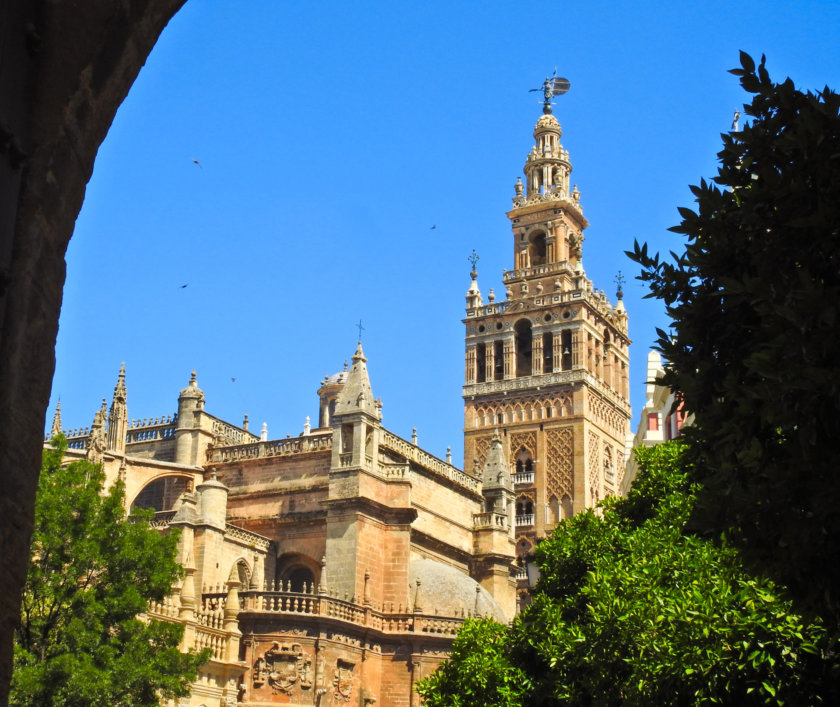
Then, for the rest of your first day in Seville:
- Go to the General Archive of the Indies , located right next to the cathedral. It’s a quick visit but it’s free!
- Take a walk in Santa Cruz neighborhood, the historical district . For a great view over the cathedral, go to the Plaza patio de Banderas.
- Have lunch in one of the restaurants in the area.
- Then head to Plaza de España. It’s an absolute must-see in Andalucia for your 14 days road trip! This square is huge and really stunning, with a very impressive architecture.
- Go for a stroll in Maria Luisa park , located next to the square. It’s a great spot to get some fresh air and calm. You can also go to Plaza America, at the edge of the park. There are 2 museums there: the Archaeological Museum and the Museum of popular Arts and Traditions.
- To end the day, enjoy some tapas and sangria!
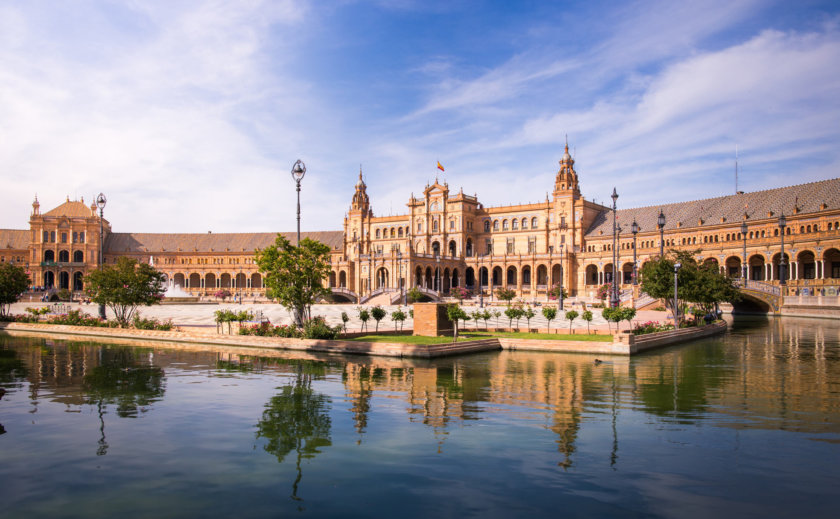
After a good night’s sleep, let’s continue this 14-15 days Andalucia itinerary.
For this second day in Seville, let’s start with a stroll in the city.
Head first to the Alcazar of Seville, the second must see monument of the city.
There too, the waiting line is always very long, so you should book your skip the line tickets in advance here. Once you’ve done that, just go wander around in the palace and the gardens. Allow one morning for this visit.
After your lunch break, stay in the Santa Cruz district and go visit the Casa de Pilatos , with its large patio and beautiful gardens.
Then you can keep wandering around the city, or go back to your hotel and enjoy the pool for a bit.
At the end of the day, head to the Metropol Parasol to enjoy one of the best scenic view over Seville and look at the sunset.
Finish your day with a touch of Andalusian folklore and go see a flamenco show ! it’s a typical activity to do during a 2 weeks trip to Andalucia. I recommend the show at the Museum of Flamenco Dance. You need to Book your tickets here.
Since this 2-week itinerary in Andalusia also includes a visit to Cordoba and Granada , to save money you can buy the Andalusia Pass .
It includes:
- A skip the line ticket for the Alcazar of Seville
- A skip the line ticket for the Alhambra of Granada and the Nasrid palaces
- A guided tour of the Mosque-Cathedral of Cordoba
- An audio guide for Seville and Granada, to download on your smartphone.
To book your Andalusia Pass , you just have to click on the button below:
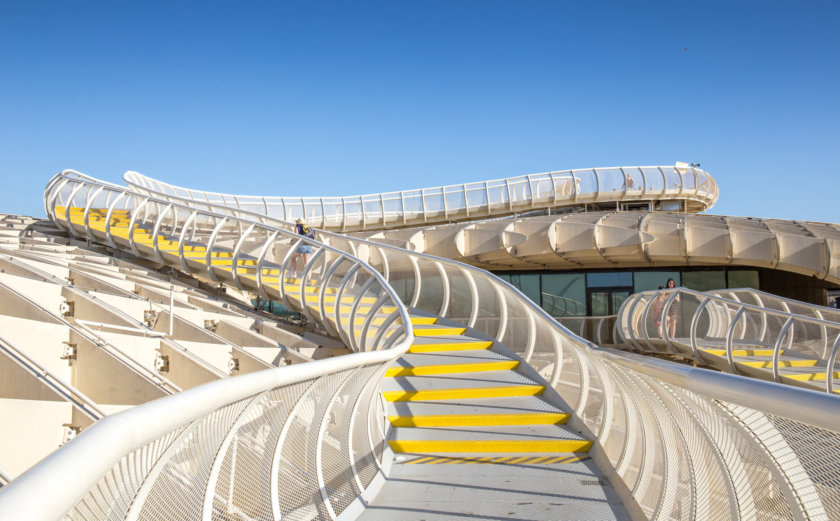
For this 3rd and last day in Seville, here are the places you should visit:
- Head to Triana covered market to try Spanish cured meats and cheeses.
- Still in Triana, walk along the river by the Calle Betis and go towards the Torre del Oro.
- If you want, visit the Torre del Oro, where the Maritime Museum is located. There is also a panoramic terrace.
- Discover Seville Plaza de toros de la Real Maestranza (the bullfighting arena)
- Visit one of more museums , or if you are tired of walking, go on a boat tour on the Guadalquivir.
- And why not enjoy the sunset at the Plaza de España?
If you’re going to Seville and want more info about the city, you should read my detailed article: The 15 Best Things to do in Seville .
- Black Swan Hostel : Youth hostel located within 10 minutes walking distance from the Cathedral and the Alcazar. Very stylish and contemporary dormitory bed from 17€ per night, breakfast included! Strong points: the relaxed atmosphere, the friendly staff, the free dinners cooked by volunteers. This is the best choice if you are looking for a youth hostel.
- Hotel Don Paco : Located in the centre of Seville, at 10 minutes on foot from the Cathedral. Spacious room and comfortable bedding from 60€ per night, breakfast at 10€. Strong points: excellent breakfast, the peaceful atmosphere and the swimming pool on the roof. My favorite in Seville for its great value for money!
- Hotel Fernando III : Located in the historic district of Santa Cruz and therefore close to the Cathedral and the Alcazar. Modern and spacious room from 106€ per night, breakfast included. Strong points: the excellent location, the pool on the roof, the very helpful staff.
- EME Catedral Hotel: Located right next to the Cathedral and the Giralda. Very modern double room from 180€ per night, breakfast at 20€. Strong points: The best location in town, the hotel design, the swimming pool with the view on the Cathedral, the amazing breakfast, the very helpful staff. Don’t hesitate, it’s the best luxury hotel in town!
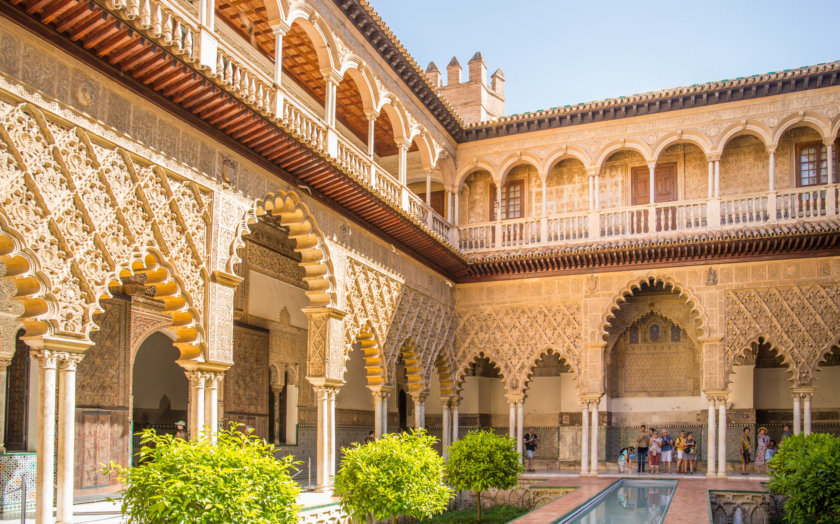
2) Cordoba (1 day)
The second stage of your 2 weeks itinerary in Andalucia will take you to Cordoba , about 1h40 driving from Seville.
The famous Mosque-Cathedral of Cordoba is for sure the city’s must see attraction . The interior is truly unique and surprising with dozens of red and white columns and arcades.
You can get your tickets at the automatic machines (it’s quicker than at the front desk). If you want, you can also buy a ticket to go up the minaret for an extra 2€.
If you prefer a guided tour , no worries you can book one here!
Note that if you have purchased the Andalusia Pass I told you about a bit earlier, a guided tour is already included .
After the Mosque-Cathedral, head to one of the 2 biggest squares in the city, where many restaurants are located : La Plaza de las Tendillas and La Plaza de la Corredera. They are different from one another so I suggest that you eat at one for lunch and at the other one for dinner.
Then go for a short walk along the Guadalquivir. You’ll see interesting historic buildings such as the Puerta del Puente, the Roman bridge and the Calahorra tower (on the other bank).
It’s possible to go up the tower to enjoy a nice view over Cordoba and the Mosque-Cathedral.
Your last visit in Cordoboa will be the Alcazar de los Reyes Cristianos . The place is worth stopping by for its nice gardens , flowered alleys, and fountains. I personally found them way more beautiful and better maintained than the ones in the Alcazar of Seville.
Spend the night in Cordoba.
If you want more info about how to visit Cordoba in 1 day, you can read my article: The 10 best places to visit in Cordoba .
- Option Be : Hostel located in the district of Judería. Bed in dormitory from 22€, breakfast included. The positive aspects of this brand new hostel: perfect staff welcome, comfortable bed, very clean, outdoor pool and great location.
- Ayre Hotel Cordoba : Located within a 10 minute drive from the center of Cordoba, at the center of a beautiful and quiet garden. Room with classic decoration but very spacious from 61€, breakfast 10€. The best: quiet location, large outdoor pool and free parking. We love to be far from the crowds and the city.
- Hotel Boutique Caireles : Located in front of the Mosque of Cordoba, right in the historic district. Modern and bright room from 67€ breakfast included. The best: the view of the Mezquita from the rooms, the kindness of the staff who also speaks French. My favorite for its great value for money!
- Eurostars palace : Located on the paseo de la victoria, within a 5 minute walk from the entrance of Judería and Mezquita. Huge room and very good design from 110€ per night, breakfast at 14€. The best: good geographical location, swimming pool on the roof. The best choice in Cordoba for an affordable luxury stay!
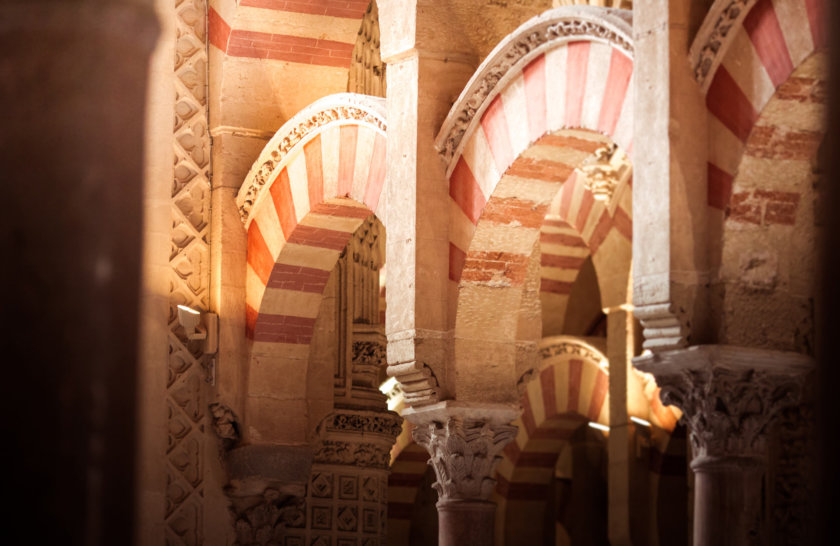
3) Granada and its surroundings (4 days)
New day, new city!
For the 3rd stage of your 2 weeks road trip in Andalucia , you will go to another famous city: Granada .
Well, not right now:
Before getting to Granada at the end of the day, you will stop twice on the way to visit lovely villages. With their renaissance style buildings , these 2 villages are both UNESCO Wo rld Heritage sites.
Let’s start with Ubeda, 1.5 hour driving from Cordoba . This authentic village is very different from other typical Andalusian villages.
Here are the best places to see in Ubeda:
- Holy Chapel of El Salvador, a jewel of Spanish Renaissance architecture
- Vazquez de Molina palace, today used as the city hall
- Dean Ortega Palace, a building from the 16th century
- The Basilica de Santa Maria de los Reales Alcazares.
After visiting Ubeda, get back in your car and go to Baeza , only 8 kilometers away.
In Baeza you shouldn’t miss:
- Baeza cathedral
- Palacio de Jabalquinto
- Church of St. John the Evangelist
- Plaza del Populo
By the end of the afternoon, head to Granada , 1.5 hours away.
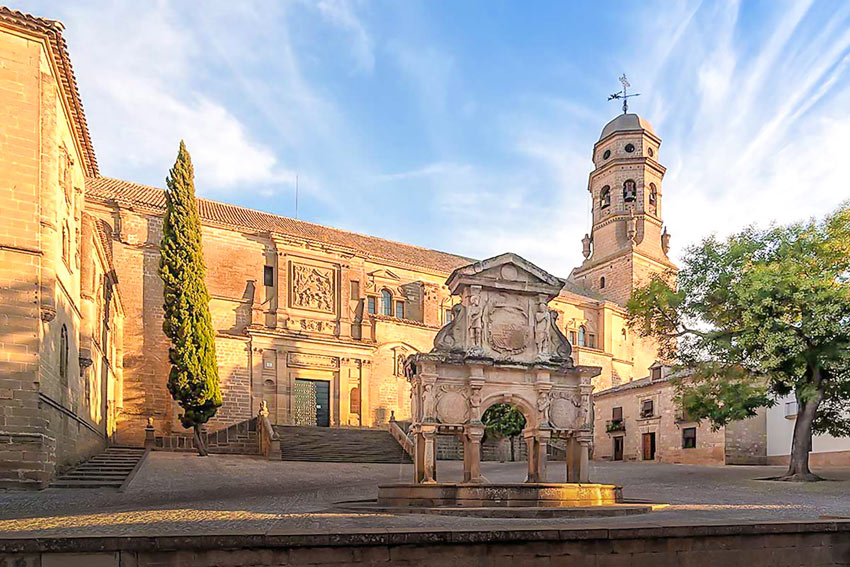
Today let’s start visiting the city. Just like Seville and Cordoba, Granada also has its emblematic attraction: the Alhambra .
You must book your entrance tickets in advance to visit the site. And when I say in advance, I mean weeks or even months in advance, depending on the time of the year you go on your two weeks trip to Andalucia.
In fact, the Alhambra is Spain’s most visited site . Yes, there are more tourists visiting the Alhambra than the Sagrada Familia in Barcelona !
When you book your tickets, make sure they include the 3 parts of the Alhambra:
- The Nasrid palaces
- The Generalife
- The Alcazaba
For sure, the best is to visit the Alhambra with a guide . You need to book your guided visit (including entrance tickets) here.
The Andalusia Pass (click here), which includes a visit to the Alcázar of Seville and a guided tour of the Mosque-Cathedral of Cordoba, also offers a skip the line ticket to visit the Alhambra of Granada .
Another option to book tickets for the Alhambra is to buy the Granada Card . I will give you more details about it in my “Voyages Tips Advice” below.
Allow a full morning to visit the Alhambra.
After you’re done, you should continue your day with:
- A walk in the Sacromonte , the old Gipsy neighborhood with its troglodytes houses. Today, they often hosts flamenco shows.
- A visit to the “Cuevas del Sacromonte” museum to learn more about the history of the neighborhood and its population. Book your tickets here!
- A stroll in Albaicin neighborhood, the historic district of Granada, an authentic and charming area.
- Watch the sunset at the mirador de San Nicolas and enjoy a great view over the Alhambra.
- Go to a flamenco show in a renown cuevas or at the Jardinos de Zoraya.
Spend a second night in Granada.
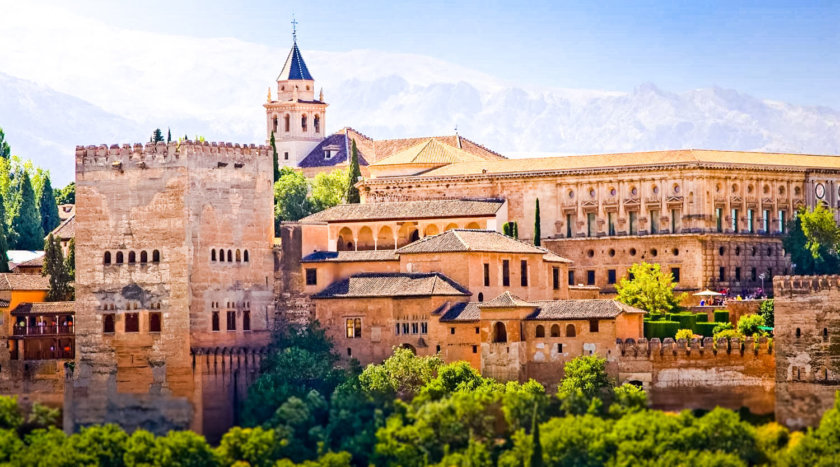
The day after, keep exploring Granada:
- Visit the Basilica of San Juan de Dios and its golden interior
- Go inside the cathedral and the royal chapel
- Have lunch on plaza Bib-Rambla, the main square of the city, where all the commercial streets start from
- Go shopping at Alcaiceria market
- Stop by the ancient Arab baths, the best preserved of Andalucia
- Watch the sunset from the mirador de San Cristobal or the mirador de San Miguel
Spend a 3rd night in Granada.
For your 3rd day in Granada, I recommend going out of the city to spend a day in nature.
So head to the Sierra Nevada mountains , 50 min driving from Granada.
In winter (December-April) you can ski there. During the rest of the year, it’s a great place for hiking and other outdoor activities such as mountain biking, climbing or paragliding.
You can go there by your own means with your car, or go on a day-tour departing from Granada, in a 4WD vehicle and with a guide. He will show you the most beautiful spots of the Sierra Nevada.
For more information and to book your day-tour, click here!
Go back to Granada and spend one last night there.
If you need more information to plan your trip to Granada, you can read my detailed article: The 15 best things to do in Granada.
There is a city pass to visit Granada: the Granada Card . It’s valid for 3 consecutive days .
This card gives you free access several Granada tourist attractions: The Alhambra, the cathedral, the royal chapel, the Cartuja monastery and the Science park. You also get free public transports for 3 days! You need to book it by clicking the button below:
- Granada Inn Backpackers: Hostel located 10min away from the Cathedral and 20min from the Alhambra. One bed in a dorm starting from 16€ per night, breakfast included. Best features: the beautiful patio, the location, the very friendly staff.
- Hotel Universal: Located 400m from the Cathedral and 700m from the Albaicin neighborhood. Clean and comfortable double room starting from 65€ per night, breakfast included. What I loved: the friendly staff, the central location close to stores and restaurants. It’s my favorite hotel in Granada for its amazing value for money!
- Granada Five Senses Rooms & Suites: Located on Gran Via avenue, 200m away from the Cathedral. Design and modern room starting from 100€ per night, breakfast included. Strong points: the rooftop pool, the rooms decoration, the generous breakfast.
- Alhambra Palace: This 5 stars hotel is located 10min walking from the Alhambra or the Albaicin neighborhood, next to the Carmen de Los Martires garden. Cozy and spacious room starting from 200€, with an additional breakfast for 19€. Its best features: the Moorish-inspired decoration, the splendid view over the Alhambra from the terrace, the overall comfort. It’s my favorite hotel for a romantic gateway in Granada!
- Parador de Granada: This luxury hotel is located within the Alhambra itself! The rooms are a mix of modern design with touches of antiques elements, starting from 420€ per night, with an additional breakfast for 21€. What I loved: The exceptional location, the overall atmosphere, very helpful staff, the restaurant with a view over the Generalife. This is the best hotel for a luxury stay in Granada!
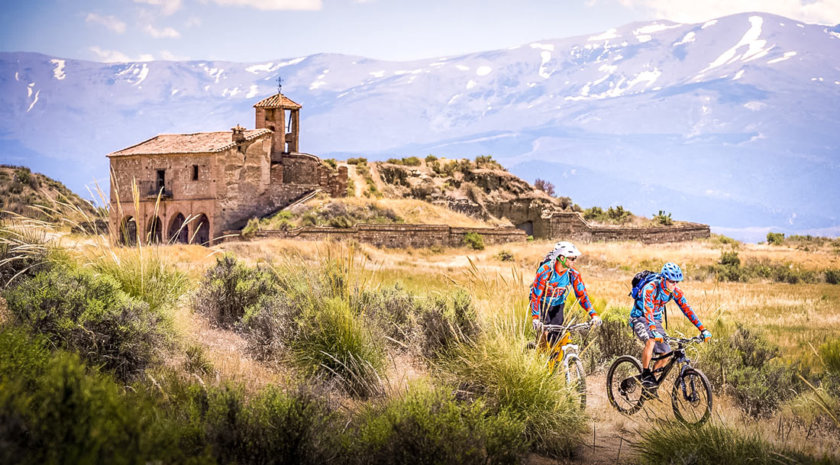
4) Malaga / Caminito del Rey / Marbella (3 days)
For the fourth part of this two weeks Andalucia itinerary, it’s time to discover Malaga and its surroundings.
Malaga is located about 1h40 away from Granada.
Once you get there, here are the best things to do in Malaga:
- Start with the Castillo de Gibralfaro. It dominates the city and offers an amazing bird’s-eye view of Malaga!
- Go down to the Alcazaba to walk around the lovely gardens of this palatial fortification.
- Stop by the Roman theater , located right next to the Alcazaba.
- Lunch break
In the afternoon , you can visit one of the 30 museums of the city .
From a culture point of view, Malaga has a lot to offer:
- Picasso Birthplace Museum (get you tickets here) : where he was born in 1881. You’ll learn more about his life and will see some of his personal belongings.
- Picasso Museum with more than 200 artworks from the artist
- Carmen Thyssen Museum with its extensive collection of Spanish and Andalusian paintings
- Centre Pompidou Malaga , is a branch of the famous Centre Pompidou in Paris
- Russian Art Museum offers a collection of Russian art pieces in an old tobacco factory
- Museo de Malaga
- Flamenco Art Museum
- Automobile Museum Malaga and its 85 perfectly renovated vintage cars.
Of course, it’s not possible to visit them all, but you will for sure find 1 or 2 that will match your interests!
Depending on the museum you chose to visit, don’t forget to stop by (before or after the museum) Malaga cathedral to see its interior. You can also go to the top of the tower and enjoy a 360° scenic view.
At the end of the day, if you’re looking for a beach break , head to Malagueta beach , the most easily accessible one.
Spend the night in Malaga.
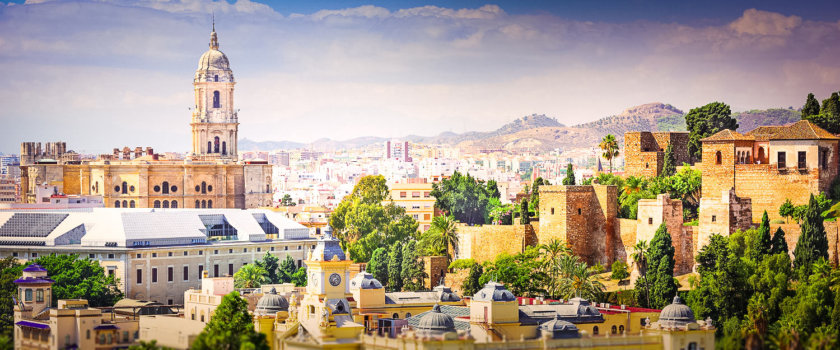
On this second day in Malaga , you have 2 different options for today’s program.
If you don’t feel like driving anywhere, stay in Malaga. Here are the places you can visit:
- Atarazanas market and its local delicacies
- Soho neighborhood
- La Concepcion Botanical Garden.
If you want to enjoy Andalucian nature and hike a bit:
- Go to Montes de Malaga Nature park for hiking or even mountain biking on marked paths. It’s located 25km North of Malaga.
- If you’re a bit more adventurous, you should go to the Caminito del Rey Path. For a long time, it was considered to be the most dangerous hiking path in the world! After a lot of upgrades and rearrangements, it’s now totally safe, but hiking at 100 meter above the ground right along the cliffs is still really impressive.
It’s possible to visit the Caminito del Rey with a professionnal guide , however, you’ll have to book your tickets quite early in advance. The full day guided tour needs to be booked here.
Spend another night in Malaga.
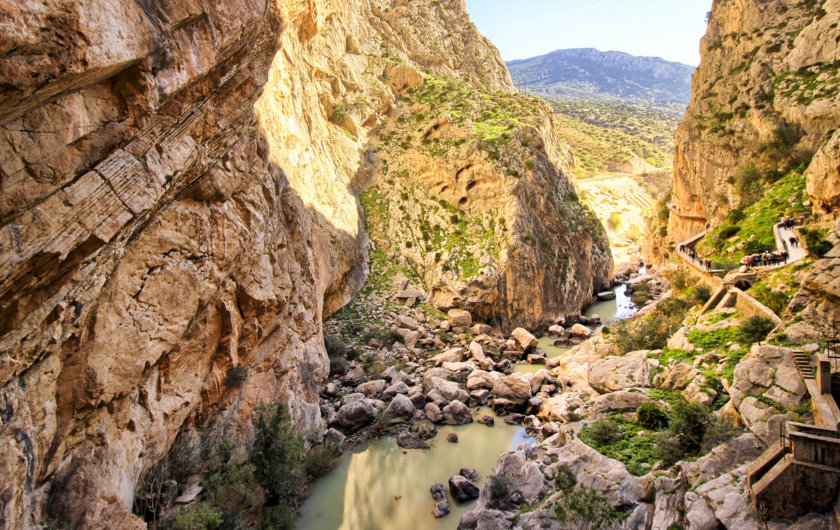
The day after, let’s have a chill day during this 2 weeks trip to Andalucia and spend it in Marbella.
You can enjoy 20km of beaches in the most chic and trendy coastal resorts of the Costa del Sol.
Go back to spend one last night in Malaga.
For more information about Malaga and its surroundings, you should read my detailed guide: The 15 best things to do in Malaga .
- The Lights Hostel: This hostel located 400 meters from the cathedral. A bed in a dorm starts from 20.50€/night with a breakfast at 1.50€. Strong points: clean, nice rooftop, very friendly staff.
- Ibis Malaga Centro Ciudad: Located next to the cathedral and 5 min from the Picasso museum. Modern double room (typical style of this hotel chain) starting from 65€/night, breakfast for an additional 7.95€. Its best features: very central location to visit Malaga on foot, many breakfast options. friendly staff. It’s my favorite hotel for its exceptional value for money!
- Barceló Malaga: located 10 min walking from the historic quarter and 600 meters from the Center for Contemporary Art. Comfortable and design room starting from 135€/night, breakfast for an additional 18€. Best features: Rooftop pool, location, beds are very comfortable. It’s a great place to stay in Malaga.
- Gran Hotel Miramar: This 5 stars hotel is located 10 meters away from the Malagueta beach. Very elegant and beautifully decorated room, starting from 250€/night, breakfast for an additional 25€. Its best features: the decoration of the hotel and the rooms is truly stunning, the pool, the Spa, the breakfast is delicious. The best choice for a luxury stay in Malaga!
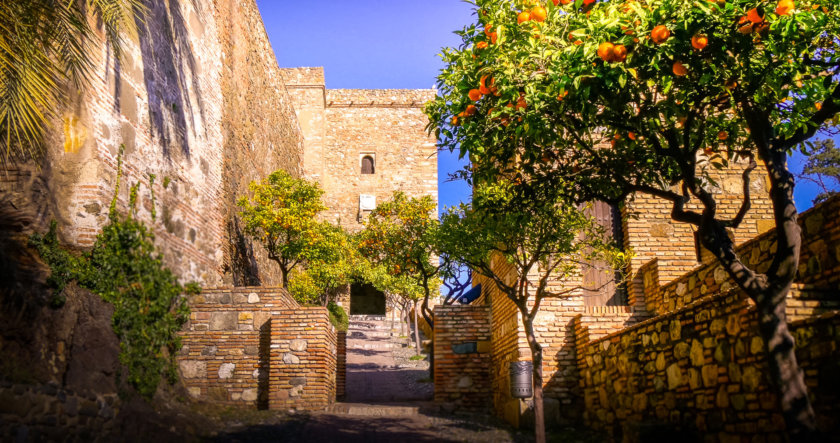
5) Ronda / Arcos de la Frontera (2 days)
Let’s now go to the charming village of Ronda , 1.5 hours drive from Malaga.
Ronda is located on a promontory rock so it offers lovely scenic views over the surroundings. The village is mostly famous for its very photogenic bridge that connects the two parts of the town.
It’s one of the most touristic village in Andalucia.
Beside the bridge, here are the other places to see in Ronda:
- The bullfighting arena, one of the oldest in Spain
- Mondragon palace where the Ronda’s municipal museum is located
- Plaza Duquesa de Parcent
- The bandit museum
- Puerta de Almocabar and its defensive walls
- La Casa del Rey Moro and the Mina of Agua
- Plaza del Socorro.
You can find detailed information about Ronda in my article: The 10 best things to do in Ronda .
Then go back to your car and head to Andalucia white villages route . As the name suggests, you’ll cross several villages with whitewashed houses, very often built on mountainsides.
In my opinion, if you only have the time to stop by one, it should be Zahara de la Sierra . It’s the nicest and most typical!
Then reach Arcos de la Frontera (1 hour away driving), your stopover for the next 2 nights.
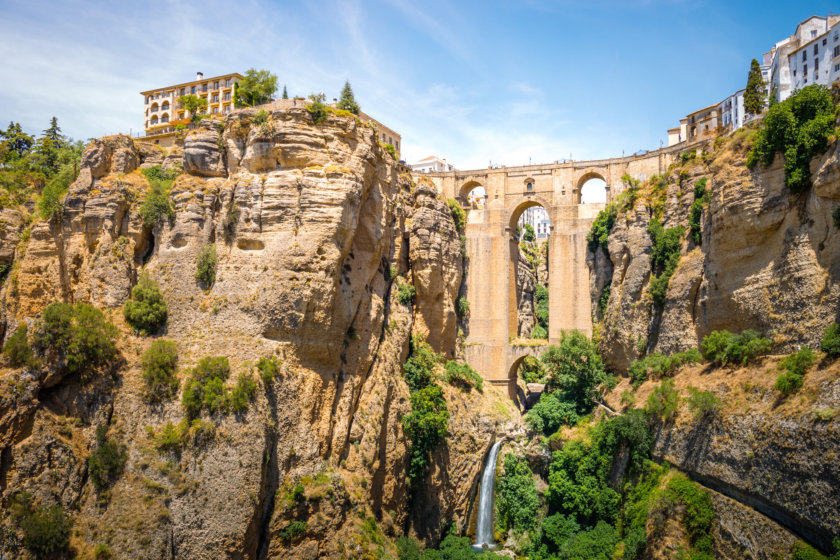
The day after, you should go to the Sierra de Grazalema Natural park, only 30min driving away from Arcos.
There are multiple entrances to the site with many hiking path departure points .
The closest one from Arcos is located in “El Bosque” village . There is a visitor center to get more information about hiking paths. You should first go there, as some paths may be closed to the public dute to fire hazard.
During my 2 weeks trip in Andalucia, I did the “El Rio majaceite” hike. The path goes along the river (of the same name), which is very pleasant on a warm day. There’s lots of shade along the way and you can even dip your feet in water to cool off. Allow 4 hours walking for the round trip.
After the walk, I recommend stopping by the village of Arcos de la Frontera . To visit it on foot, follow the “ruta monumental” signs and you’ll see churches and the castle. You’ll also find several coffee shops and restaurants.
Sleep for one last night in Arcos.
- Bed and Breakfast El fogon del Duende : An excellent choice of accommodation in Arcos. Double room from 45€. per night. The best budget choice!
- Hôtel Los Olivos: Located in Arcos historic center, in typically Andalusian house. Comfortable double room from 90€ per night, breakfast included. Strong points: the view from the rooftop terrace, the breakfast and the very kind staff.
- Parador de Arcos de la Frontera: Also located in Arcos historic center, large and quite double room from 120€ per night, breakfast at 17€. Strong points: the great view on the the Andalusian countryside, the traditional house, the best location. Looking for a more high-end place to stay in Arcos? This is the best hotel!
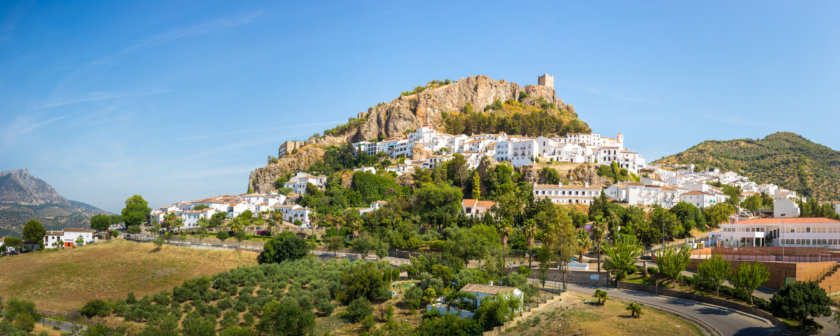
6) Cadiz (1 day)
If you visit Andalucia in 14-15 days, you will have time to explore Cadiz .
Cadiz is not often included in a trip to Andalucia because it’s less popular than Seville, Granada or Cordoba and yet, this city is really worth stopping by. It was the good surprise of my trip to Andalucia.
The great thing is that from Arcos, it’s only 45 min driving away.
You’ll arrive in Cadiz by passing through the Constitución de 1812 Bridge , which is 185 meters high. It’s one of the highest maritime bridge in the world, needless to say it’s very impressive!
Here is my recommended itinerary for 1 day in Cadiz:
- Start at plaza de San Juan de Dios, where the city hall and the San Juan de Dios church are located. It’s a pedestrian square where you’ll find restaurants and the tourist office is not far from there either. It should be your first stop to get a map of the city!
- Pass by the Roman theater , the biggest and oldest one discovered in Spain. Entrance is free!
- Visit Cadiz cathedral and go up the Poniente tower to enjoy the scenic view over the city.
- Head to Cadiz market for your lunch break.
- Go up the Tavira tower, the room equipped with a set of optical lenses and mirrors allows you to enjoy the view over the whole Cadiz bay.
- Go on a walk along Campo del Sud until the San Sebastian castle
- Pass by Caleta beach to reach Santa Catalina castle
- Go on a stroll in Genoves park and Alameda Apocada park
- Visit the Cadiz museum on plaza Mina. It’s free for all European citizens.
- Plaza de España will be the last stop of your visit of Cadiz!
Spend one night in Cadiz.
Don’t hesitate to read my detailed article about Cadiz for more information about the city: The 12 best things to do in Cadiz
In Cadiz, the underground parking lot located next to the port is the best one to park at. It’s close to the historic center and the plaza San Juan de Dios.
- Cadiz Inn Backpackers : Hostel located 10 minutes’ walk from the Cathedral. Bed in dormitory from 14 € per night. strong points: its roof terrace and the staff welcoming.
- Hotel La Catedral : As the name suggests, it’s located right next to the Cathedral. Modern and elegant room from 60 € per night, including breakfast. I have a big crush for the rooftop terrace with an outdoor pool and breathtaking views of the cathedral! This is my favorite in Cadiz for its great value for money!
- Parador de Cadiz : Located in front of the ocean and 5 minutes’ walk from the beach of La Caleta. Very nice modern and bright room from 138 € per night, breakfast included. Strong points: outdoor pool with nice views, quality of service, well-equipped rooms, original and modern architecture. It’s the best hotel in town, perfect for a luxury stay in Cadiz!
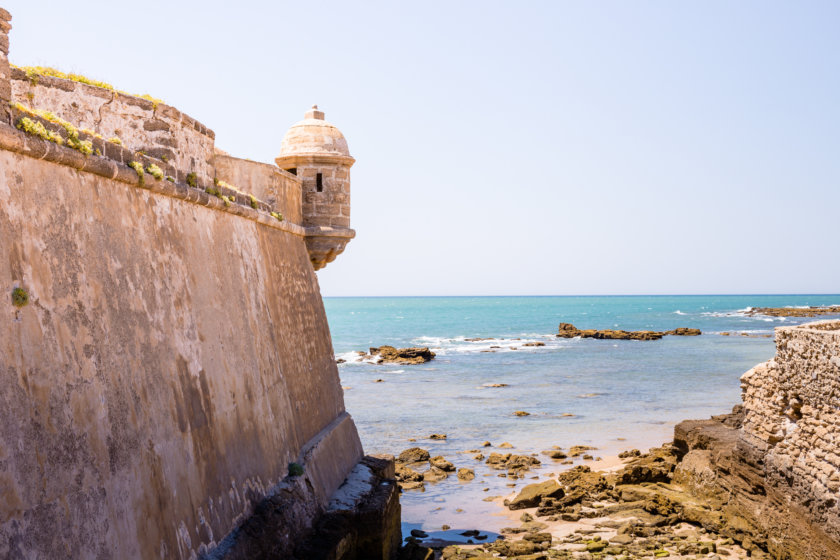
Here we are! It’s already the end of this 2 weeks Andalucia road trip.
Now you know the best places to visit for your 15 days in Andalucia!
Your Andalucia trip is only 14 days long ? Spend one day less in Granada or Malaga.
For a 16 days intinerary in Andalucia , add a day to discover Doñana National Park. It’s located only 50min away from Cadiz and is one of the largest protected area in Europe.
If you want to rent a boat for a nice day at sea during your itinerary in Andalucia, you should book it with Samboat.
Motorboats, sailboats, yachts, small boats without a license, with or without a skipper: they simply have the most complete offer for boat rental!
So, what are you waiting for to book your sea trip in Andalusia? 😊
If you have any question to plan your 14-15-16 days Andalucia itinerary, don’t hesitate to ask me in the comments.
Andalusia travel Guides
- Buy the DK Eyewitness Andalusia guide on Amazon.com or on Amazon.co.uk
- Buy the Lonely Planet Andalusia guide on Amazon.com or on Amazon.co.uk
- Buy the Rick Steves Snapshot Andalusia guide on Amazon.com
Discover all my articles about Spain : All my articles to help you plan your trip to Spain are listed there.
- Cadiz: The 12 things you must-see in town!
- Cordoba: Top 15 best things to do and must-see attractions
- Granada: Top 15 best things to do
- Malaga: The 15 best places to visit
- Ronda: The 10 best things to do
- Seville: Top 15 best things to do and places to visit
You’re using Pinterest? Here is the picture to pin!
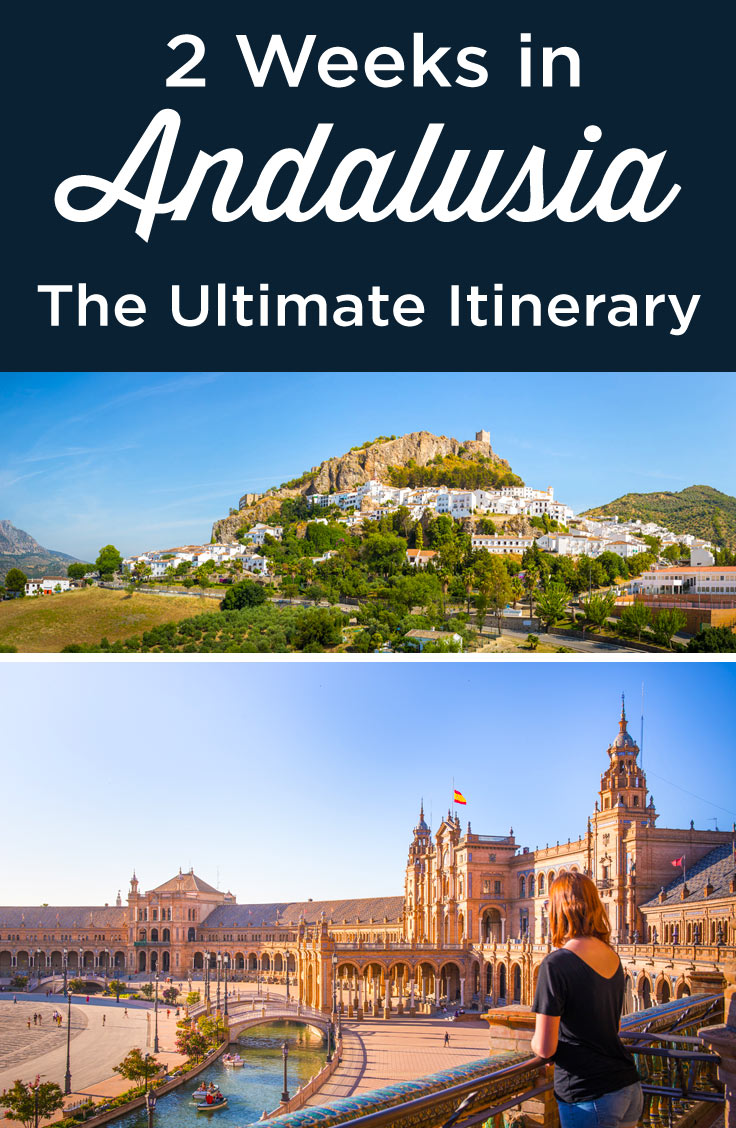
Creator of the Voyage Tips blog, travel and photography lover. I give you all my best tips to plan your next trip.
Related Stories
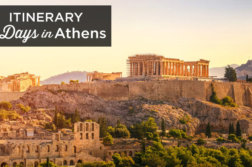
3 Days in Athens: The Perfect Itinerary (First Time Visit)
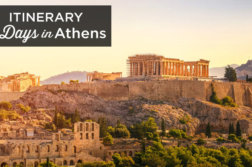
2 Days in Athens: The Perfect Itinerary (First Time Visit)
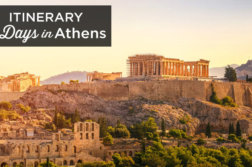
4 Days in Athens: The Perfect Itinerary (First Time Visit)
Leave a reply cancel reply.
Your Name (required)
Your Email (required)
Your Website (optional)
Save my name, email, and website in this browser for the next time I comment.
- Middle East
- North America
- Cheap car rentals: my best advice
- Back to Homepage

13 Top-Rated Tourist Attractions in Andalusia
Written by Lisa Alexander , Michael Law , and Lana Law Updated May 3, 2023
Authors Michael and Lana Law spent 10 weeks touring the sights of Andalusia in 2022.
Andalusia is the Spain of the imagination, a dreamy sun-kissed land where passion, poetry, and drama collide. Fearless matadors, fabulous festivals, and foot-stomping flamenco symbolize this emblematic region. Whispering the legacy of a bygone era, crumbling Moorish castles and old Jewish quarters have a subtle seduction. Ancient mosques and synagogues were replaced with Christian churches after the Reconquest, but the romance of the past remains.
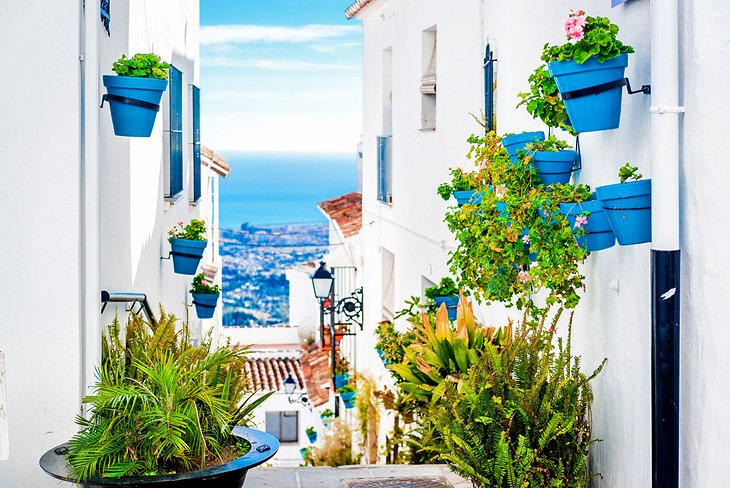
You can feel the legacy of the past while wandering the twisting medieval cobblestone streets, admiring the swirling Arabesque patterns in Islamic architecture, and listening for melancholy notes of Gypsy soul in the strumming of Spanish guitar. A stroll through almost any of Andalusia's historic towns leads to delightful discoveries of fountain-adorned squares and whitewashed houses with flower-filled patios.
Andalusia is also a place of contrasts: snowcapped mountains, lush green river valleys, and wild gorges. The dramatic scenery provides stunning backdrops for amazing sights. From the glorious cathedral of Seville to the magnificent Alhambra palace in Granada and the Great Mosque of Córdoba, Andalusia has some of the most thrilling monuments in the world .
Learn about the sightseeing highlights in this enchanting region of southern Spain with our list of the top attractions in Andalusia.
Seville: A Quintessential Andalusian City
The alhambra palace in granada, córdoba and the great mosque, the puente nuevo in ronda, the ancient port town of malaga, the pueblos blancos of andalusia (white villages), marbella: a glamorous beach resort with a quaint old town, andalusian traditions in jerez de la frontera, renaissance architecture in úbeda, historic monuments and old-world charm in baeza, map of tourist attractions in andalusia.
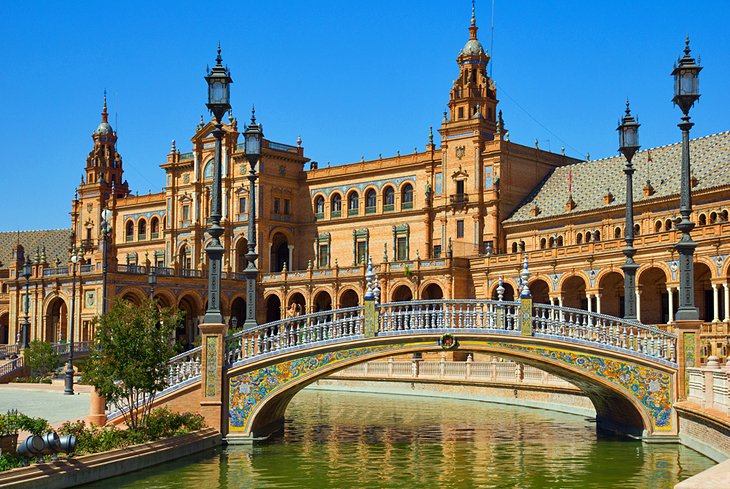
Romantic, dazzling, and sensual, Seville has a quintessential Andalusian character. This alluring city is one of the best places to visit in the region to experience traditional culture, including lively religious festivals and the famous flamenco dance.
Seville is also a city where you can get a feel for the joys of everyday life in Andalusia, simply by wandering the quaint cobblestone streets, relaxing in sunny plazas and taking an evening " paseo " (stroll) along with the locals. At night, the historic center is illuminated by old-fashioned street lamps, which gives it a special ambience.
The most important monument is the Seville Cathedral , which was converted from the Great Mosque and is the grandest Gothic church in Christendom . Another Moorish architectural relic is the Alcazar , with its dazzling Mudéjar decor and lavish gardens.
The medieval Barrio Santa Cruz , once the Jewish district, is a charming quarter with winding alleys and picturesque courtyards.
On a pleasant afternoon or balmy evening, the Plaza de España in the Parque de María Luisa is a wonderful spot to go for a walk or enjoy a leisurely boat ride through the park's canal.
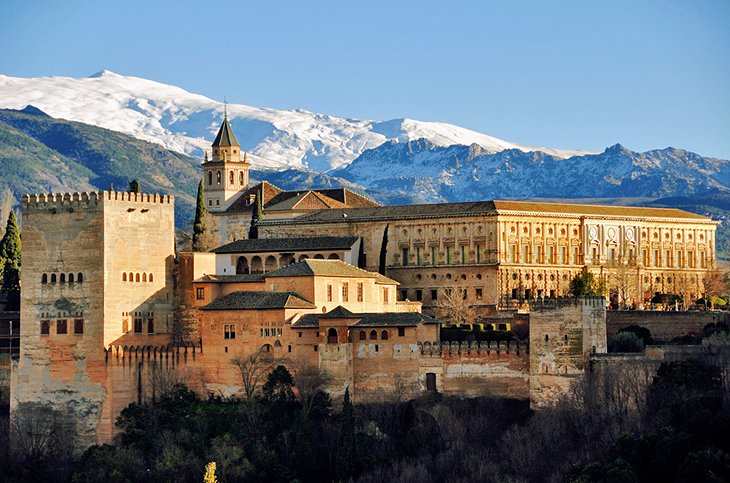
The Alhambra is a masterpiece of Islamic design and one of the most visited attractions in Spain . The complex includes several splendid palaces, gorgeous landscaping, fragrant rose gardens, and lavish decorative fountains. Because of its exquisite architecture and cultural value, the Alhambra is designated as a UNESCO World Heritage Site .
The Moors arrived from the deserts of North Africa (present-day Morocco and Algeria) in the 13th century, they were awestruck by the lush landscape of Granada. At the foot of the Sierra Nevada Mountains , abundant water from the Río Darro ensured rich vegetation and agriculture. The Moors built the remarkable hilltop citadel here, and overflowing fountains were placed all over the grounds as a symbol of wealth.
Granada continued to flourish as a Moorish city until the 15th century. When the Catholic Monarchs arrived to reconquer the city in 1491, Granada was the only remaining stronghold of Moorish rule in Andalusia.
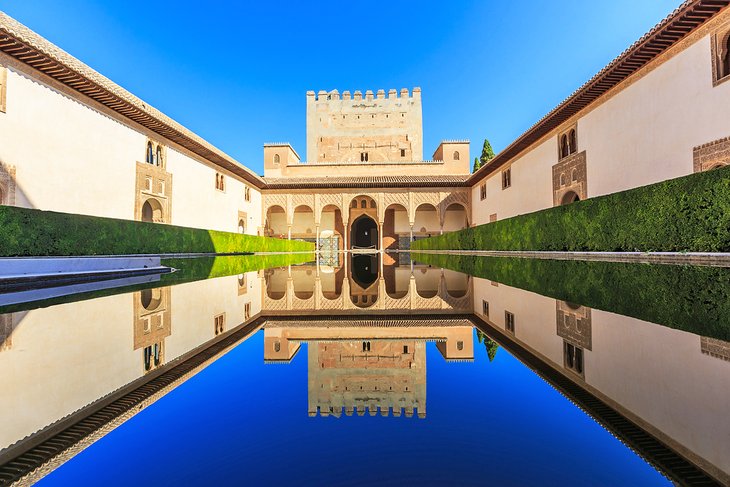
The last Moorish king, Muhammad XII (known as Boabdil), capitulated by giving King Ferdinand and Queen Isabella the keys to "paradise" (Boabdil's description of the Alhambra) after the Christian Reconquista (Reconquest) was complete in 1492. As the legend goes, Boabdil wept when taking in his final glimpse of the Alhambra during his journey of departure from Spain.
Along with the Alhambra, the Albayzín (Albaicín) district shares the UNESCO World Heritage classification. This medieval Islamic town has retained its Moorish character , seen in the maze of narrow, winding pedestrian streets and clusters of quaint whitewashed houses.
Further evidence of the city's Arabic heritage is found at the Alcaicería (on Calle Alcaicería), an outdoor market that is a relic of the old Moorish bazaar, and the luxurious Hammam Al Á ndalus , traditional Arab Baths that pamper modern tourists with spa treatments.
Other must-see sights in Granada include the Renaissance Cathedral and the adjoining Capillo Real where the Catholic Monarchs are buried. High on the list of top experiences is watching authentic flamenco performed by locals in a Gypsy cave on the Sacromonte .
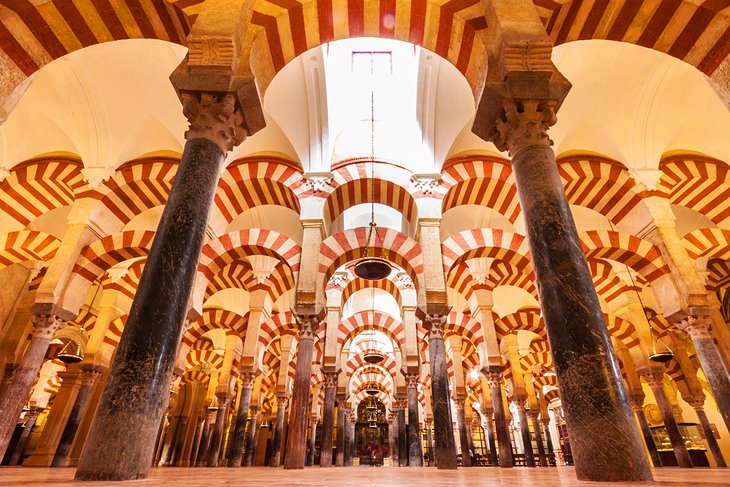
Córdoba is most famous for the Great Mosque, but this city offers much more for visitors, from charming narrow streets to an ambience you won't find in other Andalusian cities.
While Paris and Rome were in the Dark Ages, Córdoba was the most important city in Europe, a center of civilization where great scholars Maimonides (a Jewish philosopher) and Averroes (a Muslim philosopher) shared their ideas, and a place where the people of three religions, Christianity, Islam, and Judaism, lived in harmony.
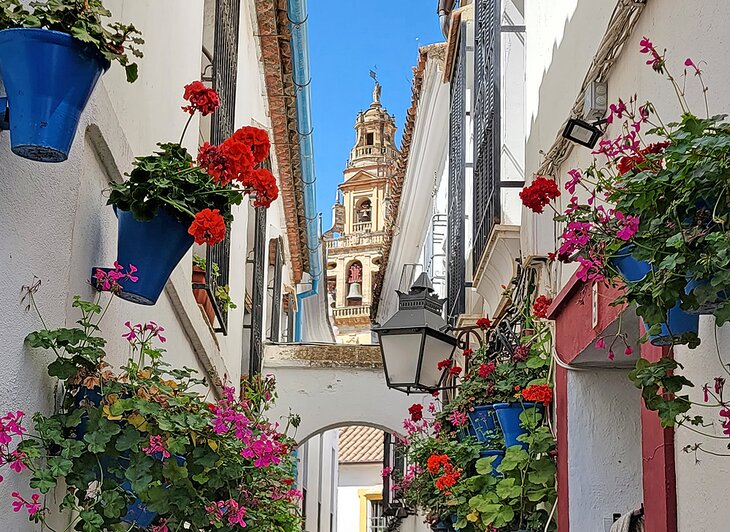
Top among the must-see sights of Córdoba is the UNESCO-listed Great Mosque surrounded by several historic residential quarters. The breathtaking sanctuary exemplifies Muslim architecture with its repeated rows of arches and columns, Byzantine-style mosaics, and gilded mihrab (prayer niche). This 8th-century monument is one of the most magnificent Islamic buildings ever constructed.
The Judería (the old Jewish quarter) is an especially atmospheric neighborhood of narrow pedestrian streets, quiet squares, and charming whitewashed houses. The homes in this district are famous for their decorative patios, adorned with colorful potted flowers.
During May, the town of Córdoba celebrates the Fiesta de los Patios , a highly anticipated festival with a competition for the most beautiful patio.
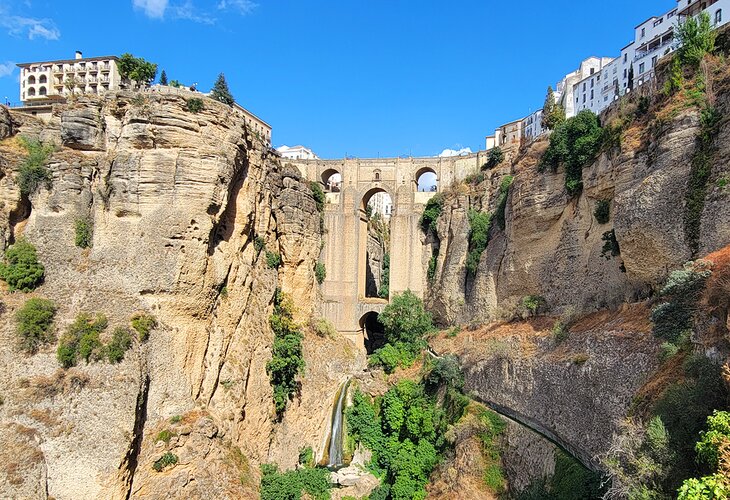
In a spine-tingling setting, Ronda offers dramatic views and wild scenery . Built above a steep ravine (El Tajo) crossed by the Puente Nuevo (New Bridge), this spectacular Pueblo Blanco features whitewashed houses clinging to the edge of a cliff top.
Proud of its traditional Andalusian culture, Ronda has the second-oldest bullring in Spain. The Plaza de Toros is still used once a year for the Goyesque bullfight (during the Feria de Pedro Romero , a festival that takes place the first week of September). The festival also includes a parade of women wearing flamboyant costumes of the late 18th century, the era of Francisco de la Goya.
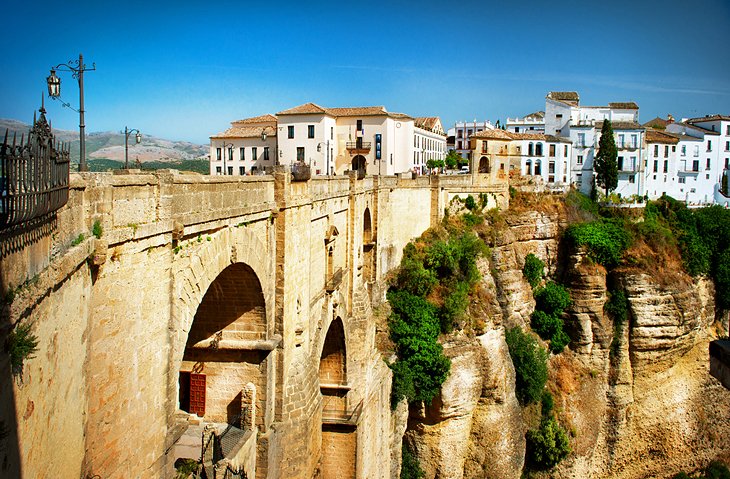
Ronda has a special beauty and romantic charm. Enjoy exploring the atmospheric cobblestone streets of La Cuidad , Ronda's old Moorish town, which has many historic mansions and palaces.
On sunny days, Ronda's parks are the ideal place to stroll tree-lined paths and relax in the shade. The Alameda del Tajo and Alameda de José Antonio parks both offer striking panoramic views of the landscape.
Providing another angle of Ronda's heritage, the Museo del Bandolero (Bandit Museum) illustrates the history of those daring, infamous anti-heros of the region.
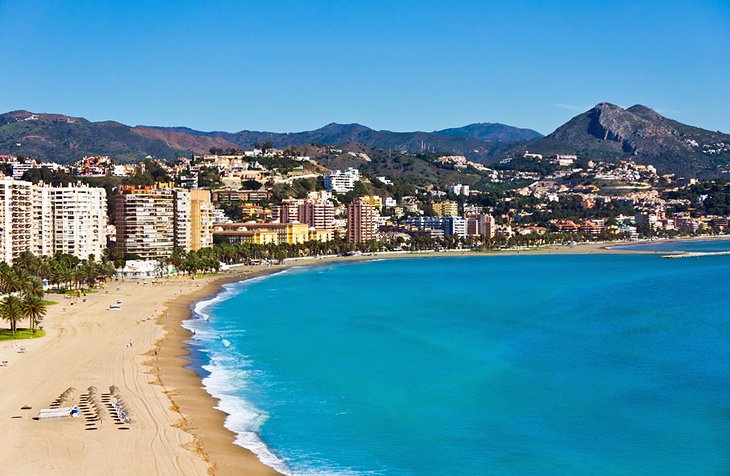
Malaga is an ancient Mediterranean port town and has the weathered fortresses to prove it. Standing on a hilltop overlooking the bay, the old Alcazaba and the Castillo de Gibralfaro castles watch over the harbor action and offer splendid coastal views.
Among the endless stretch of Costa del Sol beach resorts, Malaga is an anomaly because it is a real working city. Although this pleasant seaside town does have a fabulous sandy beach, the Playa de la Malagueta , sightseeing rather than sunbathing is the main draw for visiting Malaga.
With plenty of cultural sites and historic monuments to explore, travelers can easily keep busy here for a few days. The long list of tourist attractions in Malaga includes ancient ruins, the 16th-century Catedral Nuestra Señora de la Encarnación , beautiful gardens, and a fantastic Picasso Museum , as well as dozens of other excellent museums.
The medieval Old Town of Malaga is especially delightful. While exploring this maze of narrow pedestrian streets, visitors will find inviting little boutiques and hidden plazas filled with outdoor cafés and al fresco dining terraces.
Another favorite spot is the harbor, which is a great place for a leisurely stroll or to dine at one of the waterside restaurants.
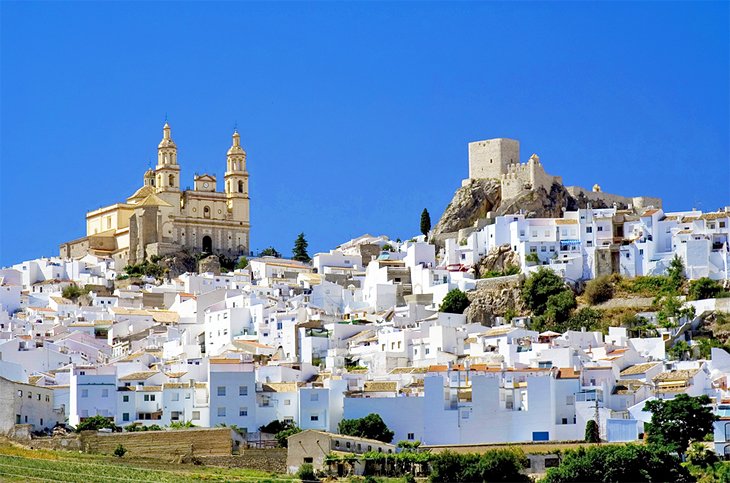
The Pueblos Blancos are enchanting, off-the-beaten-track tourist destinations in Las Alpujarras , the rolling hills of the Sierra Nevada, and in the Sierra de Grazalema and the Sierra Nevada mountain ranges.
Driving or long-distance hiking is the only way to arrive at these remote hilltop villages, but it's worth making the detour or even a multiple-day itinerary through Andalusia's most undiscovered and unspoiled area.
Full of old Moorish ambience, the Pueblos Blancos are characterized by their simple whitewashed houses. The architectural style is influenced by the Berber aesthetic of the Moors who hailed from North Africa.
Adding to the charm are the vibrant potted flowers, narrow cobblestone lanes, and lovely churches. Most of the villages are clustered on hillsides with marvelous views of the snowcapped mountains and verdant valleys.
The gateway to the Pueblos Blancos is Arcos de la Frontera , with its glowing white buildings arranged in a semicircle on a cliff top. Ronda is the most dramatic of Andalusia's whitewashed villages, famous for bullfighting, as well as awe-inspiring scenery.
One of the prettiest of the villages is Grazalema , a high-mountain town nestled in a valley and surrounded by a spectacular natural park.
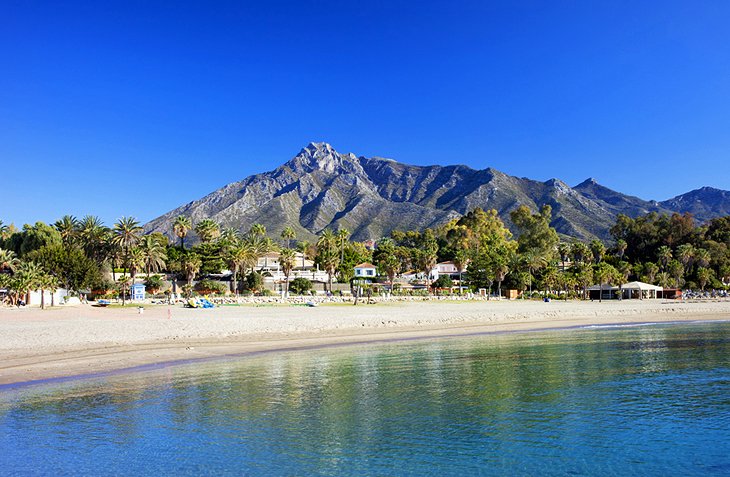
Along the Costa del Sol , the glamorous resort town of Marbella is prized for its stunning seaside scenery, palm-lined promenades, and sandy beaches along a 27-kilometer shoreline. As an upscale vacation town, Marbella has plenty of golf courses and private clubs that cater to a discerning clientele.
For a fashionable dining scene, head to the Puerto Banús , a gorgeous marina where many fancy yachts are docked. The port area also has many trendy restaurants and designer boutiques.
For beachside meals, the Playa de Alicante offers great choices. The closest beach to Marbella's city center is the Playa La Fontanilla , just a short walk from the Old Town.
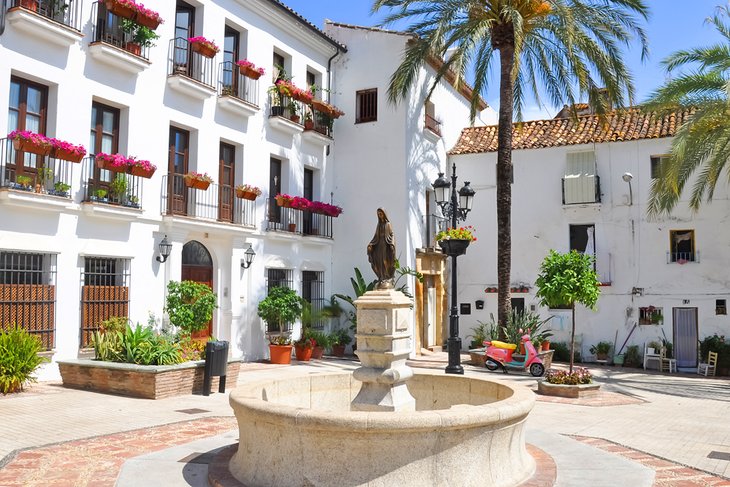
More than just a beach destination, Marbella has interesting cultural attractions. The perfectly manicured Old Town ( Casco Antiguo ) is an enchanting Moorish village with flower-bedecked, whitewashed houses and charming cobblestone lanes.
Hidden throughout the pedestrian streets and alleyways are exquisite little churches and quiet courtyards with sidewalk cafés. At the heart of the Old Town, the Plaza de los Naranjos is a lovely square shaded by orange trees and filled with restaurant terraces.
Other things to do in Marbella's Old Town include shopping at stylish boutiques, visiting museums, and admiring historic churches. The renowned Spanish Contemporary Engravings Museum displays works by Goya, Picasso, and Miró, among others.
The Municipal Collection of Archaeology is found at the pleasant Plaza del Altamirano . On this charming square, the tables from two restaurants spill out onto the cobblestone outdoor patio space. It's an inviting spot to dine al fresco during summertime.
The most noteworthy churches are the Iglesia de Nuestra Señora de la Encarnación , built on the site of a former mosque, and the Iglesia del Santo Cristo , built in the 16th century.
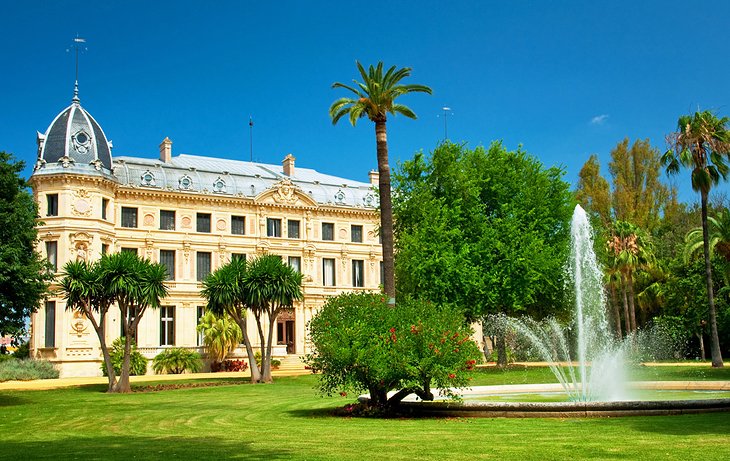
Jerez de la Frontera (35 kilometers from Cádiz) is a refined aristocratic town famous for its Andalusian pedigree horses and traditional equestrian shows.
In an elegant building on the Avenida de Duque de Abrantes, the Fundación Real Escuela Andaluza del Arte Ecuestre (Royal Andalusian School of Equestrian Art Foundation) stages the popular show titled Cómo Bailan los Caballos Andaluces (How the Andalusian Horses Dance), an equestrian ballet in the Andalusian style of the 18th century.
The Feria del Caballo (Jerez Horse Fair), held annually in May at the Parque González Hontoria, showcases the town's prestigious pedigreed horses. Visitors will appreciate the food stands, dance competitions, and children's activities at this lively event.
Jerez de la Frontera is also known for the traditional Andalusian art of flamenco dancing and cante jondo (deep song), a dramatic and evocative style of Gypsy singing. The Centro Andaluz de Documentación del Flamenco educates visitors about the various forms of flamenco singing, guitar, and dance, through videos, documents, and descriptions of historical figures.
The annual Festival de Jerez stages traditional, as well as avant-garde, flamenco performances of an exceptional caliber at the Teatro Villamarta and other venues.
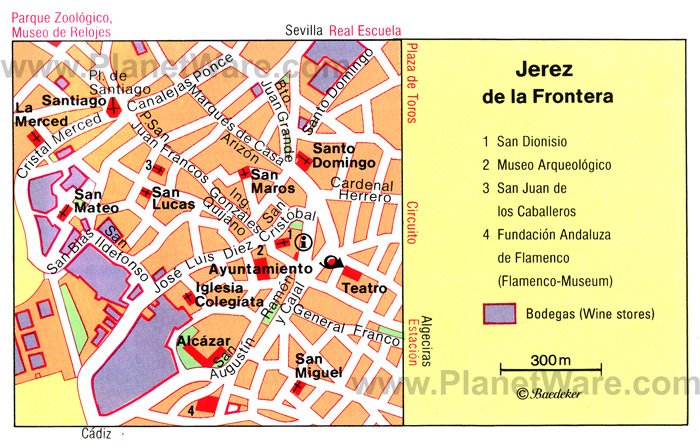
Amid picturesque olive plantations, this UNESCO-listed historic town of Úbeda is renowned for its Renaissance architecture. The central feature of the Casco Antiguo (Old Town) is the pedestrian-only Plaza de Vázquez de Molina , graced by the 16th-century Sacra Capilla del Salvador del Mundo.
With its richly sculpted Plateresque facade and Italian Renaissance-style domed interior, the Sacra Capilla del Salvador del Mundo stands out as one of the most emblematic landmarks in Úbeda. The chapel contains noteworthy artworks including the Transfiguration of Christ altarpiece by Alonso Berruguete. You may visit the chapel, which is open daily year-round; entrance requires an admission fee.
Excellent accommodations are found on the Plaza de Vázquez de Molina square at the four-star Parador de Úbeda , which occupies a 16th-century Renaissance palace featuring a typical Andalusian courtyard and traditional decor. The Parador de Úbeda has a fine-dining restaurant that serves regional cuisine.
Near Úbeda is Baeza (about 10 kilometers away), another UNESCO-listed city with marvelous Renaissance buildings, and Cazorla (about 45 kilometers from Úbeda), dominated by an ancient castle.
Cazorla is the main town of the Sierra de Cazorla mountain range and is a good base for hikes or climbs into the Parque Natural Sierra de Cazorla, Segura y Las Villas nature reserve, a ravishing landscape of rivers, waterfalls, forests, and canyons.
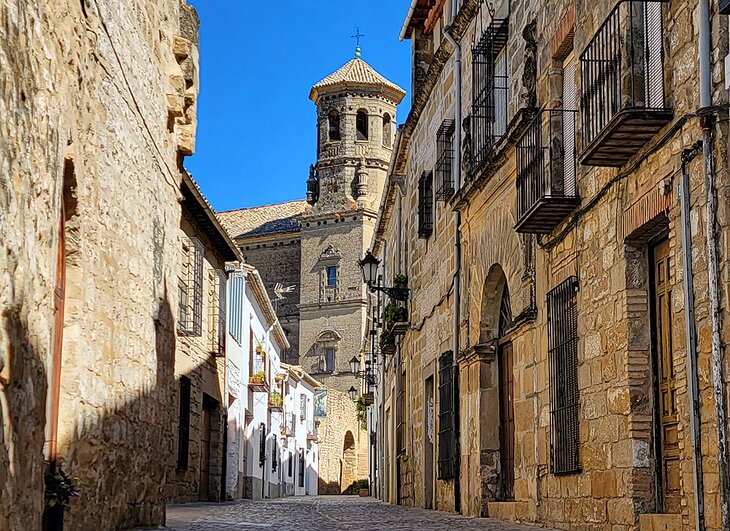
Designated as a UNESCO World Heritage Site along with Úbeda (10 kilometers away), Baeza boasts an ancient Roman, Moorish, and Christian heritage. Rolling hills, olive groves, and fields of corn surround the town, which has retained an old-world ambience in its cobblestone streets and elegant squares.
In the 16th century, Baeza became an important trading center and university town. The town's wealthy past is seen in the handsome old houses and noble mansions, as well as its Renaissance cathedral, the Catedral de Baeza on the Plaza de Santa María, built in the 16th century on the site of a demolished mosque.
The spacious Paseo de la Constitución in the center of Baeza is lined with impressive 17th-century mansions. The Plaza de los Leones at the west end of the Paseo de la Constitución was named after the fountain in the center of the square that incorporates four figures of lions from the Roman site of Cástulo.
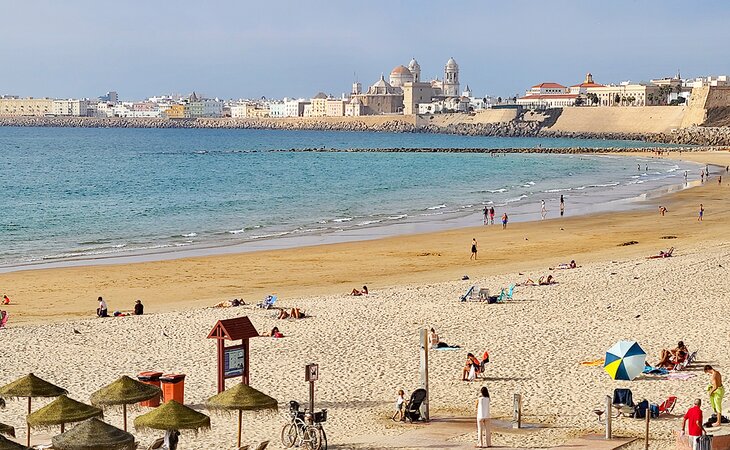
History abounds in Cadiz, long considered the most ancient city in Western Europe. With its mix of beaches and history, most people fall under the spell of Cadiz's charms in very short order.
Miles and miles of sand stretch southwards from the city; some of the best beaches in Spain , are found here. Set up your towel and umbrella at Playa de la Victoria and soak up the scene, or for a bit of luxury rent a sun lounger at a beach restaurant and have your drinks and food hand-delivered to you.
The Old Town is a delight to wander around and get lost in its warren of narrow streets and alleys. Historical buildings house small restaurants serving up fine Andalusian cuisine while others house eclectic and interesting shops. Not to be missed is Cadiz Cathedral and the lively plaza out in front along with Plaza de San Juan de Dios near the cruise port.
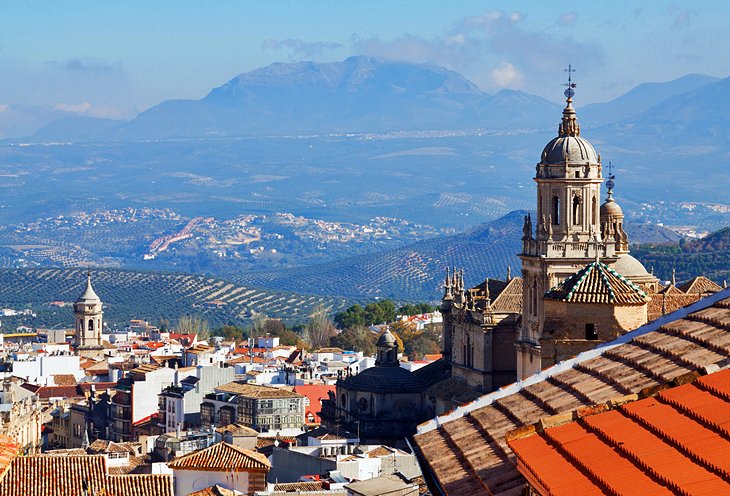
Jaén enjoys an idyllic natural setting at the foot of the Sierra de Jabalcuz and Sierra de la Pandera mountains, where the rolling hills are covered with expansive olive groves.
Steeped in history, Jaén originated as a walled Carthaginian town, and during Roman times was an area of silver mining. In the Moorish era, Jaén was the capital of the Islamic Kingdom of Jayyan, which was reconquered by Christian armies in 1492.
Must-see attractions are the UNESCO-listed Santa Iglesia Catedral de la Asunción de la Virgen , a remarkable Renaissance cathedral, and the renovated Arab Baths building that now houses the Manuel Moral International Museum of Naïf Art .
The most prominent site of Jaén is the majestic 13th-century Castillo de Santa Catalina , perched on a rocky hilltop. This old Moorish stronghold was captured in 1246 by King Ferdinand III.
Beautifully restored, the Castillo de Santa Catalina has been converted into a four-star luxury hotel, the Parador de Jaén with a swimming pool and luxuriant garden. Guest rooms feature traditional Andalusian decor and panoramic views of the landscape. The hotel's gastronomic restaurant serves regional cuisine including specialties such as Pipirrana (mixed vegetable salad) and Ensalada de Perdiz ( partridge with salad).
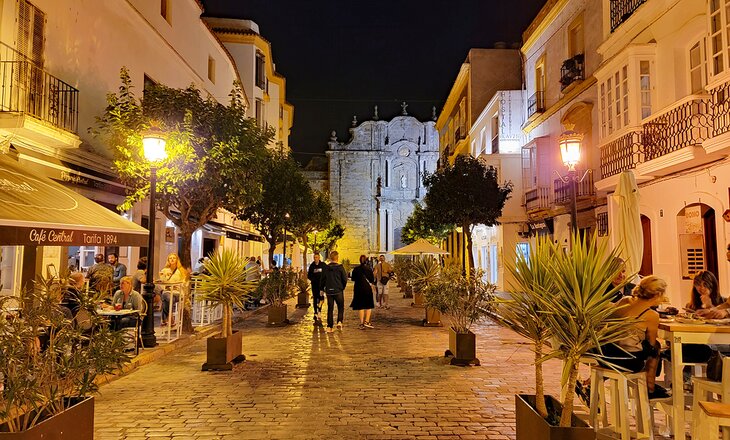
Located at the far southern tip of Andalusia, Tarifa is a fun and funky town that attracts a diverse and interesting crowd.
It has long been a destination for wind sport enthusiasts for its consistent and strong breezes, and the youthful vibe makes the place lively and enjoyable. Beaches both in town and down the way are some of the most beautiful in Spain. The spectacular Playa Valdevaqueros has golden sands, crystalline waters, and to top it all off, a huge sand dune at one end. Come here to be amazed by the sea of kiteboarders racing across the waters on a windy day.
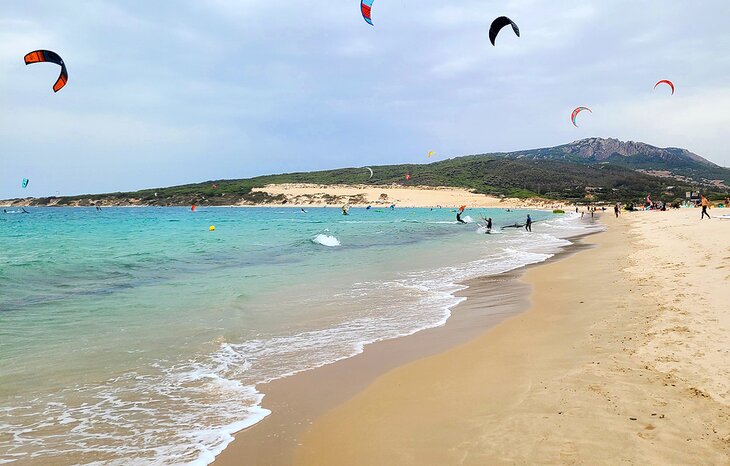
Tarifa has a small and compact Old Town jammed full of great restaurants with patios full of tourists and locals enjoying the warm evenings. Check out Silos 19 for their exceptionally prepared duck dishes.
Camping is a popular and affordable pastime here and a string of delightful campgrounds are set just back from the beach.
More Related Articles on PlanetWare.com
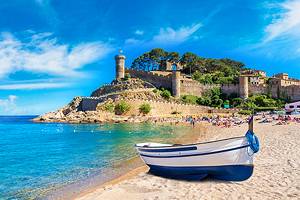
The Best of Spain: Andalusia may be the most emblematic region of Spain, but there are so many other must-see destinations throughout the country. For vacation-planning ideas, take a look at our article on the best places to visit in Spain . Beach lovers planning a summer holiday should read our list of the best beaches in Spain to decide on the ideal seaside locale.

More on Spain


Beautiful Things to do in Andalusia, Spain
Written By: The Planet D
Updated On: February 14, 2024
From the classic Alhambra to ‘Fifty Shades of Pink’, there are plenty of reasons to visit Andalusia Spain. Andalusia is such a magical place to me. It was the first Light & Land Tour I attended as a client in 1999 with landscape photographer Charlie Waite. From this moment on, I was lured to Andalusia and photography.

Travel to Andalusia – A Magical Photo Journey
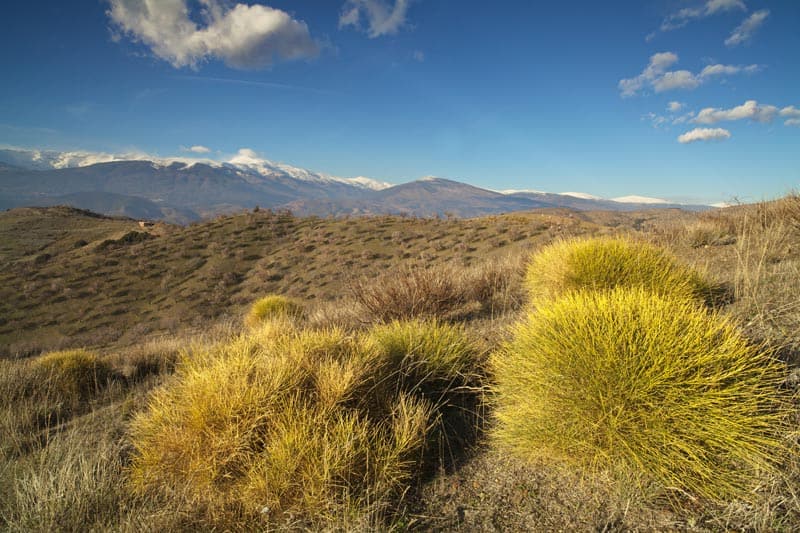
All Andalusia Travel photos by Peter Hendrie if you’d like to photograph Andalusia, check out his upcoming photo tours
Now I lead this tour to Andalusia every February in search of the hectares and hectares of almond blossom in various shades of pink that line the steep-sided hills on the eastern foothills of the snow-capped Sierras Nevada mountain range.
There’s plenty more to enjoy about Andalusia.
1. Exploring the Alhambra – Granada
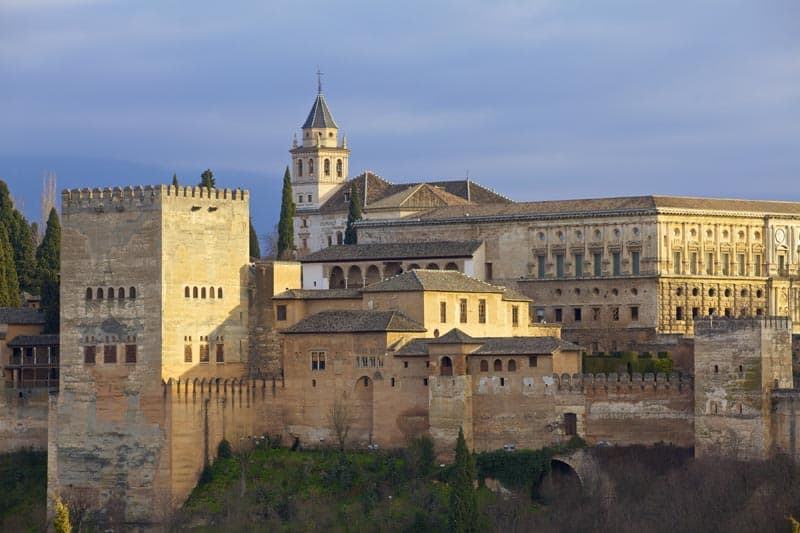
Known around the world, the Alhambra is the jewel in the crown of any visit to Andalusia. With the complete Arabic name as Qalat Al-Hamra, this a palace and fortress complex located in Granada.
A UNESCO World Heritage Site since 1984, it’s easy to understand the draw that this place has on us all.
Considering the palace was built during the middle of the 13th century, its beauty remains remarkably intact. You have to marvel at the buildings’ intricate designs, detailed mosaics and hand-carved cedar panels.
Constructed by the Arabs as a stronghold, the Alhambra sits in a hillside location overlooking the Spanish city of Granada, with unforgettable views of the Sierra Nevada Mountains and the rolling hills of the Andalusian countryside. Read more: 26 Best Things to do in Granada, Spain
2. Witnessing the Almond Blossom
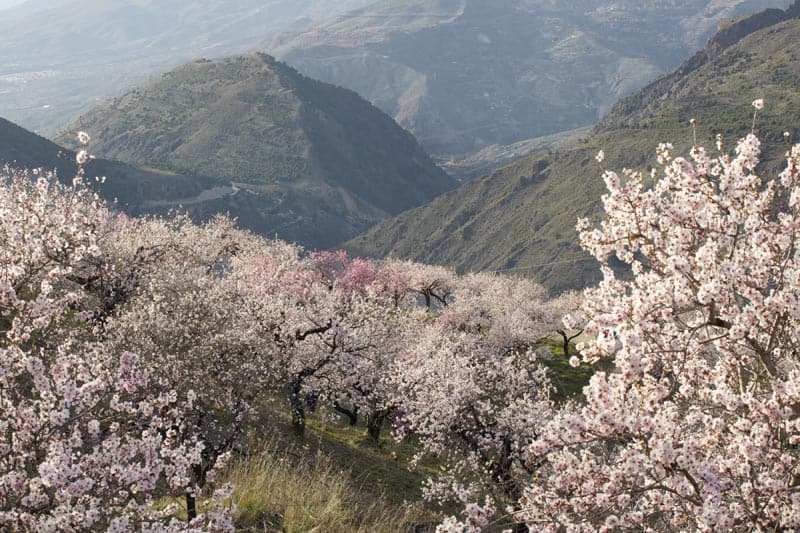
I’ve been lucky enough to visit and photograph some of the most amazing places around the globe, but nothing quite prepares the mind for the sways of shades of white and pink blossom that cascade down the hillside in the foothills of the Sierra Nevada Mountains in the Alpujarras region of Andalusia.
‘Fifty Shades of Pink’ pretty well sum up the feelings you get as you immerse yourself into the curves and crevasses, exploring grove after grove along the width and breadth of Las Alpujarras.
These blossoms offer up some fantastic photographic possibilities.
3. Whitewashed hilltop villages
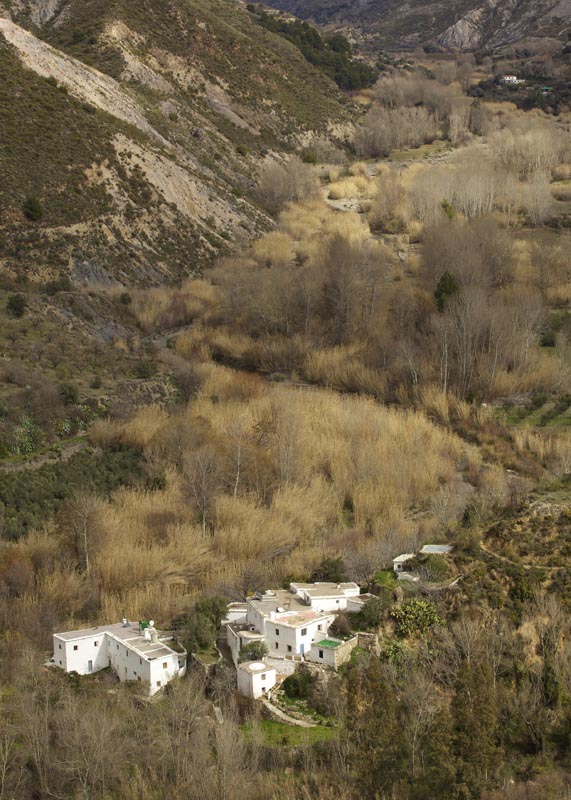
Cast your mind back far enough to the era of the Spaghetti Westerns with those small villages that film directors would have you believe were filmed in the USA.
They were actually often filmed along the Alpujarras and Almeria in the foothills of the Sierra Nevadas, not in Mexico or the States as you would have imagined.
Andalusia in one of the few places in the world where you can find such villages hugging the hillside like limpets to rocks, often perched precariously high up on outcrops.
Perhaps the most picturesque villages are the famous trio of Pampaneira, Bubión and Capileira that cling, one close above the other, to the slopes of the Poqueira Valley.
When the sun’s rays strikes the rooftops of Capileira mid-morning, the village illuminates the valley beneath the high peaks of the Sierra Nevada.
4. High-altitude ham and other top grub
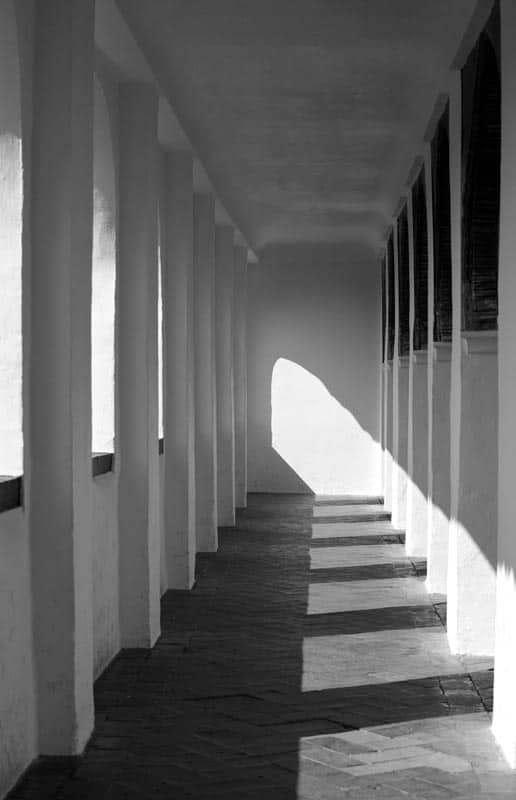
At over 4,840 feet above sea level, Trevélez is the highest village in Europe, overhanging a fast-flowing river and plunging mountain valley with panoramic views across the valley and the sea beyond.
Trevélez is famous throughout Spain for its superb mountain air-cured hams, or Jamón Serrano.
Spain has developed an incredible reputation for food over the years, and you can expect tasty discoveries across Andalusia.
Other notable dishes to try here include gazpacho, Gambas al Ajillo (prawns with garlic and chilli oil) and fried fish, but there are plenty more, alongside wines, notably the wines of Jerez, including sherry. Read more Spanish Food: 17 Spanish Dishes to Try in Spain or at Home
Looking for other places to visit in Spain – Read about Barcelona at Night
5. Peace, quiet and lots of space
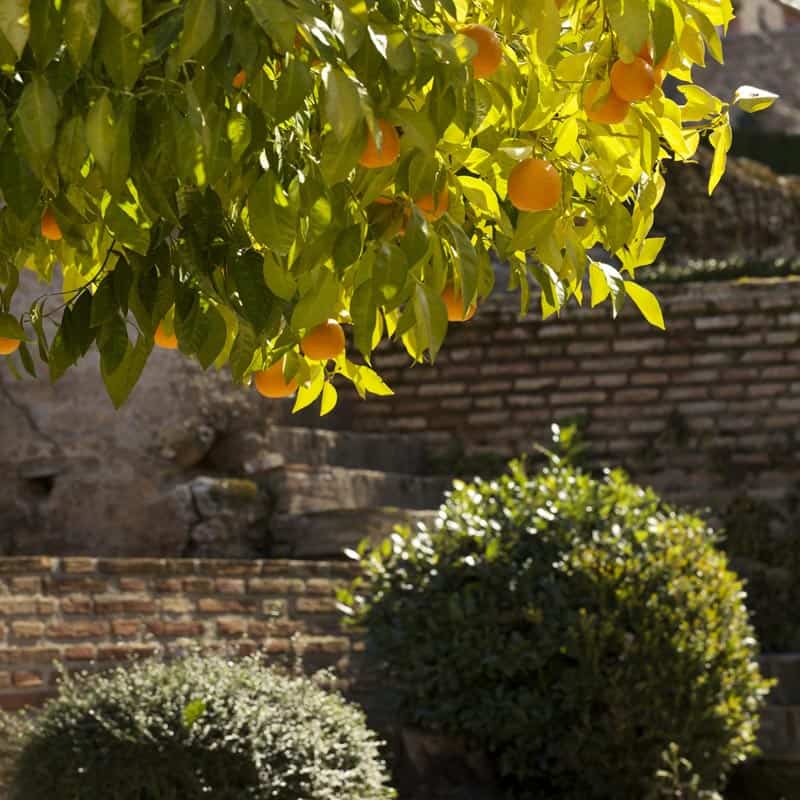
The Bohemian town of Orgiva, the base for Light & Land’s tour, nestles in the fertile valley of the Guadalfeo River.
Orgiva is 20 kilometers from Capileira and is the largest town of Las Alpujarras. This laidback town is a draw for those wanting to escape from the hustle and bustle of modern day life.
It’s truly relaxing to spend time here.
6. Marbella
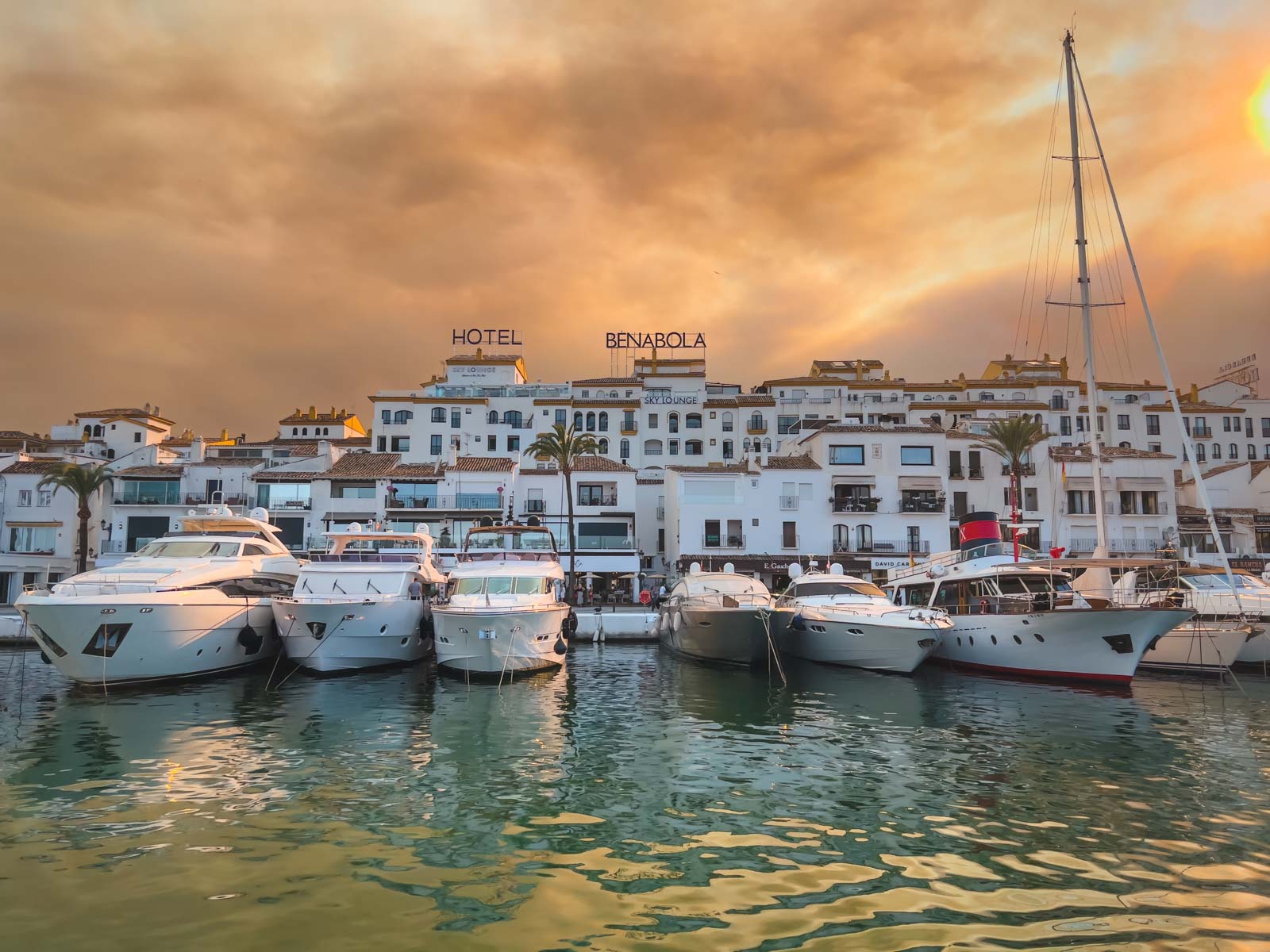
7. National Parks and Villages
There are plenty of other ways to relax in Andalusia’s landscapes. Much of the land across Andalucia is protected as a national park or natural reserve. Large sections of the coast remain unspoilt, with peaceful beaches waiting to be walked on or photographed.
There are also plenty of quiet rural villages where the farming lifestyle appears much the same as it probably has been for decades, if not centuries.
If space, peace and quiet appeal to you, you’ll find plenty of it in Andalusia.
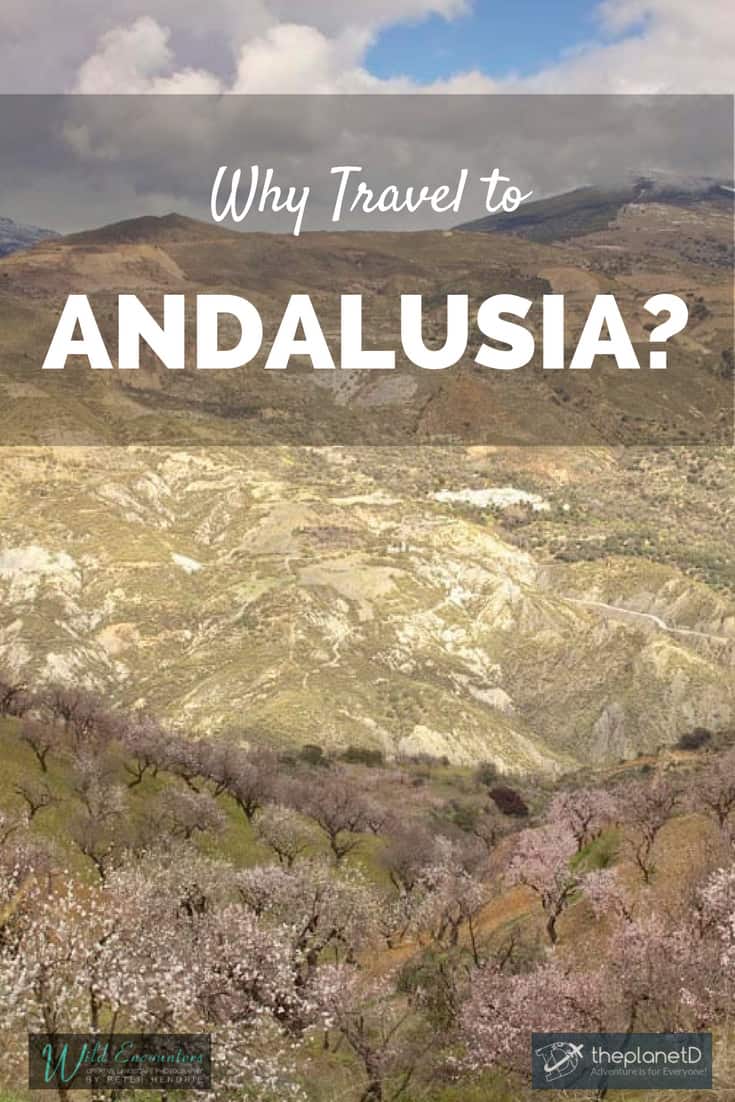
Going to Spain? Read more about these Spanish Cities
- Toledo, Beautiful Spanish History Awaits
- Cuenca and the Casas Colgadas
- 15 Free Things to do in Seville, Spain
- Camping in Spain: Everything You Need to Know
- Via Ferrata, Spain – Take your adventure to New Heights
Read More about another Spanish Cit ies
- A Local’s Guide to What to do in Barcelona at Night
- 26 of the Best Places to Visit in Barcelona
- Where to Stay in Barcelona
- Gaudi in Barcelona – 13 Must-See Architectural Wonders
- The 16 Most Romantic Cities on Earth
Author Bio:
Peter Hendrie leads Andalusia travel photography tours every February and shares his reasons for why you should visit Andalusia and fall in love with this magical Southern region of Spain .
Peter Hendrie will be guiding an “Almond Blossom and Architecture of Andalucia” photography workshop in Andalucia from Feb 09-13, 2018. For details, see Light and Land Photography Tours
Later in the year, he’ll be leading workshops in Exmoor, including Astrophotography and Coasts & Rivers. See More at Peter Hendrie Tours For more on Peter’s photography, see his gallery at PenterHendriePhotography.com
Travel Planning Resources
Looking to book your next trip? Why not use these resources that are tried and tested by yours truly.
Book Your Flights: Start planning your trip by finding the best flight deals on Skyscanner. We have used them for years and have found that they have the best flight deals.
Book your Hotel: Find the best prices on hotels with these two providers. If you are located in Europe use Booking.com and if you are anywhere else use TripAdvisor.
Find Apartment Rentals: You will find the cheapest prices on apartment rentals with VRBO .
Travel Insurance: Don't leave home without it. Here is what we recommend:
- Safety Wing - Occasional Travelers.
- Medjet - Global air medical transport and travel security.
Book Your Activities: Looking for walking tours, skip-the-line tickets, private guides, and more? Then we recommend Get Your Guide.
Need more help planning your trip? Make sure to check out our Resources Page where we highlight all the great companies that we trust when we are traveling.
You May Also Like
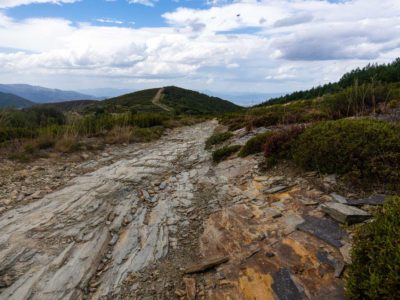
8 Life Lessons from the Camino de Santiago
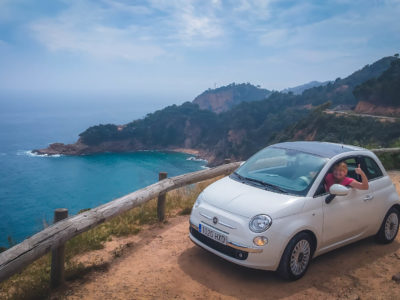
Your Essential Guide: How to Rent a Car in Spain with Confidence
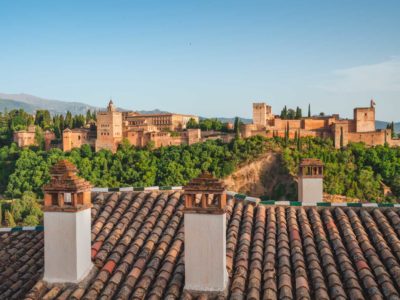
The Ultimate Guide to Visiting the Alhambra: Tips, Tricks and Must-Sees
About The Planet D
Dave Bouskill and Debra Corbeil are the owners and founders of The Planet D. After traveling to 115 countries, on all 7 continents over the past 13 years they have become one of the foremost experts in travel. Being recognized as top travel bloggers and influencers by the likes of Forbes Magazine , the Society of American Travel Writers and USA Today has allowed them to become leaders in their field.
Join thousands of others who get our monthly updates!
Leave a comment cancel reply.
Save my name, email, and website in this browser for the next time I comment.
16 thoughts on “Beautiful Things to do in Andalusia, Spain”
Great post, am really excited as we’ve got an upcoming visit in June and the Alhambra is definitely top of the list! Very intrigued by the Almond Blossoms too, never knew about that!
Hey..your blog is very amazing, I love to visit everyday..
Andalusia is an incredible place to discover on Iberian Peninsula. It boasts finest Islamic style of architecture, your post is informative throws light on new areas. Genuinely helpful for everyone.
This is not the first of your posts I’ve read, and you never cease to amaze me. Thank you, and I look forward to reading more.
Love the article, Spain is a beautiful country – the people and the landscapes. Nice photographs. I try to visit Spain @ least once a year to explore the country. Keep up the good work and articles
Resourceful article and pictures are really wonderful, thanks for sharing the most intriguing experience. Al Hambra is the fantastic place to explore. I have great interest in historical places. I may visit Andalusia this year.
Andalusia is absolutely fabulous! Excellent pictures. Thank you so much for sharing it.
It is greate places as I like the see in photos. I wish to be there 🙂
Wow! What an explanation about Andalusia. Keep it up, Peter!
I just loved your pictures of andalusia thanks for sharing the article
I loved the article since I started my blog focusing mainly on travel, I drop by your blog almost every day. Your post gave me opportunity to look back on my stay in overseas for working and studying.Thank you for writing this. One of my favorite posts since I started following
Great place! Dream place! Thank you for those beautiful images and tips!
Andalusia is absolutely fabulous!! All great places to go! Looking awesome photos in your post! Thank you so much for sharing this great information..
I loved ANdalisia! So different, relaxed, delicious food! IF i meet some spanish guy I want to live there 😛
Amazing photos, very good photos, useful information. I have never been in Spain. Now it is on my list. Thanks for sharing!
this is extremely beautiful and amazing thanks for sharing the article
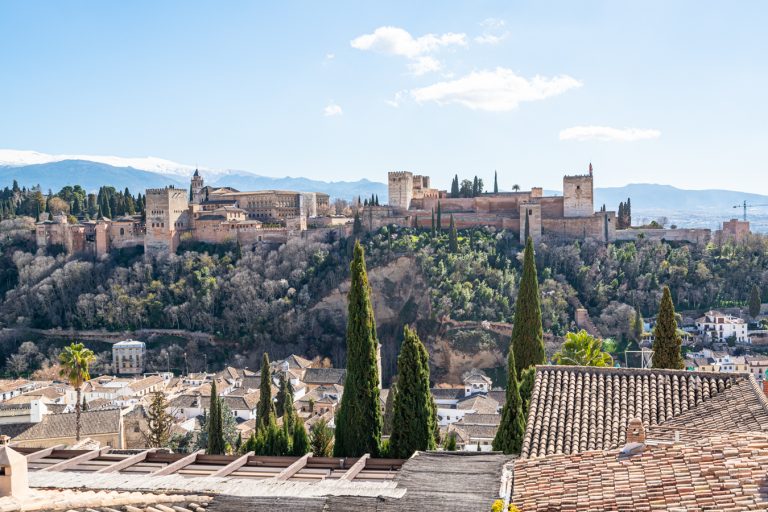
The Ultimate Andalucia Road Trip (Detailed Southern Spain Itinerary!)
Winding streets through whitewashed villages, the clink of tinto verano glasses scraping against tapas plates, sweeping views across gorges, endless sour orange trees, and 700-year-old palaces: these are just a few of the incredible things that you’ll find on an Andalucia road trip.
As Spain’s southernmost region, there are a downright overwhelming number of places to visit in Andalucia, ranging from whitewashed hilltop towns (pueblos blancos) to Mediterranean beaches to snowcapped mountains, and everything in between!
Planning a southern Spain itinerary can be tricky, if for no other reason than that it’s hard to narrow down exactly where to go.
After two long trips spent falling in love with the south of Spain, we’ve put together this road trip itinerary for Andalucia in the hopes that you come away loving it as much as we do (and avoid some mistakes that we learned the hard way).
If you’re ready to soak up the magic of Andalucia, this southern Spain road trip itinerary is for you!
Table of Contents
How We Structured This Southern Spain Itinerary
Renting a car for your andalucia road trip, can this andalucia itinerary work without a car, the ultimate southern spain road trip itinerary, other destinations to add to your andalucia itinerary, the best time to road trip andalucia, what to pack for a road trip in southern spain, andalucia road trip itinerary map.
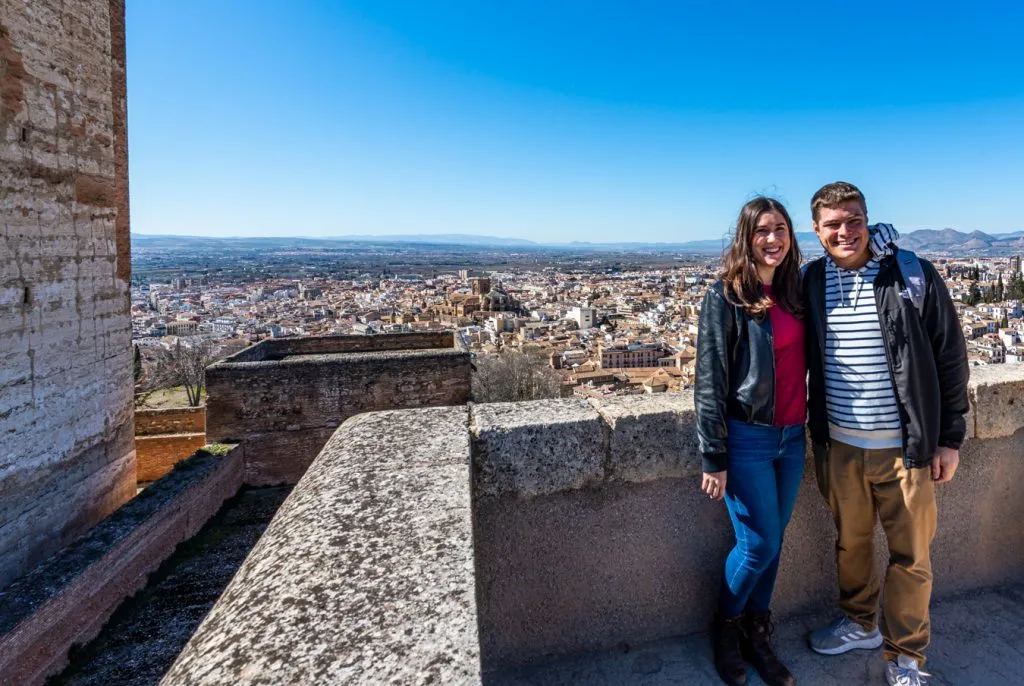
Some links in this post may be affiliate links. If you make a purchase through one of these links, we may earn a small commission at no extra cost to you. Please see our disclosure policy for more detail.
With a region as large and diverse as Andalucia, narrowing down the best places to visit on a 10 day southern Spain road trip is quite the challenge!
We structured this Andalucia road trip as a loop beginning and ending in Seville, home to one of the largest airports in the region.
Since it’s a loop, you can easily reverse this itinerary if you wish, or start in a different city (such as Malaga).
We designed this southern Spain itinerary around visiting whitewashed villages, historic cities, and stunning landscapes.
It’s a fairly fast-paced itinerary in the sense that it packs a lot in and involves visiting many beautiful towns, but to drive this route straight through without traffic would actually take less than 10 hours.
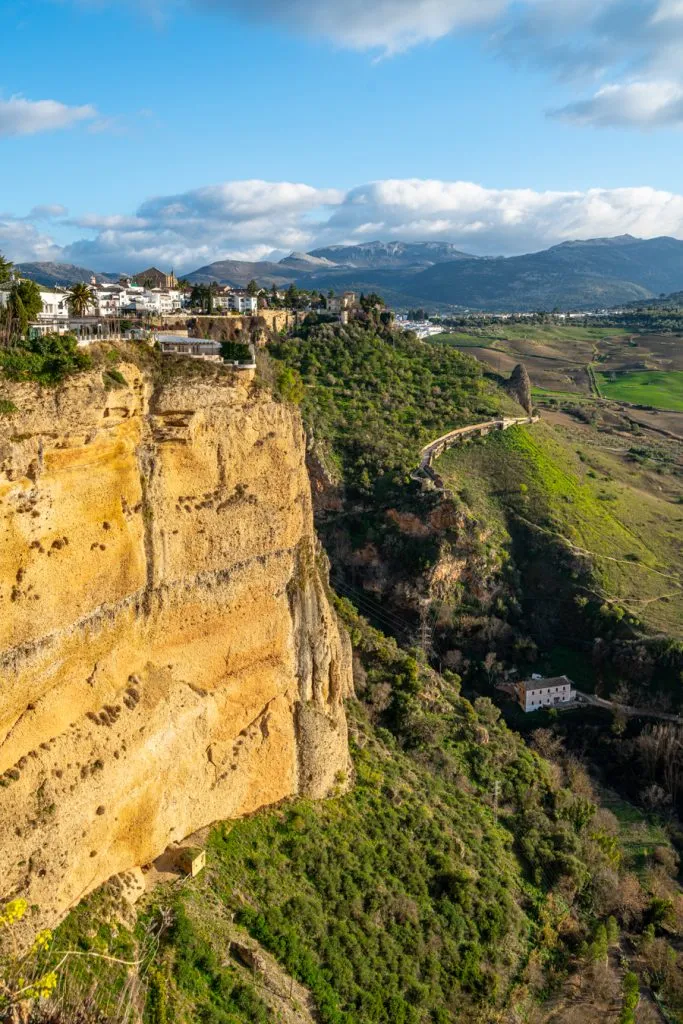
You’ll drive a bit more than that, counting day trips and such, but the bottom line is that it’s a very doable distance in 10 days!
We don’t dedicate much time to the famous Costa del Sol on this travel guide, as this is more of an enjoy-all-the-attractions itinerary rather than a relax-on-the-beach itinerary, but we do include a bit of time to soak up views by the Mediterranean as well.
In addition to the detailed 10 day southern Spain itinerary we’ve outlined here, we’ve also made notes of more incredible places to visit in Andalucia that you can add or swap in, depending on your travel style.
This guide to road tripping Andalucia is quite long, so feel free to use the table of contents above this section to navigate to the most important parts for you if you wish!
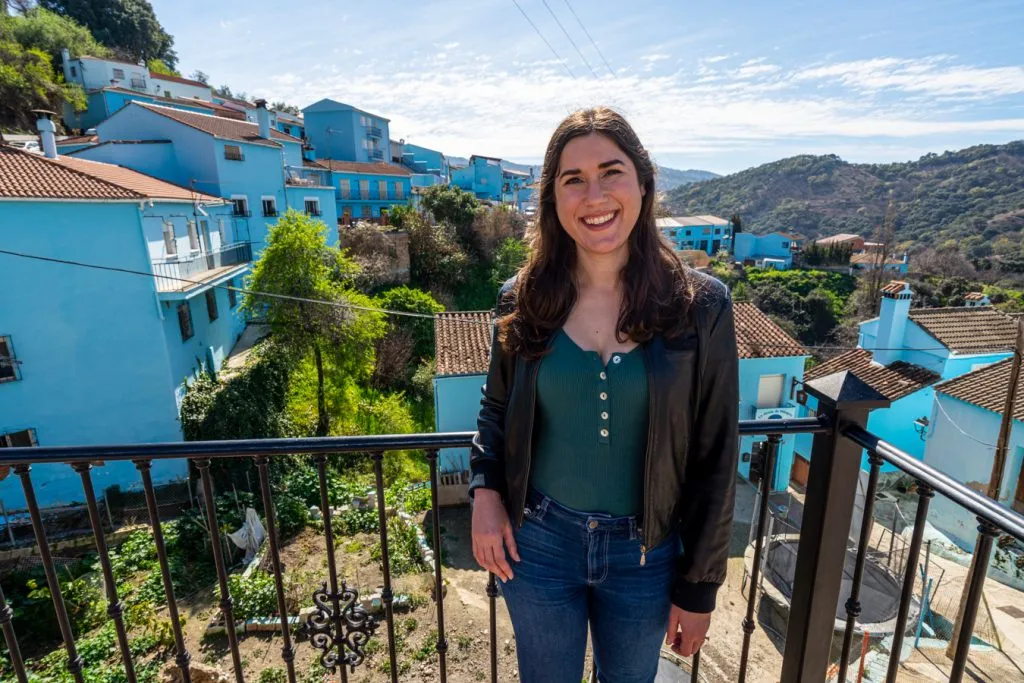
For most people, of course, taking an Andalucia road trip will require renting a car
We recommend renting a small car through Discover Cars , which will allow you to compare the prices and inclusions of multiple companies at the same time and choose the best car for you from there.
For the purposes of this southern Spain itinerary, we recommend picking up a car the morning you leave Seville.
There’s no reason to pick one up for your time in the city, as parking it will be a hassle and you won’t need it for exploring Seville.
Check rates and book your rental car today!
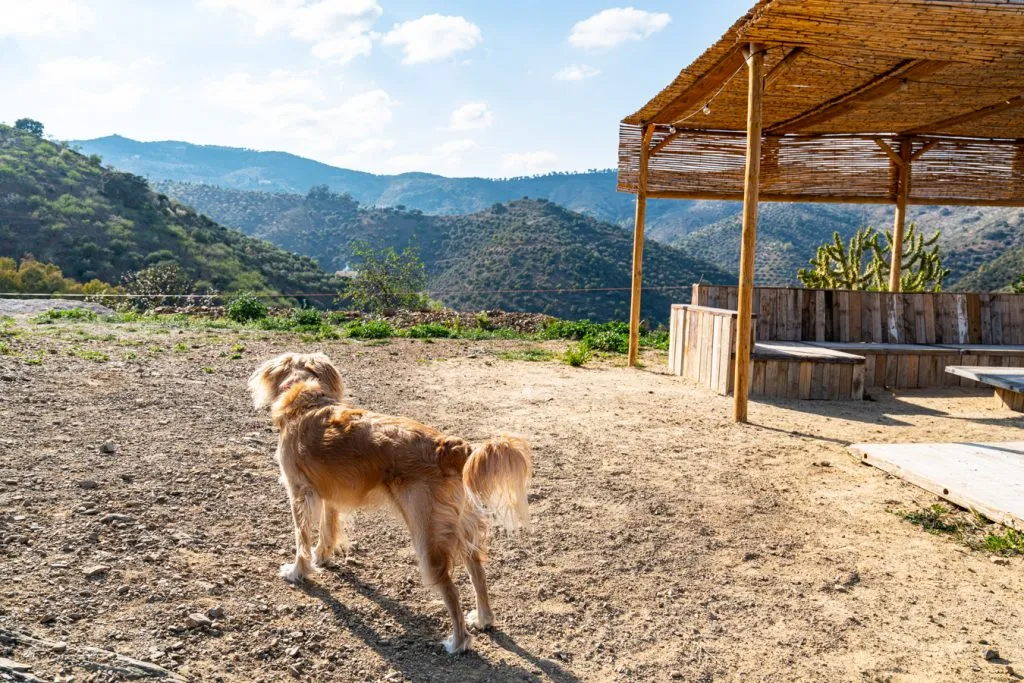
This southern Spain itinerary is specifically designed as a road trip, and we do strongly believe that driving is the best way to visit Andalucia!
From offbeat villages to charming hikes to out-of-the-way beaches, your trip to Andalucia will absolutely be enhanced by having your own set of wheels.
That being said, if you can’t or would rather not drive, you can still cover the vast majority of the sights included on this Andalucia road trip itinerary through a combination of public transportation and guided tours.
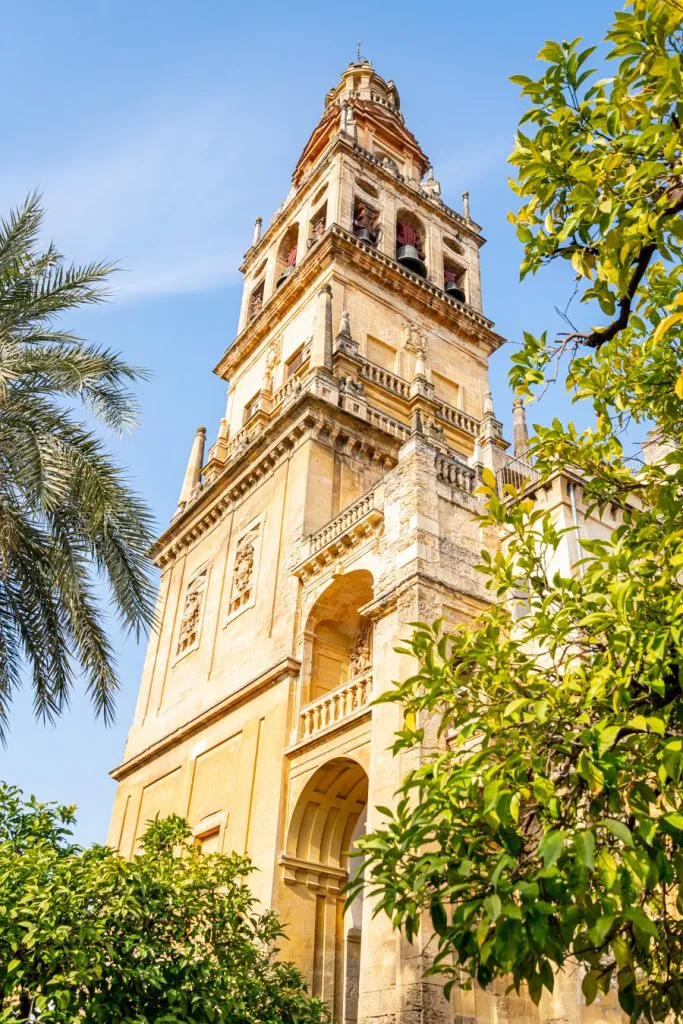
If you’re not planning to drive, we recommend basing yourself in larger cities like Seville, Granada, and Malaga, and taking day trips (independently, guided, or a combination of both) from there.
As much as we love Ronda, we wouldn’t recommend spending more than perhaps one night there without a car.
If you want to structure your itinerary for southern Spain without a car, we highly recommend using Omio to check exact ticket schedules and pricing for trains and buses in Andalucia!
Check schedules and shop train and bus tickets in Andalucia today!
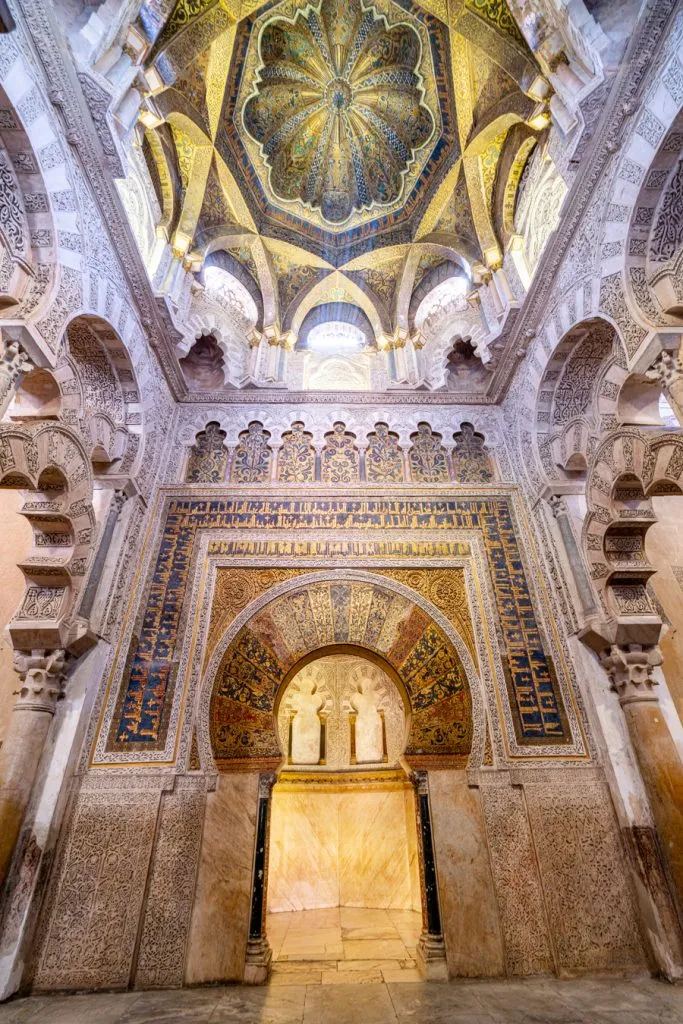
Day 1: Arrive in Seville and start exploring.
Starting your southern Spain travels in Seville means diving right into the heart of Andalucian culture!
Depending on what time your plane lands, kick off your Andalucia vacation with a visit to the Seville Cathedral–once the biggest church in the world–and a climb up its bell tower.
The Giralda (bell tower) not only includes a beautiful view but is part of Andalucian history.
Before the Reconquista (when Christian powers overtook the Moorish kingdom that once ruled this area), this bell tower was the minaret of a mosque on the same site.
When the sun starts to set, head out for tapas and tinto verano (similar to sangria, but less elaborate and beloved by locals).
We don’t recommend picking up your rental car until day 3 of this itinerary–you won’t need it when exploring the heart of Seville.
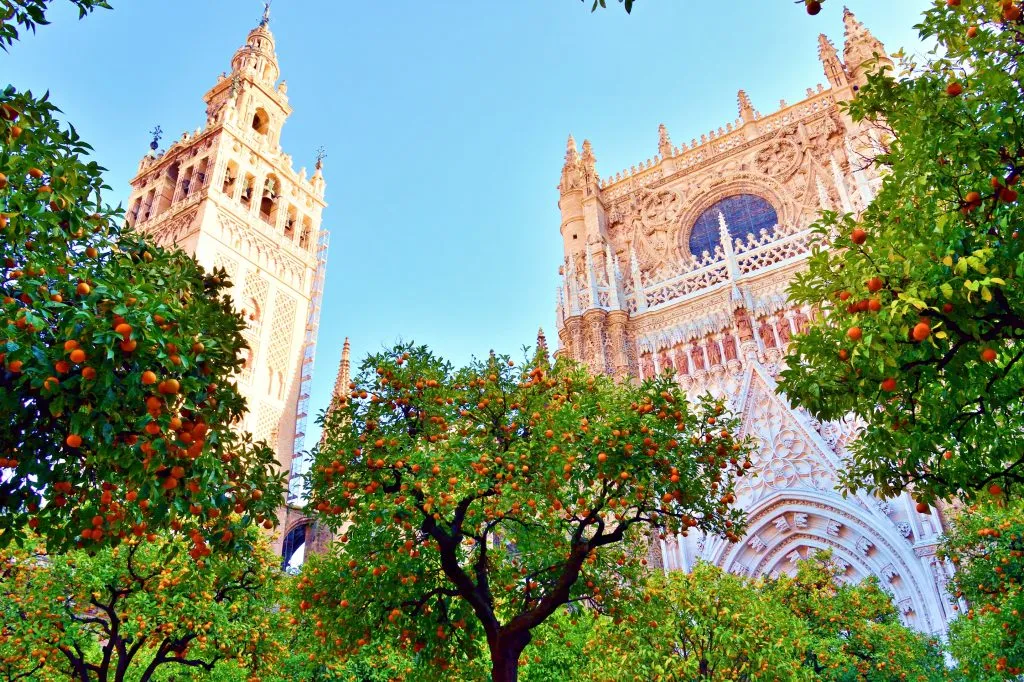
Where to Stay in Seville, Spain
When deciding where to stay in Seville, location is key as ideally, you’ll want to stay within walking distance of Seville’s best attractions.
We had a fantastic experience at Petit Palace Puerta de Triana on our most recent trip to Seville.
The hotel has a fantastic location (central but also quiet–a far from guaranteed combination in Spain), a delicious breakfast, and comfortable rooms.
Looking for something a bit different?
The incredibly popular Hotel Rey Alfonso X is an excellent choice, and their rooftop views are sublime!
If you’d like to stick to more of a budget, Hotel America Sevilla gets wonderful reviews and doesn’t sacrifice too much in terms of location.
Meanwhile, for the height of luxury, you can’t beat the absolutely stunning Hotel Alfonso XIII !
Check rates & book your stay in Seville today!
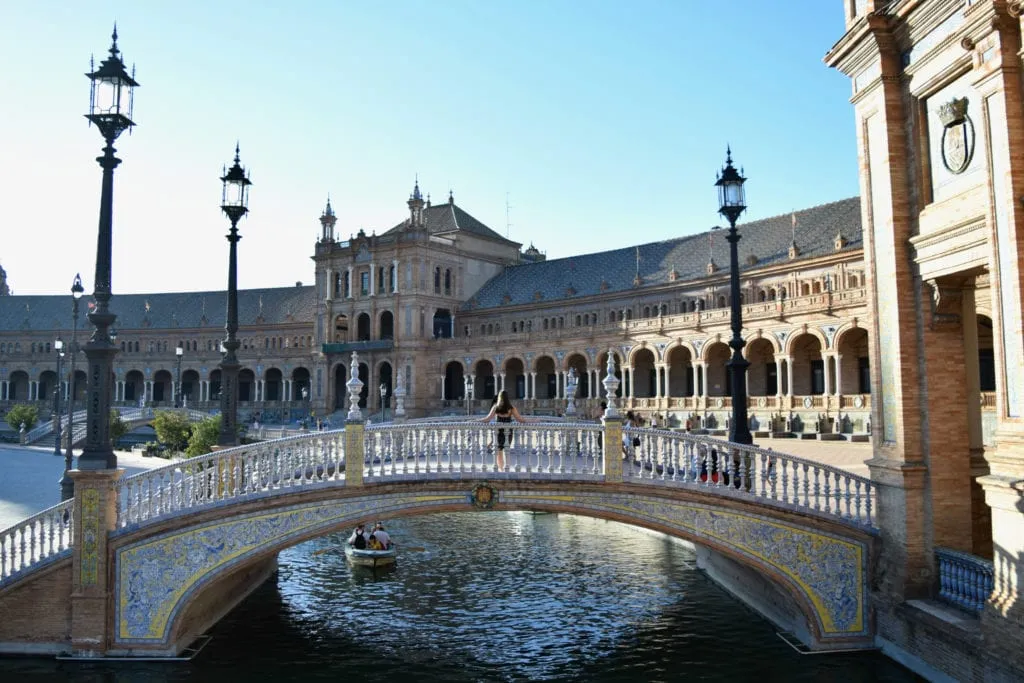
Day 2: Dive into Andalucian culture and history in Seville.
Today, it’s time to explore the rest of the major attractions in Seville!
Be sure to visit the famous Plaza de Espana, wander through the picturesque Barrio Santa Cruz (the former Jewish Quarter), and potentially see a Flamenco show .
Touring the gorgeous Alcazar is also a must: parts of this unique palace were built in the Moorish style, by Islamic craftsmen, for Christian rulers.
The result is a unique and beautiful combination of cultures that brings together several aspects of Andalucian history.
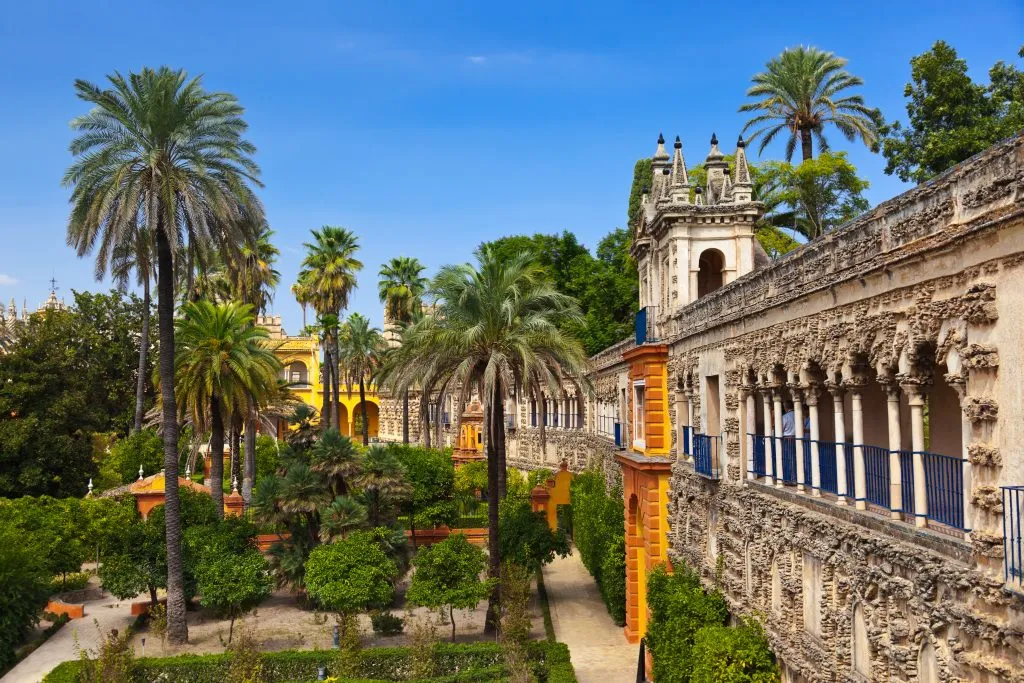
If you’re interested in experiencing more modern architecture in Seville, the famous Metropol Parasol is a fun spot with great views.
For foodies, we highly recommend taking a food tour in Seville on the first full day of your trip: not only is it incredibly fun, but it will help you know exactly what to order during the rest of your southern Spain itinerary!
And, if you’d like to explore the history of bullfighting in Spain, the Plaza de Toros is one of the most famous bullfighting rings in the world and can be toured (for obvious reasons, we do not recommend attending a fight).

Day 3: Explore Cordoba.
Today, pick up your rental car and hit the road to Cordoba!
Lying about 1 hour, 45 minutes northeast of Seville, Cordoba is famous for its incredible Mosque-Cathedral , which is exactly what it sounds like–a cathedral built literally inside a former Moorish mosque.
It’s one of the most unique houses of worship we’ve ever set foot in, and it alone would be worth visiting Cordoba for!
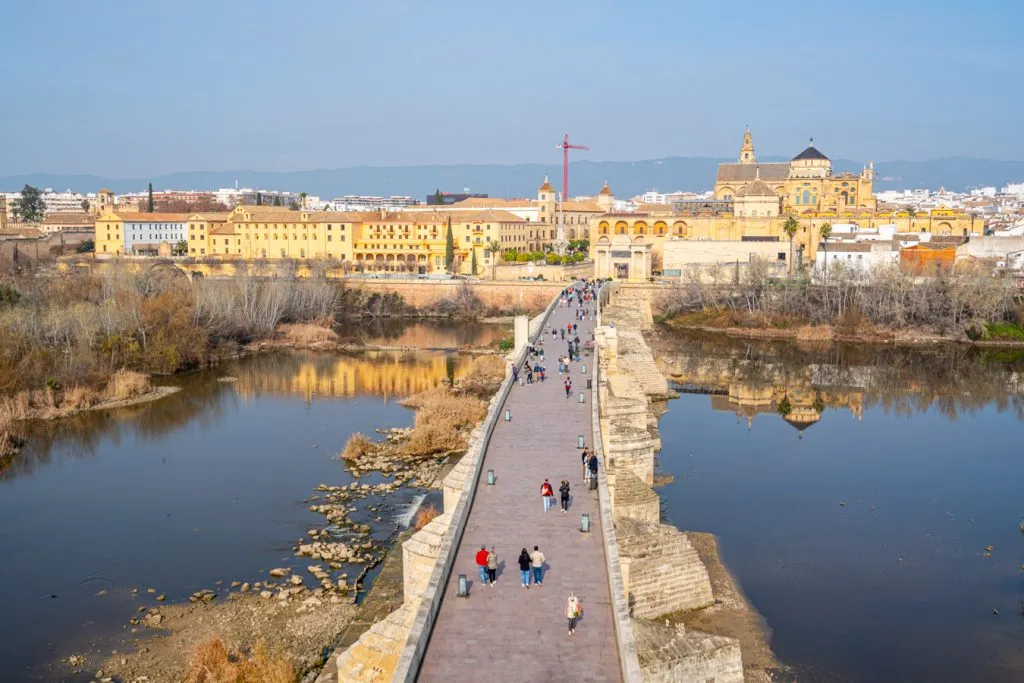
While Cordoba’s history dates back to the Romans (and you can stroll across the aptly named Roman Bridge while there), its Moorish period is responsible for much of the city’s stunning architecture and fame.
Cordoba peaked in the 10th century, when it was, for a brief moment, the biggest and one of the most powerful cities in the world.
In addition to the Mosque-Cathedral, be sure to explore Cordoba’s many flower-filled patios, check out the Alcazar of the Christian Monarchs, and visit the winding streets of the Jewish Quarter during your day in Cordoba.
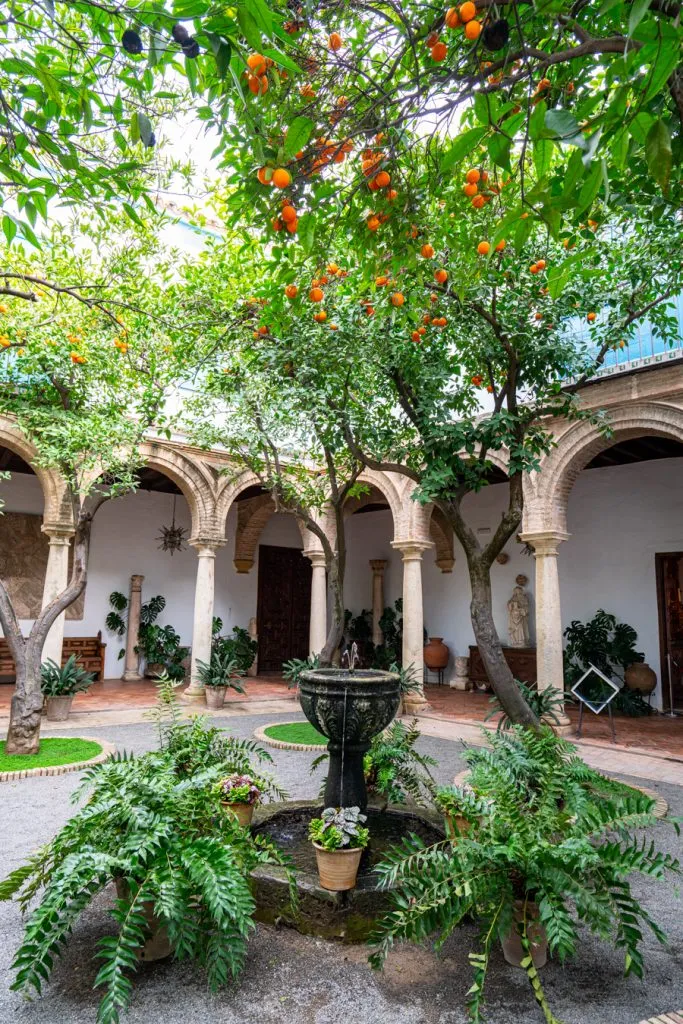
Where to Stay in Cordoba, Spain
We loved our stay at Hesperia Cordoba !
Set just over the river from Cordoba’s historic center and a very short walk from the Roman Bridge, Hesperia Cordoba features spacious rooms, excellent customer service, and a rooftop with one of the best views in the city.
For those traveling Andalucia on a budget, Cordoba Carpe Diem is a great option in the heart of the city.
And, if you’re looking to stay in a hotel so luxurious that it’s practically a museum, the popular Hospes Palacio del Bailio is the clear winner (it even features actual Roman ruins!).
Check rates & book your stay in Cordoba!
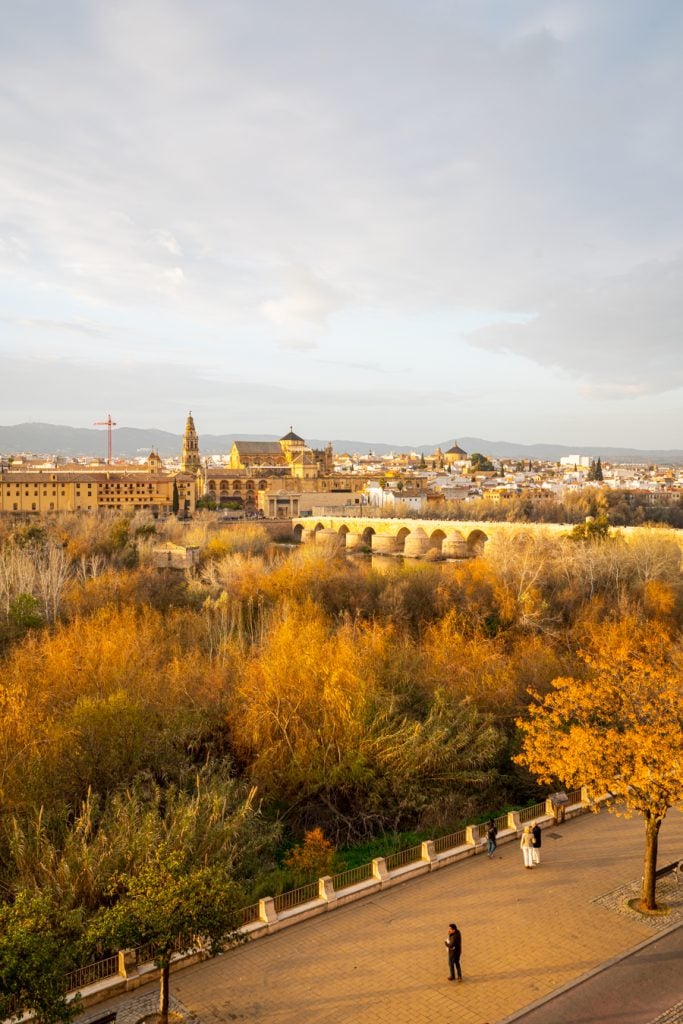
Day 4: Make your way to Granada.
Winding roads, stunning hilltop towns, and olive trees as far as the eye can see: these are the views that you’ll enjoy when driving from Cordoba to Granada on your Andalucia road trip!
If you’d like to add an extra stop or two to your morning, the Medina Azahara (a UNESCO World Heritage recognized archaeological site) and the Castle of Almodovar del Rio (a magnificent castle dating to 760 that was a Game of Thrones filming location) are both excellent options.
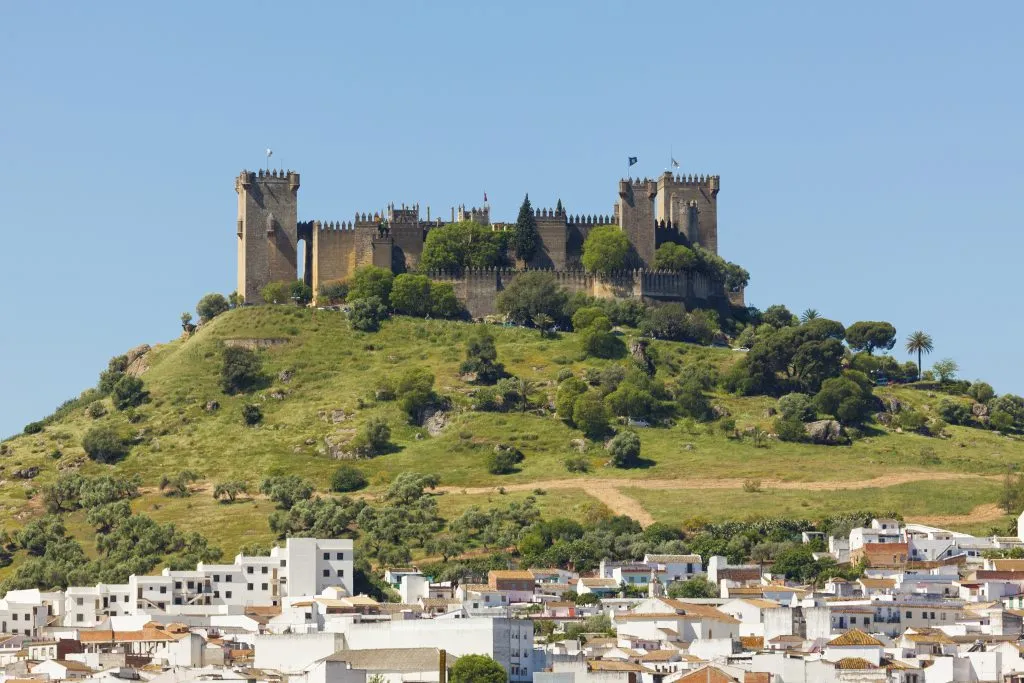
Both places are a bit out of the way, but as the drive between Cordoba and Granada is only about 2.5 hours long, you’ll have plenty of time if you’d like to stop.
Once you get to Granada, settle in and start sightseeing!
Depending on what time you get in, we recommend exploring the picturesque Albayzin (Arab Quarter), climbing up to the Mirador San Nicholas (it’s worth every step!), and enjoying plenty of tapas.
If you have time, consider heading up to Sacromonte to visit the interesting cave museum and to attend an an intimate flamenco show –the neighborhood is famous for them!
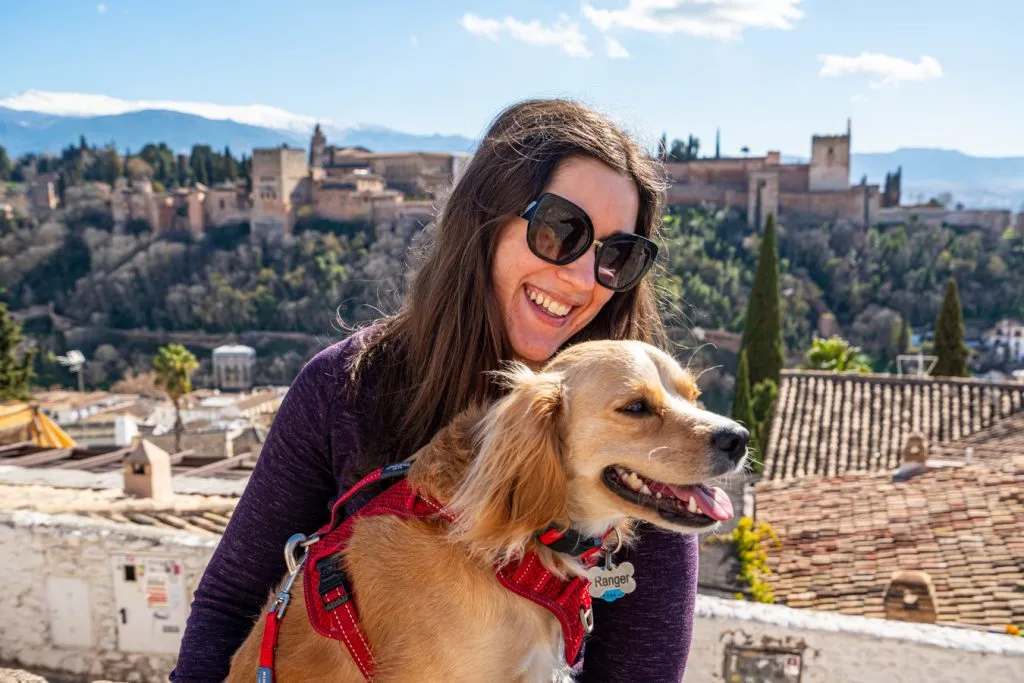
Where to Stay in Granada, Spain
We rented an apartment from Mosaiko Homes in Granada, and could not have had a better experience: the owner was responsive, the apartment fantastic, and the location unbeatable!
Mosaiko Homes is located on a quiet street a short walk from many of Granada’s top sights, offering the combination of a convenient location and a lack of noise at night–two things that can be difficult to find together in Andalucia!
Another excellent option with near-perfect reviews is the incredibly unique Casa de Reyes (that decor!).
For a bit of luxury, the popular Shine Albayzin is not only housed in a 16th-century palace, it overlooks the Alhambra !
Generally speaking, lodging in Granada is much more affordable than in, say, Seville or the resort towns of the Costa del Sol.
If you’re going to splurge on a luxury property during your 10 day southern Spain itinerary, Granada is a fantastic place to do so!
Check rates & book your stay in Granada!
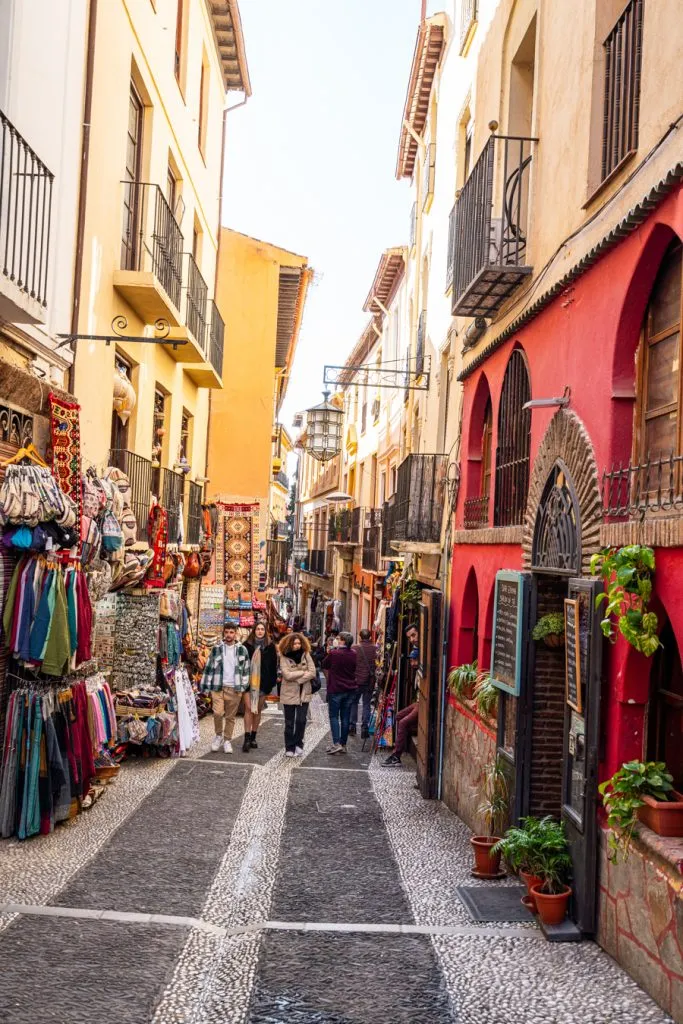
Day 5: Discover the Alhambra and other Granada gems.
On the fifth day of your road trip in Andalucia, it’s time to visit the region’s top attraction: the Alhambra!
While the Alhambra is most famous for its stunning Nasrid Palaces built by the Moors, there is an overwhelming amount of things to see at this iconic fortress.
From Generalife and its gardens (a summer retreat for the Nasrid dynasty) to the Alcazaba (the oldest portion of the fortress, which dates to the 1200s) and beyond, there are many sides to the Alhambra to visit.
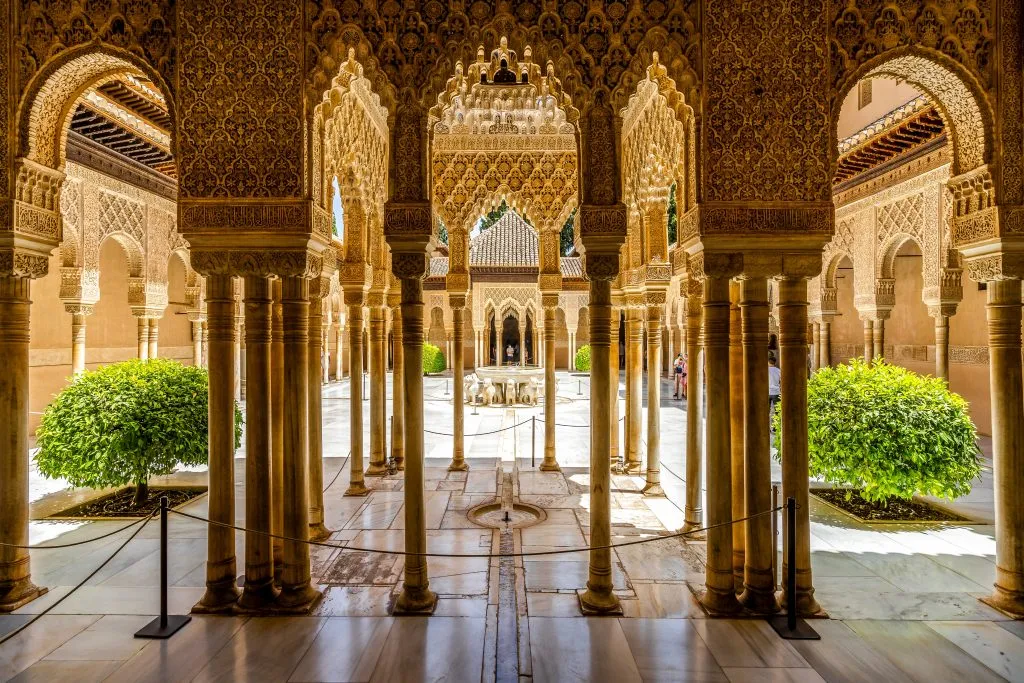
General tickets to the Alhambra are competitive and often sell out far in advance (you can check available dates here ), but luckily, organized tours and skip-the-line tickets (which are only slightly more expensive than general tickets) are very easy to come by.
Deciding whether to take a tour of the Alhambra or simply use an audio guide is a personal choice, and both have pros and cons.
We took this popular tour , and while we got frustrated with how much it dragged in certain places, we loved having the context of a live guide–especially in the Nasrid Palaces.
We also loved not having to manage the tightly controlled timed entry system for the Nasrid Palaces ourselves.
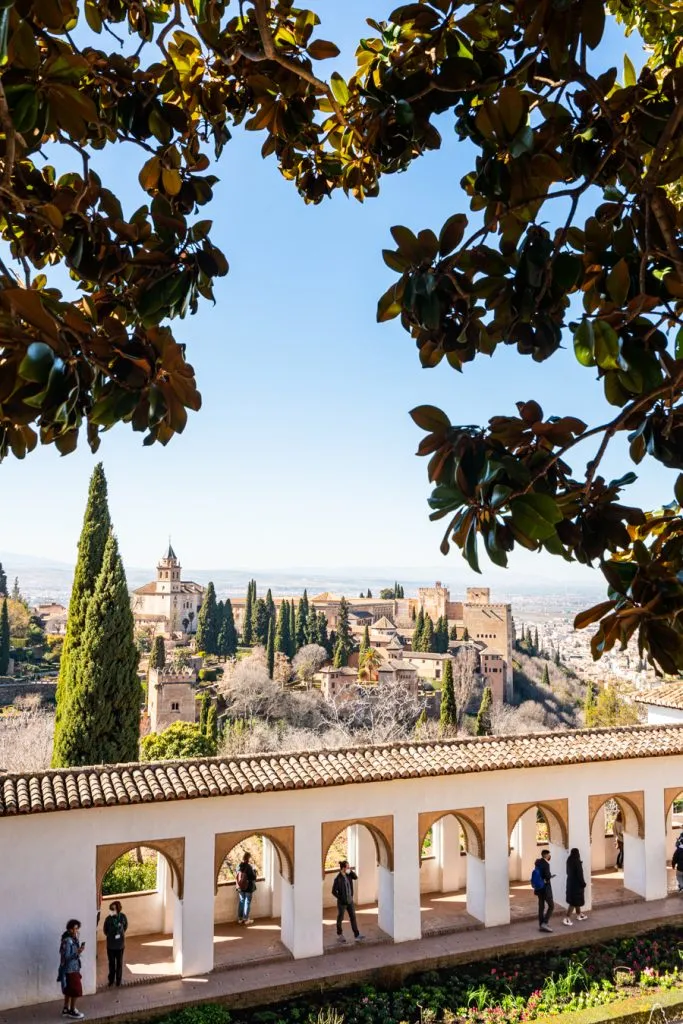
Keep in mind that not all Alhambra tickets include entry to the Nasrid Palaces.
Make sure that your ticket does, though, because they are truly the star of the show!
You will likely be exhausted after visiting the Alhambra, which makes this afternoon the perfect time to visit one of Andalucia’s gorgeous hammams.
Hammam Al Andalus is well-known, gorgeous, and accessible to English speakers. We loved our time there!
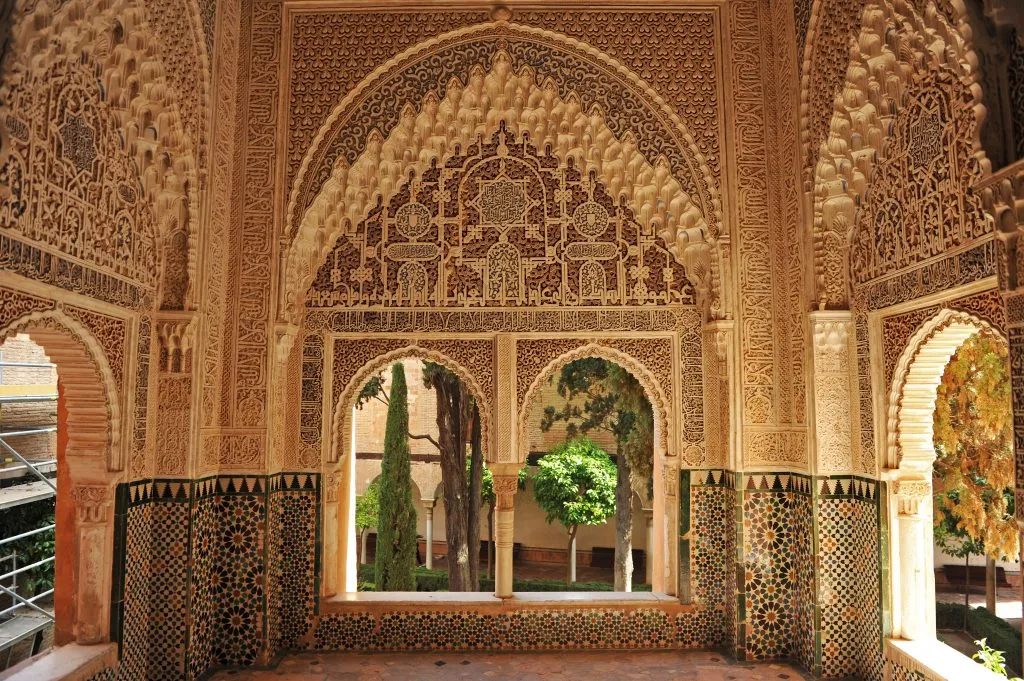
Day 6: Take the scenic route to Malaga (or nearby).
Today, start your morning by enjoying any sightseeing you haven’t had a chance to enjoy in Granada, such as visiting the stunning Granada Cathedral and Royal Crypt.
Depending on what time you get started in the morning and how much time you want to spend on the beach, you can also consider heading 20 minutes outside of Granada to enjoy the popular hanging bridges at Los Cahorros Gorge in Monachil.
From there, it’s time to make your way to the Costa del Sol: no southern Spain itinerary would be complete without soaking up some sun!
We recommend heading toward Malaga via the A-44 to A-7 route–it’s slightly longer than going the A-92 route, but you can’t beat the views driving along the Mediterranean for half the drive!
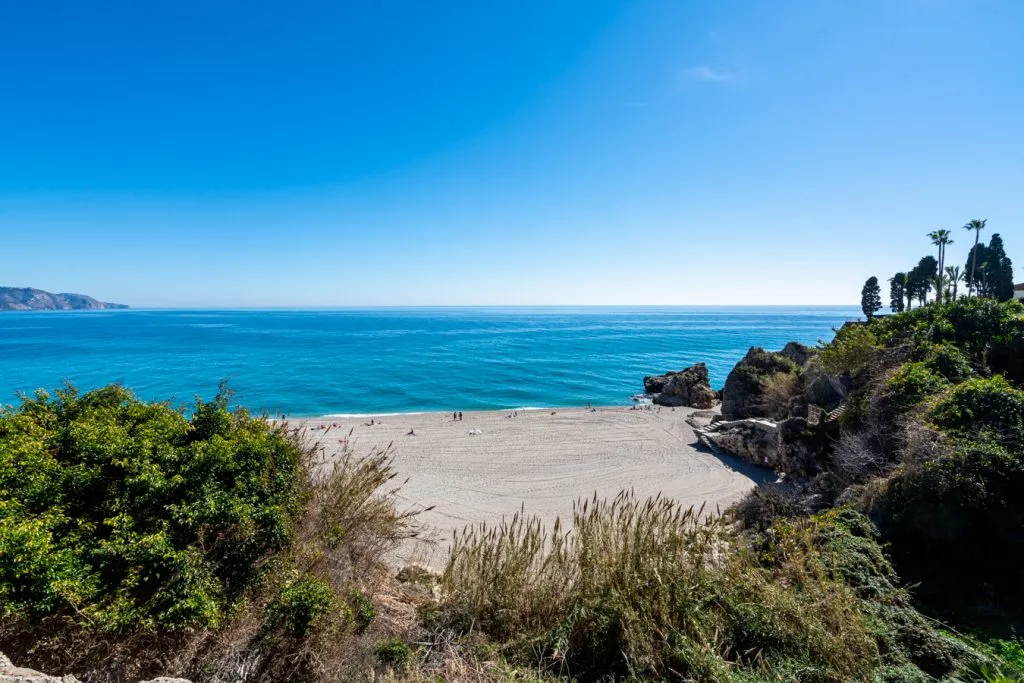
Day 7: Soak up the sun on the Costa del Sol.
There is an endless number of options when it comes to deciding what town to stay in on the Costa del Sol!
Malaga, the biggest city in the region, is perfect for those who want to potentially take an afternoon road trip to a nearby beach but want to dedicate most of their time to culture.
The best things to do in Malaga include visiting the celebrated Picasso Museum, Alcazaba , Roman Theatre, Cathedral, and beyond, which make for a compelling, but not beachy, trip.
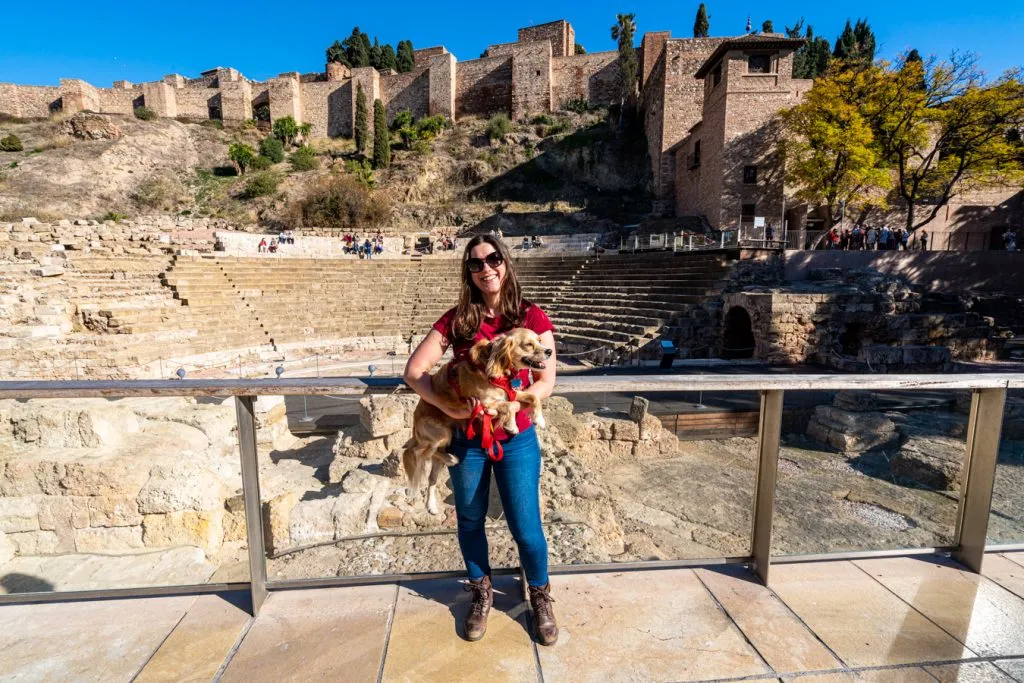
If you’re looking for idyllic beaches, Nerja is the place to go (that’s where the above photo was snapped!).
A beautiful resort town with a promenade?
Estepona might be right for you.
No matter where you end up staying, make sure that you spend at least part of the day admiring views of the Mediterranean with a gelato or glass of tinto verano (or both) in hand.
Since you’re visiting via a Costa del Sol road trip, you can also easily stay in one town and squeeze in a quick afternoon visit to another!
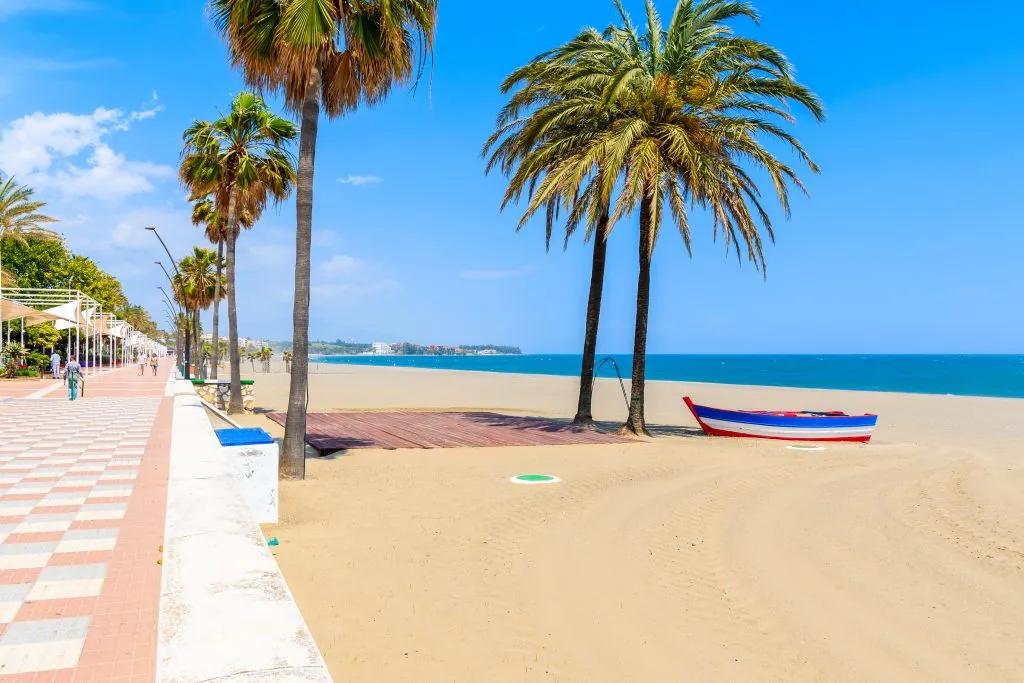
Day 8: Continue your Andalucia road trip and head to Ronda.
Last but certainly not least, say goodbye to the Costa del Sol and head north again to Ronda , one of our absolute favorite places in Spain.
Situated on a ridge, Ronda features sweeping views, a gorge, an 18th-century bridge that is earnestly referred to as the “New Bridge”, ties to the Lost Generation, and idyllic whitewashed streets–and that’s without even leaving the town center.
Much smaller than Seville or Granada, Ronda is nonetheless well worth savoring.
Once you arrive, start by exploring a few of the best things to do in Ronda, such as visiting the Cuenca Gardens, marveling at Puerto Nuevo (and Puerto Viejo and the Arab Bridge, while you’re at it), and visiting the historic Arab Baths (now a museum, though there is also a functioning hammam in Ronda!).
For sunset, there is absolutely no better place to be than admiring the views of Puerto Nuevo and the surrounding landscape from the Alameda del Tejo!
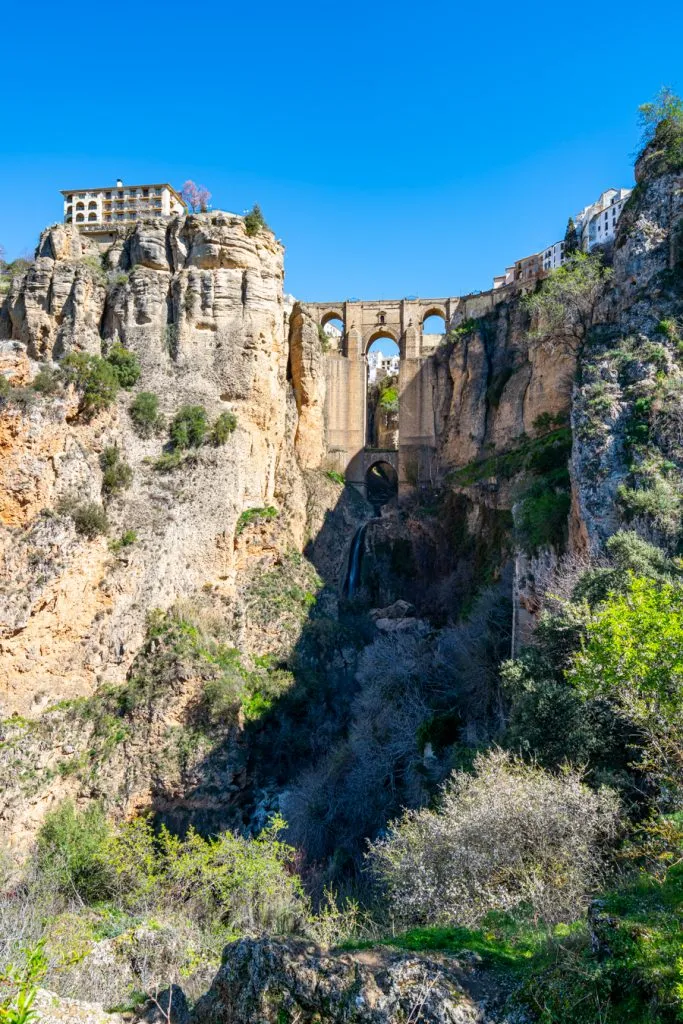
Where to Stay in Ronda, Spain
We can’t rave about our stay at Catalonia Reina Victoria in Ronda enough–it may just be one of our favorite hotels we’ve ever stayed in!
Unbeatable views over the countryside (we upgraded to a terrace room, which was absolutely worth it), excellent customer service, comfortable rooms, easy parking on site, and walking distance to all the best things to do in Ronda–it’s hard to beat that!
The popular Hotel Montelirio , with views of the Puerto Nuevo, is also a great option.
However, as Ronda is the last stop on your Andalucia road trip and finding parking in the city center is fairly simple, you may want to go the complete opposite route and stay in a country hotel just outside of town!
The beautiful and well-reviewed Hotel Cortijo Las Piletas is located a 15-minute drive from Ronda, offers a pool, gorgeous views, and a bit of peace and quiet to end your trip with.
Check rates & book your stay in Ronda today!
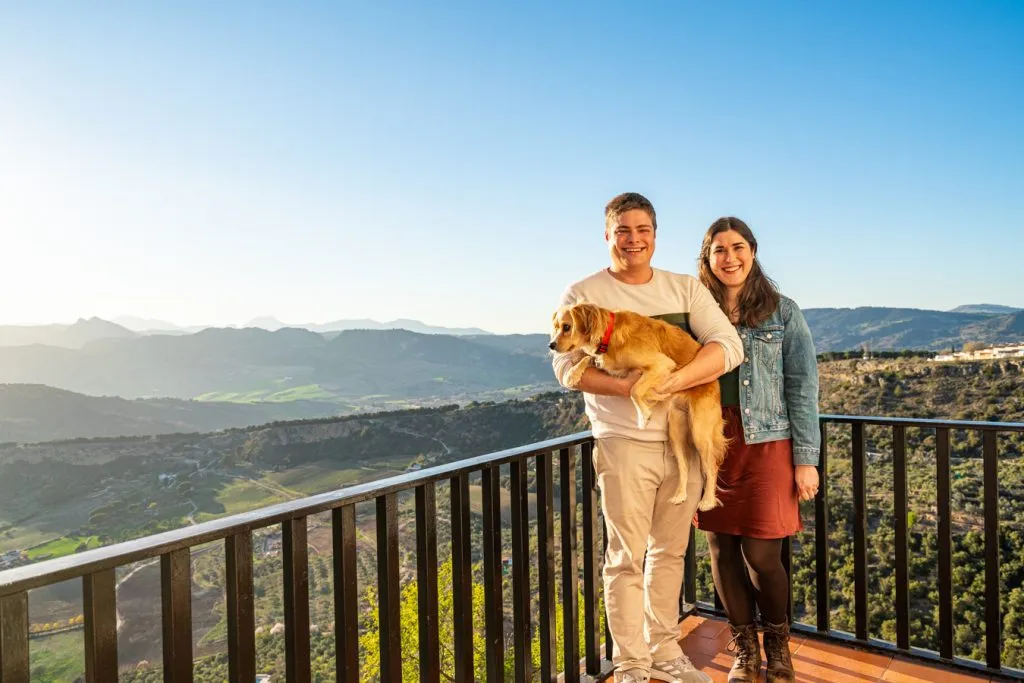
Day 9: Explore unique places to visit near Ronda.
In addition to being a fantastic town to visit in its own right, Ronda is also surrounded by excellent day trip options!
Our first choice would undoubtedly be a visit to Setenil de las Bodegas: if you only have time to visit one place outside of Ronda, make it here.
This historic town features many homes and businesses built directly into the surrounding gorge, and the result is one of the most unique towns we have ever laid eyes on!
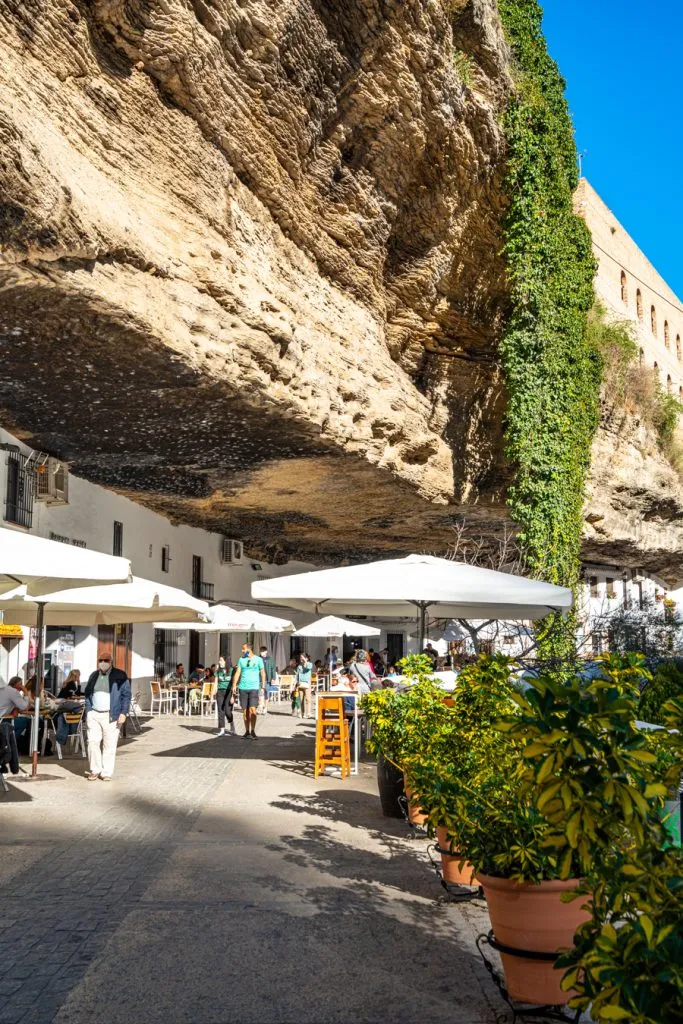
Other fun places to visit include Juzcar (also known as Spain’s “Smurf Village”–it is painted entirely blue!), and the Cueva del Gato swimming hole.
If you want a unique perspective on Ronda’s famous Puerto Nuevo, you can also drive to the bottom of the ridge and view it from an entirely different angle (keep in mind that there are some tiny dirt roads involved here, but it is doable).
Looking to ditch the car entirely?
You can find plenty of horseback riding tours in the area!
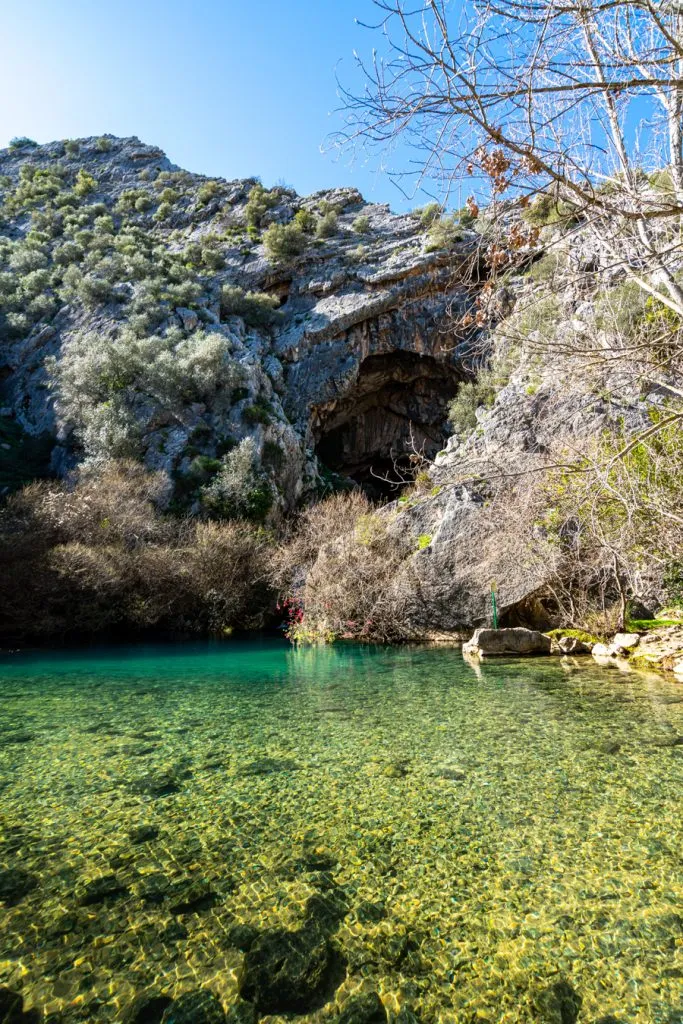
Day 10: Head back to Seville and wrap up your 10 day southern Spain itinerary.
It’s time to wrap up your Andalucia road trip!
Today, make your way back to Seville to drop off your rental car and head home.
If you have time for a little extra sightseeing, consider spending the morning visiting any attractions you didn’t get a chance to see in Ronda or Seville.
Or, for an incredibly relaxing end to your 10 days in southern Spain, book yourself a visit to a hammam in either city!
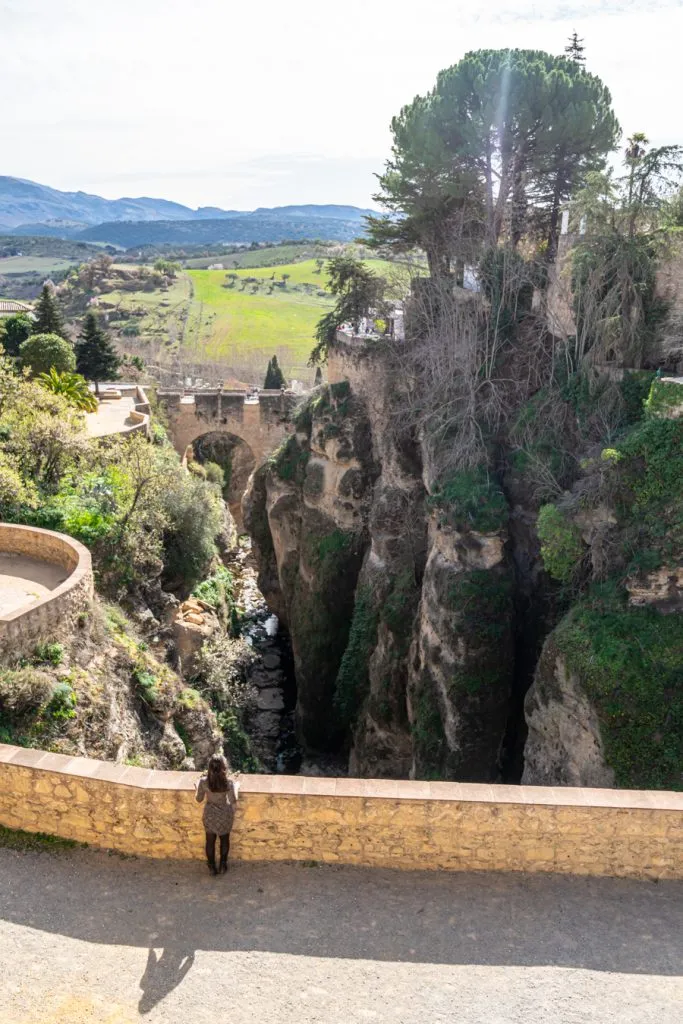
A mere 10 days in Andalucia could never hope to cover every incredible destination that southern Spain has to offer!
If you’re lucky enough to have a longer timeframe to work with, here are a few more places to consider adding to your itinerary for southern Spain, from beach towns to mountainous parks.
Over 3,000 years old and almost entirely surrounded by water, Cadiz is visually stunning and historically fascinating.
It’s fairly small, given that it is physically constrained by its location, but packed with interesting sights, including over 100 watchtowers!
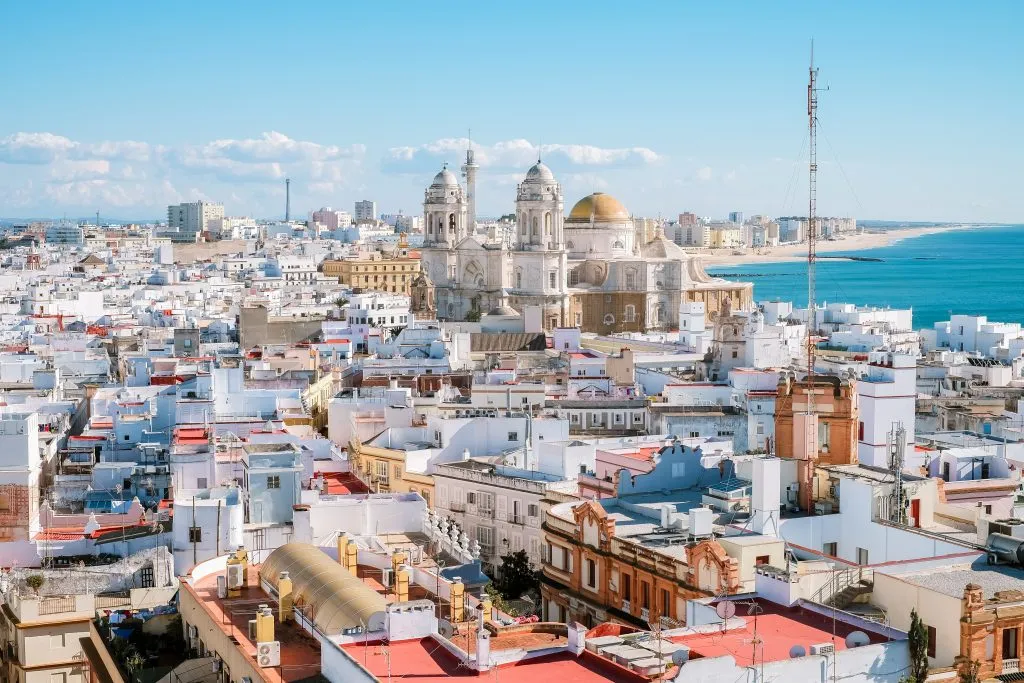
Technically speaking, your Andalucia road trip doesn’t have to only take place in Spain!
Head to Gibraltar to enjoy views from the famous Rock of Gibraltar, check out the resident wild monkeys, and enjoy the excuse to walk (literally) across the border of Spain to the UK.
Don’t forget to pack your passport!
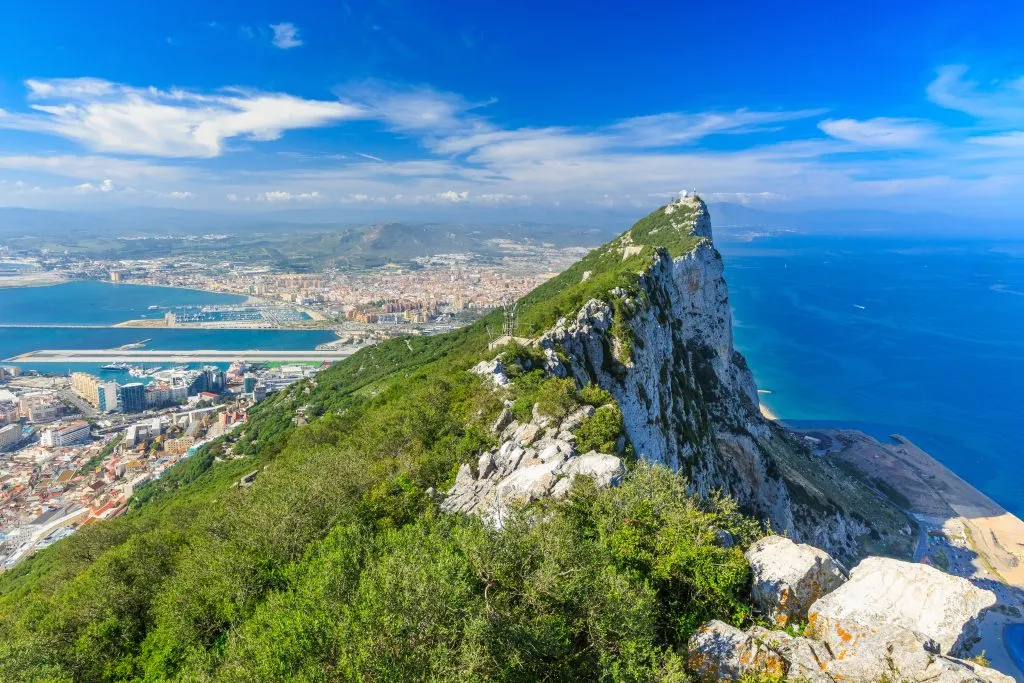
Jerez de la Frontera
A great alternative to cities like Seville, Jerez de la Frontera offers many of the usual Andalucia highlights–Moorish castle, riding school, festivals–but is (slightly) more off the beaten path.
It’s also famous for its sherry production, making it a fun stop for spirit lovers!
Sierra Nevada National Park
Offering skiing in the winter, hiking in the summer, and gorgeous mountain views year-round, Sierra Nevada National Park makes an excellent addition to an itinerary for southern Spain for those looking for a place to relax in nature.
Located just east of Granada, Sierra Nevada National Park is easy to add to this itinerary–or, if you’re not much of a beach person, you can even swap the Costa del Sol for some time here!
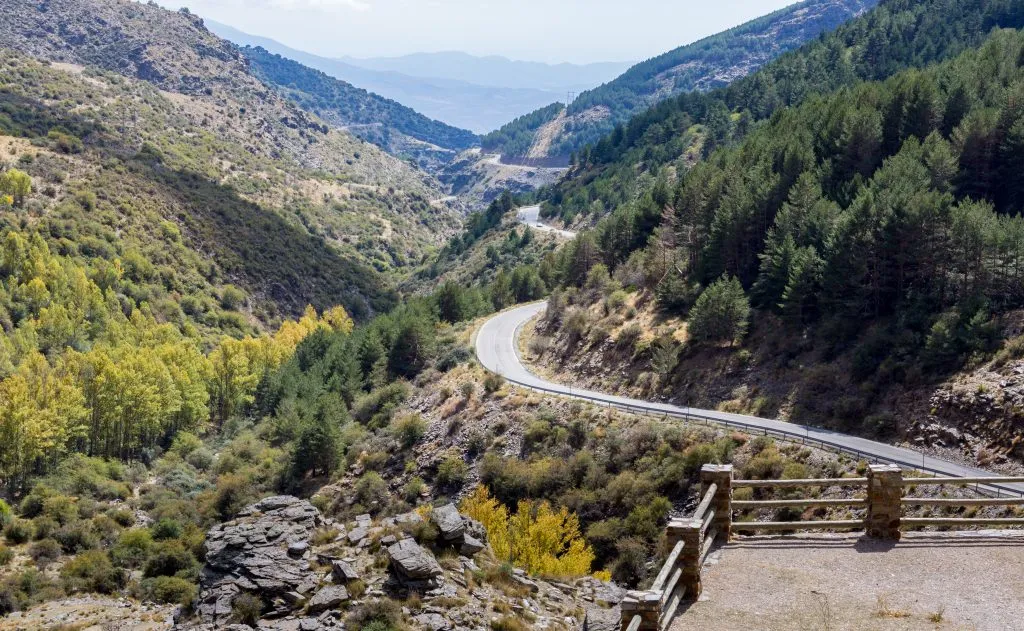
Puerto Banus
Looking for luxurious yachts, high-end nightclubs, and–essentially–the Spanish version of St. Tropez or Monaco?
Head to Puerto Banus, just next door to Marbella, and you’ll find exactly what you’re looking for.
Start by checking out the Golden Mile!
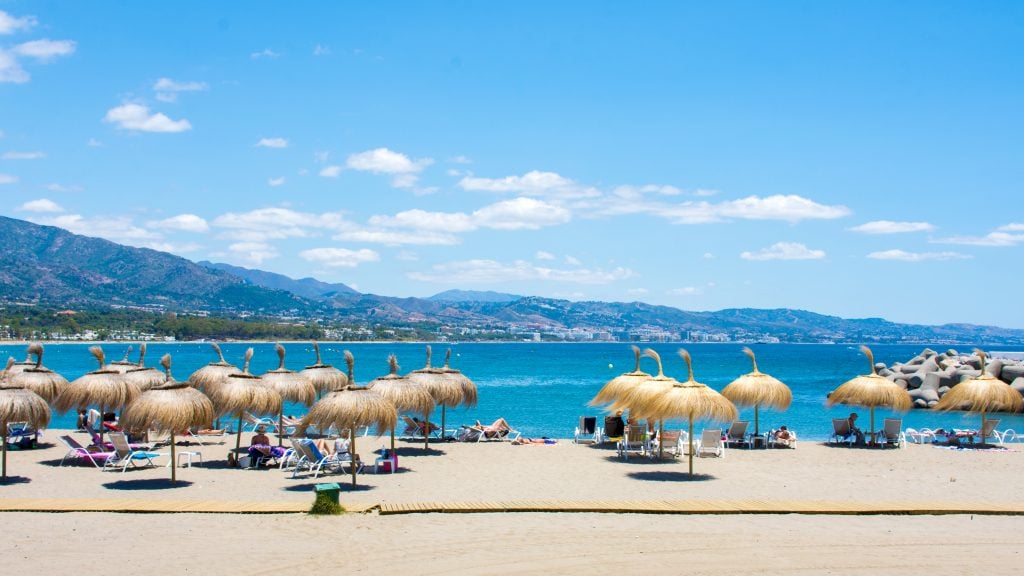
Arcos de la Frontera
Surrounded by the Guadalete River on 3 sides and–like Ronda–situated on the edge of a ridge, Arcos de la Frontera is visually stunning and one of the best whitewashed towns (pueblos blancos) to visit in Andalucia.
Don’t miss the views from the Castillo de los Arcos while you’re there!
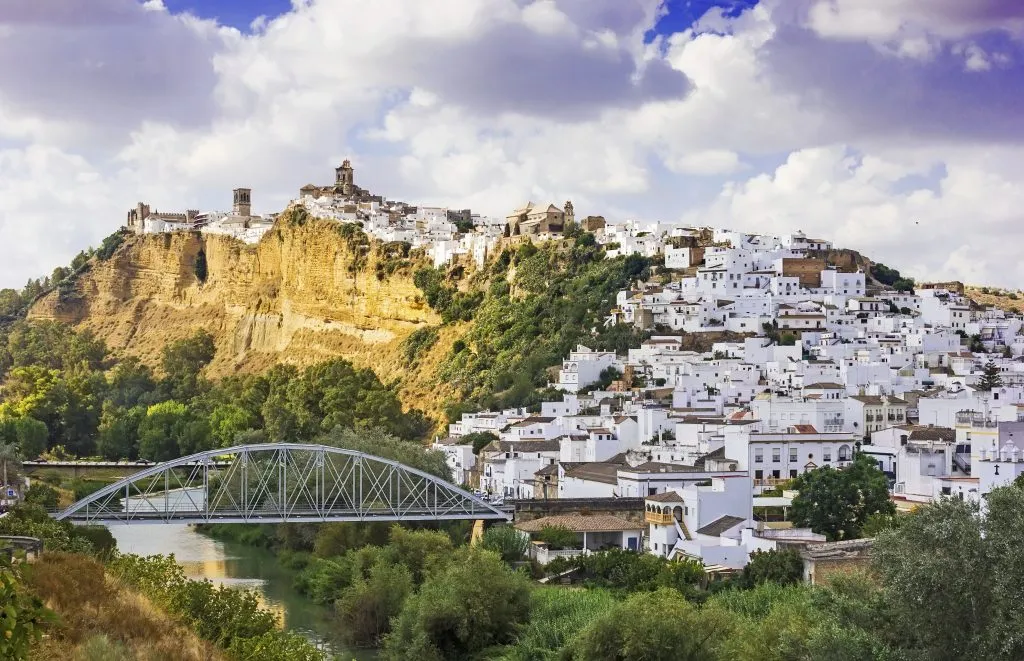
Located at the far southern tip of the Iberian Peninsula, Tarifa is far enough out of the way that it doesn’t see quite as many visitors as the famous Costa del Sol (among those who aren’t kitesurfing enthusiasts, anyway)–but it’s absolutely worth a visit.
Featuring wide, sandy beaches famous for kitesurfing and a charming whitewashed town center, Tarifa is a laid-back delight.
It also lies a short ferry ride away from Morocco , and you can take a day trip to Tangiers as part of your time there!
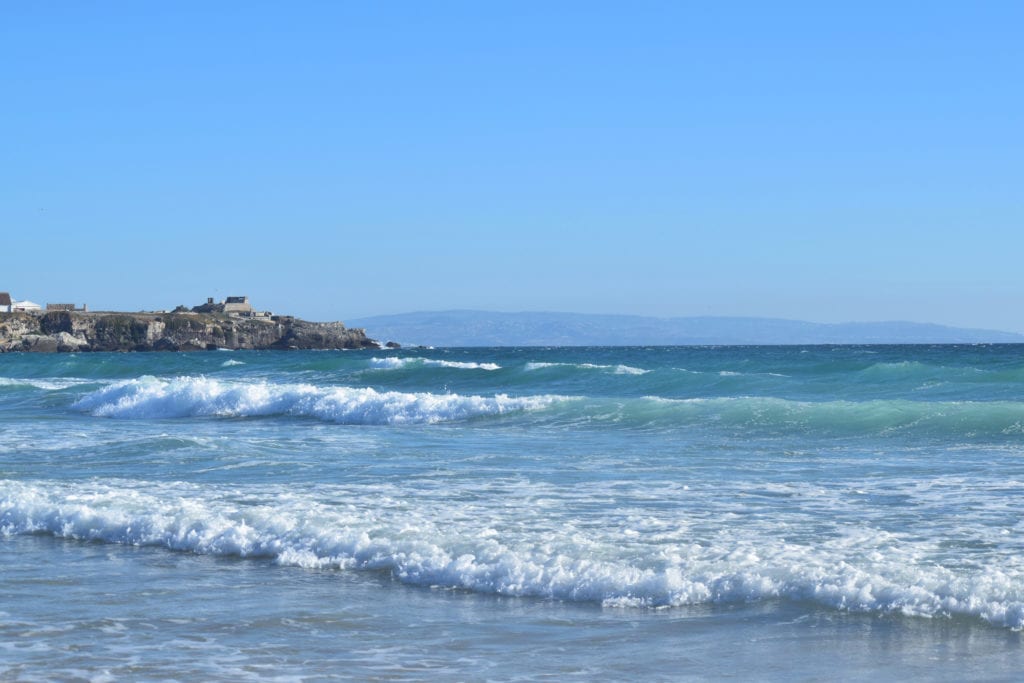
El Caminito del Rey
With stunning gorge views and adrenaline-inducing heights, El Caminito del Rey is one of the most iconic hikes in Andalucia!
A decade ago, it was often touted as being the most dangerous hike in Spain–or even the world–but it has now been restored to be much more accessible.
… For those of us with a fear of heights, though, it can still pose a mental challenge!
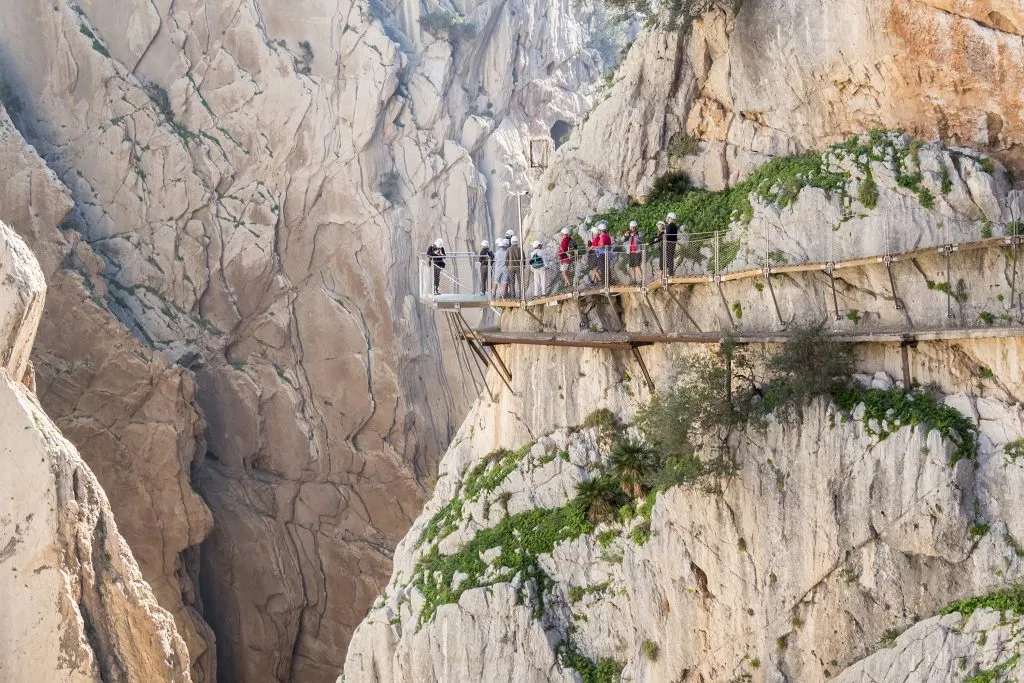
Andalucia can be a year-round destination–if you can brave the summer heat, that is.
Southern Spain, particularly cities like Cordoba and Seville, are known for being some of the hottest places in Europe.
Summer temperatures can easily reach 98°F (36°C) in the inland cities, which is why during July and August, you’ll find the crowds down at the Costa del Sol, where the temperatures are milder and there’s the Mediterranean to cool off in.
Ideally, this itinerary for southern Spain is designed for the spring or fall, when temperatures are warm but reasonable, the sun is usually shining, and the flowers are in bloom everywhere you look.
If you’re willing to bundle up a bit, winter can also be a wonderful time to take this Andalucia road trip.
The prices and crowds will both be smaller, and if you’re so inclined, you can even go skiing in Sierra Nevada near Granada–the southernmost ski area in Europe!
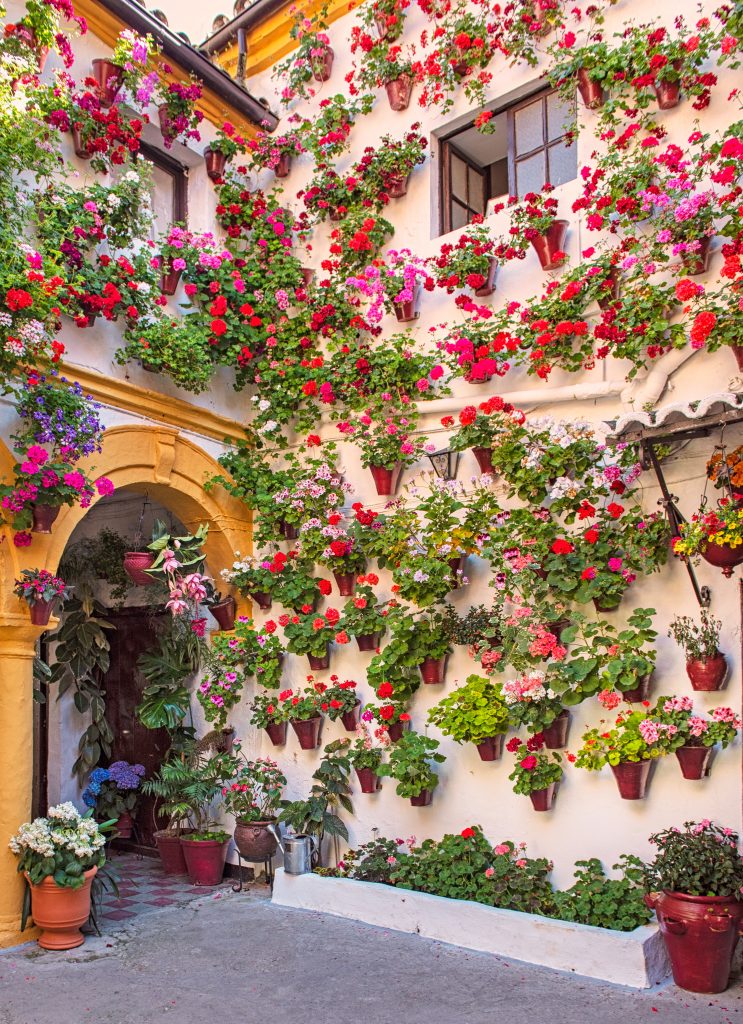
Here are a few essentials you should definitely add to your packing list as you prepare for your road trip in Andalucia, Spain!
Travel Insurance — We don’t ever suggest traveling without travel insurance–anything can happen, and a fast-paced road trip is definitely a case of better safe than sorry.
We use and recommend Safety Wing for trips to Spain.
Travel Adaptors for Spain — If you’re coming from outside of Europe, you’ll definitely need adaptors for your electronics.
Hands-Free Phone Mount — This is especially important if you don’t have a reliable co-pilot: the last thing you want to do is be fumbling with the GPS on your phone during your road trip in Andalucia.
Pack a cell phone holder to attach to the car and you’ll be able to drive much more safely!
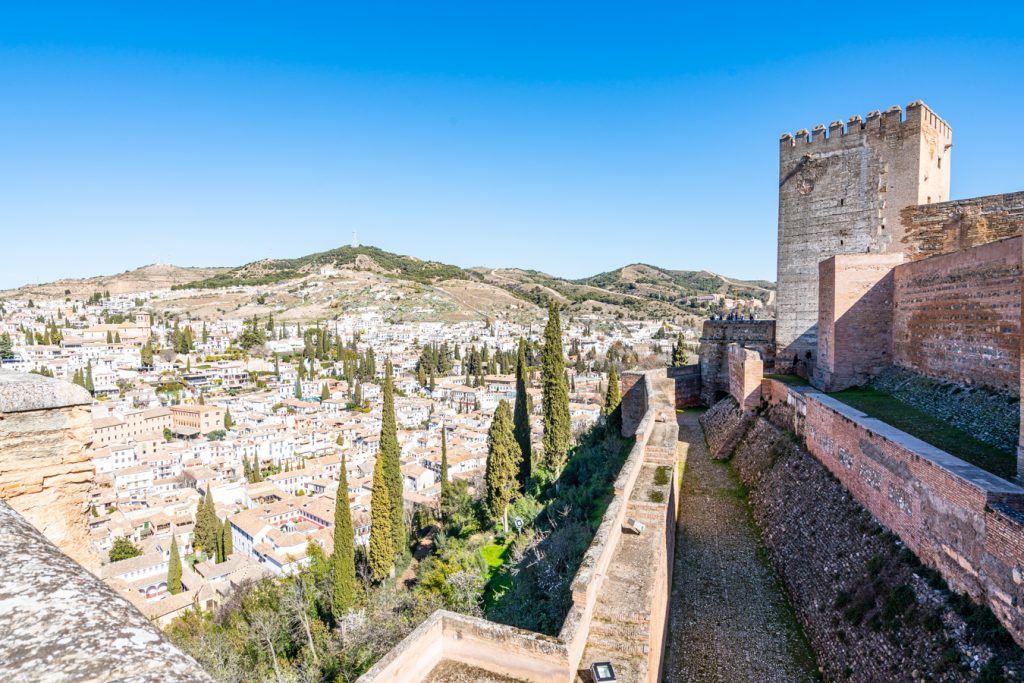
Additional Car Insurance — Whether you purchase a policy that covers car rental (only some of theirs do, so double-check!), purchase a policy through the rental car company, or something else, be sure you have coverage: it’s worth the peace of mind.
Portable USB Charger — Don’t stress about your phone dying while you’re spending long days driving from village to village: add a portable charger to your southern Spain packing list.
Swiss Army Knife — Want to open wine bottles in your hotel room, slice cheese from the market, or cut up that fresh bread from the bakery?
You’ll be so glad you brought a Swiss Army Knife along on your Andalucia vacation!
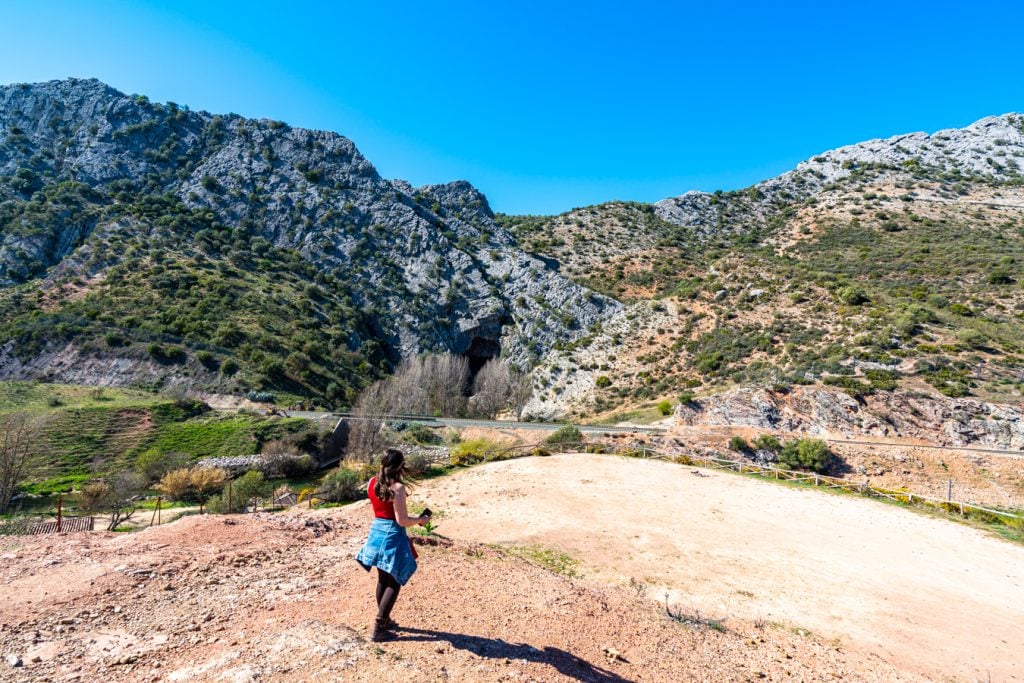
Camera — We absolutely adore our Sony a7R III , but whatever camera you’re comfortable with works.
Just make sure you have something with you to preserve your memories!
Reusable Water Bottle(s) — Cut down on plastic waste, save money, and make sure you don’t have to stop for water constantly: a reusable water bottle has lots of benefits on a road trip. We personally love and use these .
Hand Sanitizer — We carry this everywhere, and have never been sorry to have it floating around in our day bag.
Take This Map With You! Click each highlight to pull up the name of the destination. To save this map to “Your Places” on Google Maps, click the star to the right of the title. You’ll then be able to find it under the Maps tab of your Google Maps account! To open the map in a new window, click the button on the top right of the map.
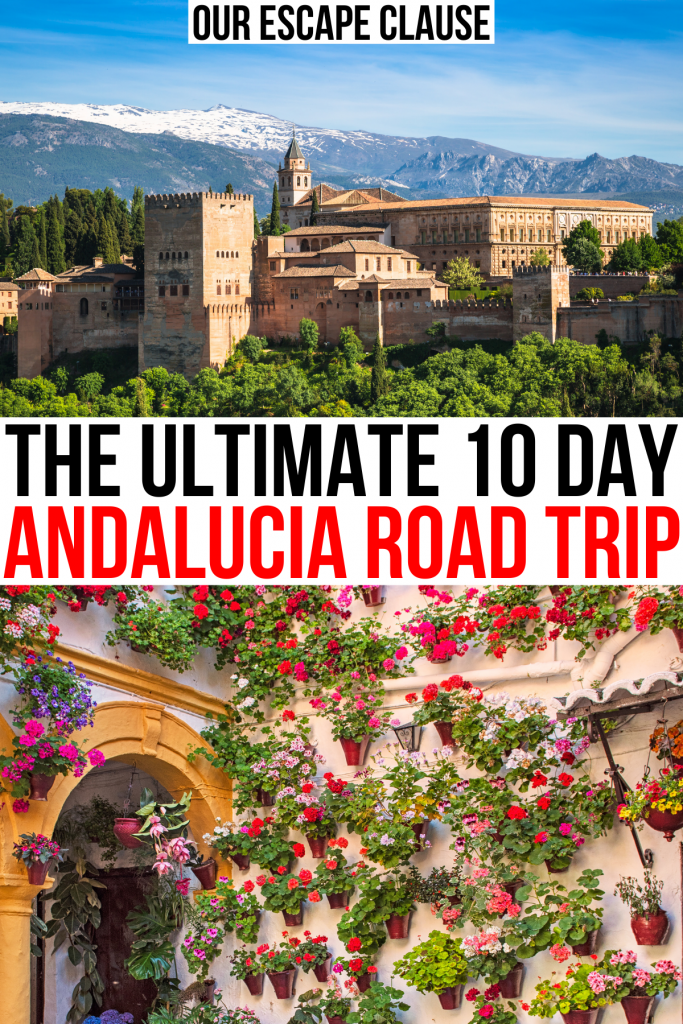
About Kate Storm

In May 2016, I left my suburban life in the USA and became a full-time traveler. Since then, I have visited 50+ countries on 5 continents and lived in Portugal, developing a special love of traveling in Europe (especially Italy) along the way. Today, along with my husband Jeremy and dog Ranger, I’m working toward my eventual goal of splitting my life between Europe and the USA.
8 thoughts on “The Ultimate Andalucia Road Trip (Detailed Southern Spain Itinerary!)”
beautiful, do you sell a map of this
We don’t sell a map or printable version of this itinerary (yet), but you can click on the button at the top right of the map embedded at the bottom of this article and download it to take with you!
This is exactly the trip we plan to take this fall. Thank you for this great guide! Are the places you reccommend to stay pet friendly? It appeared your were travelling with your dog and we are also travrling with ours. Gracias!
Yes, all of the places we mention staying at personally in Andalucia are pet-friendly and Ranger stayed with us at all of them!
I can’t speak to the alternative suggestions provided, as I don’t source pet-friendly hotels specifically for those (very few of our readers travel with their dogs).
Have a wonderful trip!
Hi Kate, It seems finally I have found the perfect road trip for southern Spain. I plan to go early December or maybe in Jan-Feb. I would like to add 3-4 days to the trip. Could you recommend how to do that? Regards, Amitabh
The sky is the limit!
Beyond the destinations I outlined in the “other destinations” section of the post, you could potentially consider adding on a few days in Morocco with a longer timeline.
You can also easily add more days to any of the destinations included in the itinerary. There’s lots of great hiking around Granada, for example, and of course there’s always the option of enjoying even more beach time along the Costa del Sol.
Would you change anything if you were doing this between Christmas and New Years?
Other than adjusting you schedule for closures (the Alhambra is closed on December 25 and January 1, for example, and you can expect restaurants to close as well), nope! There are a lot of advantages to a winter trip, starting with the smaller crowds. Hope you guys have a great time!
Leave a Comment Cancel reply
Two Week Road Trip through Andalusia: Our Travel Itinerary
Oh Andalusia! You sure know how to exceed expectations! White villages against barren landscapes, vibrant cities and wonderful sunsets by the sea, tapas and tinto de verano. The perfect holiday vibes !
Are you looking for the perfect travel itinerary for your road trip through Andalusia? In this blog article, we share our journey with all the destinations in between and all the best highlights in Andalusia.
We have also packed some useful tips for planning your road trip, as well as a map with the main destinations on our travel route so that you can best prepare for your trip in Andalusia.
1. Our Andalusian Travel Route: The Most Beautiful Destinations in Two Weeks
2. more travel tips for your road trip through andalusia, 3. map: overview of our andalusia travel itinerary.
Our road trip journey through Andalusia starts in Málaga. The reason we started here is because it has the most frequented airport in Andalusia, so it’s very likely that your trip will also start here. If not – no worries. Our road trip route though Andalusia actually forms a loop, so you can essentially start at any of the stops.
Málaga is a port city. In terms of tourism, it has long been overshadowed by other travel destinations in Andalusia, but nowadays Málaga is very popular. We particularly liked the mix of the sea and the historic Old Town . Wander down the winding streets in the heart of Málaga with the impressive cathedral and then take a stroll along the harbour. Doesn’t that sound wonderful?
You can find all the tips in our detailed blog article: Málaga Our hotel tip for Málaga: Suites Teatro Recommended stay: 2-3 nights
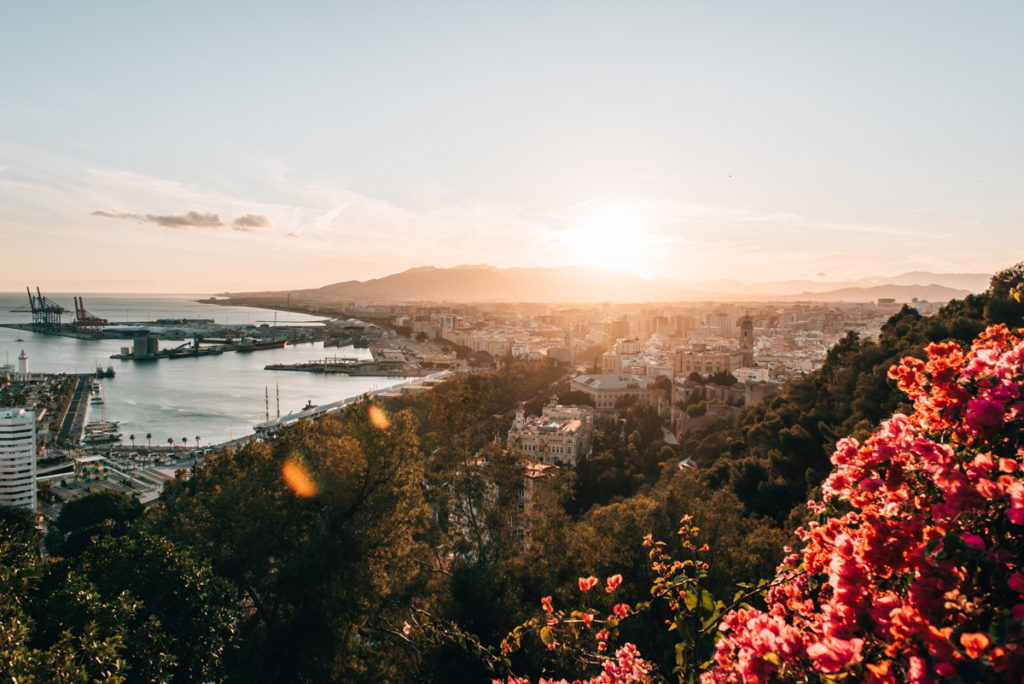
The second stop on our itinerary is Ronda, a town upon the mountainous landscape . It takes about 1.5 hours from Málaga. Ronda is incredibly spectacular: The Old Town of Ronda is perched on a steep sloping rock plateau. In the photo you can already see the most famous sight of Ronda, the Puente Nuevo . It spans the El Tajo gorge, which is about 100 meters deep.
Ronda is quite easy to explore, a few hours would be enough to see the main highlights. Nevertheless, we would recommend you to stay one night here and start the next day early in the morning. That way, you will have enough time to visit the famous White Villages of Andalusia along the way.
You can find all the tips in our blog article: Ronda Our hotel tip for Ronda : Catalonia Ronda Recommended stay: 1 night
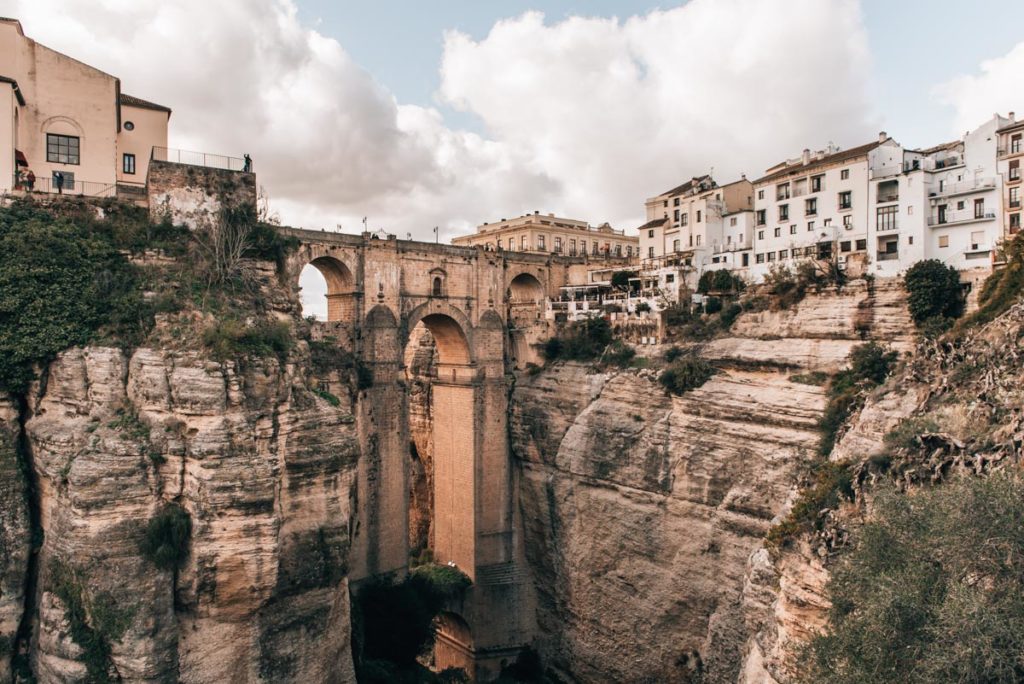
The White Villages of Andalusia (Ruta de los Pueblos Blancos)
Shortly after Ronda begins the Ruta de los Pueblos Blancos , the Route of the White Villages. It winds through the spectacular, mountainous backcountry of the Cádiz province and encompasses a total of 19 villages as part of the Ruta de los Pueblos Blancos. Since the route goes towards Cádiz (the next destination on our journey), these White Villages make for the perfect stop along the way.
The White Villages of Andalusia are like little gems, shining from afar against the barren landscapes. Many of the villages are incredibly spectacular. When you wander the historic town centre, it always feels as if time has stopped. Our personal favourites were the villages of Olvera and Zahara de la Sierra.
Recommended stay: Visit as a day trip from Ronda to Málaga, or alternatively stay for 1 night Blog article with travel tips: The Route of the White Villages in Andalusia
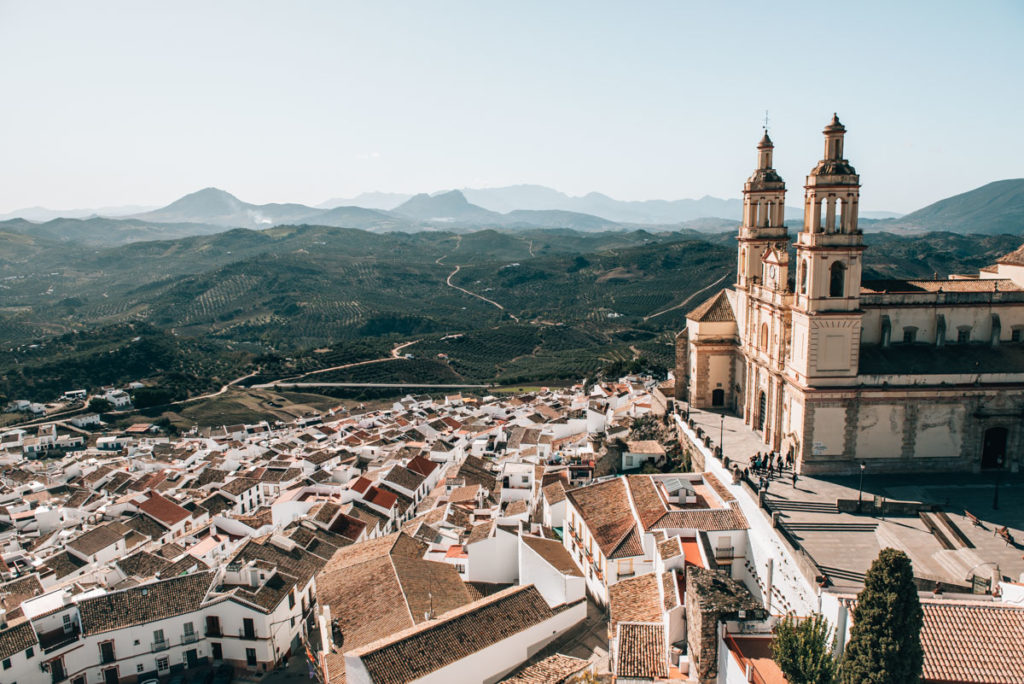
The next stop on our Andalusia itinerary takes us back to the sea, in the coastal city of Cádiz . The Old Town of Cádiz is particularly well located: situated on a headland and almost completely surrounded by the Atlantic Ocean.
One might think that Andalusian cities would be rather similar, but this is not the case. The Old Town of Cádiz has an exceptionally unique and authentic flair . The grid structured Old Town with the tall houses loom over many corners and gives really great insights into the Andalusian way of life.
But don’t worry, there are plenty of spacious areas and of course beaches. In Cádiz, you can enjoy a wonderful relaxing sunset on the beach – the best holiday feeling!
Our blog article with travel tips: Cádiz Our hotel tip for Cádiz: Candelaria 10 Recommended stay: 2 nights
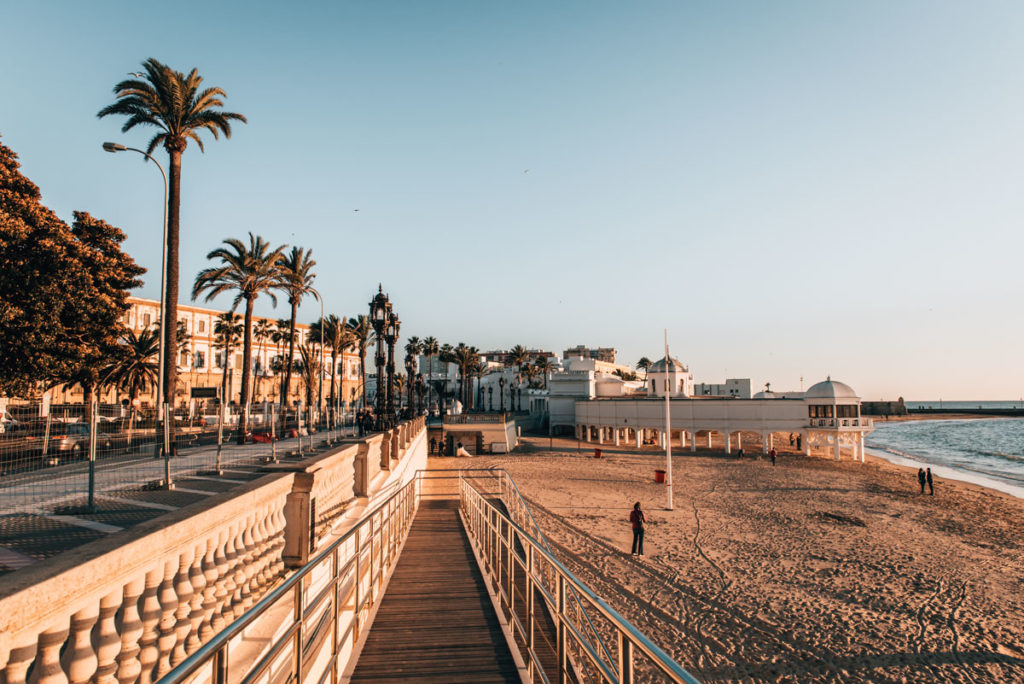
No road trip through Andalusia would be complete without a stopover in the capital of Seville. Many people say that Seville is the most beautiful city in Spain – and we would not disagree with that. This university city is buzzing with energy and good vibes. From Cádiz you can reach Seville in less than 1.5 hours.
There are endless places to explore in Seville, but the gigantic Cathedral of Seville is one you cannot miss – it is simply marvellous. Behind hidden walls you will also find some magnificent, centuries-old city palaces in Seville – with their beautiful, green courtyards, they are also a major highlight in Seville.
Our blog article with all travel tips: Seville Our hotel tip for Seville: Palacio Marmoles Recommended stay: 3-4 nights
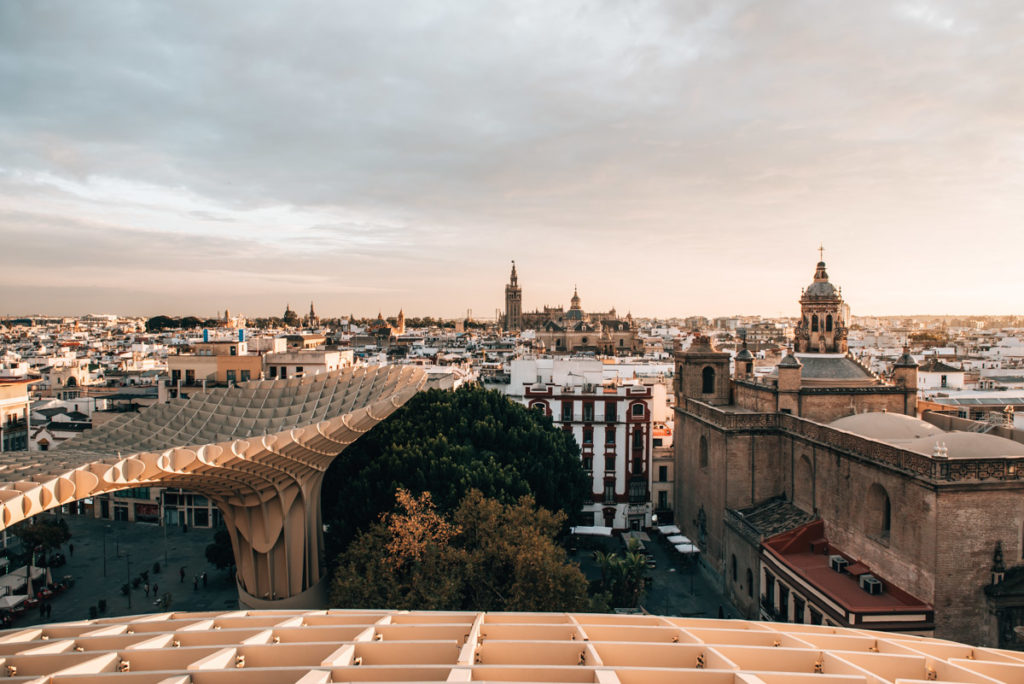
Our route takes us from Seville on a good 1.5 hour drive to Córdoba. There is one building in particular that is highly worth a mention: the monumental Mezquita . It is a mosque-cathedral , a Christian cathedral built in the middle of a mosque. Sounds crazy? It is! Definitely a personal highlight in Andalusia.
We were also pleasantly surprised by the charming Old Town of Córdoba. With its whitewashed houses and narrow streets, we think it is one of the most beautiful in all of Andalusia. Córdoba is relatively quick and easy to explore, but is still worth a stopover on your trip through Andalusia!
Our blog article with travel tips: Córdoba Our hotel tip for Córdoba: Patio del Posadero Recommended stay: 2 nights
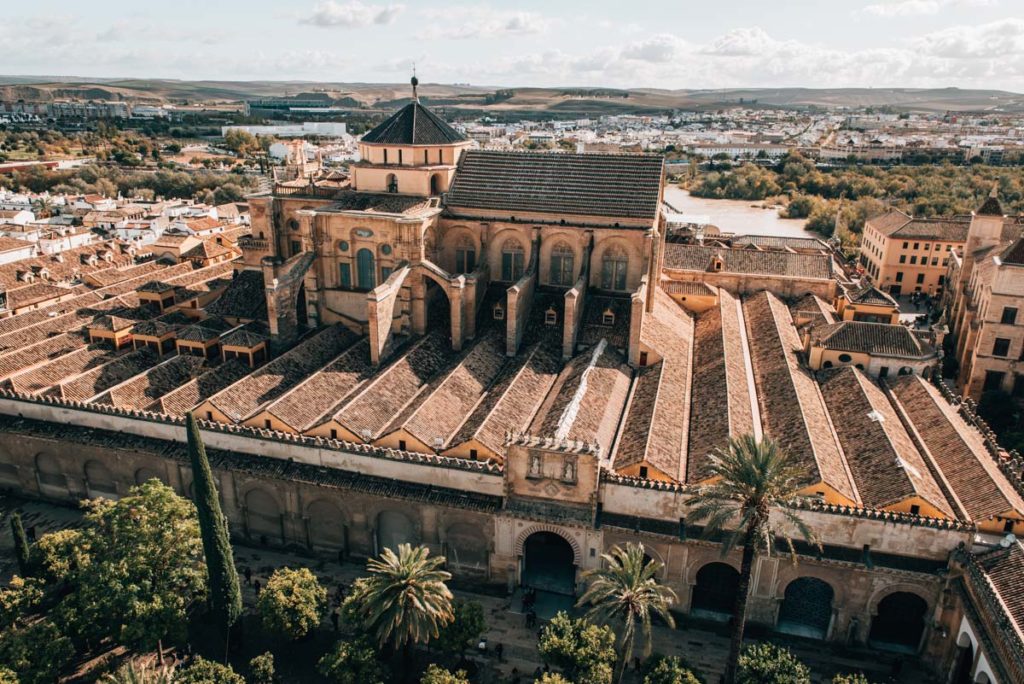
The last stop on our Andalusia road trip takes us to the beautiful Granada. You should plan a good 2 hours for this section of the journey. In Granada, you will find perhaps, the most significant sight in all of Andalusia – The Alhambra.
Rarely are we as astounded by a building as we were by the Alhambra – there is simply no comparison. The Alhambra aside, we really like Granada overall. The Old Town is super pretty and there are also beautiful viewpoints from which you can enjoy a great view of the Alhambra.
Our hotel tip for Granada: Boutique Hotel Luna Granada Centro Recommended stay: 2-3 nights
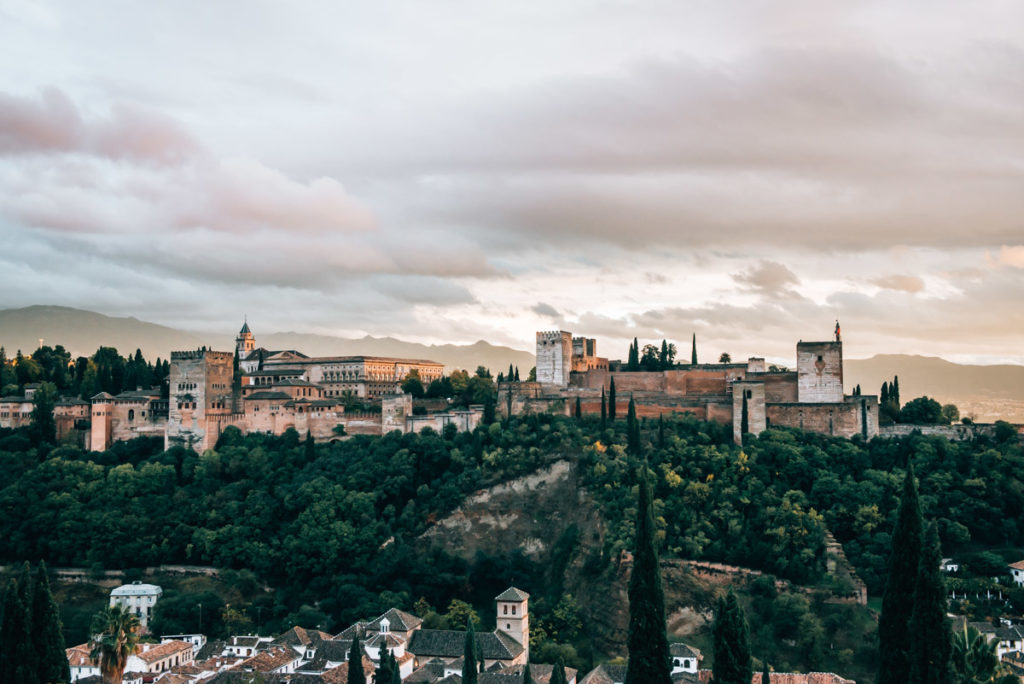
Optional: Sierra Nevada National Park
If you have more time, we have a little insider tip for you: in the Sierra Nevada National Park (south of the Alpujarras), lies a mountain region with small white villages. From Granada, it only takes about an hour to get here. With regards to tourism, the villages of the Alpujarras are far less known and less visited than the Ruta de los Pueblos Blancos.
The Sierra Nevada National Park is also home to the highest mountain of the Spanish mainland – the Mulhacén. So if you want to go hiking, you’ve come to the right place. But even if you just want to enjoy the spectacular landscape and the flair of the pretty mountain villages, we can highly recommend this region.
Recommended stay: 2-3 nights
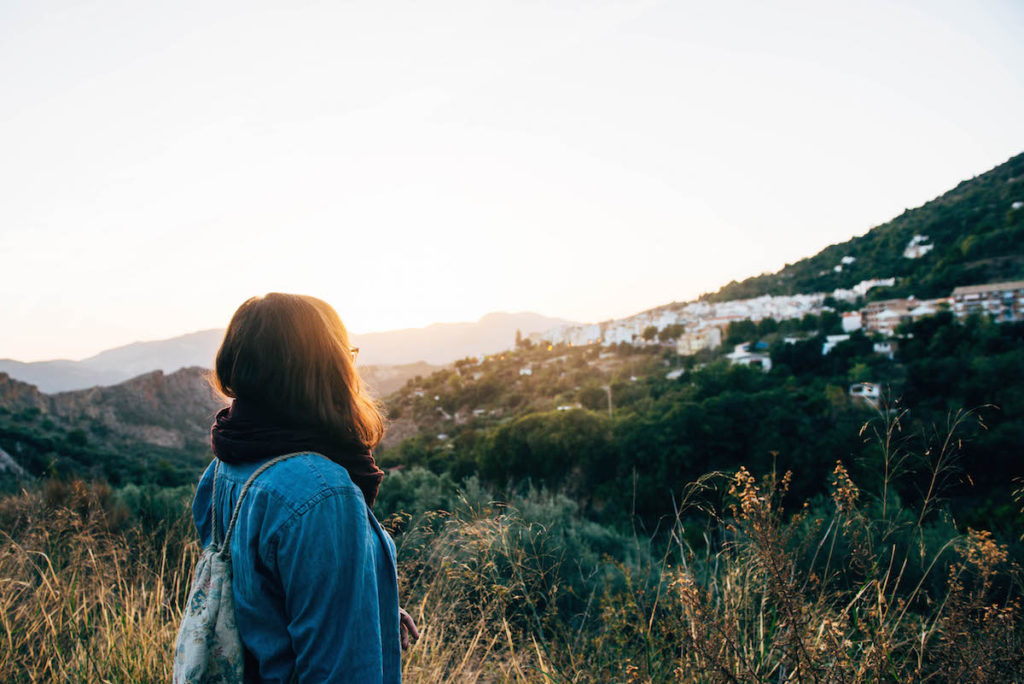
Our Trusted Go-To Rental Car Provider
For years, Sunny Cars has been our trusted go-to rental car provider, and our trip to Andalusia was no exception. Sunny Cars acts as an intermediary platform that compares all the prices from across multiple companies, and presents to you the best deals. You can book your rental car from Sunny Cars website and then collect your car in Spain from a local car rental company. (For us it was Europcar, but this will vary across the board.)
Why go with Sunny Cars? Because they have an amazing comprehensive insurance policy that covers almost every scenario you can think of. In the event of damage, Sunny Cars will also reimburse you the excess, regardless of who was at fault. The Spaniards have a rather “loose and carefree” driving style, so scratches on the car can happen quite quickly. The fact that you don’t have to pay for any damage is a huge relief.
You can search for great rental car deals here: Sunny Cars
What Kind of Rental Car Should I Hire?
The streets of Andalusia are in very good condition, which is why you can book any type of car you like – it’s more a question of your personal taste. A small car has the advantage that you can get through the many narrow streets and underground garages in the city with much more ease. However, we would still avoid driving into most of the historic town centres anyway – no matter how small the car is.
We chose a medium sized car ourselves and were very happy with our choice. There are two main reasons why we went for a medium sized car: more space (especially for luggage in the trunk) and better safety. In our opinion, going larger than a medium car doesn’t really make sense.
How much does a rental car cost in Spain?
It is quite cheap to rent a car in Spain. We only paid 24 Euros per day for our rental car. A small car would have been significantly cheaper. However, we also rented during a low season (November). In the high season, prices go up a little, but not dramatically.
Tip: also include parking in your holiday budget , it’s almost impossible to find parking on the streets in most city centres. Therefore, you will often have to resort to expensive underground parking buildings. In some cities, you often pay 15 Euros a day for parking or even more. It’s really easy to overlook this expense and underestimate the cost of parking in Andalusia.
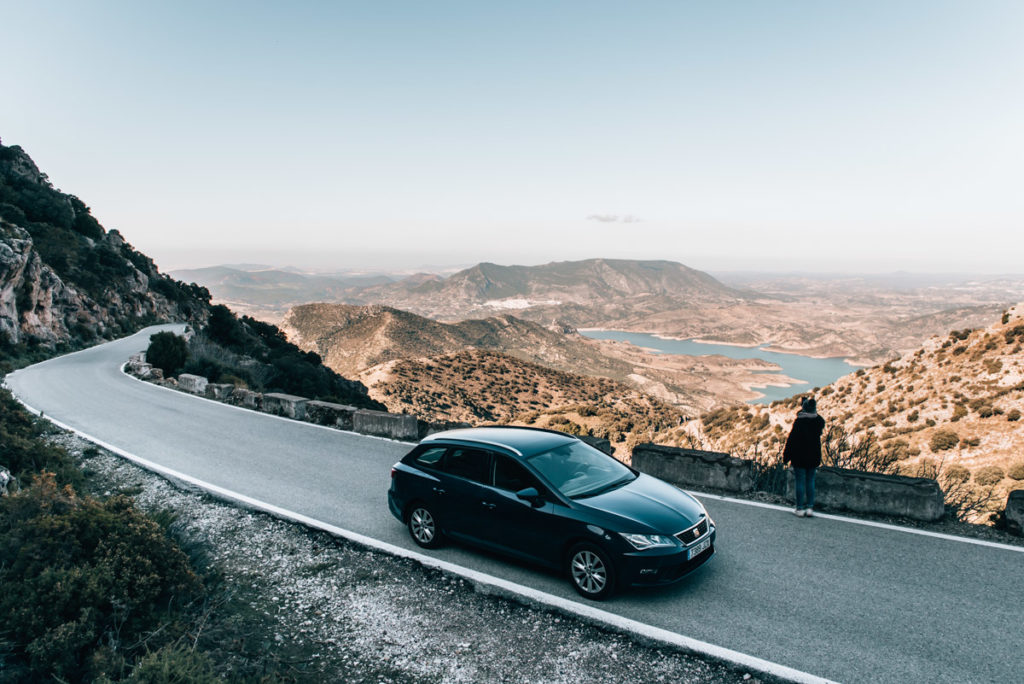
What is the best time of year to visit Andalusia?
Not recommended: high season.
Why? Because it can get unbearably hot in Andalusia during the summer, so we would personally avoid the months of July and August. The temperature in Córdoba can often reach 40 degrees Celsius during midsummer. Sightseeing in these temperatures is not super fun.
In addition, Andalusia becomes a lot more popular as a travel destination. Therefore, certain parts start to get very touristy and the beaches are of course more crowded than usual .
Another slight disadvantage is that the prices for accommodation rise with the demand during the summer months. Conclusion: Of course it is possible to travel around Andalusia in July or August, but we would only recommend it if that’s your only available option. .
Best Time to Visit: Low Season
The best time to travel to Andalusia is clearly in the low season, although there are of course huge variations too. For example, with regards to weather: early September can still be incredibly hot and crowded, while November can sometimes be much cooler and a little rainy.
If you are flexible, then we would recommend that you plan your Andalusia trip for October . During this month, the temperatures are still very warm and you can swim in the ocean without any problems.
We ourselves visited Andalusia at the end of November . Unfortunately, we were a bit unlucky and got caught in a rainy period. On nice days, however, it was still almost 20 degrees and sunshine.
Travel Expenses: How Much Do Things Cost in Andalusia?
Andalusia is surprisingly not a very cheap travel destination. We would say the price level is somewhat lower than in Austria or Germany , with certain things (such as fruit & vegetables) much cheaper in Andalusia, while most other expenses are quite similar to that from home.
However, the entrance fee for various sights is worth the money when traveling through Andalusia. Almost every cathedral will charge for admission (and it’s not uncommon to pay 10 Euros to enter). Many other significant sights, such as palaces or castles, also demand very high entrance fees.
Examples: How much does this cost in Andalusia?
- Entrance to Seville Cathedral: 10 Euros
- Entrance to the Alhambra: 14 Euros
- Beautiful Hotel in Seville with a Double room (in low season): approx. 100 Euros per night (but can also be cheaper)
- Parking in Málaga for 24 hours (close to the centre): 22 Euros
- Dinner for two at a higher-end tapas bar in Seville (including drinks): 30 Euros
- Cortado (similar to an espresso macchiato): 1.20 to 1.50 Euros
- Breakfast for two at a café: 15 Euros
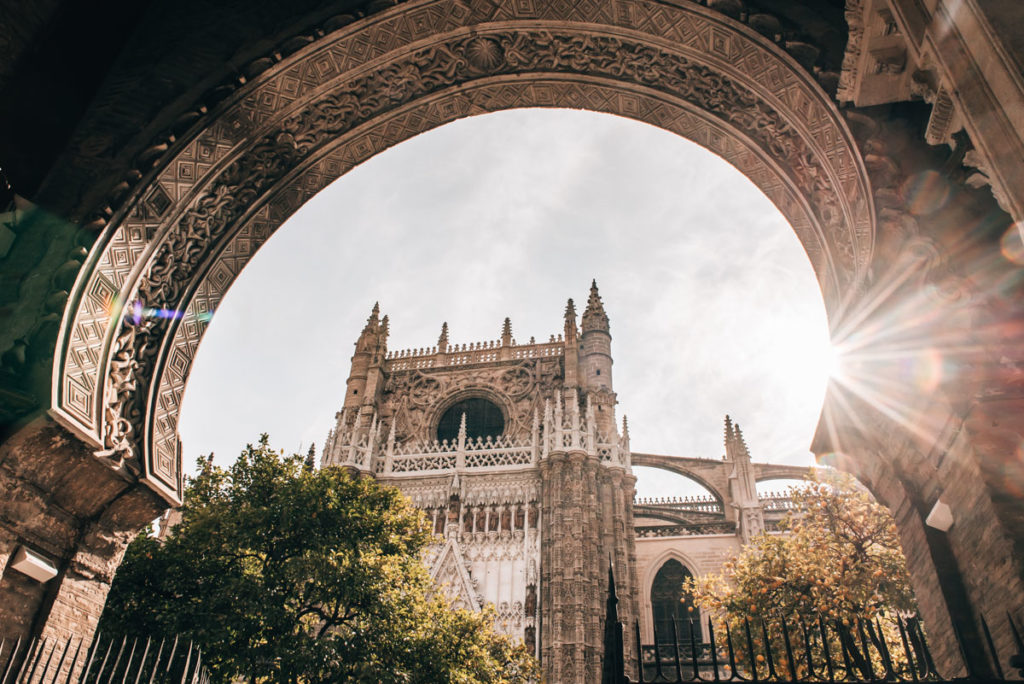
To help you get a better perspective of the entire travel route, we have pinned all our destinations on this map. The distances between the individual stops are rather manageable – you usually don’t have to spend more than 2 hours in the car.
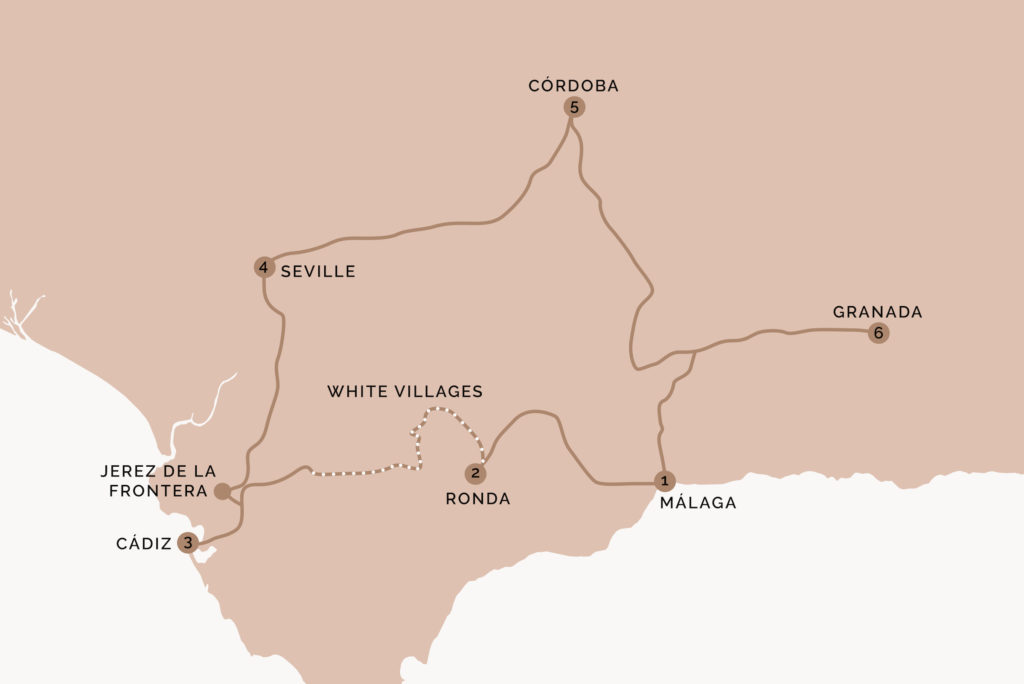
Disclaimer: Affiliate Links
This blog article contains our personal recommendations in the form of affiliate links. If you book or buy something through these links, we receive a small commission from the company. However, this does not change the prices for you at all. We really appreciate it – thank you so much!
Have you ever done a road trip through Andalusia? What did your itinerary look like? Feel free to leave us a comment or a question. We look forward to reading all your extra tips and experiences!
You might also be interested in this

Córdoba Travel Guide: Our top Tips & Things to do

Seville Travel Guide: Best Things to do and see
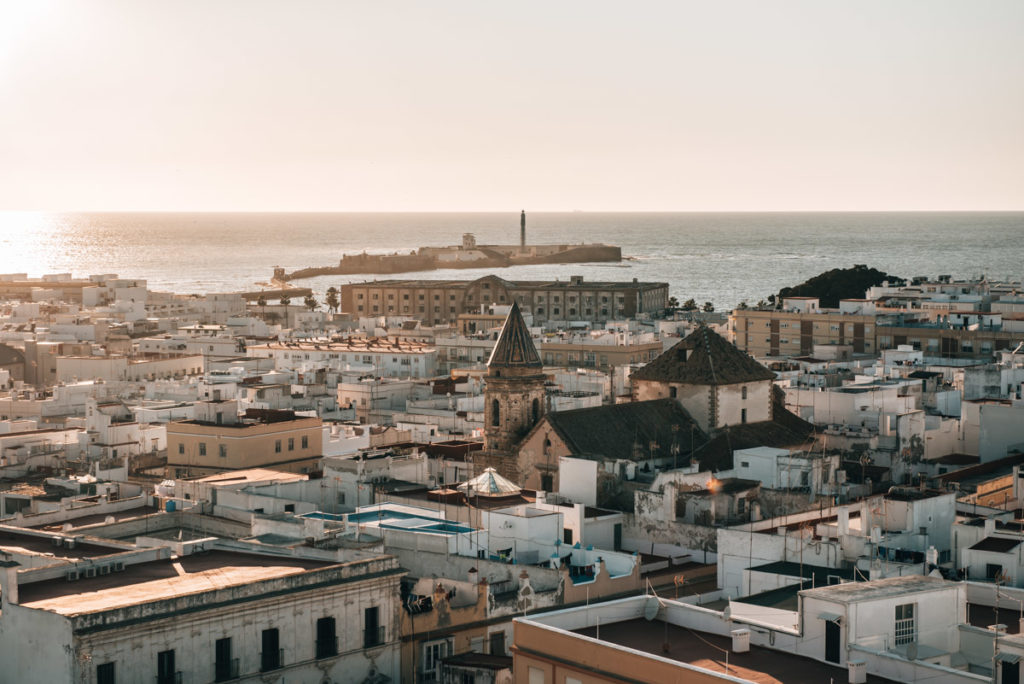
Best of Cádiz: Top Things to do and see
Leave a reply cancel reply.
Your email address will not be published. Required fields are marked *
- Privacy Policy
The spirit of southern Spain: reasons to visit Andalucia

Sep 27, 2019 • 6 min read

Cabo de Gata is a protected natural park © Ventura Carmona / Getty Images
Andalucia represents Spain at its hottest and most passionate. History and culture have conspired to leave a deep imprint on this rugged, arid land, where medieval castles cling to precipitous crags and broad beaches hug both Atlantic and Mediterranean shores.
Away from the coastline, much of what outsiders consider to be quintessentially Spanish embellishes the region’s Moorish-tinged cities – spearheaded by Seville , which in 2019 has marked the 500th anniversary of the voyage of Ferdinand Magellan, who embarked from the riverside port on his pioneering circumnavigation of the globe.

Andalucia's beaches and watersports
As far as name recognition goes, the sandy expanses of the Costa del Sol need no preface. But, while the facilities in the resort towns of Torremolinos and Marbella are modern and sophisticated, the busy backdrop of concrete apartment blocks and ritzy nightclubs, isn’t everyone’s idea of paradise. More tranquil and prettier are the beaches of the Costa de la Luz , a blustery stretch of Atlantic coast backed by small whitewashed villages and frequented by a diverse mix of bohemians, naturists and water-sports enthusiasts.
The stiff winds in this less commercialized region of Andalucia are well-suited to kiteboarding, particularly in the laidback surfer-dude town of Tarifa located at the jaws of the Mediterranean. Elsewhere, the coastline is overlain by a patchwork of protected parks, including the wildlife-rich marshes of Doñana. Other attractions include the Roman ruins of Baelo Claudia , giant sand dunes and the handsome cape where the British and Spanish faced off in the Battle of Trafalgar in 1805.
Another equally beguiling pocket of coastline is Cabo de Gata , a protected natural park on Andalucia’s south coast 30km east of Almería. Cabo de Gata is heralded for its wild beaches, hot, desert-like micro-climate and briny salt flats replete with flamingos. You can walk along the coast for over 60km linking a necklace of fishing towns and artistic communities little touched by Andalucia’s modern building boom.
You might also like these
How to eat through southern spain like it's your last week on earth, my andalucia road trip: sights, sounds and tastes of spain, taste the best of cádiz: seafood, sherry and southern spanish cuisine.

Hiking and climbing in Andalucia
Clinging to the side of sheer cliffs in the Chorro gorge, the vertigo-inducing Caminito del Rey (king’s pathway) is arguably Spain’s most spectacular walking path. Named for Spanish king Alfonso XIII who tackled it in 1921, the path was originally intended to give hydro workers access to a nearby dam, but it gained wider popularity after the royal visit.
Reopened in 2015 after a 15-year hiatus during which it was considered too dangerous for all but the foolhardiest to traverse, the path offers guided or unguided hikes along its 7.7km course. Access is by ticket only and walkers are obliged to wear a helmet and proceed in a north to south direction. While the path is only one-metre wide and 100m high, it has well-designed safety rails and is doable for anyone with a head for heights.
The Caminito ends in the small village of El Chorro which has direct train links to Malaga and a couple of economical accommodation options. El Chorro also acts as a small activity base for sorties into the surrounding countryside, including climbing around the gorge, biking in the nearby mountains and negotiating a newly installed via ferrata (fixed protection climbing route) equipped with Himalayan-style bridges and a zipline situated close to the Caminito terminus.

Food, glorious food
If you’re after Michelin-starred restaurants and celebrity chefs, head north to the Basque region . If you’d prefer fried seafood in paper cones or antioxidant-rich olive oil served not 100m from the olive grove where it grew, southern Spain could be your nirvana. One could wax hungrily all day about Andalucian cuisine, but no list of highlights is complete without mentioning the three ‘C’s’: churros, chiringuitos and cured ham.
Churros are a Spanish snack extraordinaire, deep-fried strips of gooey dough traditionally dipped in cups of thick hot chocolate and best enjoyed in the alfresco cafes of Granada and Málaga , preferably around merienda (snack) time at 5pm-ish.

Chiringuitos are simple fish restaurants that abut Andalucia’s beaches. They serve all number of seafood dishes including the sublime espeto de sardinas , skewers of fresh sardines barbecued over hot coals and garnished with lemon and olive oil. The dish reaches its apogee in Torremolinos, the town that was once the butt of jokes but has more recently reinvented itself as less kitschy cheap food haven.
Spain’s best ham is widely considered to be the rich nutty jamón ibérico manufactured in Huelva province from black Iberian pigs that roam freely in the pastures of the Sierra de Aracena, surviving on a diet of acorns. Coming a close second is jamón serrano, produced from white pigs and cured in the cool air of the Alpujarras mountains. Jamón serrano is most associated with Trevélez, the second highest village in Spain. Both hams work well as tapas and pair perfectly with crisp manzanilla sherry manufactured in Sanlúcar de Barrameda .

500th anniversary of the Magellan voyage
There’s nothing like an anniversary to reignite a palpable sense of history and 2019 marks the quincentenary of the remarkable voyage of Ferdinand Magellan. The Portuguese navigator set sail from Seville in August 1519 for Indonesia’s Spice Islands in search of a new trade route to the Asian colonies. Magellan’s five ships made a brief stop in Sanlúcar de Barrameda before sallying forth on their dangerous journey across the Atlantic. Of the original 270 crew, only 18 made it back to Spain three years later. Numerous events have been organised to celebrate this epoch-defining event, the veritable moon landing of its time. Look out for an exhibition at Seville’s Archivo de Indias depicting the voyage and its challenges that runs until February 2020.

Andalucia, home of flamenco
Flamenco is the soul-stirring soundtrack of Andalucia, the ancestral music of marginalized Roma people that, over time, got mixed with traditional Spanish folk dances to form the spectacular and complex art we know today. Flamenco can be experienced all over Andalucia, but its crucible is the three western cities of Seville, Cádiz and Jerez de la Frontera .
Cádiz has a scattering of small music venues where talented troupes showcase the city’s quintessential alegrías (Cádiz’s upbeat flamenco style). Jerez harbours Andalucia’s only flamenco research centre , an annual festival (in February) and numerous authentic peñas (private clubs). Seville offers the broadest sweep of flamenco talent. In the Andalucian capital you can attend pricy dinner shows (called tablaos ), look around a bona fide flamenco museum , or witness more spontaneous musical spectacles for the price of a drink in crowded bars in the Roma-flavoured Triana district.
Produced by Lonely Planet for Empresa Pública para la Gestión del Turismo y del Deporte de Andalucía ("Andalucia Tourism"). All editorial views are those of Lonely Planet alone and reflect our policy of editorial independence and impartiality.
Explore related stories

Sep 11, 2024 • 5 min read
Seville is one of Spain's most beautiful cities, but the streets can be sizzling hot in summer and busy in spring and fall. Here are the top times to come.

Sep 11, 2024 • 7 min read

Sep 4, 2024 • 13 min read

Aug 26, 2024 • 19 min read

Jul 30, 2024 • 8 min read

Jul 16, 2024 • 5 min read

Jul 15, 2024 • 7 min read

Jul 12, 2024 • 9 min read

Jul 10, 2024 • 7 min read

Jul 8, 2024 • 10 min read
Andalusia Travel Guide
Book your individual trip , stress-free with local travel experts
Select Month
- roughguides.com
- Travel guide
- Itineraries
- Local Experts
- Travel Advice
- Accommodation
Plan your tailor-made trip with a local expert
Book securely with money-back guarantee
Travel stress-free with local assistance and 24/7 support
Maureen C, USA
The hotels were fabulous and we were greeted and treated with care. The itinerary proved outstanding. The drivers were wonderful. He was always on time, ma...
The popular image of Spain as a land of bullfights, flamenco, sherry and ruined castles derives from Andalucía (Andalusia), the southernmost territory and the most quintessentially Spanish part of the Iberian Peninsula. Above all, it’s the great Moorish monuments that compete for your attention here. The Moors, a mixed race of Berbers and Arabs who crossed into Spain from Morocco and North Africa, occupied al-Andalus for over seven centuries. Their first forces landed at Tarifa in 710 AD, and within four years they had conquered virtually the entire country; their last kingdom, Granada , fell to the Christian Reconquest in 1492. Between these dates, they developed the most sophisticated civilization of the Middle Ages, centred in turn on the three major cities of Córdoba , Seville and Granada .
Andalucia’s fiestas
Andalucía’s cuisine, garganta del chorro, antequera and around, parque natural de el torcal, the costa del sol resorts, towards cádiz and seville, the sierra morena, el puerto de santa maría, sanlúcar de barrameda, seville to córdoba, las alpujarras.
Book tickets and tours in Córdoba
Each one preserves extraordinarily brilliant and beautiful monuments, of which the most perfect is Granada’s Alhambra palace, arguably the most sensual building in all of Europe. Seville , not to be outdone, has a fabulously ornamented Alcázar and the grandest of all Gothic cathedrals. Today, Andalucía’s capital and seat of the region’s autonomous parliament is a vibrant contemporary metropolis that’s impossible to resist. Córdoba’s exquisite Mezquita, the grandest and most beautiful mosque constructed by the Moors, is a landmark building in world architecture and not to be missed.
Book things to do in Granada
These three cities have, of course, become major tourist destinations, but it’s also worth leaving the tourist trail and visiting some of the smaller inland towns of Andalucía. Renaissance towns such as Úbeda, Baeza and Osuna, Moorish Carmona and the stark white hill-towns around Ronda are all easily accessible by local buses. Travelling for some time here, you’ll get a feel for the landscape of Andalucía: occasionally spectacularly beautiful but more often impressive on a huge, unyielding scale.
The region also takes in mountains – including the Sierra Nevada , Spain’s highest range. You can often ski here in March, and then drive down to the coast to swim the same day. Perhaps more compelling, though, are the opportunities for walking in the lower slopes, Las Alpujarras. Alternatively, there’s good trekking among the gentler (and much less known) hills of the Sierra Morena, north of Seville .
Thinking about visiting Seville? Book tickets and tours and check our guide to the best areas to stay in Seville .
On the coast, it’s easy to despair. Extending to either side of Málaga is the Costa del Sol, Europe’s most heavily developed resort area, with its poor beaches hidden behind a remorseless density of concrete hotels and apartment complexes. However, the region offers two alternatives, much less developed and with some of the best beaches in all Spain. These are the villages between Tarifa and Cádiz on the Atlantic, and those around Almería on the southeast corner of the Mediterranean. The latter allow warm swimming in all but the winter months; those near Cádiz , more easily accessible, are fine from about June to September. Near Cádiz , too, is Parque Nacional Coto de Doñana, Spain’s largest and most important nature reserve, which is home to a spectacular range of flora and fauna.
Book tickets and tours in Cádiz
The realities of life in contemporary Andalucía can be stark. Unemployment in the region is the highest in Spain – over twenty percent in some areas – and a large proportion of the population still scrapes a living from seasonal agricultural work. The andaluz villages, bastions of anarchist and socialist groups before and during the Civil War, saw little economic aid or change during the Franco years, and although much government spending has been channelled into improving infrastructure such as hospitals and road and rail links, the lack of employment opportunities away from the coastal tourist zones persists. For all its poverty, however, Andalucía is also Spain at its most exuberant – those wild and extravagant clichés of the Spanish south really do exist and can be absorbed at one of the hundreds of annual fiestas, ferias and romerías.
Find things to do in Málaga
Travel ideas for Spain, created by local experts

Andalucía Explored
Discover the best of Andalucía's breathtaking palaces, churches, museums, vineyards, and more, as you travel through spectacular scenery dotted with pueblos blancos and bordered by rugged mountains and coast en route to Granada, Seville, Ronda and Jerez de la Frontera.

A culinary experience in Seville
Explore the cuisine and surroundings of Seville in Andalucia. From Iberian ham over sherry wines to the production and secrets of olive oil, this tour is an ideal weekend getaway. Decide yourself if you prefer a rental car or a chauffeur-driven car to explore the beauty of Andalucia.

Spanish Honeymoon
Discover Andalusia, starting with the cultural city of Seville, then on to Córdoba and Granada, home of the stunning Alhambra Palace. Next you'll visit Granada and the Albayzin Arab quarter, then enjoy a stunning hot-air balloon ride, before ending your trip with a luxury boat trip from Marbella!
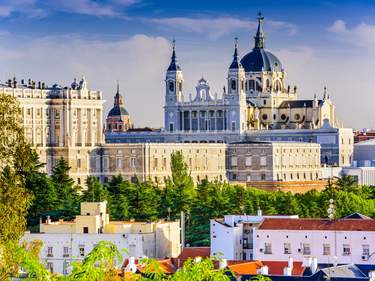
Made for Madrid
Take to the Spanish capital for art, culture and a taste of life in the city, Madrileño-style. Explore age-old churches and pretty plazas, stroll through the lovely Buen Retiro Park and visit captivating Toledo. Then, come sundown, discover the city's vibrant barrios and lively nightlife.
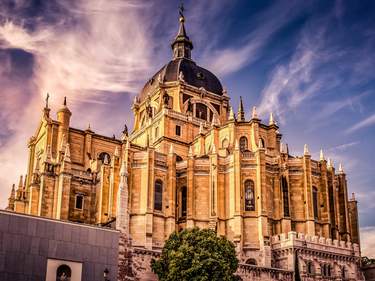
A Madrid getaway
Spend four days discovering the wonders of Spain's capital Madrid: from fascinating museums like El Prado and Reina Sofia over exploring unknown corners with your private guide to a day trip to the surroundings, this itinerary packs the best of Madrid.

Hidden Spain - From Barcelona to Basque Country
Do you want to explore highlights in Spain while staying in nature at the same time? Look no further. Start your Spanish adventure in Barcelona before heading off to the mountains - drive your rental car to Andorra and further on to Basque Country. Decide between driving yourself or guided tours.
1: San Cecilio Fiesta in Granada’s traditionally gypsy quarter of Sacromonte.
Week before Lent: Carnaval An extravagant week-long event in all the Andalucian cities. Cádiz , above all, celebrates, with uproarious street parades, fancy dress and satirical music competitions.
March/April
Easter: Semana Santa (Holy Week) You’ll find memorable processions of floats and penitents at Seville , Málaga , Granada and Córdoba , and to a lesser extent in smaller towns such as Jerez, Arcos, Baeza and Úbeda. All culminate with dramatic candlelight processions at dawn on Good Friday, with Easter Day itself more of a family occasion.
Last week of April: Feria de Abril Week-long fair at Seville : the largest fair in Spain.
First week: Cruces de Mayo Celebrated in Córdoba and includes a “prettiest patio” competition in a town full of prize examples.
Early May (week after Feria de Abril): Feria del Caballo A somewhat aristocratic horse fair is held at Jerez de la Frontera .
Pentecost: Romería del Rocío Horse-drawn carriages and processions converge from all over the south on El Rocío ( Huelva ).
Last week: Feria de la Manzanilla Prolonged binge in Sanlúcar de Barrameda to celebrate the town’s major product, with flamenco and sporting events on the river beach.
13: San Antonio Fiesta at Trevélez (Las Alpujarras) with mock battles between Moors and Christians.
Third week The Algeciras Feria Real is another major event of the south.
End June/early July: International Festival of Music and Dance Major dance/flamenco groups and chamber orchestras perform in Granada’s Alhambra palace, Generalife and Carlos V palace.
Early July: International Guitar Festival Brings together top international acts from classical, flamenco and Latin American music in Córdoba .
End of month: Virgen del Mar Almería’s major annual shindig, with parades, horseriding events, concerts and lots of drinking.
First week The first cycle of horse races along Sanlúcar de Barrameda’s beach, with heavy official and unofficial betting; the second tournament takes place two weeks later.
5: Trevélez observes a midnight romería to Mulhacén.
13–21: Feria de Málaga One of Andalucía’s most enjoyable fiestas for visitors, who are heartily welcomed by the ebullient malagueños.
15: Ascension of the Virgin Fair With casetas (dance tents) at Vejer and elsewhere.
Noche del Vino Riotous wine festival at Competa ( Málaga ).
23–25: Guadalquivir festival Bullfights and an important flamenco competition, at Sanlúcar de Barrameda.
September & October
First two weeks Sept: Feria de Ronda Ronda’s annual feria, with flamenco contests and Corrida Goyesca – bullfights in eighteenth-century dress.
First/second week Sept: Vendimia Celebrating the vintage at Jerez.
27–Oct 1: Feria de San Miguel In Órgiva (Las Alpujarras) featuring traditional dancing and a huge paella cook-up.
If you're planning a trip to Spain, don't miss our Spain itineraries and information on how to get there .
The most striking feature of Andalucía’s cuisine is its debt to the Moors. In their long period of hegemony over the region the North Africans introduced oranges and lemons as well as spices such as cumin and saffron and refined techniques for growing olives and almonds. Their chilled soups such as ajo blanco (made with ground almonds) and gazpacho are still a welcome refresher in high summer temperatures. Of course, gazpacho is today made with tomatoes and green peppers, both brought back from the Americas by Columbus, who sailed from Andalucía.
The region is also the birthplace of tapas, the classic tidbits that Spaniards love to tuck into as they drink. Between 6 and 9pm most evenings city bars are humming with conversations of tapeadores (as aficionados are termed). One of Andalucía’s favourite tapas is jamón serrano, mountain-cured ham from prime producing zones in the Sierra de Aracena and the Alpujarras. The most prized ham of all is jamón ibérico from black Iberian pigs, and in the curing village of Jabugo this is graded into five levels of quality with the very best accorded five jotas or “j’s” (for Jabugo). If you can afford it, the taste is mouthwateringly delicious and far superior to the standard white-pig jamón sold in supermarkets.
Andalucía is also known in Spain as the zona de los fritos (fried food zone) and fried fish is a regional speciality. Chanquetes (whitebait), sardines, calamares and boquerones (anchovies) are all andaluz favourites and the seafood chiringuitos (beach restaurants) of Málaga are famous for their fritura malagueña (assorted fried fish).
Inland, Andalucía is a mountainous region and the specialities here are carnes de caza (game). Jabalí (wild boar), venado (venison), cabrito (kid) and perdiz (partridge) all make memorable meals in the hands of a competent chef.
The wine par excellence of Andalucía – particularly to accompany tapas – is fino (dry sherry) from Jerez de la Frontera , although nearby Sanlúcar de Barrameda’s manzanilla and montilla (produced in Córdoba ) are similar and display their own prized characteristics.
Fifty kilometres northwest of Málaga lies the deep, rugged canyon of the Río Guadalhorce, known as the Garganta del Chorro. It’s an amazing place – an immense five-kilometre-long cleft in a vast limestone massif, which has become Andalucía’s major centre for rock-climbers. The gorge’s most stunning feature, however, is a concrete catwalk, El Camino del Rey, which threads the length of the gorge, hanging precipitously halfway up its side. Built in the 1920s as part of a hydroelectric scheme, it was one of the wonders of Spain, but it has fallen into disrepair, and access to the catwalk has finally been cut at each end of the gorge, making it impossible to reach without a guide and climbing gear. It’s still possible to explore the rest of the gorge, however, and get a view of the camino by doing the walk described in The walk from El Chorro. A glimpse of both gorge and camino can also be had from any of the trains going north from Málaga – the line, slipping in and out of tunnels, follows the river for a considerable distance along the gorge, before plunging into a last long tunnel just before its head.
Heading to Spain anytime soon? Don't miss our important planning tips .
Antequera, some 55km north of Málaga on the main rail line to Granada , is an undistinguished, modern town, but it does have peripheral attractions in a number of fine churches, a group of prehistoric dolmen caves among the most important on the Spanish peninsula, and a fine old Plaza de Toros.
Approaching Antequera along the old road from Málaga (MA424) via Almogía and Villenueva de la Concepción, you pass the entrance to the popular natural park famed for its haunting rock sculptures. Parque Natural de El Torcal, 13km south of Antequera, is one of the most geologically arresting of Spain’s natural parks. A massive high plateau of glaciated limestone tempered by a lush growth of hawthorn, ivy and wild rose, it can be painlessly explored using the three walking routes that radiate from the centre of the park, outlined in a leaflet available from the Centro de Visitantes.
The eastern section of the Costa del Sol ribbons east of the city of Málaga as far as Almería , and is generally uninspiring. Inland there are plenty of attractive sierras to explore but, though far less developed than its twin coastal strip to the west of Málaga , there’s little to tempt you to stop before you reach the twin resorts of Nerja and Almuñécar – which are its saving feature. First, some 40km out of Málaga , comes NERJA, nestling in the foothills of the Almijara range. This was a village before it was a resort, so it has some intrinsic character, and villa development has been shaped around it.
The focus of the whitewashed old quarter is the Bálcon de Europa, a striking palm-fringed belvedere overlooking the sea. The beaches flanking this are also reasonably attractive, with a series of quieter coves within walking distance. There are plenty of other great walks around Nerja, too, well documented in the turismo’s own leaflets; or, at Smiffs Bookshop, c/Almirante Ferrandiz 10, you can buy individual leaflets detailing walks in the area by local resident and hiker Elma Thompson.
Book a Nerja and Frigiliana Tour Day Tour
The lively resort of Almuñécar is marred by a number of towering holiday apartments, and the rocky grey-sand beaches are rather cramped, but the esplanade behind them, with palm-roofed bars (many serving free tapas with each drink) and restaurants, is fun, and the old quarter – clustered around a sixteenth-century castle – attractive. The two main beaches, the Playa San Cristóbal and the Playa Puerta del Mar are separated by the towering headland of the Peñon del Santo.
West of Málaga – or more correctly, west of Málaga airport – the real Costa del Sol gets going, and if you’ve never seen this level of tourist development, it’s quite a shock. These are certainly not the kind of resorts you could envisage anywhere else in Europe. The 1960s and 1970s hotel and apartment tower-blocks were followed by a second wave of property development in the 1980s and 1990s, this time villa homes and leisure complexes, funded by massive international investment. It’s estimated that 300,000 foreigners now live on and around the Costa del Sol, the majority of them British and other Northern Europeans, though marina developments such as Puerto Banús have also attracted Arab and Russian money.
Approached in the right kind of spirit, it is possible to have fun in resorts like Torremolinos, Fuengirola and, at a price, in Marbella. But if you’ve come to Spain to be in Spain, put on the shades and keep going at least until you reach Estepona.
Book tickets and tours in the Costa del Sol
Algeciras occupies the far side of the bay from Gibraltar , spewing out smoke and pollution in the direction of the Rock. The last town of the Spanish Mediterranean, it must once have been an elegant resort; today, it’s unabashedly a port and industrial centre, its suburbs extending on all sides. When Franco closed the border with Gibraltar at La Línea it was Algeciras that he decided to develop to absorb the Spanish workers formerly employed in the British naval dockyards, thus breaking the area’s dependence on the Rock.
Most travellers are scathing about the city’s ugliness, and unless you’re waiting for a bus or train, or heading for Morocco, there’s admittedly little reason to stop. Yet some touch of colour is added by the groups of Moroccans in transit, dressed in flowing jallabahs and slippers, and lugging unbelievable amounts of possessions. Algeciras has a real port atmosphere, and even passing through it’s hard to resist the urge to get on a boat south, if only for a couple of days in Tangier. Once you start to explore, you’ll also discover that the old town has some very attractive corners that seem barely to have changed in fifty years, especially around Plaza Alta.
Ronda has good transport connections in most directions. Almost any route to the north or west is rewarding, taking you past a whole series of White Towns, many of them fortified since the days of the Reconquest from the Moors – hence the mass of “de la Frontera” suffixes.
Perhaps the best of all the routes, though a roundabout one, and tricky without your own transport, is to Cádiz via Grazalema, Ubrique and Medina Sidonia. This passes through the spectacular Parque Natural Sierra de Grazalema before skirting the nature reserve of Cortes de la Frontera (which you can drive through by following the road beyond Benaoján) and, towards Alcalá de los Gazules, running through the northern fringe of Parque Natural de los Alcornocales, which derives its name from the forests of cork oaks, one of its main attractions and the largest of its kind in Europe.
The longest of Spain’s mountain ranges, the Sierra Morena extends almost the whole way across Andalucía – from Rosal on the Portuguese frontier to the dramatic pass of Despeñaperros, north of Linares. Its hill towns marked the northern boundary of the old Moorish Caliphate of Córdoba , and in many ways the region still signals a break, with a shift from the climate and mentality of the south to the bleak plains and villages of Extremadura and Castilla-La Mancha. The range is not widely known – with its highest point a mere 1110m, it’s not a dramatic sierra – and even Andalucians can have trouble placing it.
Aracena and around
Some 90km northwest of Seville , Aracena is the highest town in the Sierra Morena with sharp, clear air, all the more noticeable after the heat of the city. A substantial but pretty place, it rambles partly up the side of a hill topped by the Iglesia del Castillo, a Gothic-Mudéjar church built by the Knights Templar around the remains of a Moorish castle. The town is flanked to the south and west by a small offshoot of the Sierra Morena – the Sierra de Aracena – a wonderfully verdant corner of Andalucía with wooded hills and villages with cobbled streets.
Gruta de las Maravillas
Although the church is certainly worth the climb, Aracena’s principal attraction is the Gruta de las Maravillas, the largest and arguably the most impressive cave in Spain. Supposedly discovered by a local boy in search of a lost pig, the cave is now illuminated and there are guided tours as soon as a couple of dozen or so people have assembled; to protect the cave there’s now a strict limit of 35 persons per visit. At weekends and holiday periods, try to visit before noon – coach parties with advance bookings tend to fill up the afternoon allocation. On Sunday, there’s a constant procession, but usually plenty of time to gaze and wonder. The cave is astonishingly beautiful, and funny, too – the last chamber of the tour is known as the Sala de los Culos (Room of the Buttocks), its walls and ceiling an outrageous, naturally sculpted exhibition, tinged in a pinkish-orange light.
The king of hams
Surrounding Aracena is a scattering of attractive but economically depressed villages, most of them dependent on the jamón industry and its curing factory at Jabugo. Jamón serrano (mountain ham) is a tapa or bocadillo standard throughout Spain, and some of the best, jamón de bellota (acorn-fed ham), comes from the Sierra de Aracena, where herds of sleek black pigs grazing beneath oak trees are a constant feature. In October, the acorns drop and the pigs, waiting patiently below, gorge themselves, become fat and are promptly whisked off to be slaughtered then cured in the dry mountain air. The meat of these black pigs is exceptionally fatty when eaten as pork but the same fat that marbles the meat adds to the tenderness during the curing process. This entails first of all covering the hams in coarse rock or sea salt to “sweat”, after which they are removed to cool cellars to mature for up to two years. Jamón serrano from mass-produced white pigs is matured for only a few weeks, hence the incomparable difference in taste. At Jabugo the best of the best is then further graded from one to five jotas (the letter “J” for Jabugo) depending on its quality. A whole leg of cinco jotas jamón will set you back anything from €250 to €350. The turismo can provide details of where to sample and buy.
The Costa de la Luz
Stumbling on the villages along the Costa de la Luz, between Algeciras and Cádiz , is like entering a new land after the dreadfulness of the Costa del Sol. The journey west from Algeciras seems in itself a relief, the road climbing almost immediately into rolling green hills, offering fantastic views down to Gibraltar and across the Strait to the just-discernible white houses and tapering minarets of Moroccan villages.
Beyond, the Rif mountains hover mysteriously in the background, and on a clear day, as you approach Tarifa, you can distinguish Tangier on the edge of its crescent-shaped bay. Beyond Tarifa lies a string of excellent golden-sand beaches washed by Atlantic breakers and backed by a clutch of low-key resorts such as Conil. Inland, the haunting Moorish hill town of Vejer de la Frontera beckons, while set back from the sea at Bolonia is the ancient Roman settlement of Baelo Claudia.
Things to do in Costa de la Luz
As opposed to many other Costas in Spain, Costa de la Luz sees high-rise hotel buildings replaced with sand dunes and pine trees. The beaches are almost unspoiled with golden sands, hidden coves and clear waters. There is plenty to do in the area, whatever your desire.
National Parks
For nature lovers, head to Sierra de Grazalema, famed as the best national park in the Andalucia area for its limestone landscape and exceptional wildlife, including a variety of birds. Estrecho National Park and Bahia de Cadiz are just as impressive, with features such as natural monuments i.e. Tombolo de Trafalgar.
Costa de la Luz translates quite literally to "Coast of Light", so what better way to enjoy the sunshine than on the beach! The coast is divided into two sections from the mouth of the Guadalquivar River to Tarifa and the Southernmost point in Europe. On the South side, kite and windsurfing is major - something to bare in mind if you love watersports.
El Puerto de Santa Maria and Cadiz offer historic old towns to explore in between relaxing on the sands and Conil de la Frontera offers toned down tourism a beach stretching for several kilometres. Tarifa is in the east, along with Baelo Claudia and Atlanterra.
Spain in general is a haven for the retired wishing to live out their days in the sunshine, this, added with the area being a popular holiday destination, has seen the construction of more than 20 golf courses in the area. Alcaidesa Heathland, La Estancia and Villaneuva, to name a few, are any golfers dream.
Whale- and dolphin-watching trips
Tarifa is home to whale-and dolphin-watching excursions in the Strait of Gibraltar , which leave daily from the harbour.
Just 10 km across the bay, EL PUERTO DE SANTA MARÍA is the obvious choice for a day-trip from Cádiz, a traditional family resort for both gaditanos and sevillanos – many of whom have built villas and chalets along the fine Playa Puntillo. This strand is a little way out from town (10–15 minute walk or local bus ride), a pleasant place to while away an afternoon; there are friendly beach bars where for ridiculously little you can nurse a litre of sangría while munching mariscos.
Things to do in El Puerto de Santa Maria
Exploring the cobblestone streets of the old town, surronded by orange trees is a charming way to get to know El Puerto de Maria. The coastal town boasts glorious seafood, with the cuisine offered at almost all restaurants in the area. For a dose of Andaluz history, head to Castillo San Marcos, the famed castle built on the remains of a Moorish moque in 1264. Wine in this region of Spain is particularly tasty, thanks to the ideal climate. The wine route, or Ruta de los Sentidos as the Spainish call it, is exactly what you would expect - a walking route to several wineries that offer tastings and opportunities to learn about the wines as well as Flamenco music and dancing.
If you are seeking-fun as a means to entertain the family, head to Aqualand Bania de Cadiz nearby, the waterpark has rapids, whirlpools and a range of water rides along with a food court - making a great day out.
Beaches in El Puerto de Santa Maria
Playa de Valdelagrana sits between the Guadalete River and Levante Beach, so you can only imagine how beautiful of a destination it is. There is a promenade with restaurants, bars and hotels as well as watersport activities such as kitesurfing and windsurfing. Nearby is Los Torunos Natural Park, ideal for a little mid-afternoon stroll on the boardwalks taking in the wildlife. Nearby beaches include Fuentebravia and Santa Catalina.
Like its neighbour El Puerto, Sanlúcar de Barrameda, 15km to the northwest, also has its sherry connections. Nine kilometres east of Chipiona and set at the mouth of the Guadalquivir, it’s the main depot for manzanilla wine, a pale, dry variety much in evidence in the bars, which you can also sample during visits to the town’s bodegas. Sanlúcar is also the setting for some exciting horse races along the beach in the first and third weeks of August, a great time to be here.
Parque Nacional Coto de Doñana
One of the best things about Sanlúcar is its shell-encrusted river beach and warm waters, just a short walk from the town centre. This is flanked, on the opposite shore, by the beginnings of the Parque Nacional Coto de Doñana, whose vast marshy expanses (strictly regulated access) signal the end of the coast road to the west. The park boasts exceptional flora and fuana, known for its great ecological wealth and population of migrating birds.
Visiting Parque Nacional Coto de Doñana
Access to the park is limited to ensure the wildlife is protected, however, there are boardwalks nearby visitor centres that allow sufficient exploring. Centres with designated walking areas include El Acebuche, La Rocina, Palacio de Acebron and Jose Antonio Valverde.
Cruises at Parque Nacional Coto de Doñana
Visits to the park from Sanlúcar are possible with a boat cruise, which, while it doesn’t allow for serious exploration, is nevertheless a wonderful introduction to this remarkable area. The trip lasts approximately four hours and allows two short, guided walks inside the park to spot wildlife. The Real Fernando – which has a cafetería on board – leaves daily from the Bajo de Guía quay (Mon–Sat June–Sept 10am & 5pm; March, April, May & Oct daily 10am & 4pm; Nov–Feb daily 10am; €16.35, under-12s half-price; booking essential on t956 363 813, w www.visitasdonana.com ).Tickets should be collected (at least 30min before sailing) from the Fábrica de Hielo, Bajo de Guía s/n, the national park’s exhibition centre (daily 9am–8pm) opposite the Real Fernando’s jetty. Also note that binoculars are pretty essential, and, while they can be hired on board, having your own is a distinct advantage.
The direct route from Seville to Córdoba , 135km along the valley of Guadalquivir, followed by the train and some of the buses, is a flat and rather unexciting journey. There’s far more to see following the route just to the south of this, via Carmona and Écija, both interesting towns, and more still if you detour further south to take in Osuna as well. There are plenty of buses along these roads, making travel between the villages easy. Overnighting, too, is possible, with plenty of places to stay – although Carmona is an easy day-trip from Seville .
Osuna (like Carmona and Écija) is one of those small Andalucian towns that are great to explore in the early evening: slow in pace and quietly enjoyable, with elegant streets of tiled, whitewashed houses interspersed with fine Renaissance mansions. The best of these are off the main street, c/Carrera, which runs down from the central Plaza Mayor, and in particular on c/San Pedro, which intersects it; at no.16, the Cilla del Cabildo has a superb geometric relief round a carving of the Giralda, and, farther along, the eighteenth-century Palacio de El Marqués de la Gomera – now a hotel and restaurant – is a stunning Baroque extravaganza. There’s also a marvellous casino on Plaza Mayor, with 1920s Mudéjar-style decor and a grandly bizarre ceiling, which is open to all visitors and makes an ideal place for a cool drink.
Set on a low hill overlooking a fertile plain, CARMONA is a small, picturesque town made recognizable by the fifteenth-century tower of the Iglesia de San Pedro, built in imitation of the Giralda. The tower is the first thing you catch sight of and it sets the tone for the place – an appropriate one, since the town shares a similar history to Seville , less than 30km distant. It was an important Roman city (from which era it preserves a fascinating subterranean necropolis), and under the Moors was often governed by a brother of the Sevillan ruler. Later, Pedro the Cruel built a palace within its castle, which he used as a “provincial” royal residence.
Beyond the mountains, farther south from Granada , lie the great valleys of the Alpujarras, first settled in the twelfth century by Berber refugees from Seville , and later the Moors’ last stronghold in Spain.
The valleys are bounded to the north by the Sierra Nevada , and to the south by the lesser sierras of Lujar, La Contraviesa and Gador. The eternal snows of the high sierras keep the valleys and their seventy or so villages well watered all summer long. Rivers have cut deep gorges in the soft mica and shale of the upper mountains, and over the centuries have deposited silt and fertile soil on the lower hills and in the valleys; here the villages have grown, for the soil is rich and easily worked. The intricate terracing that today preserves these deposits was begun as long as two thousand years ago by Visigoths or Ibero-Celts, whose remains have been found at Capileira.
The Moors and after
When they came to occupy the Alpujarras, the Moors set about improving agricultural techniques and modified the terracing and irrigation in their inimitable way. They transformed the Alpujarras into an earthly paradise, and here they retired to bewail the loss of their beloved lands in al-Andalus, resisting a series of royal edicts demanding their forced conversion to Christianity. In 1568, they rose up in a final, short-lived revolt, which led to the expulsion of all Spanish Moors. Even then, however, two Moorish families were required to stay in each village to show the new Christian peasants, who had been marched down from Galicia and Asturias to repopulate the valleys, how to operate the intricate irrigation systems.
Through the following centuries, the land fell into the hands of a few wealthy families, and the general population became impoverished labourers. The Civil War passed lightly over the Alpujarras: the occasional truckload of Nationalist youth trundled in from Granada , rounded up a few bewildered locals and shot them for “crimes” of which they were wholly ignorant; Republican youths came up in their trucks from Almería and did the same thing. Under Franco, the stranglehold of the landlords increased and there was real hardship and suffering. Today, the population has one of the lowest per capita incomes in Andalucía, with – as a recent report put it – “a level of literacy bordering on that of the Third World, alarming problems of desertification, poor communications and a high degree of underemployment”.
Ironically, the land itself is still very fertile – oranges, chestnuts, bananas, apples and avocados grow here – while the recent influx of tourism is bringing limited wealth to the region. The so-called “High” Alpujarras have become popular with Spanish tourists and also with migrants from northern Europe who have purchased property here; Pampaneira, Bubión and Capileira, all within half an hour’s drive from Lanjarón, have been scrubbed and whitewashed. Though a little over-prettified, they’re far from spoilt, and have acquired shops, lively bars, good, unpretentious restaurants and small, family-run pensiones. Other villages, less picturesque or less accessible, have little employment, and are sustained only by farming.
Top image © Takashi Images/Shutterstock
Discover more places in Spain
- Almería province
- Huelva province
- Jaén province
- Jerez de la Frontera
- Parque Nacional Sierra Nevada
The Rough Guides to Spain and related travel guides
In-depth, easy-to-use travel guides filled with expert advice.
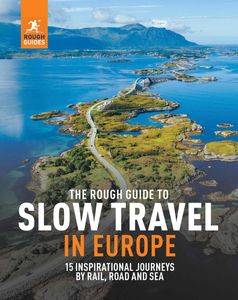
Find even more inspiration for Spain here

Planning your own trip? Prepare for your trip
Use Rough Guides' trusted partners for great rates
- Castellar de la Frontera
- Vejer de la Frontera
- Alhama de Granada
- Cazalla de la Sierra
- Arcos de la Frontera
- Rodalquilar
written by Rough Guides Editors
updated 05.06.2024
Ready to travel and discover Spain?
Get support from our local experts for stress-free planning & worry-free travels.
- Where to stay
- Travel advice
Pakej Umrah Andalusia 2024/2025/ 1446H
Pakej Umrah dan Ziarah 1446H telah dibuka. Daftar Sekarang!
Pakej Umrah 2024

Umrah Bersama Ikon

Umrah Batik Air

Umrah Jimat

Umrah Rahmah

Umrah Sederhana Malaysia Airlines

Umrah Jarak Dekat Malaysia Airlines

Umrah Premium Malaysia Airlines

Umrah Sederhana Saudia Airlines

Umrah Jarak Dekat Saudia Airlines

Umrah Premium Saudia Airlines

Umrah 22 Hari
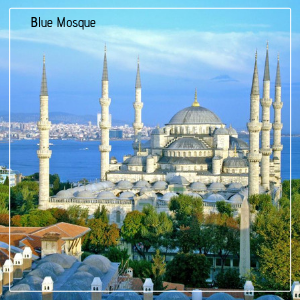
Umrah Ziarah Istanbul Half Day Tour
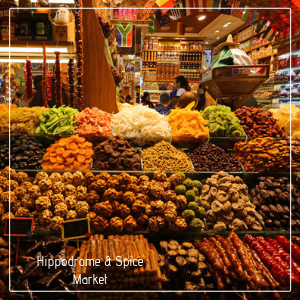
Umrah Ziarah Istanbul + Bursa
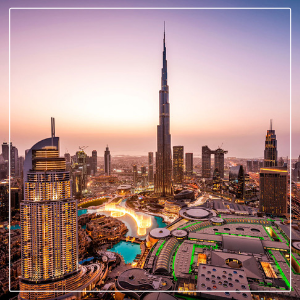
Umrah Ziarah Abu Dhabi + Dubai
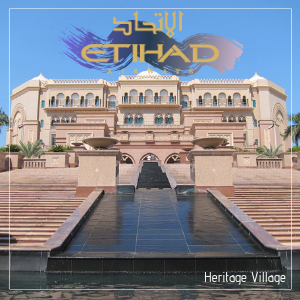
Umrah Ziarah Abu Dhabi Half Day Tour
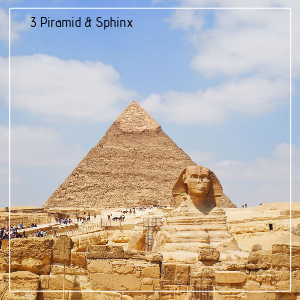
Umrah Ziarah Cairo Iskandariah
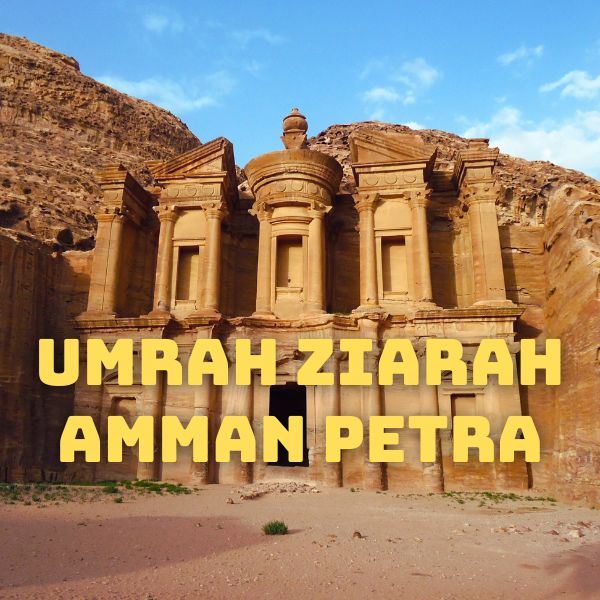
Umrah Ziarah Amman Petra
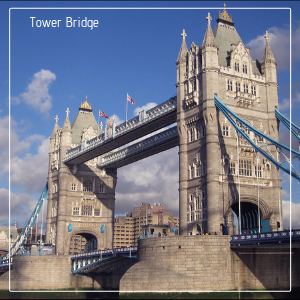
Umrah Ziarah London & Paris
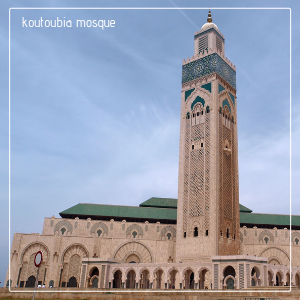
Umrah Ziarah Morocco
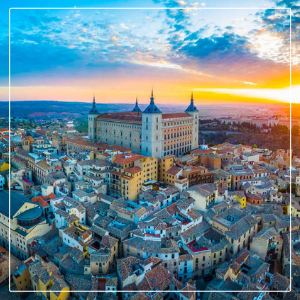
Umrah Ziarah Sepanyol
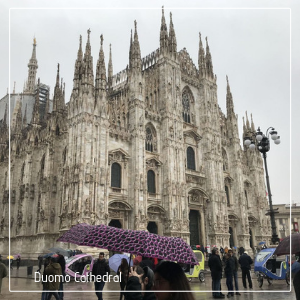
Umrah Ziarah Swiss & Italy

Umrah Transit Oman

Umrah Ziarah Sharjah Abu Dhabi & Dubai

Umrah Transit Sharja
Pakej umrah 2025.

Umrah Ramadhan (Malaysia Airlines)

Umrah Ramadhan (Saudi Airlines)

Umrah Syawal (Malaysia Airlines)

Umrah Syawal (Saudi Airlines)

Umrah Ziarah Sharjah Halfday
Pakej pelancongan 2024.
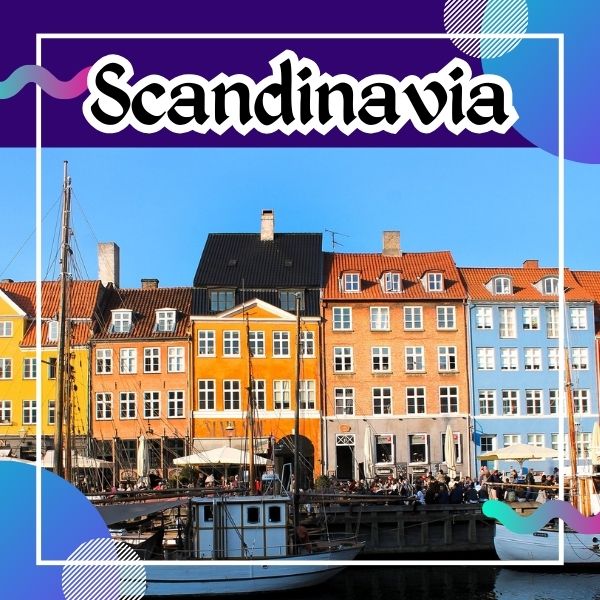
Scandinavia

Dubai Abu Dhabi
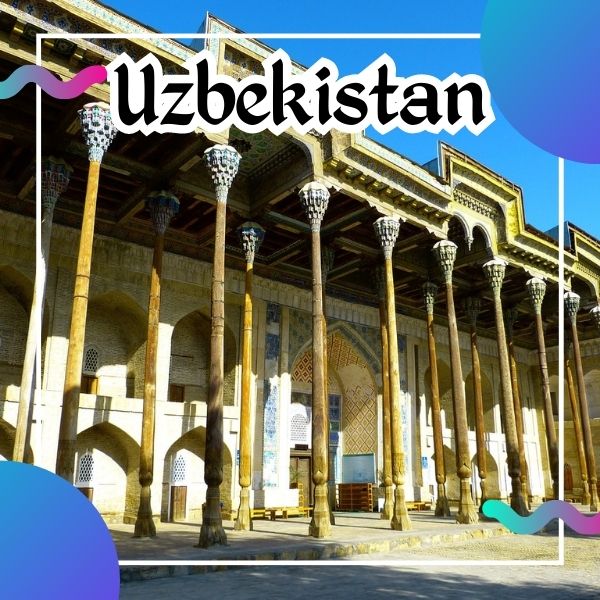
Morocco & Spain

Pakej Pelancongan 2025

COMMENTS
Adventure Travel; Art & Culture; Beaches, Coasts & Islands; Food & Drink; Hotels. The most charming and luxurious boutique hotels in Andalucía. Jul 26, 2022 • 10 min read. Luxury in Seville, a room with a view of the Alhambra in Granada, rustic charm in the countryside and more: these hotels are among Andalucía's best.
Get information on Andalusia Travel Guide - Expert Picks for your Vacation hotels, restaurants, entertainment, shopping, sightseeing, and activities. Read the Fodor's reviews, or post your own ...
Here is our 7 day Andalusia Itinerary to see the best of Southern Spain. While westerners spell Andalusia with a 's', Spaniards spell it as Andalucía! Andalucía called Al-Andalus (Arabic for "land of the west") was a Moorish empire for 781 years, from 711 to 1492. ... 20 Best Travel Movies to inspire your next Adventure. 12 thoughts ...
The hiking path is about 4.8 miles (7.7km) long and takes around 3 - 4 hours to complete. 4. Road Trip Through the Pueblos Blancos. Andalusia's pueblos blancos, or white villages, are charming towns and villages that dot the mountains and valleys of southern Spain.
Andalusia Road Trip Itinerary. Malaga - Marbella - Ronda - Cadiz - Jerez de la Frontera - Seville - Carmona - Ecija - Antequera - Cordoba - Granada - Nerja - Malaga. Distance: 1041km. Duration: 10-14 days. Drive Time: 14 hours. How to use this map - Use your fingers (or computer mouse) to zoom in and out.
Andalusia Travel & Tours Sdn. Bhd. Mempunyai pengalaman selama 22 tahun dalam menyediakan perjalanan dan perkhidmatan Umrah, Haji dan percutian. ... Jom tempah perjalanan umrah bersama Andalusia RM300 seorang sekarang! Jom tunaikan umrah sambil melancong bersama kami di andalusia . Tarikh Penerbangan . Jumaat 27 Sep 2024 . Hingga . Jumaat 04 ...
Catch a Flamenco Performance. Getting to know a place's culture is one of the more rewarding parts of travel, and flamenco is a great inroad to Andalusian culture. Combining song, dance, guitar, and body percussion, this communal art form has been performed in Andalusia for centuries and developed many variations and complexities along the way.
The last stop of the day is one of the most unique places in Andalusia and a really special place in this Andalusia travel itinerary. Juzcar used to be another white washed village, but not anymore. The inhabitants of Juzcar actually painted all of their houses bright blue as part of a marketing stunt for "The Smurfs" movie in 2011.
Cordoba (1 night) Granada (2 nights) Malaga (1 night) 10 days in Andalucia will allow you to take some more time to explore the region a little more slowly. Rather than add in additional destinations, I've instead expanded on the 7 day itinerary to allow you a better immersion in those places I feel warrant more time.
1) Seville (3 days) To visit Andalucia in 14-15 days, the best is to land in Seville. You don't really need a car to visit Seville, as it's very easy to visit the city on foot or with public transports. However, you will need to rent a car for the 2nd stage of this 2 weeks itinerary in Andalucia, when you will go to Cordoba.
The Pueblos Blancos of Andalusia (White Villages) Olvera village in the Pueblos Blancos. The Pueblos Blancos are enchanting, off-the-beaten-track tourist destinations in Las Alpujarras, the rolling hills of the Sierra Nevada, and in the Sierra de Grazalema and the Sierra Nevada mountain ranges.. Driving or long-distance hiking is the only way to arrive at these remote hilltop villages, but it ...
Andalucia's got a touch of both the angel and the devil about it. On one hand you've got the Costa crowd chasing sun and San Miguel, and on the other the culture club - celebrating the exquisite Moorish art and architecture of grand cities like Granada and Seville.
Castillo de Segura. This lofty castle dates from Moorish times but was rebuilt after the Christian conquest in the 13th century. Abandoned in the 17th century, it was…. Discover the best attractions in Andalucía including Alhambra, Mezquita, and Museo Picasso Málaga.
Costs of Traveling in Andalusia. Travel on a budget in Andalusia, from $180 − $380 USD weekly per person, mid-range $460 − $1590 USD, and high-end from $1590 − $2480 USD. However, costs depend on factors like accommodation, transportation, and activities. We did not include flights. Check flight prices here
Peter Hendrie leads Andalusia travel photography tours every February and shares his reasons for why you should visit Andalusia and fall in love with this magical Southern region of Spain. Peter Hendrie will be guiding an "Almond Blossom and Architecture of Andalucia" photography workshop in Andalucia from Feb 09-13, 2018.
Seville (Sevilla) - Seville is an absolute must-visit on any trip to southern Spain, and is one of the best cities in Andalusia.Be sure to give yourself several days to soak in a city that is full of highlights. While many Andalusia guides recommend taking include taking a cruise along the River Guadalquivir, many of the cruises get mediocre reviews, at best.
You'll drive a bit more than that, counting day trips and such, but the bottom line is that it's a very doable distance in 10 days! We don't dedicate much time to the famous Costa del Sol on this travel guide, as this is more of an enjoy-all-the-attractions itinerary rather than a relax-on-the-beach itinerary, but we do include a bit of time to soak up views by the Mediterranean as well.
Parking in Málaga for 24 hours (close to the centre): 22 Euros. Dinner for two at a higher-end tapas bar in Seville (including drinks): 30 Euros. Cortado (similar to an espresso macchiato): 1.20 to 1.50 Euros. Breakfast for two at a café: 15 Euros. 3. Map: Overview of our Andalusia Travel Itinerary.
Hiking and climbing in Andalucia. Clinging to the side of sheer cliffs in the Chorro gorge, the vertigo-inducing Caminito del Rey (king's pathway) is arguably Spain's most spectacular walking path. Named for Spanish king Alfonso XIII who tackled it in 1921, the path was originally intended to give hydro workers access to a nearby dam, but ...
First/second week Sept: Vendimia Celebrating the vintage at Jerez. 27-Oct 1: Feria de San Miguel In Órgiva (Las Alpujarras) featuring traditional dancing and a huge paella cook-up. If you're planning a trip to Spain, don't miss our Spain itinerariesand information on how to get there. Andalucía's cuisine.
Andalusia (UK: / ˌ æ n d ə ˈ l uː s i ə,-z i ə /, US: /-ʒ (i) ə,-ʃ (i) ə /; [5] [6] [7] Spanish: Andalucía [andaluˈθi.a] ⓘ) is the southernmost autonomous community in Peninsular Spain.Andalusia is located in the south of the Iberian Peninsula, in southwestern Europe.It is the most populous and the second-largest autonomous community in the country. It is officially recognised ...
198301011879 (107273-P) / ANDALUSIA TRAVEL & TOURS SDN. BHD. @ 2023 umrahandalusia.com. Hak cipta terpelihara. @ 2023 umrahandalusia.com. Hak cipta terpelihara.
Kami menyediakan pakej umrah, ziarah, haji dan pelancongan yang dikendalikan oleh Andalusia Travel. Daftar Pakej umrah 2024/2025/1446H Andalusia Travel & Tours sekarang. Sila klik pakej umrah di bawah untuk melihat senarai tarikh dan harga terkini. ... Eropah. Dari RM 8,598. Balkan. Dari RM 10,798. Morocco & Spain. Dari RM 6,998. Pakistan. Dari ...